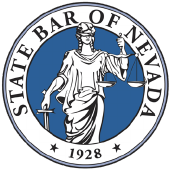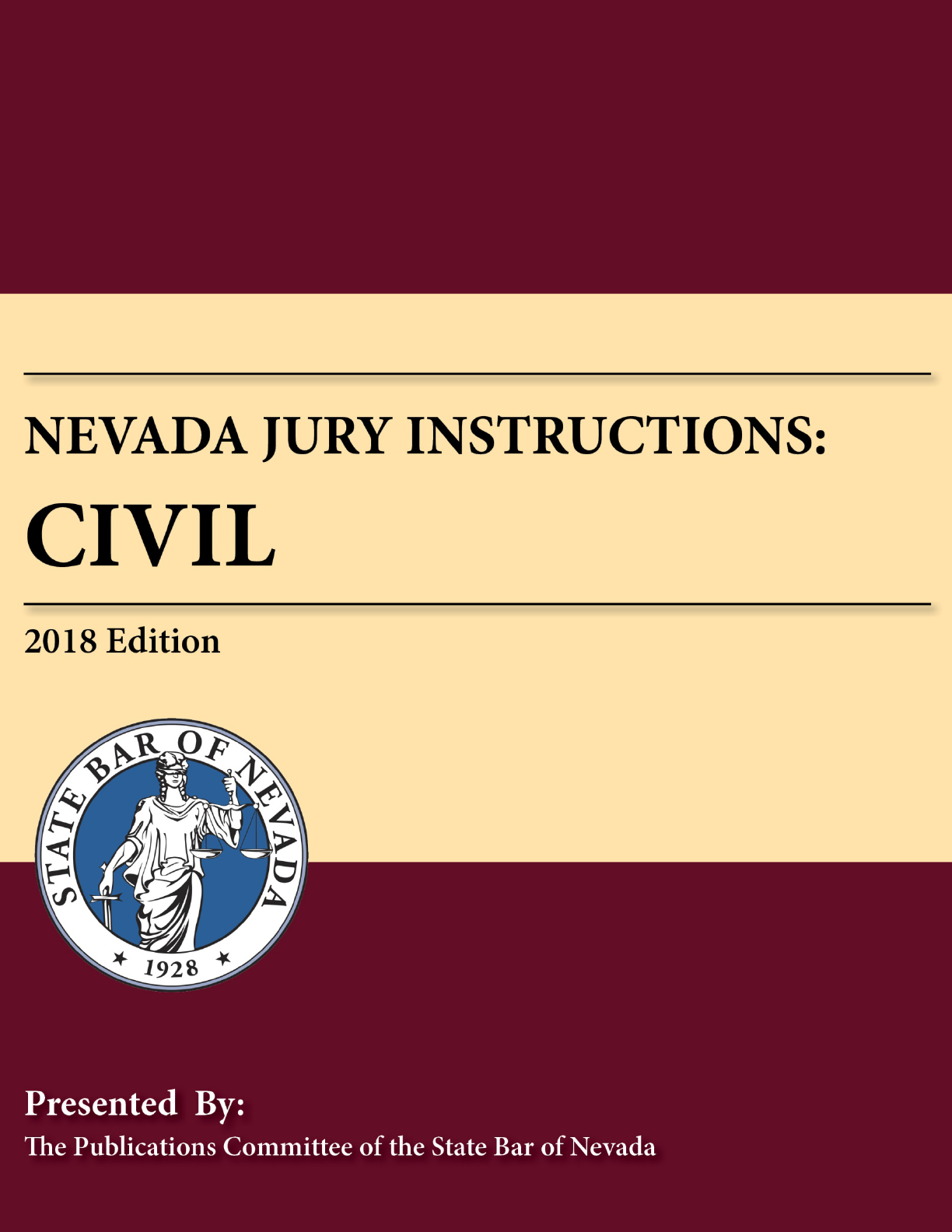
s
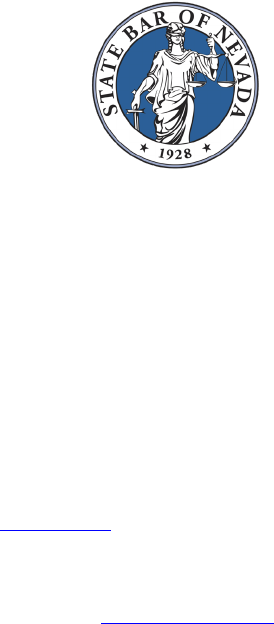
Page iii
Copyright © 2018
State Bar of Nevada
Las Vegas, Nev. & Reno, Nev.
___________________
___________________
___________________
Every effort has been made with this publication to provide the most accurate information on the subject. It should not, however,
be construed as legal advice. If legal advice is required, please consult with a professional. To locate a Nevada-licensed attorney,
visit the State Bar of Nevada’s website at www.nvbar.org
or call the Lawyer Referral and Information Service (LRIS) at 1-800-789-
5747.
If you have questions or comments about this publication, please contact the Publications Department, State Bar of Nevada, 3100
W. Charleston Blvd., Suite 100, Las Vegas, NV, 89102; [email protected]
, 1-800-254-2797.
Page iv
LEAD EDITOR
Hon. J. Charles Thompson
REVIEWERS
Todd R. Alexander
Raymond E. Areshenko
Phillip S. Aurbach
Stephanie Barker
Richard G. Barrows
Michael Bohn
April Bonifatto
Katlyn Brady
Alison Brasier
Christopher Burk
Justin Bustos
Jessica E. Chong
Benjamin P. Cloward
Hon. Jim Crockett
Daniel E. Curriden
Hon. Mark R. Denton
Jaquelyn Franco
William Ginn
Wade B. Gochnour
Matthew Granda
Michael Haight
Ann O. Hall
Agnes Hanley
Sarah E. Harmon
Scott L. Hernandez
Lee Iglody
Brian Irvine
Justin Iverson
Lubko Jeans-Berezowsky
Adele Karoum
Michael Kimmel
Wayne Klomp
Patrick Leverty
Christopher R. McCullough
Eban Milmeister
Christian Morris
Cody S. Mounteer
Daniel Price
Hon. Bridget E. Robb
Travis Robertson
Eva Segerblom
Matthew L. Sharp
Steven M. Silva
Craig Slater
Brianna Smith
Doreen Spears Hartwell
Prof. Jeffrey W. Stempel
Marsha Stephenson
Hon. Gloria J. Sturman
Will Wagner
S. Jordan Walsh
Kristina Weller
Randolph L. Westbrook III
Hon. Jerry A. Wiese II
Hon. Timothy C. Williams
Allen Wilt
James J. Woodruff II
STATE BAR STAFF
Jennifer Smith-Pulsipher, Communications Director
Gretchen Lychuk, Publications Specialist

Page v
HOW TO USE THIS BOOK
This book is a compilation of sample jury instructions drafted for a wide variety of civil trials. In
each template, the language is drafted with specific regard to the laws of the State of Nevada. In
most instances, these templates have been adapted from documents actually used in trial.
However, it is not the intent of the authors or the publisher that these templates be used as
definitive examples of any specific type of jury instruction; nor is it the authors’ intent that these
instructions be used as mere “fill-in-the-blank” documents.
On the contrary, the templates provided in this book are designed as a starting point for
practitioners to craft custom jury instructions. Indeed, in some instances, you may discover that
certain language in a given template does not correspond with the needs for your specific
case. You may find an instruction to be too neutral, or you may find it to be too one-sided. As is
the case with the use of any templates, you must customize the document for your own purposes.
While this book’s authors have endeavored to compile a broad selection of sample jury
instructions, this is by no means an exhaustive sampling. The templates provided in this book
represent a small selection of instructions routinely used in everyday practice. Nevertheless, it is
our hope that these templates will offer you a foundation upon which you may build the
instructions you propose to use during trial.
Finally, this book should be treated as an ongoing work in progress. It is our intent to
supplement and revise this book on an ongoing basis. To this end, we would like to enlist your
help. If you have suggestions for sample instructions to be included in later editions or templates
that you believe to be more in line with best practices in Nevada, please feel free to share your
suggestions with us by emailing public[email protected]rg or writing to the State Bar of Nevada at
3100 W. Charleston Blvd., Suite 100, Las Vegas, Nevada 89102, Attn: Publications Department.
Page vi
DISCLAIMER AND INFORMATION
These recommended jury instructions are intended to summarize the contours of the law that a
jury will apply to the facts. They are designed to tell a jury what must be proven in order for a
party to prevail. In every case possible, the instructions were written from an objective point of
view, with an eye to being as party-neutral as possible.
These instructions are models. They are
not substitutes for the individual research and adaptation that may be necessary in a
particular case.
These civil jury instructions are the result of a project of the State Bar of Nevada, through its
Publications Committee and its Nevada Jury Instructions: Civil Subcommittee. The instructions
have been reviewed by attorney bar members throughout Nevada and practicing in different
areas and with different litigation focuses.
We have collected instructions with a Nevada focus and citing to Nevada cases. The Supreme
Court of Nevada has neither reviewed nor approved these instructions as collected in this
publication. The State Bar of Nevada plans to publish supplements in the future covering new
areas and revised instructions. Therefore, the State Bar of Nevada welcomes feedback on these
instructions.
INTRODUCTION TO THE 2018 EDITION
Since the 1970s, several unsuccessful efforts have been made to publish a book on Nevada jury
instructions. In the early 2000s, then-Chief Justice Deborah Agosti asked the State Bar of Nevada
to undertake the publication of a civil and criminal jury instructions manual. A committee of
lawyers and judges was formed, and it solicited authors and editors to assist in the process. Judge
Sally Loehrer and Deputy Clark County District Attorney Christopher Lalli provided an initial
outline. Eventually, the committee was divided into two groups, one preparing civil instructions
and the other preparing criminal instructions. This effort led to the creation of Nevada Jury
Instructions: Civil which was published in 2011. The 2018 edition continues this commitment to
provide clear, up-to-date jury instructions for use in Nevada’s civil courts and is a result of a
collaborative effort by scores of lawyers, judges, law students and laypeople. It is meant to be
updated regularly, as case law and legislation evolve. The State Bar of Nevada thanks all of those
who have contributed to this project.
Page vii
TABLE OF CONTENTS
FRONT MATTER .................................................................................................................... ii
HOW TO USE THIS BOOK ................................................................................................................................................... v
DISCLAIMER AND INFORMATION ................................................................................................................................ vi
INTRODUCTION TO THE 2018 EDITION ...................................................................................................................... vi
CHAPTER 1: General Instructions ......................................................................................... 20
Nevada Jury Instruction 1.1: The Duty of the Jury ............................................................................................................ 21
Nevada Jury Instruction 1.2: Repeated Instructions .......................................................................................................... 22
Nevada Jury Instruction 1.3: A Corporation As A Party .................................................................................................. 23
Nevada Jury Instruction 1.4: The Masculine Form of the Instructions .......................................................................... 24
Nevada Jury Instruction 1.5: Use Common Sense: Not Sympathy, Prejudice or Public Opinion .............................. 25
Nevada Jury Instruction 1.6: Comments by the Court ...................................................................................................... 26
Nevada Jury Instruction 1.7: Communication With Others ............................................................................................ 27
Nevada Jury Instruction 1.8: Jurors Not to Conduct Independent Investigation ......................................................... 28
Nevada Jury Instruction 1.9: Determining the Credibility of a Witness ......................................................................... 29
Nevada Jury Instruction 1.10: Consider All of the Evidence ............................................................................................ 30
Nevada Jury Instruction 1.11: Discussion of Trial and Media Coverage ........................................................................ 31
Nevada Jury Instruction 1.12: Jurors May Ask Questions of Witnesses ......................................................................... 32
Nevada Jury Instruction 1.13: Claims and Defenses of Multiple Parties to be Considered Separately ..................... 33
Nevada Jury Instruction 1.14: Jury Deliberations .............................................................................................................. 34
Nevada Jury Instruction 1.15: Jury May Come Into Court for Further Instructions .................................................... 35
Nevada Jury Instruction 1.16: Concluding Instruction ..................................................................................................... 36
CHAPTER 2: Evidence Instructions ....................................................................................... 37
Nevada Jury Instruction 2.1: Burden of Proof .................................................................................................................... 38
Nevada Jury Instruction 2.1A: Burden of Proof: Alternative ........................................................................................... 39
Nevada Jury Instruction 2.2: Clear and Convincing Proof ............................................................................................... 40
Nevada Jury Instruction 2.3: Evidence to be Considered Generally: Direct and Circumstantial Evidence ............. 41
Nevada Jury Instruction 2.4: Evidence Lost Through Negligence by a Party or Improperly Altered Evidence ...... 42
Page viii
Nevada Jury Instruction 2.5: Willful Suppression of Evidence ........................................................................................ 43
Nevada Jury Instruction 2.6: Evidence Admitted for Limited Purpose .......................................................................... 44
Nevada Jury Instruction 2.7: Evidence Applicable to One Party ..................................................................................... 45
Nevada Jury Instruction 2.8: Deposition as Substantive Evidence .................................................................................. 46
Nevada Jury Instruction 2.9: Use of Interrogatories of a Party ........................................................................................ 47
Nevada Jury Instruction 2.10: Request for Admissions .................................................................................................... 48
Nevada Jury Instruction 2.11: Prior Conviction of a Felony ............................................................................................ 49
Nevada Jury Instruction 2.12: Exercise of Witness’s Right Not to Testify ..................................................................... 50
Nevada Jury Instruction 2.13: Charts and Summaries ...................................................................................................... 51
Nevada Jury Instruction 2.14: Attorney’s Right to Interview Witness ............................................................................ 52
CHAPTER 3: Instructions Regarding Experts ....................................................................... 53
Nevada Jury Instruction 3.1: Expert Witness: General ..................................................................................................... 54
Nevada Jury Instruction 3.1A: Expert Witness: General (Alternate) ............................................................................. 55
Nevada Jury Instruction 3.2: Expert Witness: Reliance Upon Matters Not Admitted In Evidence .......................... 56
Nevada Jury Instruction 3.3: Expert Witness: Hypothetical Question .......................................................................... 57
Nevada Jury Instruction 3.4: Expert Witness: Professional Negligence ........................................................................ 58
CHAPTER 4: Negligence Instructions ................................................................................... 59
Nevada Jury Instruction 4.1: Introductory Instruction: Single Legal Theory ................................................................ 60
Nevada Jury Instruction 4.1A: Introductory Instruction: Multiple Legal Theories ...................................................... 61
Nevada Jury Instruction 4.2: Elements of Negligence Claim ........................................................................................... 62
Nevada Jury Instruction 4.3: Duty and Ordinary Care: Definitions ............................................................................... 63
Nevada Jury Instruction 4.4: Proximate Cause: Definition .............................................................................................. 64
Nevada Jury Instruction 4.5: Negligence: Legal Cause: Definition .................................................................................. 65
Nevada Jury Instruction 4.6: Concurring Causes ............................................................................................................... 66
Nevada Jury Instruction 4.7: When Third Party’s Intervening Negligence Is Not a Superseding Case ..................... 67
Nevada Jury Instruction 4.8: Comparative Negligence: Definition: Effect ..................................................................... 68
Nevada Jury Instruction 4.9: Comparative Negligence: Wrongful Death ...................................................................... 69
Nevada Jury Instruction 4.10: Right to Assume Others Will Exercise Due Care .......................................................... 70
Nevada Jury Instruction 4.11: Evidence of Custom in Relation to Ordinary Care ....................................................... 71
Page ix
Nevada Jury Instruction 4.12: Standard of Conduct for Minor ....................................................................................... 72
Nevada Jury Instruction 4.13: Violation of Law As Negligence Per Se: No Evidence of Excuse or Justification ..... 73
Nevada Jury Instruction 4.14: Violation of Law As Negligence Per Se: Jury Issue As to Excuse or Justification ..... 74
Nevada Jury Instruction 4.15: Duty of One in Imminent Peril ........................................................................................ 75
Nevada Jury Instruction 4.16: Implied Assumption of Risk ............................................................................................. 76
Nevada Jury Instruction 4.17: Express Assumption of Risk ............................................................................................. 77
Nevada Jury Instruction 4.18: Res Ipsa Loquitur When There Is No Evidence Adduced of Comparative
Negligence ..................................................................................................................................................................... 78
Nevada Jury Instruction 4.19: Res Ipsa Loquitur Where One of the Parties Has Adduced Sufficient Evidence of
Comparative Negligence ............................................................................................................................................. 79
CHAPTER 5: Damage Instructions ........................................................................................ 80
Nevada Jury Instruction 5.1: Measure of Damages ............................................................................................................ 81
Nevada Jury Instruction 5.2: Pain and Suffering: No Definite Standard ....................................................................... 82
Nevada Jury Instruction 5.3: Pain and Suffering: Aggravation of Pre-Existing Condition ........................................ 83
Nevada Jury Instruction 5.4: Future Pain and Suffering Damages: When Expert Required ...................................... 84
Nevada Jury Instruction 5.5: Wrongful Death of Adult: Heir as Plaintiff ..................................................................... 85
Nevada Jury Instruction 5.6: Wrongful Death: Personal Representative as Plaintiff ................................................... 87
Nevada Jury Instruction 5.7: Wrongful Death of Child: Heir as Plaintiff ..................................................................... 88
Nevada Jury Instruction 5.8: Life Expectancy ..................................................................................................................... 89
Nevada Jury Instruction 5.9: Closing Instruction .............................................................................................................. 90
Nevada Jury Instruction 5.10: Jury Shall Award Total Amount of Damages................................................................. 91
CHAPTER 6: Intentional Torts Instructions ......................................................................... 92
Nevada Jury Instruction 6.1: Assault: Definition .............................................................................................................. 93
Nevada Jury Instruction 6.2: Battery .................................................................................................................................... 94
Nevada Jury Instruction 6.3: Killing in Self-Defense ......................................................................................................... 95
Nevada Jury Instruction 6.4: False Imprisonment ............................................................................................................. 97
Nevada Jury Instruction 6.5: False Imprisonment: Definition ........................................................................................ 98
Nevada Jury Instruction 6.6: Intentional Infliction of Emotional Distress: Elements ................................................. 99
Nevada Jury Instruction 6.7: Abuse of Process ................................................................................................................. 100
Page x
Nevada Jury Instruction 6.8: Malicious Prosecution ....................................................................................................... 101
Nevada Jury Instruction 6.9: Civil Conspiracy ................................................................................................................. 102
Nevada Jury Instruction 6.10: Defamatory Communication: Definition .................................................................... 103
CHAPTER 7: Product Liability Instructions ........................................................................ 104
Nevada Jury Instruction 7.1: Elements .............................................................................................................................. 105
Nevada Jury Instruction 7.2: Design Defect: Definition ................................................................................................. 106
Nevada Jury Instruction 7.3: Manufacturing Defect: Definition ................................................................................... 107
Nevada Jury Instruction 7.4: Warning Defective: Definition ......................................................................................... 108
Nevada Jury Instruction 7.5: Warning Defective: Adequacy of Warning .................................................................... 109
Nevada Jury Instruction 7.6: Unreasonably Dangerous: Definition ............................................................................. 110
Nevada Jury Instruction 7.7: Misuse of a Product ........................................................................................................... 111
Nevada Jury Instruction 7.8: Assumption of Risk ............................................................................................................ 112
Nevada Jury Instruction 7.9: Breach of Warranty in General ........................................................................................ 113
Nevada Jury Instruction 7.10: Causation in General ....................................................................................................... 114
Nevada Jury Instruction 7.11: Implied Warranty of Merchantability ........................................................................... 115
Nevada Jury Instruction 7.12: Express Warranty: Elements .......................................................................................... 116
Nevada Jury Instruction 7.13: Exclusion or Modification of Warranties ..................................................................... 117
Nevada Jury Instruction 7.14: Implied Warranty of Fitness for a Particular Purpose ................................................ 118
Nevada Jury Instruction 7.15: Buyer’s Examination ........................................................................................................ 119
Nevada Jury Instruction 7.16: Notice of a Breach of Warranty ..................................................................................... 120
Nevada Jury Instruction 7.17: Privity................................................................................................................................. 121
CHAPTER 8: Premises Liability Instructions ...................................................................... 122
Nevada Jury Instruction 8.1: Premises Liability: Essential Factual Elements ............................................................... 123
Nevada Jury Instruction 8.2: Landowner Liability: Owner Duty to Inspect ............................................................... 124
Nevada Jury Instruction 8.3: Landowner Liability: Open and Obvious ...................................................................... 125
Nevada Jury Instruction 8.3A: Landowner Liability: Open and Obvious: Alternative .............................................. 126
Nevada Jury Instruction 8.4: Landowner Liability: Duty ............................................................................................... 127
Nevada Jury Instruction 8.5: Landowner Liability: Foreign Substance on Walkway................................................. 128
Nevada Jury Instruction 8.6: Mode of Operation ............................................................................................................ 129
Page xi
CHAPTER 9: Professional Negligence Instructions ............................................................ 130
Nevada Jury Instruction 9.1: Definitions ........................................................................................................................... 131
Nevada Jury Instruction 9.2: Burdens of Proof ................................................................................................................ 132
Nevada Jury Instruction 9.3: Plaintiff’s Burden of Proof/Loss of Chance Damages ................................................... 133
Nevada Jury Instruction 9.4: Requirement of Standard of Care Proof (Res Ipsa Loquitur Not Applicable) .......... 134
Nevada Jury Instruction 9.5: Duty of Physician and Surgeon: Holding Out As Specialist ....................................... 135
Nevada Jury Instruction 9.6: Duty of Physician and Surgeon: Board-Certified Physician ....................................... 136
Nevada Jury Instruction 9.7: Standard of Skill and Care: National .............................................................................. 137
Nevada Jury Instruction 9.8: Duty of Physician and Surgeon: General Practitioner’s Duty to Refer to Specialist 138
Nevada Jury Instruction 9.9: Liability of Surgeon for Negligence of Assistants and Nurses ..................................... 139
Nevada Jury Instruction 9.10: Informed Consent: Definition ....................................................................................... 140
Nevada Jury Instruction 9.11 Consent of Patient: When Conclusively Established ................................................... 141
nevada jury instruction 9.12 Consent of Patient: When Implied .................................................................................. 142
Nevada Jury Instruction 9.13: Who Was Authorized to Consent for Patient .............................................................. 143
Nevada Jury Instruction 9.14: Emergency Treatment or Operation ............................................................................. 144
Nevada Jury Instruction 9.15: Hospital Liability for Ostensible Agent Physicians ..................................................... 145
Nevada Jury Instruction 9.16: Rebuttable Presumption of Medical Negligence: Basic Facts Established As A
Matter of Law: Jury Question As To Basic Facts and Presumed Facts ............................................................... 146
Nevada Jury Instruction 9.17: Liability of Physicians, Others Rendering Emergency Medical Care: Gross
Negligence ................................................................................................................................................................... 149
Nevada Jury Instruction 9.18: Assessing Comparative Negligence of Settled Defendants ........................................ 150
Nevada Jury Instruction 9.19: Assessing Comparative Negligence of Non-Parties .................................................... 151
CHAPTER 10: Fraud and Misrepresentation Instructions .................................................. 152
Nevada Jury Instruction 10.1: Fraudulent Misrepresentation: Introductory Instruction .......................................... 153
Nevada Jury Instruction 10.2: Intentional Misrepresentation ....................................................................................... 154
Nevada Jury Instruction 10.3: False Promise .................................................................................................................... 156
Nevada Jury Instruction 10.4: Concealment ..................................................................................................................... 157
Nevada Jury Instruction 10.5: Fraud by Nondisclosure (Silence) .................................................................................. 158
Nevada Jury Instruction 10.6: Duty to Disclose ............................................................................................................... 159
Nevada Jury Instruction 10.7: Negligent Misrepresentation .......................................................................................... 160
Page xii
Nevada Jury Instruction 10.8: Clear and Convincing Evidence ..................................................................................... 161
Nevada Jury Instruction 10.9: Justifiable Reliance ........................................................................................................... 162
Nevada Jury Instruction 10.10: Statements of Fact vs. Opinion .................................................................................... 164
CHAPTER 11: Insurance Litigation Instructions ................................................................ 165
Nevada Jury Instruction 11.1: Breach of Contractual Duty to Pay a First-Party Insurance Claim — Elements .... 166
Nevada Jury Instruction 11.2: Breach of Contractual Duty to Pay a Defendant or Cover a Third-Party Insurance
Claim — Elements ..................................................................................................................................................... 167
Nevada Jury Instruction 11.3: Affirmative Defense — Insurance Policy Exclusion ................................................... 168
Nevada Jury Instruction 11.4: Implied Covenant of Good Faith and Fair Dealing .................................................... 169
Nevada Jury Instruction 11.5: Elements to Insurance Bad Faith ................................................................................... 171
Nevada Jury Instruction 11.6: Insurance Company’s Breach of Duty of Good Faith — Burden of Proof — Failure
to Pay/Delayed Payment ........................................................................................................................................... 172
Nevada Jury Instruction 11.7: Bad Faith (First Party) — Failure to Properly Investigate Claim .............................. 173
Nevada Jury Instruction 11. 8: Duty to Fairly and Properly Investigate Claim ........................................................... 174
Nevada Jury Instruction 11.9: Insurance Company’s Breach of Duty of Good Faith — Burden of Proof — Denial
of Defense.................................................................................................................................................................... 175
Nevada Jury Instruction 11. 10: Insurance Company’s Breach of Duty of Good Faith — Duty to Defend ........... 176
Nevada Jury Instruction 11.11: Insurance Company’s Breach of Duty of Good Faith — Burden of Proof —
Refusal to Inform of Settlement Offers ................................................................................................................... 177
Nevada Jury Instruction 11.12: Duty to Inform Insured of Settlement Offers ............................................................ 178
Nevada Jury Instruction 11.13: Duty to Fairly Evaluate and Pay Claim ....................................................................... 179
Nevada Jury Instruction 11.14: Unfair Trade Practice Regulations .............................................................................. 180
Nevada Jury Instruction 11.15: Delay in Payment for an Independent Medical Examination ................................. 183
Nevada jury instruction 11.16: Interpretation of Insurance Contracts ......................................................................... 184
Nevada Jury Instruction 11.17: Ambiguity within an Insurance Contract ................................................................. 185
Nevada Jury Instruction 11.18: Reliance on an Ambiguous Contract ......................................................................... 186
Nevada Jury Instruction 11.19: Implied Covenant of Good Faith and Fair Dealing: Defenses: Other .................. 187
Nevada Jury Instruction 11.20: Unfair Trade Practices: Definition ............................................................................. 188
Nevada Jury Instruction 11.21: Nevada Unfair Insurance Practices Act Claims......................................................... 189
Page xiii
CHAPTER 12: Punitive Damages Instructions .................................................................... 192
Nevada Jury Instruction 12.1 Punitive Damages: Recovery and Measure ................................................................... 193
Nevada Jury Instruction 12.2: Against Employer for Act of Employee ........................................................................ 195
Nevada Jury Instruction 12.3: Against Operator of Motor Vehicle .............................................................................. 197
CHAPTER 13: Contracts Instructions.................................................................................. 198
Nevada Jury Instruction 13.0: Introduction ...................................................................................................................... 200
Nevada Jury Instruction 13.1: Elements: Proof Requirements ....................................................................................... 201
Nevada Jury Instruction 13.2: Elements: Contract Requirements ................................................................................. 202
Nevada Jury Instruction 13.3: Formation: Negotiations: Oral or Written Contracts ................................................. 203
Nevada Jury Instruction 13.4: Elements: Options ............................................................................................................ 204
Nevada Jury Instruction 13.5: Formation: Offer .............................................................................................................. 205
Nevada Jury Instruction 13.6: Formation: Acceptance ................................................................................................... 206
Nevada Jury Instruction 13.7: Formation: Contractual Intent ....................................................................................... 207
Nevada Jury Instruction 13.8: Formation: Consideration .............................................................................................. 208
Nevada Jury Instruction 13.9: Formation: Detrimental Reliance .................................................................................. 209
Nevada Jury Instruction 13.10: Formation: Third Party Beneficiary ............................................................................ 210
Nevada Jury Instruction 13.11: Formation: Implied Contracts ..................................................................................... 211
Nevada Jury Instruction 13.12: Formation: Unjust Enrichment ................................................................................... 212
Nevada Jury Instruction 13.13: Formation: Certainty ..................................................................................................... 213
Nevada Jury Instruction 13.14: Formation: Ratification ................................................................................................. 214
Nevada Jury Instruction 13.15: Modification ................................................................................................................... 215
Nevada Jury Instruction 13.16: Assignment ..................................................................................................................... 216
Nevada Jury Instruction 13.17: Interpretation of a Clear and Unambiguous Contract ............................................. 217
Nevada Jury Instruction 13.18: Interpretation of an Ambiguous Contract ................................................................. 219
Nevada Jury Instruction 13.19: Interpretation of an Insurance Policy ......................................................................... 220
Nevada Jury Instruction 13.20: Multiple Writings........................................................................................................... 222
Nevada Jury Instruction 13.21: Defenses: Competency .................................................................................................. 223
Nevada Jury Instruction 13.22: Defenses: Minority ......................................................................................................... 224
Nevada Jury Instruction 13.23: Defenses: Mistake........................................................................................................... 225
Nevada Jury Instruction 13.24: Defenses: Fraudulent Inducement............................................................................... 226
Page xiv
Nevada Jury Instruction 13.25: Defenses: Duress, Coercion, Undue Influence .......................................................... 227
Nevada Jury Instruction 13.26: Defenses: Illegality ......................................................................................................... 228
Nevada Jury Instruction 13.27: Defenses: Unconscionable Contracts .......................................................................... 229
Nevada Jury Instruction 13.28: Defenses: Adhesion Contracts ..................................................................................... 230
Nevada Jury Instruction 13.29: Defenses: Failure of Consideration ............................................................................. 231
Nevada Jury Instruction 13.30: Defenses: Failure of Condition Precedent .................................................................. 232
Nevada Jury Instruction 13.31: Defenses: Impossibility/Impracticality ....................................................................... 233
Nevada Jury Instruction 13.32: Defenses: Frustration of Purpose ................................................................................. 234
Nevada Jury Instruction 13.33: Defenses: Accord and Satisfaction ............................................................................... 235
Nevada Jury Instruction 13.34: Defenses: Novation ........................................................................................................ 236
Nevada Jury Instruction 13.35: Defenses: Abandonment ............................................................................................... 237
Nevada Jury Instruction 13.36: Defenses: Rescission ...................................................................................................... 238
Nevada Jury Instruction 13.37: Performance/Breach: Time of Performance .............................................................. 240
Nevada Jury Instruction 13.38: Performance/Breach: Waiver ....................................................................................... 241
Nevada Jury Instruction 13.39: Performance/Breach: Equitable Estoppel ................................................................... 242
Nevada Jury Instruction 13.40: Performance/Breach: Non-Performance of Condition ............................................ 243
Nevada Jury Instruction 13.41: Performance/Breach: Material Breach ........................................................................ 244
Nevada Jury Instruction 13.42: Performance/Breach: Anticipatory Repudiation ....................................................... 245
Nevada Jury Instruction 13.43: Breach of Covenant of Good Faith and Fair Dealing:
Essential Factual Elements ........................................................................................................................................ 246
Nevada Jury Instruction 13.44: Tortious Breach of Covenant of Good Faith and Fair Dealing:
Essential Factual Elements ........................................................................................................................................ 247
Nevada Jury Instruction 13.45: Damages: Measure of Damages ................................................................................... 249
Nevada Jury Instruction 13.46: Damages: Lost Profits .................................................................................................... 250
Nevada Jury Instruction 13.47: Damages: Uncertainty as to Amount .......................................................................... 251
Nevada Jury Instruction 13.48: Damages: Economic Waste .......................................................................................... 252
Nevada Jury Instruction 13.49: Damages: Mitigation of Damages ................................................................................ 253
Nevada Jury Instruction 13.50: Damages: Liquidated Damages .................................................................................... 254
CHAPTER 14: Commercial and Reputational Torts Instructions ...................................... 255
Nevada Jury Instruction 14.1: Interference with Contractual Relationships: Elements ............................................. 256
Nevada Jury Instruction 14.2: Interference with Contractual Relationships: Knowledge of Existing Contract .... 257
Page xv
Nevada Jury Instruction 14.3: Interference with Contractual Relationships: Motive for Breach of Contract ....... 258
Nevada Jury Instruction 14.4: Interference with Prospective Economic Advantage: Elements ................................ 259
Nevada Jury Instruction 14.5: Interference with Prospective Economic Advantage: Intentional Interference ..... 260
Nevada Jury Instruction 14.6: Interference with Prospective Economic Advantage: Improper Interference ....... 261
Nevada Jury Instruction 14.7: Interference with Prospective Economic Advantage: Privilege ................................. 262
Nevada Jury Instruction 14.8: Tortious Interference Claims: Absolute Privilege ...................................................... 263
Nevada Jury Instruction 14.9: Slander Of Title: Elements .............................................................................................. 264
Nevada Jury Instruction 14.10: Slander of Title: Cause of Action ................................................................................. 265
Nevada Jury Instruction 14.11: Slander of Title: Special Damage ................................................................................ 266
Nevada Jury Instruction 14 .12: Fraudulent Transfer: Elements ................................................................................... 267
Nevada Jury Instruction 14 .13: Fraudulent Transfer: Actual Intent ............................................................................ 268
Nevada Jury Instruction 14.14: Fraudulent Transfer: Plaintiff’s Burden Of Proof ..................................................... 269
Nevada Jury Instruction 14.15: Fraudulent Transfer: Defendant’s Burden of Proof .................................................. 270
Nevada Jury Instruction 14.16: Fraudulent Transfer: Solvency or Reasonably Equivalent Value ............................ 271
Nevada Jury Instruction 14.17: Fraudulent Transfer: Transferee’s Good Faith Defense ........................................... 272
Nevada Jury Instruction 14.18: Defamatory Communication: Definition ................................................................... 273
Nevada Jury Instruction 14.19: Defamation: Trade Libel ............................................................................................... 274
CHAPTER 15: Agency, Fiduciary and Similar Relationships Instructions ......................... 275
Introduction And Disclaimer .............................................................................................................................................. 276
Nevada Jury Instruction 15.1: Principal and Agent — Relationship Defined ............................................................. 277
Nevada Jury Instruction 15.1A: Principal and Agent — Agent’s Authority ............................................................... 278
Nevada Jury Instruction 15.2: Fiduciary Relationship: Agent’s Duty .......................................................................... 279
Nevada Jury Instruction 15.3: Corporation Acts Through Agents, Officers And Employees —
Scope Of Authority .................................................................................................................................................... 280
Nevada Jury Instruction 15.4: Fiduciary Relationship: Corporate Officer’s Duty ..................................................... 281
Nevada Jury Instruction 15.5: Special or Confidential Relationship ............................................................................ 282
Nevada Jury Instruction 15.6: Fiduciary Relationship: Elements ................................................................................. 283
Nevada Jury Instruction 15.7: Fiduciary Relationship: Breach ..................................................................................... 284
Nevada Jury Instruction 15.8: Fiduciary Relationship: Special Confidence ................................................................ 285
Nevada Jury Instruction 15.9: Fiduciary Relationship: Constructive Fraud ............................................................... 286
Page xvi
Nevada Jury Instruction 15.10: Fiduciary Relationship: Question Of Fact ................................................................. 287
Nevada Jury Instruction 15.11: Fiduciary Duties: Duty Of Care .................................................................................. 288
Nevada Jury Instruction 15.12: Fiduciary Duties: Duty Of Disclosure ........................................................................ 289
Nevada Jury Instruction 15.13: Fiduciary Duties: Duty Of Loyalty.............................................................................. 290
Nevada Jury Instruction 15.14: Fiduciary Duties: Business Judgment Rule ............................................................... 291
Nevada Jury Instruction 15.15: Liabilities Of Fiduciary: Reliance On Subordinate Personnel ................................ 292
Nevada Jury Instruction 15.16: Liabilities Of Fiduciary: Reliance On Other Professionals ....................................... 293
Nevada Jury Instruction 15.17: Fiduciary Duty: Attorney .............................................................................................. 294
Nevada Jury Instruction 15.18: Fiduciary Duty: Officer/Director ................................................................................. 295
Nevada Jury Instruction 15.19: Fiduciary Duty: Partner ................................................................................................ 296
Nevada Jury Instruction 15.20: Fiduciary Duty: Shareholder (Majority) ..................................................................... 297
Nevada Jury Instruction 15.21: Fiduciary Duty: Stockbroker ........................................................................................ 298
Nevada Jury Instruction 15.22: Fiduciary Duty: Escrow Agent ..................................................................................... 299
Nevada Jury Instruction 15.23: Fiduciary Duty: Trustee ................................................................................................ 300
Nevada Jury Instruction 15.24: Fiduciary Relationship: Insurer’s Duty To Policy Holder ........................................ 301
Nevada Jury Instruction 15.25: Fiduciary Relationship: Real Estate Licensee’s Duty ................................................. 302
Nevada Jury Instruction 15.26: Fiduciary Duty: Causation ............................................................................................ 303
Nevada Jury Instruction 15.27: Fiduciary Duty: Measure Of Damages ........................................................................ 304
Nevada Jury Instruction 15.28: Negligent Professional Malpractice: Elements .......................................................... 305
Nevada Jury Instruction 15.29: Negligent Professional Malpractice: Free Services .................................................... 306
CHAPTER 16: Employment Law Instructions ..................................................................... 307
Nevada Jury Instruction 16.1: Implied Covenant of Good Faith and Fair Dealing: Implied Promise ..................... 308
Nevada Jury Instruction 16.2: Implied Covenant of Good Faith and Fair Dealing: Breach ...................................... 309
Nevada Jury Instruction 16.3: Implied Covenant of Good Faith and Fair Dealing: Damages .................................. 310
Nevada Jury Instruction 16.4: Tortious Discharge: Proof ............................................................................................... 311
Nevada Jury Instruction 16.5: Tortious Constructive: Discharge .................................................................................. 312
Nevada Jury Instruction 16.6: Tortious Discharge for Reporting Unlawful Activity (“WhistleBlower”) ............... 313
Nevada Jury Instruction 16.7: Tortious Discharge: Damages ........................................................................................ 314
Nevada Jury Instruction 16.8: Tortious Discharge: Mitigation of Damages ................................................................ 315
Nevada Jury Instruction 16.9: Fixed Duration: Ambiguous Contract .......................................................................... 316
Page xvii
Nevada Jury Instruction 16.10: Fixed Duration: Ambiguous Contract: Party Who Prepared the Agreement ....... 317
Nevada Jury Instruction 16.11: Continuing Employment: Mitigation Of Damages .................................................. 318
Nevada Jury Instruction 16.12: Continuing Employment: Oral or Written Contract ............................................... 319
Nevada Jury Instruction 16.13: Continuing Employment: Contract Express or Implied .......................................... 320
Nevada Jury Instruction 16.14: Continuing Employment: At-Will Employment ...................................................... 321
Nevada Jury Instruction 16.15: Continuing Employment: At-Will Rebuttable Presumption .................................. 322
Nevada Jury Instruction 16.16: Continuing Employment: Clear and Unambiguous Contract ................................ 323
Nevada Jury Instruction 16.17: Continuing Employment: Ambiguous Contract: Words and Actions .................. 324
Nevada Jury Instruction 16.18: Continuing Employment: Employment Contracts ................................................... 325
CHAPTER 17: Construction Defect Instructions ................................................................ 326
Introduction And Disclaimer .............................................................................................................................................. 328
Nevada Jury Instruction 17.1: Mitigation .......................................................................................................................... 329
Nevada Jury Instruction 17.2: Nominal Damages ........................................................................................................... 330
Nevada Jury Instruction 17.3: Damages Limited To Those Listed In Statute .............................................................. 331
Nevada Jury Instruction 17.4: Contribution ..................................................................................................................... 332
Nevada Jury Instruction 17.5: Equitable Indemnity ........................................................................................................ 333
Nevada Jury Instruction 17.6: Contractual Indemnity .................................................................................................... 334
Nevada Jury Instruction 17.7: Partnership ........................................................................................................................ 335
Nevada Jury Instruction 17.8: Negligent Misrepresentation .......................................................................................... 336
Nevada Jury Instruction 17.9: Negligent Misrepresentation: Acts By Agent ............................................................... 337
Nevada Jury Instruction 17.10: Negligent Misrepresentation As To Real Property: Award Of Damages ............... 338
Nevada Jury Instruction 17.11: Slander Of Title .............................................................................................................. 340
Nevada Jury Instruction 17.12: Fraudulent Concealment .............................................................................................. 341
Nevada Jury Instruction 17.13: Willful Misconduct: Definition .................................................................................... 342
Nevada Jury Instruction 17.14: Definition Of A Constructional Defect ...................................................................... 343
Nevada Jury Instruction 17.15: Definition Of An Appurtenance .................................................................................. 344
Nevada Jury Instruction 17.16: Definition Of A Contractor .......................................................................................... 345
Nevada Jury Instruction 17.17: Definition Of A Design Professional........................................................................... 346
Nevada Jury Instruction 17.18: Definition Of A Residence ............................................................................................ 347
Nevada Jury Instruction 17.19: Definition Of A Subcontractor .................................................................................... 348
Page xviii
Nevada Jury Instruction 17.20: Definition Of A Supplier ............................................................................................... 349
Nevada Jury Instruction 17.21: Definition Of Claimant ................................................................................................. 350
Nevada Jury Instruction 17.22: Liability Of A Contractor .............................................................................................. 351
Nevada Jury Instruction 17.23: Mandatory Disclosure Of Defects To Prospective Purchaser ................................. 352
Nevada Jury Instruction 17.24: Inadmissibility Of State Contractors’ Board Opinion .............................................. 353
Nevada Jury Instruction 17.25: Determining The Date Of Substantial Completion .................................................. 354
Nevada Jury Instruction 17.26: Construction Defect Action Applicable To Graded Lots ......................................... 355
Nevada Jury Instruction 17.27: Interference With Contractual Relations Of Homebuyer ........................................ 356
Nevada Jury Instruction 17.28: Intentional Interference With Prospective Economic Advantage .......................... 357
Nevada Jury Instruction 17.29: Measure Of Damages For Intentional Interference With Prospective Economic
Advantage And/Or Interference With Contractual Relations Of Homebuyer................................................. 358
Nevada Jury Instruction 17.30: Liability Of Contractor When Following Plans ......................................................... 359
Nevada Jury Instruction 17.31: Architect’s Duty Of Care In A Negligence Action .................................................... 360
Nevada Jury Instruction 17.32: Architect’s Scope Of Work: Exclusions ...................................................................... 361
Nevada Jury Instruction 17.33: Failure To Follow Architect’s Plans ............................................................................ 362
Nevada Jury Instruction 17.34: Statutes Of Limitation And Repose: Differing Treatment For Causes Of Action
Relating To Maintenance .......................................................................................................................................... 363
Nevada Jury Instruction 17.35: Accrual Of Indemnity And Contribution Causes Of Action .................................. 364
Nevada Jury Instruction 17.36: Common Interest Communities: Express Warranties Of Quality ......................... 365
Nevada Jury Instruction 17.37: Common Interest Communities: Implied Warranties Of Quality ......................... 366
Nevada Jury Instruction 17.38: Common Interest Communities: Exclusions Or Modifications Of Implied
Warranties Of Quality ............................................................................................................................................... 367
Nevada Jury Instruction 17.39: Statutes Of Limitation: Warranties Of Quality In Common
Interest Communities ............................................................................................................................................... 368
CHAPTER 18: Eminent Domain Instructions ..................................................................... 369
Introduction To Chapter/Disclaimer ................................................................................................................................. 370
Nevada Jury Instruction 18.1: Power Of Eminent Domain ........................................................................................... 371
Nevada Jury Instruction 18.1A: Power Of Eminent Domain — When Exercised by Private Entity ....................... 372
Nevada Jury Instruction 18.2: Just Compensation .......................................................................................................... 373
Nevada Jury Instruction 18.3: Fair Market Value ........................................................................................................... 374
Nevada Jury Instruction 18.4: Highest and Best Use ...................................................................................................... 376
Page xix
Nevada Jury Instruction 18.5: Project Influence ............................................................................................................. 377
Nevada Jury Instruction 18.6: Evidence Concerning Value .......................................................................................... 378
Nevada Jury Instruction 18.7: Comparable Sales ............................................................................................................ 379
Nevada Jury Instruction 18.8: Severance Damages ......................................................................................................... 380
Nevada Jury Instruction 18.9: Special Benefits ................................................................................................................ 381
Nevada Jury Instruction 18.10: Loss Of Goodwill ........................................................................................................... 382
Nevada Jury Instruction 18.11: Property Burdened by a Land-Use Restriction ......................................................... 383
Nevada Jury Instruction 18.12: Power Of Eminent Domain — Public Use ................................................................ 384
Appendix A: Sample Jury Verdict Forms ............................................................................. 385
Form 1: Verdict For Plaintiff ............................................................................................................................................... 386
Form 2: Verdict For Defendant ........................................................................................................................................... 388
Form 3: Special Verdict Form (A) ....................................................................................................................................... 389
Form 4: Special Verdict Form (B) ...................................................................................................................................... 391
Form 5: Special Verdict Form (C) ...................................................................................................................................... 393
Form 6: Verdict For Plaintiff — Expenses ........................................................................................................................ 394
Form 7: Special Verdict — Fraud ....................................................................................................................................... 395
Form 8: Special Verdict — Comparative Negligence Percentages ................................................................................ 397
TABLE OF AUTHORITIES .................................................................................................... cd

CHAPTER 1
General Instructions
1.1
The Duty of the Jury
1.2
Repeated Instructions
1.3
A Corporation as a Party
1.4
The Masculine Form of the Instructions
1.5
Use Common Sense: Not Sympathy, Prejudice or Public Opinion
1.6
Comments by the Court
1.7
Communication with Others
1.8
Jurors Not to Conduct Independent Investigation
1.9
Determining the Credibility of a Witness
1.10
Consider All of the Evidence
1.11
Discussion of Trial and Media Coverage
1.12
Jurors May Ask Questions of Witnesses
1.13
Claims and Defenses of Multiple Parties to be Considered Separately
1.14
Jury Deliberations
1.15
Jury May Come into Court for Further Instructions
1.16
Concluding Instruction

General instructions
Page 21
NEVADA JURY INSTRUCTION 1.1:
T
HE DUTY OF THE JURY
Members of the Jury:
It is now my duty as judge to instruct you in the law that applies to this case. It is your duty as jurors to
follow these instructions and to apply the rules of law to the facts as you find them from the evidence.
You must not be concerned with the wisdom of any rule of law stated in these instructions. Regardless
of any opinion you may have as to what the law ought to be, it would be a violation of your oath to base a
verdict upon any other view of the law than that given in these instructions.
Source/Authority:
United States v. Tomoya Kawakita,
96 F. Supp. 824 (S.D. Cal.1950);
In re Air Crash Disaster
, 720 F.Supp. 1467 (D. Colo.
1989).

General instructions
Page 22
NEVADA JURY INSTRUCTION 1.2:
R
EPEATED INSTRUCTIONS
If, in these instructions, any rule, direction or idea is repeated or stated in different ways, no emphasis
thereon is intended by me and none may be inferred by you. For that reason, you are not to single out
any certain sentence or any individual point or instruction and ignore the others, but you are to consider
all the instructions as a whole and regard each in the light of all the others.
The order in which the instructions are given has no significance as to their relative importance.
Source/Authority:
Yamaha Motor Co. v. Arnoult,
114 Nev. 233, 16, 955 P.2d 661 (1998); NEV. J.I. 1.01.

General instructions
Page 23
NEVADA JURY INSTRUCTION 1.3:
A
CORPORATION AS A PARTY
One of the parties in this case is a corporation. A corporation is entitled to the same fair and
unprejudiced treatment as an individual would be under like circumstances, and you should decide the
case with the same impartiality you would use in deciding a case between individuals.
Source/Authority:
Silkwood v. Kerr-McGee Corp
., 485 F.Supp. 566 (W.D.Okla.1979) rev’d on other
cert. denied
476 U.S. 1104, 106 S.Ct. 1947,
90 L.Ed.2d 356 (1986).

General instructions
Page 24
NEVADA JURY INSTRUCTION 1.4:
T
HE MASCULINE FORM OF THE INSTRUCTIONS
The masculine form as used in these instructions, if applicable as shown by the text of the instruction
and the evidence, also applies to a female person or a corporation.
Source/Authority:
Escamilla v. Marshburn Bros.,
48 Cal. App. 3d 472 (Cal. Ct. App. 1975); NEV. J.I. 1.02.

General instructions
Page 25
NEVADA JURY INSTRUCTION 1.5:
U
SE COMMON SENSE: NOT SYMPATHY, PREJUDICE OR PUBLIC OPINION
Although you are to consider only the evidence in the case in reaching a verdict, you must bring to the
consideration of the evidence your everyday common sense and judgment as reasonable men and
women. Thus, you are not limited solely to what you see and hear as the witnesses testify. You may
draw reasonable inferences from the evidence which you feel are justified in the light of common
experience, keeping in mind that such inferences should not be based on speculation or guess.
A verdict may never be influenced by sympathy, prejudice or public opinion. Your decision should be
the product of sincere judgment and sound discretion in accordance with these rules of law.
Source/Authority:
Lewis v. Sea Ray Boats, Inc.,
119 Nev. 100, 106; 65 P.3d 245, 249 (Nev. 2003);
Howard v. State,
102 Nev. 572, 729 P.2d 1341
(1986).

General instructions
Page 26
NEVADA JURY INSTRUCTION 1.6:
C
OMMENTS BY THE COURT
If, during this trial, I have said or done anything which has suggested to you that I am inclined to favor
the claims or position of any party, you will not be influenced by any such suggestion. I have not
expressed, nor intended to express, nor have I intended to intimate, any opinion as to which witnesses
are or are not worthy of belief, what facts are or are not established, or what inference should be drawn
from the evidence. If any expression of mine has seemed to indicate an opinion relating to any of these
matters, I instruct you to disregard it.
Source/Authority:
Cassim v. Allstate Ins. Co
., 33 Cal.4th 780 (2004), citing
Gist v. French
, 136 Cal.App.2d 247, 288 P.2d 1003 (1955).

General instructions
Page 27
NEVADA JURY INSTRUCTION 1.7:
C
OMMUNICATION WITH OTHERS
You are admonished that no juror may declare to a fellow juror any fact relating to this case as of his or
her own knowledge, and if any juror discovers during the trial or after the jury has retired that he, she or
any other juror has personal knowledge of any fact in controversy in this case, he or she shall disclose
such situation to me in the absence of the other jurors. This means that if you learn, during the course of
the trial, that you were acquainted with the facts of this case or the witnesses and you have not previously
told me of this relationship, you must then declare that fact to me. You communicate to the court
through the bailiff/marshal.
During the course of this trial, the attorneys for both sides and court personnel, other than the
bailiff/marshal, are not permitted to converse with members of the jury. These individuals are not being
anti-social; they are bound by ethics and the law not to talk to you. To do so might contaminate your
verdict. You are admonished, additionally, that you are not to visit the scene of any of the acts or
occurrences made mention of during this trial, unless specifically directed to do so by the court. Do not
undertake any investigation of the case on your own, or endeavor to research legal or factual issues on
your own.
Source/Authority:
NRS 16.100; NRS 175.121. The first sentence of the first paragraph is taken from NRS 175.121, a criminal procedural
statement. However, it is appropriate for use in civil cases as well.

General instructions
Page 28
NEVADA JURY INSTRUCTION 1.8:
J
URORS NOT TO CONDUCT INDEPENDENT INVESTIGATION
You must decide all questions of fact in this case from the evidence received in this trial and not from
any other source. You must not make any independent investigation of the facts or the law or consider
or discuss facts as to which there is no evidence. This means, for example, that you must not on your
own visit the scene, conduct experiments or consult reference works for additional information.
Source/Authority:
BAJI 1.00.5
Rowbottom v. State
, 105 Nev. 472, 779 P.2d 934 (1989) (juror misconduct, in which juror conducted independent
investigation of crime, which was a prejudicial error which entitled defendant to new trial even though juror did not share her
findings with other jurors until penalty phase of trial);
Meyer v. State
, 119 Nev. 554, 80 P.3d 447 (2003) (jurors are prohibited
from conducting an independent investigation and informing other jurors of the results of that investigation).

General instructions
Page 29
NEVADA JURY INSTRUCTION 1.9:
D
ETERMINING THE CREDIBILITY OF A WITNESS
The credibility or believability of a witness should be determined by his or her manner upon the stand,
his or her relationship to the parties, his or her fears, motives, interests or feelings, his or her opportunity
to have observed the matter to which he or she testified, the reasonableness of his or her statements, and
the strength or weakness of his or her recollections.
If you believe that a witness has lied about any material fact in the case, you may disregard the entire
testimony of that witness, or any portion of his testimony which is not proved by other evidence.
Source/Authority:
Kassow v. State
, No. 66510, 2015 WL 7283035, (Nev. Nov. 13, 2015).

General instructions
Page 30
NEVADA JURY INSTRUCTION 1.10:
C
ONSIDER ALL OF THE EVIDENCE
In determining whether any proposition has been proved, you should consider all evidence bearing on
the question without regard to which party produced it.
Source/Authority:
State v. Ward,
19 Nev. 297, 10 P. 133, 138 (1886).

General instructions
Page 31
NEVADA JURY INSTRUCTION 1.11:
D
ISCUSSION OF TRIAL AND MEDIA COVERAGE
Again, let me remind you that until this case is submitted to you:
1. Do not talk to each other or anyone else about it or about anyone who has anything to do with it
until the end of the case when you go to the jury room to decide on your verdict.
2. “Anyone else” includes members of your family and your friends. You may tell them that you are
a juror in a civil case, but don’t tell them anything else about it until after you have been
discharged as jurors by me.
3. Do not let anyone talk to you about the case or about anyone who has anything to do with it. If
someone should try to talk to you, please report it to me immediately by contacting the
bailiff/marshal.
4. Do not read any news stories or articles or listen to any radio or television reports about the case
or about anyone who has anything to do with it. This includes anything about the case posted on
the internet in any form.
5. Do not read or post anything about this case on social media.
Source/Authority:
This instruction is similar to the requirement in criminal cases.
See
NRS 175.401.

General instructions
Page 32
NEVADA JURY INSTRUCTION 1.12:
J
URORS MAY ASK QUESTIONS OF WITNESSES
We also permit jurors to ask questions of witnesses. However, asking questions is the primary
responsibility of the attorneys, not the jurors. The procedure for a juror to ask a question is somewhat
complicated and has a tendency to prolong the trial. Any question that a juror asks must be factual in
nature and designed to clarify information already presented. You will not be permitted to become “the
third attorney” or advocate a position and I have discretion to preclude you from asking excessive
numbers of questions. If you feel that you must ask a question of a witness, you must write out the
question on a piece of paper and do so while the witness is still present. Raise your hand before that
witness leaves the courtroom and give the question to the marshal/bailiff. I will then halt the trial, review
the question with the attorneys and, if the question is appropriate, ask the question on your behalf. The
attorneys will then be permitted to ask follow up questions on that subject.
Do not feel disappointed if your question is not asked. Your question may not be asked for a variety of
reasons. For example, the question may call for an answer that is not allowed for legal reasons. Also, you
should not try to guess the reason why a question is not asked or speculate about what the answer might
have been. Because the decision whether to allow the question is mine alone, do not hold it against any
of the attorneys or their clients if your question is not asked.
I caution you not to place undue weight on the responses to your questions as opposed to other evidence
in the case.
Source/Authority:
Flores v. State
, 114 Nev. 910, 913, 965 P.2d 901, 903 (1998); The second paragraph is taken from CACI 112.

General instructions
Page 33
NEVADA JURY INSTRUCTION 1.13:
C
LAIMS AND DEFENSES OF MULTIPLE PARTIES TO BE CONSIDERED SEPARATELY
You should decide the case for or against each plaintiff separately as if it were a separate lawsuit. Each
plaintiff is entitled to separate consideration of [his/her/its] own claims and defenses. Unless I tell you
otherwise, all instructions apply to each plaintiff.
You should decide the case for or against each defendant separately as if it were a separate lawsuit. Each
defendant is entitled to separate consideration of [his/her/its] own claims and defenses. Unless I tell you
otherwise, all instructions apply to each defendant.
Source/Authority:
CACI 5005.
See
Doe By & Through G.S. v. Johnson
, 52 F.3d 1448, 1459 (7th Cir. 1995);
City of Bridgewater v. Morris, Inc.
,
594 N.W.2d 712, 716 (1999); and
Arbach v. Gruba
, 89 S.D. 322, 334, 232 N.W.2d 842, 849 (1975).
Note, however, one tortfeasor may be held vicariously liable for the tortious acts of another where the two tortfeasors were
engaged in a joint enterprise.
See, e.g.
,
Radaker v. Scott
, 109 Nev. 653, 658, 855 P.2d 1037, 1040 (1993);
Bruttomesso v. Las
Vegas Met. Police
, 95 Nev. 151, 154, 591 P.2d 254, 256 (1979).

General instructions
Page 34
NEVADA JURY INSTRUCTION 1.14:
J
URY DELIBERATIONS
When you retire to consider your verdict, you must select one of your number to act as foreperson, who
will preside over your deliberations and will be your spokesman here in court.
During your deliberations, you will have all the exhibits which were admitted into evidence, these
written instructions and forms of verdict, which have been prepared for your convenience.
In civil actions, three-fourths of the total number of jurors may find and return a verdict. This is a civil
action. As soon as six or more of you have agreed upon a verdict, you shall have it signed and dated by
your foreperson, and then return with it to this room.
Source/Authority:
NRS 16.170 refers to a jury “foreman.” Most jurisdictions correctly refer to a “foreperson.”
Nev. Const. art. I, § 3 (If three fourths of the Jurors agree upon a verdict it shall stand and have the same force and effect as a
verdict by the whole Jury.)
NRS 16.130 (Upon retiring for deliberation the jury may take with them all papers, except depositions, and all other items and
materials which have been received as evidence in the cause, or copies of any such papers as ought not, in the opinion of the
court, to be taken from the person having them in possession; and they may also take with them notes of the testimony, or
other proceedings on the trial, taken by themselves or any of them, but none taken by any other person.)

General instructions
Page 35
NEVADA JURY INSTRUCTION 1.15:
J
URY MAY COME INTO COURT FOR FURTHER INSTRUCTIONS
If, during your deliberations, you should desire to be further informed on any point of law or hear again
portions of the testimony, you must reduce your request to writing signed by the foreperson. The officer
will then return you to court where the information sought will be given you in the presence of the
parties or their attorneys. Remember, the court is not at liberty to supplement the evidence.
Source/Authority:
NRS 16.140.

General instructions
Page 36
NEVADA JURY INSTRUCTION 1.16:
C
ONCLUDING INSTRUCTION
Now you will listen to the arguments of counsel who will endeavor to aid you to reach a proper verdict
by refreshing in your minds the evidence and by showing the application thereof to the law; but,
whatever counsel may say, you will bear in mind that it is your duty to be governed in your deliberations
by the evidence as you understand it and remember it to be and by the law as given you in these
instructions, and return a verdict which, according to your reason and candid judgment, is just and
proper.
Source/Authority:
See NRS 16.090(5).

CHAPTER 2
Evidence Instructions
2.1
Burden of Proof
2.1A Burden of Proof: Alternative
2.2
Clear and Convincing Proof
2.3
Evidence to be Considered Generally: Direct and Circumstantial Evidence
2.4
Evidence Lost Through Negligence by a Party Or Improperly Altered Evidence
2.5
Willful Suppression of Evidence
2.6
Evidence Admitted for Limited Purpose
2.7
Evidence Applicable to One Party
2.8
Depositions as Substantive Evidence
2.9
Use of Interrogatories of a Party
2.10
Request for Admissions
2.11
Prior Conviction of a Felony
2.12
Exercise of Witness’ Right Not to Testify
2.13
Charts and Summaries
2.14
Attorney’s Right to Interview Witness

Evidence instructions
Page 38
NEVADA JURY INSTRUCTION 2.1:
B
URDEN OF PROOF
Plaintiff is seeking damages based upon [a] claim[s] of [description of claim]. Plaintiff has the burden of
proving by a preponderance of the evidence all of the facts necessary to establish:
[Plaintiff’s facts to establish].
The defendant has the burden of proving by a preponderance of the evidence all of the facts necessary to
establish:
[Defendant’s facts to establish].
A “preponderance of the evidence” means such evidence as, when considered and weighed against that
opposed to it, has more convincing force and produces in your mind a belief that what is sought to be
proved is more probably true than not true.
In determining whether a party has met this burden, you will consider all the evidence, whether
introduced by the plaintiff or defendant.
Source/Authority:
See
Seaman v. McKesson Corp
., 109 Nev. 8, 10, 846 P.2d 280, 282 (1993) (equating preponderance of evidence with proving
something is more probable than not);
Deiss v. S. Pac. Co
., 56 Nev. 151, 177, 53 P.2d 332, 336 (1936) (holding that
preponderance of the evidence “does not necessarily mean that a greater number of witnesses shall be produced on the one
side or the other, but that, upon the whole evidence, the jury believe the greater probability of the truth to be upon the side of
the party having the affirmative of the issue”) (internal quotation omitted).
Southern Pac. Co
., 56 Nev. 169 (1936);
See
also Betsinger v. D.R. Horton, Inc.
, 126 Nev. 232 P.3d 433, 435 (2010) ("Generally, a preponderance of the evidence is all that
is needed to resolve a civil matter …. ").

Evidence instructions
Page 39
NEVADA JURY INSTRUCTION 2.1A:
B
URDEN OF PROOF: ALTERNATIVE
A party must persuade you, by the evidence presented in court, that what he or she is required to prove
is more likely to be true than not true. This referred to as “the burden of proof.”
After weighing all of the evidence, if you cannot decide that something is more likely to be true than not
true, you must conclude that the party did not prove it. You should consider all the evidence, no matter
which party produced the evidence.

Evidence instructions
Page 40
NEVADA JURY INSTRUCTION 2.2:
C
LEAR AND CONVINCING PROOF
Clear and convincing evidence is that measure or degree of proof which will produce in your mind a
firm belief or conviction as to the allegations sought to be established. It is an intermediate degree of
proof, being more than a mere preponderance but not to the extent of such certainty as is required to
prove an issue beyond a reasonable doubt. Proof by clear and convincing evidence is proof which
persuades you that the truth of the contentions is highly likely.
Source/Authority:
The Nevada Supreme Court agreed with the definition by the District Court in
Albert H. Wohlers & Co. v. Bartgis
, 114 Nev.
1249, at 1260 n.4, 969 P.2d 949, 957 n.4 (1998) (upholding jury instruction which defined “clear and convincing evidence” as
“evidence which is beyond a mere preponderance of the evidence”) (citing
Addington v. Texas
, 441 U.S. 418, 432-33 (1979));
see also In re Discipline of Drakulich
, 111 Nev. 1556, 1566, 908 P.2d 709, 715 (1995) (“This court has held that clear and
convincing evidence must be “‘satisfactory proof that is: ‘so strong and cogent as to satisfy the mind and conscience of a
common man, and so to convince him that he would venture to act upon that conviction in matters of the highest concern
and importance to his own interest. It need not possess such a degree of force as to be irresistible, but there must be evidence
of tangible facts from which a legitimate inference … may be drawn.’”)
(quoting
Gruber v. Baker
, 20 Nev. 453, 477, 23 P. 858,
865 (1890));
Topaz Mut. Co. v. Marsh
, 108 Nev. 845, 850, 839 P.2d 606, 609 (1992); CACI 2.01 (requiring a party to persuade
a jury “that it is highly probable that the fact is true”). CACI Series 200 at 201.
See also
Instruction 10.8.

Evidence instructions
Page 41
NEVADA JURY INSTRUCTION 2.3:
E
VIDENCE TO BE CONSIDERED GENERALLY:
D
IRECT AND CIRCUMSTANTIAL EVIDENCE
The evidence which you are to consider in this case consists of the testimony of the witnesses, the
exhibits, and any facts admitted or agreed to by counsel.
There are two types of evidence: direct and circumstantial. Direct evidence is direct proof of a fact, such
as testimony by a witness about what the witness personally saw or heard or did. Circumstantial
evidence is the proof of one or more facts from which you could find another fact. The law makes no
distinction between the weight to be given either direct or circumstantial evidence. Therefore, all of the
evidence in the case, including the circumstantial evidence, should be considered by you in arriving at
your verdict.
Statements, arguments and opinions of counsel are not evidence in the case. However, if the attorneys
stipulate (meaning to agree) to the existence of a fact, you must accept the stipulation of evidence and
regard that fact as proved.
Questions are not evidence. Only the answer is evidence. You should consider a question only if it helps
you understand the witness’s answer. Do not assume that something is true just because a question
suggests that it is.
You must also disregard any evidence to which an objection was sustained by the court and any evidence
ordered stricken by the court. Anything you may have seen or heard outside the courtroom is not
evidence and must also be disregarded.
If the court has instructed you that you must accept a fact as proven or draw a particular inference, you
must do so.
If the court has instructed you regarding a Presumption regarding evidence, then you must consider that
presumption as well.
Source/Authority:
See generally
BAJI 2.00. The concept of circumstantial evidence is complex. Most people tend to think of circumstantial
evidence as referring to weak or less reliable evidence. Thus, California has substantially revised the concept using the term
“indirect” rather than circumstantial. See CACI 202 (referring to “indirect” evidence rather than “circumstantial” evidence).
A Nevada Ninth Circuit case went to the United States Supreme Court -
Desert Palace Inc., v. Costa
, 539 U.S. 90 at 100 (2003)
holding that the reason for treating circumstantial and direct evidence alike is both clear and deep-rooted: (
quoting Rogers v.
Mo. Pac. R.R.
, 352 U.S. 500, 508 n.17 (1957)) (“Circumstantial evidence is not only sufficient, but may also be more certain,
satisfying and persuasive than direct evidence.").

Evidence instructions
Page 42
NEVADA JURY INSTRUCTION 2.4:
E
VIDENCE LOST THROUGH NEGLIGENCE BY A PARTY
OR IMPROPERLY ALTERED EVIDENCE
Where relevant evidence which would properly be a part of this litigation is within the control of one
party whose interest it would naturally be to produce it, and they fail to do so without a satisfactory
explanation, the jury may draw an inference that such evidence would have been unfavorable to that
party. The same can be inferred from improperly altered evidence.
An inference means a logical and reasonable conclusion of a fact not presented by direct evidence but
which, by process of logic and reason, the jury may conclude exists from the established facts.
Source/Authority:
Bass-Davis v. Davis
, 122 Nev. 442, 445, 134 P.3d 103, 105 (2006) (“[A] permissible inference that missing evidence would be
adverse applies when evidence is negligently lost or destroyed. The Nev. Rev. Stat. 47.250(3) presumption, on the other hand,
applies only in cases involving willful suppression of evidence, in which the party destroying evidence intends to harm
another party, i.e., to obtain a competitive advantage in the matter.”); In
Franchise Tax Bd. of Cal. v. Hyatt
, 130 Nev. Adv. Op.
71, 335 P.3d 125, 152 (2014),
reh'g denied
(Nov. 25, 2014) the Nevada Supreme Court citing to
Bass-Davis
stated, “Under a
rebuttable presumption, the burden shifts to the spoiliating party to rebut the presumption by showing that the evidence that
was destroyed was not unfavorable.” If the party fails to rebut the presumption, then the jury or district court may presume
that the evidence was adverse to the party that destroyed the evidence.
Id
. “A lesser adverse inference, that does not shift the
burden of proof, is permissible.”
Bass-Davis
, 122 Nev. 447 at 449. The lesser inference merely allows the fact-finder to
determine, based on other evidence, that a fact exists.
Id
.

Evidence instructions
Page 43
NEVADA JURY INSTRUCTION 2.5:
W
ILLFUL SUPPRESSION OF EVIDENCE
When evidence is willfully suppressed, the law creates a rebuttable presumption that the evidence would
be adverse to the party suppressing it. Willful suppression means the willful or intentional spoliation of
evidence and requires the intent to harm another party or their case through its destruction and not
simply the intent to destroy evidence. When a party seeking the presumption’s benefit has demonstrated
that the evidence was destroyed with intent to harm another party or their case, the presumption that the
evidence was adverse applies, and the burden of proof shifts to the party who destroyed the evidence. To
rebut the presumption, the destroying party must then prove, by a preponderance of the evidence, that
the destroyed evidence was not unfavorable. If not rebutted, the jury is required to presume that the
evidence was adverse to the destroying party.
Source/Authority:
Bass-Davis v. Davis
, 122 Nev. 442, 448, 134 P.3d 103, 106-07 (2006) (court stated “[w]hen evidence is willfully suppressed,
NRS 47.250(3) creates a rebuttable presumption that the evidence would be adverse if produced. Other courts have
determined that willful or intentional spoliation of evidence requires the intent to harm another party through the
destruction and not simply the intent to destroy evidence. We agree. Thus, before a rebuttable presumption that willfully
suppressed evidence was adverse to the destroying party applies, the party seeking the presumption’s benefit has the burden
of demonstrating that the evidence was destroyed with intent to harm. When such evidence is produced, the presumption
that the evidence was adverse applies, and the burden of proof shifts to the party who destroyed the evidence. To rebut the
presumption, the destroying party must then prove, by a preponderance of the evidence, that the destroyed evidence was not
unfavorable. If not rebutted, the factfinder then presumes that the evidence was adverse to the destroying party.”).

Evidence instructions
Page 44
NEVADA JURY INSTRUCTION 2.6:
E
VIDENCE ADMITTED FOR LIMITED PURPOSE
Certain evidence was admitted for a limited purpose. At the time this evidence was admitted it was
explained to you that it could not be considered by you for any purpose other than the limited purpose
for which it was admitted. You may only consider that evidence for the limited purpose that I described
and not for any other purpose.
Source/Authority:
See
BAJI 2.05;
see also
,
United States v. McLennan
, 563 F.2d 943, 2 Fed. R. Evid. Serv. 750 (9th Cir. 1977),
cert. denied
, 435
U.S. 969 (1978) (as a rule, limiting instructions need only be given when requested and need not be given sua sponte by the
court);
United States v. Marsh
, 144 F.3d 1229 (9th Cir.1998) (when the trial court fails to instruct the jury in its final
instructions regarding the receipt of evidence for a limited purpose, the Ninth Circuit examines the trial court’s preliminary
instructions to determine if the court instructed the jury on this issue),
cert. denied
, 525 U.S. 973 (1998).
Note that in criminal cases the trial court should give the jury a specific instruction explaining the purposes for which the
evidence is admitted immediately prior to its admission and should give a general instruction at the end of trial reminding the
jurors that certain evidence may be used only for limited purposes.
Tavares v. State
, 117 Nev. 725, 733, 30 P.3d 1128, 1133
(2001)
holding modified by
Mclellan v. State
, 124 Nev. 263, 182 P.3d 106 (2008).

Evidence instructions
Page 45
NEVADA JURY INSTRUCTION 2.7:
E
VIDENCE APPLICABLE TO ONE PARTY
During the trial, I explained that certain evidence could be considered as to only one party. You may not
consider that evidence as to any other party.
[During the trial, I explained that certain evidence could be considered as to one or more parties but not
to every party. You may not consider that evidence as to any other party.]
Source/Authority:
CACI 2.07.

Evidence instructions
Page 46
NEVADA JURY INSTRUCTION 2.8:
D
EPOSITION AS SUBSTANTIVE EVIDENCE
During the trial, you received deposition testimony that was [read from the deposition transcript/or
describe the manner presented, e.g., shown by video]. A deposition is the testimony of a person taken
before trial. At a deposition, the person took the same oath to tell the truth that would be taken in court
and is questioned by the attorneys. You must consider the deposition testimony that was presented to
you in the same way as you consider testimony given in court.
[During the trial, you were shown video of deposition testimony. A deposition is the testimony of a
person taken before trial. At a deposition, the person is sworn to tell the truth and is questioned by the
attorneys. You must consider the deposition testimony that was presented to you in the same way as
you consider testimony given in court.]
Source/Authority:
CACI 208.

Evidence instructions
Page 47
NEVADA JURY INSTRUCTION 2.9:
U
SE OF INTERROGATORIES OF A PARTY
Before trial, each party has the right to ask the other parties to answer written questions. These questions
are called Interrogatories. The answers to the Interrogatories are also in writing and are sworn to under
oath. You must consider the questions and answers that were read to you the same as if the questions
and answers had been given in court.
Source/Authority:
CACI 209.

Evidence instructions
Page 48
NEVADA JURY INSTRUCTION 2.10:
R
EQUEST FOR ADMISSIONS
Before trial, each party has the right to ask another party to admit in writing that certain matters are true.
If the other party admits those matters, you must accept them as true. No further evidence is required to
prove them.
You will regard those matters as being conclusively proved all such matters of fact which were expressly
admitted by the parties or which the parties failed to deny.
If there are multiple parties to the litigation, these matters must be considered true only as they apply to
the party who admitted they were true.
1
Source/Authority:
CACI 210; NRCP 36(b);
see also
Smith v. Emery
, 109 Nev. 737, 742, 856 P.2d 1386, 1390 (1993) (“It is well settled that failure
to respond to a request for admissions will result in those matters being deemed conclusively established.”);
Woods v. Label
Inv. Corp.
, 107 Nev. 419, 425, 812 P.2d 1293, 1297 (1991) (“Where demand is made upon a party for admission of facts and
such party fails to respond to the request, matters contained therein are deemed admitted.”).
1
CACI 210 directions for use in the rule when there are multiple parties.

Evidence instructions
Page 49
NEVADA JURY INSTRUCTION 2.11:
P
RIOR CONVICTION OF A FELONY
The fact that a witness had been convicted of a felony, if such be a fact, may be considered by you only
for the purpose of determining the credibility of that witness. The fact of such a conviction does not
necessarily destroy or impair the witness’s credibility. It is simply one of the circumstances that you are
to take into consideration in weighing the credibility of a witness’s testimony.
Source/Authority:
NRS 50.095(1);
see also
– Impeachment by evidence of conviction of crime.
Colle v. State
, 85 Nev. 289, 294, 454 P.2d 21, 24
(1969)
overruled on other grounds by Rosas v. State,
122 Nev. 1258, 147 P.3d 1101 (2006) (“The fact that a witness had been
convicted of a felony, if such be a fact, may be considered by you for only one purpose, namely, in judging the credibility of
that witness. It is simply one of the circumstances that you are to take into consideration in weighing the testimony of such a
witness.”).

Evidence instructions
Page 50
NEVADA JURY INSTRUCTION 2.12:
E
XERCISE OF WITNESS’S RIGHT NOT TO TESTIFY
[Name of party/witness] has an absolute constitutional right not to give testimony that might tend to
incriminate [himself] [herself]. Do not consider, for any reason at all, the fact that [name of
party/witness] invoked the right not to testify. Do not discuss that fact during your deliberations or let it
influence your decision in any way.
Source/Authority:
CACI 216. The Fifth Amendment privilege against self-incrimination may be invoked in both criminal and civil proceedings.
Lefkowitz v. Cunningham
, 431 U.S. 801, 805 (1977), 97 S.Ct. 2132, 53 L.Ed.2d 1 (1977).
Nationwide Life Insurance Company
v. Richards
, 541 F.3d 903, 911-912 (9
th
Cir. 2008); and
Doe v. Glanzer v. Glanzer,
230 F.3d 1258, 1264-1265 (9
th
Cir. 2000);
see
also
Kastinger v. United States
(1972) 406 U.S. 441, 444 [92 S. ct. 1653, 32 L.Ed.2d 212] (The privilege against self-
incrimination may be asserted in a civil proceeding.). Therefore, the issue of a witness’s invocation right of the Fifth
Amendment right not to self-incriminate is raised outside the presence of the jury, and the jury is not informed of the matter.
See
CACI 216 “Instructions for Use.”

Evidence instructions
Page 51
NEVADA JURY INSTRUCTION 2.13:
C
HARTS AND SUMMARIES
The [lawyers] [witnesses] have shown you charts and summaries to help explain the facts. The charts or
summaries themselves, however, are not evidence or proof of any facts. Charts and summaries are only
as good as the underlying evidence that supports them. You should therefore give them only such
weight as you think the underlying evidence deserves.
Source/Authority:
NRS 52.275;
see
also United States v. Shirley
, 884 F.2d 1130, 1133 (9
th
Cir. 1989) (“Summary evidence … can help the jury
organize and evaluate evidence which is factually complex and fragmentally revealed in the testimony of the multitude of
witnesses.”) (internal quotation and citation omitted);
United States v. Nguyen
, 267 F. App'x 699, 704 (9th Cir. 2008),
as
amended on denial of reh’g and reh’g en banc
(Apr. 10, 2008) (holding that it was proper to instruct the jury that charts and
summaries are “only as good as the underlying evidence on which they were based”). See also Ninth Circuit Model Jury
Instruction 4.16.

Evidence instructions
Page 52
NEVADA JURY INSTRUCTION 2.14:
A
TTORNEY’S RIGHT TO INTERVIEW WITNESS
An attorney has a right to interview a witness for the purpose of learning what testimony the witness will
give. The fact that the witness has talked to an attorney and told that attorney what [he] [she] would
testify to does not reflect adversely on the truth of the testimony of the witness.
Source/Authority:
Cacoperdo v. Demosthenes
, 37 F.3d 504, 509 (9th Cir.1994) (“[B]oth sides have the right to interview witnesses before trial.”)
(internal quotation and citation omitted).

CHAPTER 3
Instructions Regarding Experts
3.1
Expert Witness: General
3.1A Expert Witness: General (Alternate)
3.2
Expert Witness: Reliance Upon Matters Not Admitted in Evidence
3.3
Expert Witness: Hypothetical Questions
3.4
Expert Witness: Professional Negligence

Experts Instructions
Page 54
NEVADA JURY INSTRUCTION 3.1:
E
XPERT WITNESS: GENERAL
A witness who has special knowledge, skill, experience, training or education in a particular science,
profession or occupation is an expert witness. An expert witness may give [his] [her] opinion as to any
matter in which [he] [she] is skilled.
You should consider such expert opinion and weigh the reasons, if any, given for it. You are not bound,
however, by such an opinion. Give it the weight to which you deem it entitled, whether that be great or
slight, and you may reject it, if, in your judgment, the reasons given for it are unsound.

Experts Instructions
Page 55
NEVADA JURY INSTRUCTION 3.1A:
E
XPERT WITNESS: GENERAL (ALTERNATE)
[A witness] [witnesses] who [has] [have] special knowledge, skill, experience, training, or education in a
particular subject [has] [have] testified to certain opinions. This type of witness is referred to as an
expert witness. In determining what weight to give any opinions expressed by an expert witness, you
should consider the qualifications and believability of the witness, the facts or materials upon which each
opinion is based, and the reason for each opinion.
An opinion is only as good as the facts and reasons on which it is based. If you find that any such fact
has not been proved, or has been disproved, you must consider that in determining the value of the
opinion. Likewise, you must consider the strengths and weaknesses of the reason on which it is based.
[You must resolve any conflict in the testimony of the witnesses, weighing each of the opinions
expressed against the others, taking into consideration the reasons given for the opinion, the facts relied
upon by the witness, [his] [her] relative credibility and [his] [her] special knowledge, skill, experience,
training and education.]
Source/Authority:
Prabhu v. Levine
, 112 Nev. 1538, 1546, 930 P.2d 103, (1996). See also
State v. Watts
, 52 Nev. 453, 290 P.732 (1930).
Use Note:
This is an alternate general witness instruction that includes witness conflict instructions. These instructions regarding
consideration of expert testimony deal only with assessment of expert testimony that the court has ruled admissible and for
experts the court has determined are qualified to offer expert testimony. Regarding admissibility and proper scope of expert
testimony,
see
NRS 50.275;
Higgs v. State
, 222 P.3d 648 (Nev. 2010);
Hallmark v. Eldridge
, 189 P.3d 646 (Nev. 2008);
Mainor
v. Nault
, 101 P.3d 308 (Nev. 2004);
Roberts v. Libby
, 2016 Nev. App. LEXIS 255 (June 20, 2016). Regarding recovery of expert
witness fees as costs pursuant to NRS 18.005,
see Frazier v. Drake
, 357 P.3d 365 (Nev. App. 2015).

Experts Instructions
Page 56
NEVADA JURY INSTRUCTION 3.2:
E
XPERT WITNESS: RELIANCE UPON MATTERS NOT ADMITTED IN EVIDENCE
An expert witness has testified about [his] [her] reliance upon [books] [treatises] [articles] [statements]
that have not been admitted into evidence. Reference by the expert witness to this material is allowed so
that the expert witness may tell you what [he] [she] relied upon to form [his] [her] opinions. You may
not consider the material as evidence in this case. Rather, you may only consider the material to
determine what weight, if any, you will give to the expert’s opinions.
Source/Authority:
NRS 50.285; NRS 50.305;
see also Prabhu v. Levine
, 112 Nev. 1538, 930 P.2d 103 (1996).
Use Note:
See
NRS 51.255 regarding learned treatises. The statute does allow learned treatises into evidence. Learned treatises are
another way of proving deviation from the standard of care.
An expert witness may rely upon hearsay matters that are not evidence in forming an opinion. NRS 50.285. Additionally, an
expert is not precluded from listening to the testimony of other witnesses during trial if the expert’s presence is shown by a
party to be essential to the presentation of the party’s case. NRS 50.155(2)(c).

Experts Instructions
Page 57
NEVADA JURY INSTRUCTION 3.3:
E
XPERT WITNESS: HYPOTHETICAL QUESTION
A hypothetical question has been asked of an expert witness. In a hypothetical question, the expert
witness is told to assume the truth of certain facts, and the expert witness is asked to give an opinion
based upon those assumed facts. You must decide if all of the facts assumed in the hypothetical question
have been established by the evidence. You can determine the effect of that assumption upon the value
of the opinion.
Source/Authority:
Wrenn v. State
, 89 Nev. 71, 506 P.2d 418 (1973) (rejecting expert opinion testimony because assumed facts were not
established).
Use Note:
An earlier Nevada pattern jury instruction was reprinted from the California Book of Approved Jury Instructions (BAJI), and
provided that if a fact contained in the hypothetical question is not established, the jurors can determine the “effect of that
omission upon the value of the opinion.” N
EVADA PATTERN JURY INSTRUCTIONS, CIVIL (Lexis-Nexis), Nev. J.I. 2.12. This is
somewhat inconsistent with
Wrenn v. State
,
supra
, and perhaps inconsistent presentation of expert testimony. The old
instruction seemed to assume that the expert witness only rendered one opinion and that opinion was based upon a
hypothetical. In fact, expert witnesses may render numerous opinions during their testimony, one or more of which may be
based upon a hypothetical question. This revised instruction now provides that the jurors should simply disregard the
response to the hypothetical question, if the party has not proven all of the facts in the hypothetical question. Thus, the
failure of the proof of the evidence does not impact the remaining opinions of the witness. Rather, the weighing of that
evidence is covered in a separate expert instruction.

Experts Instructions
Page 58
NEVADA JURY INSTRUCTION 3.4:
E
XPERT WITNESS: PROFESSIONAL NEGLIGENCE
You must determine the standard of professional learning, skill and care required of the defendant only
from the opinions of the [accountants, attorneys, doctors, etc.], including that of the defendant, who
have testified as expert witnesses as to such standard.
You should consider each such opinion and should weigh the qualifications of the witness and the
reasons given for [his] [her] opinion. Give each such opinion the weight to which you deem it entitled.
[You must resolve any conflict in the testimony of the witnesses, weighing each of the opinions
expressed against the others, taking into consideration the reasons given for the opinion, the facts relied
upon by the witness, [his] [her] relative credibility and [his] [her] special knowledge, skill, experience,
training and education.]
Source/Authority:
Prabhu v. Levine
, 112 Nev. 1538, 1546, 930 P.2d 103 (1996).
Use Note:
The disputed instruction in
Prabhu
was:
Instruction 7 states as follows:
You must determine the standard of professional learning, skill and care required of the defendant only
from the opinions of the physicians and surgeons including that of the defendant who have testified as
expert witnesses as to such standard.
You should consider each such opinion and should weigh the qualifications of the witness and the reasons
given for his opinion. Give each opinion the weight to which you deem it entitled.
You must resolve any conflict in the testimony of the witnesses by weighing each of the opinions expressed
against the others, taking into consideration the reasons given for the opinion, the facts relied upon by the
witness, his relative credibility, and his special knowledge, skill, experience, training and education.

CHAPTER 4
Negligence Instructions
4.1
Introductory Instruction: Single Legal Theory
4.1A Introductory Instruction: Multiple Legal Theories
4.2
Elements of Negligence Claim
4.3
Duty and Ordinary Care: Definitions
4.4
Proximate Cause: Definition
4.5
Negligence: Legal Cause: Definition
4.6
Concurring Causes
4.7
When Third Party’s Intervening Negligence is Not a Superseding Case
4.8
Comparative Negligence: Definition: Effect
4.9
Comparative Negligence: Wrongful Death
4.10
Right to Assume Others Will Exercise Due Care
4.11
Evidence of Custom in Relation to Ordinary Care
4.12
Standard of Conduct for Minor
4.13
Violation of Law as Negligence Per Se: No Evidence of Excuse or Justification
4.14
Violation of Law as Negligence Per Se: Jury Issue as To Excuse or Justification
4.15
Duty of One in Imminent Peril
4.16
Implied Assumption of Risk
4.17
Express Assumption of Risk
4.18
Res Ipsa Loquitur When There is No Evidence Adduced of Comparative Negligence
4.19
Res Ipsa Loquitur Where One of the Parties Has Adduced Sufficient Evidence of
Comparative Negligence

Negligence Instructions
Page 60
NEVADA JURY INSTRUCTION 4.1:
I
NTRODUCTORY INSTRUCTION: SINGLE LEGAL THEORY
The plaintiff seeks to establish a claim of negligence. I will now instruct on the law relating to this claim.

Negligence Instructions
Page 61
NEVADA JURY INSTRUCTION 4.1A:
I
NTRODUCTORY INSTRUCTION: MULTIPLE LEGAL THEORIES
The plaintiff seeks to establish liability on one or more of ____________________ different legal bases.
One of the plaintiff’s claims is negligence. I will now instruct on the law relating to this claim.

Negligence Instructions
Page 62
NEVADA JURY INSTRUCTION 4.2:
E
LEMENTS OF NEGLIGENCE CLAIM
To prevail on a negligence claim, a plaintiff must establish that (1) the defendant owed the plaintiff a
duty of care, (2) the defendant breached that duty, (3) the breach was the legal cause of the plaintiff's
injuries, and (4) the plaintiff suffered damages.
Source/Authority:
Foster v. Costco Wholesale Corp.,
128 Nev. 773, 777, 291 P.3d 150, 153 (2012), citing
DeBoer v. Sr. Bridges of Sparks Fam.
Hosp.,
128 Nev. 406, 412, 282 P.3d 727, 732 (2012), citing
Klasch v. Walgreen Co.,
127 Nev. 832, 837, 264 P.3d 1155, 1159
(2011);
Doud v. Las Vegas Hilton Corp.,
109 Nev. 1096, 1100, 864 P.2d 796, 798 (1993);
Scialabba v. Brandise Constr. Co.,
112
Nev. 965, 968, 921 P.2d 928, 930 (1996).
Use Note:
Note that NRS 41A.015 uses the term “proximate cause” rather than “legal cause” in defining negligence for professional
medical cases.

Negligence Instructions
Page 63
NEVADA JURY INSTRUCTION 4.3:
D
UTY AND ORDINARY CARE: DEFINITIONS
Generally, everyone has a duty to exercise reasonable care when their conduct creates a risk of physical
harm to others.
Negligence is the failure to exercise that degree of care which an ordinarily careful and prudent person
would exercise under the same or similar circumstances.
Ordinary care is that care which persons of ordinary prudence exercise in the management of their own
affairs in order to avoid injury to themselves or to others.
[You will note that the person whose conduct we set up as a standard is not the extraordinarily cautious
individual, not the exceptionally skillful one, but a person of reasonable and ordinary prudence. While
exceptional skill is to be admired and encouraged, the law does not demand it as a general standard of
conduct.]
Source/Authority:
Restat 3d of Torts: Liability for Physical and Emotional Harm, § 7;
Driscoll v. Erreguible
, 87 Nev. 97, 101, 482 P.2d 291, 294
(1971);
DeBoer v. Sr. Bridges of Sparks Fam. Hosp
., 128 Nev. 406,412, 282 P.3d 727, 732 (2012).
Konig v. Nevada-California-
Oregon Ry
., 36 Nev.181, 135 P. 141, 163 (1913); BAJI (Ninth Edition) 3.10.

Negligence Instructions
Page 64
NEVADA JURY INSTRUCTION 4.4:
P
ROXIMATE CAUSE: DEFINITION
A proximate cause of injury, damage, loss, or harm is a cause which, in natural and continuous
sequence, produces the injury, damage, loss, or harm, and without which the injury, damage, loss, or
harm, would not have occurred.
Source/Authority:
Goodrich & Pennington Mortgage Fund, Inc. v. J.R. Woolard, Inc
., 120 Nev. 777, 784, 101 P.3d 792, 797 (2004) (citing
Dow
Chemical Co. v. Mahlum
, 114 Nev. 1468, 970 P.2d 98 (1998);
Van Cleave v. Kietz-Mill Minit Mart
, 97 Nev. 414, 633 P.2d
1220 (1981);
Taylor v. Silva
, 96 Nev. 738, 615 P.2d 970 (1980);
Drummond v. Mid-West Growers
, 91 Nev. 698, 542 P.2d 198
(1975);
Mahan v. Hafen
, 76 Nev. 220, 351 P.2d 617 (1960);
Konig v. N.-C.-O. Ry
., 36 Nev. 181; 135 P. 141 (1913);
Thomas v.
Bokelman
, 86 Nev. 10, 462 P.2d 1020 (1970).
Use Note:
The “proximate cause” instruction is frequently replaced by a “legal cause” instruction.
DeBoer v. Sr. Bridges of Sparks Fam.
Hosp.,
128 Nev. 406, 412, 282 P.3d 727, 732 (2012) uses “legal cause” in a definition of negligence. In
Wyeth v. Rowatt
, 126
Nev. 446, 464, 244 P.3d 765, 778 (2010), the court stated that the “but-for” causation instruction applies when each party
argued its own theory of causation, the two theories having been presented as mutually exclusive, and the cause of the
plaintiff's injuries could only be the result of one of those theories, but not both, citing
Johnson v. Egtedar,
112 Nev. 428, 436,
915 P.2d 271, 276 (1996).
Weyeth
went on to say that, a “substantial-factor” causation instruction is appropriate when “an
injury may have had two causes, either of which, operating alone, would have been sufficient to cause the injury.”
Id.
at 435,
915 P.2d at 275–76. However, a footnote in
Weyeth
states “[w]e leave open the issue of whether the substantial-factor
instruction applies in negligence cases.
See Mitchell v. Gonzales
, 54 Cal.3d 1041, 1 Cal.Rptr.2d 913, 819 P.2d 872, 878 (1991)
(holding that the ‘substantial factor’ jury instruction subsumes the ‘but for’ instruction in negligence cases).” California no
longer uses the “proximate cause” instruction in any case.
See
CACI 430.
Johnson v. Egtedar,
112 Nev. 428, 435, 915 P.2d
271, 276 (1996) points out that the “but for” instruction should be abandoned in favor of the “substantial factor” instruction
in cases in which an injury may have had two causes, either of which, operating alone, would have been sufficient to cause the
injury.

Negligence Instructions
Page 65
NEVADA JURY INSTRUCTION 4.5:
N
EGLIGENCE: LEGAL CAUSE: DEFINITION
A legal cause of injury, damage, loss, or harm is a cause that is a substantial factor in bringing about the
injury, damage, loss, or harm.
[A substantial factor in causing harm is a factor that a reasonable person would consider to have
contributed to the harm. It must be more than a remote or trivial factor. It does not have to be the only
cause of the harm.]
Source/Authority:
RESTATEMENT (SECOND) OF TORTS § 431;
see
Holcomb v. Georgia Pac., LLC
, 128 Nev.614, 627, 289 P.3d 188, 196 (2012);
County of Clark, ex rel. University Medical Center v. Upchurch,
114 Nev. 749, 759, 961 P.2d 754, 760 (1998).
Wyeth v.
Rowatt,
126 Nev. 446, 464, 244 P.3d 765, 778 (2010) holds that a “but-for” causation instruction applies when each party
argues its own theory of causation, the two theories were presented as mutually exclusive, and the cause of the plaintiff's
injuries could only be the result of one of those theories, but not both. A substantial-factor causation instruction is
appropriate when an injury may have had two causes, either of which, operating alone, would have been sufficient to cause
the injury.
Johnson v. Egtedar,
112 Nev. 428, 435, 915 P.2d 271, 276 (1996) points out that the “but for” instruction should
be abandoned in favor of the “substantial factor” instruction in cases in which an injury may have had two causes, either of
which, operating alone, would have been sufficient to cause the injury.
The optional paragraph is CACI 4.30.

Negligence Instructions
Page 66
NEVADA JURY INSTRUCTION 4.6:
C
ONCURRING CAUSES
There may be more than one [proximate] [legal] cause of an injury. When negligent conduct of two or
more persons contributes concurrently as [proximate] [legal] causes of an injury, the conduct of each of
said persons is a [proximate] [legal] cause of the injury regardless of the extent to which each contributes
to the injury.
A cause is concurrent if it was operative at the moment of injury and acted with another cause to
produce the injury. [It is no defense that the negligent conduct of a person not joined as a party was also
a [proximate] [legal] cause of the injury.]
Source/Authority:
BAJI (Ninth Edition) 3.77.
See also Banks ex rel. Banks v. Sunrise Hosp.
, 120 Nev. 822, 842, 102 P.3d 52, 65 (2004);
Van
Cleave v. Kietz-Mill Minit Mart
, 97 Nev. 414, 633 P.2d 1220 (1981);
Drummond v. Mid-West Growers,
91 Nev. 698, 542 P.2d
198 (1975);
Thomas v. Bokelman,
86 Nev. 10, 462 P.2d 1020 (1970);
Novack v. Hoppin,
77 Nev. 33; 359 P.2d 390 (1961);
Mahan v. Hafen
, 76 Nev. 220, 351 P.2d 617 (1960);
Konig v. N.-C.-O. Ry
., 36 Nev. 181; 135 P. 141 (1913).

Negligence Instructions
Page 67
NEVADA JURY INSTRUCTION 4.7:
W
HEN THIRD PARTY’S INTERVENING NEGLIGENCE IS NOT A SUPERSEDING CASE
If you find that defendant [__(first actor)__] was negligent and that his or her negligence was a
substantial factor in bringing about an injury to the plaintiff but that the immediate cause of the injury
was the negligent conduct of [a third person] [defendant __(second actor)__], the defendant [__(first
actor)__] is not relieved of liability for such injury if:
At the time of his conduct defendant [__(first actor)__] realized or reasonably should have realized
that[ a third person] [ defendant (__second actor__)] might act as he did; [or the risk of harm suffered
was reasonably foreseeable]; or
A reasonable person knowing the situation existing at the time of the conduct of the [third person]
[defendant (__second actor__)] would not have regarded it as highly extraordinary that the [third
person] [defendant (__second actor__)] had so acted; or
The conduct of [third person] [defendant (__second actor__)] was not extraordinarily negligent and was
a normal consequence of the situation created by defendant [(__first actor__)].
Source/Authority:
BAJI (Ninth Edition) 3.79.
Use Note:
A negligence action will not stand when there is an intervening cause that in and of itself is the natural and logical cause of the
harm. An intervening act is a superseding cause only if it is unforeseeable.
Wood v. Safeway, Inc.,
121 Nev. 724, 741, 121
P.3d 1026, 1037 (2005). A superseding cause is an affirmative defense that must be alleged and proved by the defendant.
See
CACI 432.

Negligence Instructions
Page 68
NEVADA JURY INSTRUCTION 4.8:
C
OMPARATIVE NEGLIGENCE: DEFINITION: EFFECT
The defendant claims that plaintiff’s own negligence contributed to his/her harm. To succeed on this
claim, defendant must prove both of the following:
That plaintiff was negligent; and
That plaintiff’s negligence was a substantial factor in causing his/her harm.
A plaintiff may not recover damages if his/her comparative negligence has contributed more to his/her
injury than the negligence of the defendant. However, if the plaintiff is negligent, the plaintiff may still
recover a reduced sum, so long as his/her comparative negligence was not greater than the negligence of
the defendant.
If you determine that the plaintiff is entitled to recover upon the theory of negligence, you shall return by
general verdict the total amount of damages sustained by the plaintiff and you shall return a special
verdict indicating the percentage of negligence attributable to each party.
The percentage of negligence attributable to the plaintiff shall reduce the amount of such recovery by the
proportionate amount of such negligence and the reduction will be made by the court.
Source/Authority:
The first paragraph is taken from CACI 405. The remainder of the instruction is required by NRS 41.141.
Use Note:
The comparative negligence statute eliminates contributory negligence as a bar to a plaintiff's recovery, at least when
negligence of a tortfeasor, or several tortfeasors combined, was as great as plaintiff's or greater.
Joynt v. California Hotel &
Casino
, 108 Nev. 539, 544, 835 P.2d 799, 802 (1992).

Negligence Instructions
Page 69
NEVADA JURY INSTRUCTION 4.9:
C
OMPARATIVE NEGLIGENCE: WRONGFUL DEATH
The defendant claims that the negligence of plaintiff’s decedent contributed to his/her death. To succeed
on this claim, defendant must prove both of the following:
That plaintiff decedent was negligent; and
That the negligence of plaintiff’s decedent was a substantial factor in causing his/her death.
A plaintiff may not recover damages if the negligence of plaintiff’s decedent contributed more to his/her
death than the negligence of the defendant. However, if plaintiff’s decedent was negligent, the plaintiff
may still recover a reduced sum so long as the comparative negligence of plaintiff’s decedent was not
greater than the negligence of the defendant.
If you determine that the plaintiff is entitled to recover upon the theory of negligence, you shall return by
general verdict the total amount of damages sustained by the plaintiff and you shall return a special
verdict indicating the percentage of negligence attributable to plaintiff’s decedent and to the defendant.
The percentage of negligence attributable to plaintiff’s decedent shall reduce the amount of such
recovery by the proportionate amount of such negligence and the reduction will be made by the court.
Source/Authority:
The first paragraph is taken from CACI 405. The remainder of the instruction is required by NRS 41.141.

Negligence Instructions
Page 70
NEVADA JURY INSTRUCTION 4.10:
R
IGHT TO ASSUME OTHERS WILL EXERCISE DUE CARE
Every person has a right to expect that every other person will use reasonable care [and will not violate
the law], unless he or she knows, or should know, that the other person will not use reasonable care [or
will violate the law].
Source/Authority:
CACI 411.

Negligence Instructions
Page 71
NEVADA JURY INSTRUCTION 4.11:
E
VIDENCE OF CUSTOM IN RELATION TO ORDINARY CARE
Evidence as to whether a person conformed or did not conform to a custom that has grown up in a given
locality or business is relevant and ought to be considered, but is not necessarily controlling on the
question of whether that person was negligent. That issue must be determined by the standard of care
stated to you.
Source/Authority:
An instruction stating that evidence of custom is not controlling on the issue of standard of care should not be given in
professional malpractice cases in which expert testimony is used to set the standard of care. (See
Osborn v. Irwin Memorial
Blood Bank
, 5 Cal. App.4
th
234, 277, 7 Cal. Rptr. 2d 1011 (1992)). The instruction may be used if the standard of care is
within common knowledge. (See
Leonard v. Watsonville Community Hospital
47 Cal.2d 509, 519, 305 P.2d 36 (1956)).
This instruction is also inappropriate in cases involving strict liability (
Titus v. Bethlehem Steel Corp.
, 91 Cal.App.3d 372,
378, 154 Cal.Rptr. 122 (1979) or cases involving negligence in the use of public roads (
Shuff v. Irwindale Trucking Co.
, 62
Cal.App 3d 180, 187, 132 Cal.Rptr.897 (1976)).
Evidence of the custom or general practice in the same trade or occupation is relevant but not conclusive on the question
whether the actor utilized due care.
Holt v. Dep't of Food & Agric.,
171 Cal. App. 3d 427, 435, 218 Cal. Rptr. 1, 6 (Ct. App.
1985).
R
ESTATEMENT (SECOND) OF TORTS, SECTION 295a, provides: “In determining whether conduct is negligent, the customs of
the community, or of others under like circumstances, are factors to be taken into account, but are not controlling where
reasonable men and women would not follow them.”
Use Note:
Compare with CACI 413.

Negligence Instructions
Page 72
NEVADA JURY INSTRUCTION 4.12:
S
TANDARD OF CONDUCT FOR MINOR
A minor is not held to the same standard of conduct as an adult. He is only required to exercise the
degree of care which ordinarily is exercised by minors of like age, intelligence and experience under
similar circumstances.
You must determine whether the conduct of ______________ could have reasonably been expected of a
minor of his age, intelligence, and experience, acting under similar circumstances.
[This applies even when the evidence shows that a minor may have violated an ordinance. The question
of whether the minor was negligent must still be answered by applying the above standard as I have
stated it to you.]
Source/Authority:
BAJI (Ninth Edition) 3.35 (modified) and CACI 402;
Quilliian v. Mathews
, 86 Nev. 200, 467 P.2d 111 (1970).

Negligence Instructions
Page 73
NEVADA JURY INSTRUCTION 4.13:
V
IOLATION OF LAW AS NEGLIGENCE PER SE: NO EVIDENCE OF EXCUSE OR
JUSTIFICATION
There was in force at the time of the occurrence in question [a law] [laws] which read as follows:
A violation of the law[s] just read to you constitutes negligence as a matter of law. If you find that a
party violated a law just read to you, it is your duty to find such violation to be negligence; and you
should then consider the issue of whether that negligence was a [proximate] [legal] cause of injury or
damage to the plaintiff.
Source/Authority:
Atkinson v. MGM Grand Hotel, Inc.,
120 Nev. 639, 641, 98 P.3d 678, 679 (2004);
Gordon v. Hurtado,
96 Nev. 375, 609 P.2d
327 (1980).
The violation of a statute constitutes negligence per se if (1) the injured party belongs to the class of individuals
the statue was intended to protect, and (2) the injury suffered is the type the statute was intended to prevent.
Vega v. Eastern
Courtyard Associates,
117 Nev. 436, 24 P.3d 219 (Nev.2001). In
Vega
the Nevada Supreme Court held that while the violation
of a building code provision adopted by local ordinance may constitute negligence per se if the aforementioned factors are
met, “whether a particular statute, administrative regulation or local ordinance is utilized to define the standard of care ... is
clearly a question of law to be determined by the court.” Id.

Negligence Instructions
Page 74
NEVADA JURY INSTRUCTION 4.14:
V
IOLATION OF LAW AS NEGLIGENCE PER SE: JURY ISSUE AS TO EXCUSE OR
JUSTIFICATION
There was in force at the time of the occurrence in question [a law] [laws] which read as follows:
An unexcused violation of the law[s] just read to you constitutes negligence as a matter of law. If you
find that a party, without excuse or justification, violated a law just read to you, you must find such
violation to constitute negligence; and you should then consider the issue of whether that negligence was
a [proximate] [legal] cause of injury or damage to the plaintiff.
The burden of proof is upon the person who violated the law to show by a preponderance of the
evidence that such violation was excusable or justifiable. A violation of law is excusable or justifiable
only if you find that the person who violated the law did what might reasonably be expected of a person
of ordinary prudence, acting under similar circumstances, who desired to comply with the law.
Source/Authority:
Barnes v. Delta Lines Inc.,
99 Nev. 688, 669 P2d 709 (1983);
Gordon v. Hurtado,
96 Nev. 375, 609 P.2d 327 (1980);
Southern
Pacific Co. v. Watkins,
53 Nev. 471, 435 P.2d 498 (1967).
See
also CACI 419 & 420.
Use Note:
See Source/Authority to Instruction 4.13.

Negligence Instructions
Page 75
NEVADA JURY INSTRUCTION 4.15:
D
UTY OF ONE IN IMMINENT PERIL
A person who, without negligence on [his] [her] part, is suddenly and unexpectedly confronted with
peril arising from either the actual presence of, or the appearance of, imminent danger to [himself]
[herself] or to others, is not expected nor required to use the same judgment and prudence that is
required of [him] [her] in the exercise of ordinary care in calmer and more deliberate moments. [His]
[her] duty is to exercise only the care that an ordinarily prudent person would exercise in the same
situation. If at that moment [he] [she] does what appears to [him] [her] to be the best thing to do, and if
[his] [her] choice and manner of action are the same as might have been followed by any ordinarily
prudent person under the same conditions, [he] [she] does all the law requires of [him] [her]; although
in the light of after events, it should appear that a different course would have been better and safer.
Source/Authority:
BAJI 4.40;
Posas v. Horton
, 126 Nev. 112, 228 P.3d 457 (2010); For a sudden emergency instruction to be warranted,
sufficient evidence must be presented demonstrating that a party was suddenly placed in a position of peril through no fault
of his own and that he responded to that emergency as a reasonably prudent person would.
Frazier v. Drake
, 131 Nev. Adv.
Op. 64, 357 P.3d 365, 369 (Nev. App. 2015);
Rocky Mt. Produce v. Johnson,
78 Nev. 44, 369 P.2d 198 (1962);
Meagher v.
Garvin,
80 Nev. 211, 391 P.2d 507 (1964);
Botts v. Rushton,
63 Nev. 426, 172 P.2d 147 (1946);
Drummond v. Mid-West
Growers,
91 Nev. 698, 706-7, 542 P.2d 198,204 (1975);
Bunting v. Central Pac. R.R. Co.,
14 Nev. 351, 361 (1879).

Negligence Instructions
Page 76
NEVADA JURY INSTRUCTION 4.16:
I
MPLIED ASSUMPTION OF RISK
No instruction should be given.
Turner v. Mandalay Sports Entm’t, LLC,
124 Nev. 213, 221, 180 P.3d
1172, 1177 (2008) holds that the doctrine should not be treated as an affirmative defense to be decided
by a jury.
Nevada’s comparative negligence statute subsumes the doctrine of assumption of the risk and last clear
chance.
Woosley v. State Farm Ins. Co.,
117 Nev. 182, 190, 18 P.3d 317, 322 (2001).

Negligence Instructions
Page 77
NEVADA JURY INSTRUCTION 4.17:
E
XPRESS ASSUMPTION OF RISK
If, before an event occurred in which the plaintiff was injured as a result of a known risk, the plaintiff
had expressly assumed the risk of such injury by specifically agreeing with the defendant that plaintiff
would not hold the defendant responsible if an injury should be caused by the known risk, the plaintiff
may not recover damages from the defendant for that injury.
Source/Authority:
BAJI (Ninth Edition) 4.30.
See Turner v. Mandalay Sports Entm’t, LLC,
124 Nev. 213, 220, 180 P.3d 1172, 1177 (2008) and
Mizushima v. Sunset Ranch, Inc.,
103 Nev. 259, 262, 737 P.2d 1158, 1159 (1987) (
overruled on other grounds
by
Turner v.
Mandalay Sports Entm’t, LL, 124 Nev. 213, 180 P.3d 1172 (2008))
.

Negligence Instructions
Page 78
NEVADA JURY INSTRUCTION 4.18:
R
ES IPSA LOQUITUR WHEN THERE IS NO EVIDENCE ADDUCED OF
COMPARATIVE NEGLIGENCE
On the issue of negligence, one of the questions for you to decide in this case is whether the accident or
injury occurred under the following conditions.
First, that it is the kind of accident or injury which ordinarily does not occur in the absence of someone's
negligence; and
Second, that it was caused by an agency or instrumentality within the exclusive control of [the allegedly
negligent party's name], and which was not mishandled or otherwise changed after [the allegedly
negligent party's name] relinquished control.
If you should find all these conditions to exist, you are instructed as follows:
From the happening of the accident or injury involved in this case, you may, but are not required to,
draw an inference that the proximate cause of that accident or injury was some negligent conduct by [the
allegedly negligent party's name].
However, you shall not find that a proximate cause of the accident or injury was some negligent conduct
on the part of [the allegedly negligent party's name] unless you believe, after weighing all the evidence in
the case, and drawing such inferences therefrom as you believe are warranted, that it is more probable
than not that the accident or injury was caused by some negligent conduct on the part of [the allegedly
negligent party's name].
Source/Authority:
Woosley v. State Farm Ins. Co
., 117 Nev. 182, 187, 18 P.3d 317, 320 (2001).
Use Note:
NRS 41A.100 has replaced the doctrine of res ipsa loquitur in medical malpractice cases.
Banks ex rel. Banks v. Sunrise Hosp.,
120 Nev. 822, 832, 102 P.3d 52, 59 (2004).

Negligence Instructions
Page 79
NEVADA JURY INSTRUCTION 4.19:
R
ES IPSA LOQUITUR WHERE ONE OF THE PARTIES HAS ADDUCED SUFFICIENT
EVIDENCE OF COMPARATIVE NEGLIGENCE
On the issue of the negligence of [the allegedly negligent party's name], one of the questions for you to
decide in this case is whether the event or occurrence attributed to [the allegedly negligent party's name]
which is alleged to have caused the accident or injury occurred under the following conditions.
First, that it is the kind of event or occurrence which ordinarily does not occur in the absence of
someone's negligence; and
Second, that that event or occurrence was caused by an agency or instrumentality within the exclusive
control of [the allegedly negligent party's name], and which was not mishandled or otherwise changed
after [the allegedly negligent party's name] relinquished control.
If you should find all these conditions to exist, you are instructed as follows:
From the happening of the event or occurrence attributed to [the allegedly negligent party's name], you
may, but are not required to, infer that an ultimate cause of the resulting accident or injury was some
negligent conduct by [the allegedly negligent party's name].
However, you shall not find that a proximate cause of the resulting accident or injury was some
negligent conduct on the part of [the allegedly negligent party's name] unless you believe, after weighing
all the evidence in the case and drawing such inferences therefrom as you believe are warranted, that it is
more probable than not that the accident or injury was ultimately caused by some negligent conduct on
the part of [the allegedly negligent party's name].
The plaintiff[s] may not recover damages if the [plaintiff's or decedent's] comparative negligence
contributed more to the accident or injury than [the allegedly negligent party's name] comparative
negligence. However, if the [plaintiff or decedent] was negligent, the plaintiffs may still recover so long
as the [plaintiff's or decedent's] comparative negligence was not greater than that of [the allegedly
negligent party's name].
Source/Authority:
Woosley v. State Farm Ins. Co
., 117 Nev. 182, 192-93, 18 P.3d 317, 323-24 (2001).

CHAPTER 5
Damage Instructions
5.1
Measure of Damages
5.2
Pain and Suffering: No Definite Standard
5.3
Pain and Suffering: Aggravation of Pre-Existing Condition
5.4
Future Pain and Suffering Damages: When Expert Required
5.5
Wrongful Death of Adult: Heir as Plaintiff
5.6
Wrongful Death: Personal Representative as Plaintiff
5.7
Wrongful Death of Child: Heir as Plaintiff
5.8
Life Expectancy
5.9
Closing Instruction
5.10
Jury Shall Award Total Amount of Damages

Damage Instructions
Page 81
NEVADA JURY INSTRUCTION 5.1:
M
EASURE OF DAMAGES
In determining the amount of losses, if any, suffered by the plaintiff as a [proximate] [legal] result of the
accident in question, you will take into consideration the nature, extent and duration of the [injuries]
[damage] you believe from the evidence plaintiff has sustained, and you will decide upon a sum of
money sufficient to reasonably and fairly compensate plaintiff for the following items:
1. The reasonable medical expenses plaintiff has necessarily incurred as a result of the [accident]
[incident] [and the medical expenses which you believe the plaintiff will be reasonably certain to
incur in the future as a result of the [accident] [incident]];
2. Plaintiff’s loss of earnings from the date of the accident [incident] to the present [and any loss of
earnings or earning capacity which you believe the plaintiff will be reasonably certain to
experience in the future as a result of the injury(ies) sustained in the [accident] [incident]];
3. The reasonable value of household services performed by another, which, except for the
injury(ies), plaintiff would ordinarily have performed, which you believe the plaintiff incurred as
a result of the injury(ies) sustained in the [accident][incident], from the date of the
[accident][incident] to the present, and the loss of such services which you believe the plaintiff
will be reasonably certain to experience in the future as a result of the injury(ies) sustained in the
[accident][incident];
4. The physical and mental pain, suffering, anguish, disability, and loss of enjoyment of life endured
by the plaintiff from the date of the [accident] [incident] to the present; and
5. The physical and mental pain, suffering, anguish, disability, and loss of enjoyment of life which
you believe plaintiff will be reasonably certain to experience in the future as a result of the
[accident] [incident].
Source/Authority:
Loss of the enjoyment of life is authorized by
Banks ex rel. Banks v. Sunrise Hosp
., 120 Nev. 822, 839, 102 P.3d 52, 64 (2004).
Nevada adopted the California rule which includes the loss of the enjoyment of life as an element of the general award for
pain and suffering.
Loss of household services does not fit within any of the other categories; therefore, it qualifies as a separate compensable
economic loss.
Yamaha Motor Co., U.S.A. v. Arnoult
, 114 Nev. 233, 250, 955 P.2d 661, 672 (1998).
With regards to past and future medical expenses and past and future physical and mental pain, suffering, anguish, and
disability see
Paul v. Imperial Palace, Inc.,
111 Nev. 1544, 1547, 908 P.2d 226, 228 (1995). Damages for pain and suffering are
peculiarly within the jury's province.
Stackiewicz v. Nissan Motor Corp. in U.S.A.,
100 Nev. 443, 454–55, 686 P.2d 925, 932
(1984).

Damage Instructions
Page 82
NEVADA JURY INSTRUCTION 5.2:
P
AIN AND SUFFERING: NO DEFINITE STANDARD
No fixed standard exists for deciding the amount of pain and suffering damages. Nor is the opinion of
any witness required as to the amount of such reasonable compensation. You must use your judgment
to decide upon a reasonable amount based on the evidence and your common sense.
Source/Authority:
CACI 3905A;
Canterino v. The Mirage Casino-Hotel
, 117 Nev. 19, 16 P.3d 415 (2001);
Stackiewicz v. Nissan Motor Corp. in
U.S.A.
, 100 Nev. 443, 686 P.2d 925 (1984).

Damage Instructions
Page 83
NEVADA JURY INSTRUCTION 5.3:
P
AIN AND SUFFERING: AGGRAVATION OF PRE-EXISTING CONDITION
A person who has a condition or disability at the time of an injury is not entitled to recover damages
therefor. However, [he] [she] is entitled to recover damages for any aggravation of such pre-existing
condition or disability [proximately] [legally] resulting from the injury.
This is true even if the person’s condition or disability made [him] [her] more susceptible to the
possibility of ill effects than a normally healthy person would have been, and even if a normally healthy
person probably would not have suffered any substantial injury.
Where a pre-existing condition or disability is so aggravated, the damages as to such condition or
disability are limited to the additional injury caused by the aggravation.
Source/Authority:
CACI (2017) 3927; CACI (2017) 3928;
McKenna v. Ingersoll,
76 Nev. 169, 172, 350 P.2d 725, 727 (1960).

Damage Instructions
Page 84
NEVADA JURY INSTRUCTION 5.4:
F
UTURE PAIN AND SUFFERING DAMAGES: WHEN EXPERT REQUIRED
Where plaintiff’s injury or disability is clear and readily observable, no expert testimony is required for
an award of future pain, suffering, anguish and disability. [However, where an injury or disability is
subjective and not demonstrable to others, expert testimony is necessary before a jury may award future
damages.]
Source/Authority:
State, University & Community College System v. Sutton,
120 Nev. 972, 990, 103 P.3d 8, 20 (2004) (footnote 44);
Krause Inc.
v. Little
, 117 Nev. 929, 938, 34 P.3d 566, 572 (2001);
Gutierrez v. Sutton Vending Service, Inc.,
80 Nev. 562, 565-66, 397 P.2d
3, 4-5 (1964);
Paul v. Imperial Palace, Inc.
, 111 Nev. 1544, 1548, 908 P.2d 226, 229 (1995).

Damage Instructions
Page 85
NEVADA JURY INSTRUCTION 5.5:
W
RONGFUL DEATH OF ADULT: HEIR AS PLAINTIFF
Plaintiff is the heir of the deceased. In determining the amount of losses, if any, suffered by the heir[s] as
a [proximate] [legal] result of the death of _______, you will decide upon a sum of money sufficient to
reasonably compensate [each] such heir for the following items:
1. The heir’s loss of probable support, companionship, society, comfort and consortium.
In determining that loss, you may consider the financial support, if any, which the heir would have
received from the deceased except for [his] [her] death, and the right to receive support, if any, which the
heir has lost by reason of [his] [her] death.
The right to receive support from another is not destroyed by the fact that the former does not need the
support, nor by the fact that the latter has not provided it. You may also consider:
a) The age of the deceased and of the heir;
b) The health of the deceased and of the heir;
c) The respective life expectancies of the deceased and of the heir;
d) Whether the deceased was kindly, affectionate or otherwise;
e) The disposition of the deceased to contribute financially to support the heir;
f) The earning capacity of the deceased;
g) His or her habits of industry and thrift; and
h) Any other facts shown by the evidence indicating what benefits the heir might reasonably
have been expected to receive from the deceased had [he] [she] lived.
2. Any damages for pain, suffering, disfigurement and loss of enjoyment of life of the decedent
[without regard to the number of heirs making claim; only one award may be made for this
element, to be divided by the total number of heirs making claim].
3. Any grief or sorrow suffered by the heir [and any grief or sorrow reasonably certain to be
experienced in the future.]

Damage Instructions
Page 86
Source/Authority:
NRS 41.085;
Wells, Inc., v. Shoemake
, 64 Nev. 57, 177 P.2d 451 (1947);
Mover v. United States
, 593 F.Supp. 145, 146–47
(D.Nev.1984) (recognizing that regardless of whether a parent was dependent on the decedent child for support, the parent is
entitled to recovery for the loss of probable support based on contributions (such as time and services) that “would naturally
have flowed from ... feelings of affection, gratitude and loyalty”). However, while “heirs have a right to recover for ‘loss of
probable support[,]’ [t]his element of damages translates into, and is often measured by, the decedent's lost economic
opportunity.”
Alsenz v. Clark Co. School Dist
., 109 Nev. 1062, 1064–65, 864 P.2d 285, 286–87 (1993) (indicating that a
duplicative award of damages already available under NRS 41.085(4) would be absurd).
Use Note:
Under item no. 2, add the multiple recovery option depending on whether or not there are multiple plaintiffs and/or separate
claims. The court may determine if there is a multiple recovery.

Damage Instructions
Page 87
NEVADA JURY INSTRUCTION 5.6:
W
RONGFUL DEATH: PERSONAL REPRESENTATIVE AS PLAINTIFF
Plaintiff is the personal representative of the estate of [name of deceased]. Damages recoverable by the
personal representative of the decedent on behalf of [his] [her] estate include:
1. Any special damages, such as medical expenses, which the decedent incurred or sustained before
[his] [her] death, funeral expenses, burial expenses; and
2. Any penalties, including, but not limited to, exemplary or punitive damages, that the decedent
would have recovered if [he] [she] had lived [without regard to the number of heirs making
claim; only one award may be made for this element, to be divided by the total number of heirs
making claim].
Source/Authority:
NRS 41.085(5).
Use Note:
Under item no. 2, add the multiple recovery option depending on whether or not there are multiple plaintiffs and/or separate
claims. The court may determine if there is a multiple recovery.

Damage Instructions
Page 88
NEVADA JURY INSTRUCTION 5.7:
W
RONGFUL DEATH OF CHILD: HEIR AS PLAINTIFF
Plaintiff is the heir of the deceased. In determining the amount of losses, if any, suffered by the heir[s] as
the proximate] [legal] result of the death of [name of deceased], you will decide upon a sum of money
sufficient to reasonably compensate [each] such heir for the following items:
1. The heir’s loss of probable support, companionship, society, love, affection, solace and
comfort.
In determining this loss, you may consider not only the benefits that the heir was reasonably certain to
have received from the earnings and services of [his] [her] child during the child’s minority, but also the
support and financial benefit which it is reasonably certain the heir would have received from the child
after the latter’s majority and during the period of their common life expectancy.
As an offset against the factors of loss mentioned, you should take into consideration what it would have
cost the heir to support and educate the deceased child, had [he] [she] lived. In weighing this matter,
you may consider:
a) The age of the deceased heir;
b) The state of health and physical condition of the deceased and of the heir as it existed
immediately prior to the death and at the time of death;
c) Their station in life;
d) Their respective life expectancies, as shown by the evidence;
e) The disposition of the deceased, whether it was kindly, affectionate or otherwise;
f) Whether or not [he] [she] showed a likelihood of contributing to the support of the heir;
g) The earning capacity of the deceased; and
h) All other facts in evidence that throw light upon the question of what benefits the heir
might reasonably have been expected to receive from the deceased child had [he] [she]
lived.
Source/Authority:
NRS 41.085;
Frances v. Plaza Pacific Equities, Inc.,
109 Nev. 91, 847 P.2d 722 (1993).

Damage Instructions
Page 89
NEVADA JURY INSTRUCTION 5.8:
L
IFE EXPECTANCY
If you decide [name of plaintiff] has suffered damages that will continue for the rest of [his] [her] life,
you must determine how long [he] [she] will probably live. According to U.S. Department of Health and
Human Services standard mortality tables a [insert number]-year-old [male/female] is expected to live
another [insert number] years.
This fact should be considered by you in arriving at the amount of damages if you find that the plaintiff
is entitled to a verdict.
This is the average life expectancy. Some people live longer and others die sooner. This published
information is evidence of how long a person is likely to live but is not conclusive. In deciding a person’s
life expectancy, you should also consider evidence in this case related to that person’s health, habits,
activities, lifestyle, and occupation.
Source/Authority:
CACI (2017) §3932. See National Center for Health Statistics: Life Expectancy, http://www.cdc.gov/nchs/fastats/life-
expectancy.htm;
Wells, Inc., v. Shoemake
, 64 Nev. 57, 177 P.2d 451 (1947);
Freeman v. Davidson
, 105 Nev. 13, 16, 768 P.2d
885, 887 (1989).

Damage Instructions
Page 90
NEVADA JURY INSTRUCTION 5.9:
C
LOSING INSTRUCTION
Whether any of these elements of damage have been proven by the evidence is for you to determine.
Neither sympathy nor speculation is a proper basis for determining damages. However, absolute
certainty as to the damages is not required. It is only required that plaintiff prove each item of damage
by a preponderance of the evidence.
Source/Authority:
Quintero v. McDonald
, 116 Nev. 1181, 14 P.3d 522 (2000).

Damage Instructions
Page 91
NEVADA JURY INSTRUCTION 5.10:
J
URY SHALL AWARD TOTAL AMOUNT OF DAMAGES
If the jury determines the plaintiffs are entitled to recovery, it shall return by general verdict the total
amount of damages the plaintiffs would be entitled to recover from this accident. Thus, you are not to
consider the negligence and/or fault of any person who has not been made a party to this case.
Source/Authority:
NRS 41.141.

CHAPTER 6
Intentional Torts Instructions
6.1
Assault: Definition
6.2
Battery
6.3
Killing in Self-Defense
6.4
False Imprisonment
6.5
False Imprisonment: Definition
6.6
Intentional Infliction of Emotional Distress: Elements
6.7
Abuse of Process
6.8
Malicious Prosecution
6.9
Civil Conspiracy
6.10
Defamatory Communication: Definition

Intentional Torts Instructions
Page 93
NEVADA JURY INSTRUCTION 6.1:
A
SSAULT: DEFINITION
“Assault” means: (1) Unlawfully attempting to use physical force against another person; or (2)
Intentionally placing another person in reasonable apprehension of immediate bodily harm.
Source/Authority:
This is the criminal definition found in NRS 200.471.
Nevada has no reported civil cases defining the elements of civil assault. In California, the essential elements of a cause of
action for assault are: (1) defendant acted with intent to cause harmful or offensive contact, or threatened to touch plaintiff in
a harmful or offensive manner; (2) plaintiff reasonably believed she was about to be touched in a harmful or offensive manner
or it reasonably appeared to plaintiff that defendant was about to carry out the threat; (3) plaintiff did not consent to
defendant’s conduct; (4) plaintiff was harmed; and (5) defendant’s conduct was a substantial factor in causing plaintiff’s
harm.
So v. Shin
212 Cal.App.4th 652, 151 Cal.Rptr.3d 257 (2013) citing CACI 1301.
Use Note:
CACI Series 1300 may be used for the elements of assault, battery self-defense and consent.

Intentional Torts Instructions
Page 94
NEVADA JURY INSTRUCTION 6.2:
B
ATTERY
A “battery” is any willful and unlawful use of force or violence upon the person of another.
Source/Authority:
This is the criminal definition, NRS 200.481.
Nevada has no reported cases defining the elements of civil battery. In California, the essential elements of a cause of action
for civil battery are: (1) defendant touched plaintiff, or caused plaintiff to be touched, with the intent to harm or offend
plaintiff; (2) plaintiff did not consent to the touching; (3) plaintiff was harmed or offended by defendant’s conduct; and (4) a
reasonable person in plaintiff’s position would have been offended by the touching.
So v. Shin
212 Cal.App.4th 652, 151
Cal.Rptr.3d 257 (2013). See CACI 1300.
Use Note:
Words alone will not justify an assault or battery.
Prell Hotel Corp. v. Antonacci
, 86 Nev. 390, 393, 469 P.2d 399, 401 (1970)
(“Oral abuse or provocation, independent of any overt hostile act, however opprobrious or insulting, does not justify
an assault and battery.”).

Intentional Torts Instructions
Page 95
NEVADA JURY INSTRUCTION 6.3:
K
ILLING IN SELF-DEFENSE
The killing of another person in self-defense is justified when the person who does the killing actually
and reasonably believes:
1. That there is imminent danger that the assailant will either kill [him] [her] or cause [him]
[her] great bodily injury; and
2. That it is absolutely necessary under the circumstances for [him] [her] to use in self-defense
force or means that might cause the death of the other person, for the purpose of avoiding
death or great bodily injury to [himself] [herself].
A bare fear of death or great bodily injury is not sufficient to justify a killing. To justify taking the life of
another in self-defense, the circumstances must be sufficient to excite the fears of a reasonable person
placed in a similar situation. The person killing must act under the influence of those fears alone and
not in revenge.
The right of self-defense is not available to an original aggressor, that is a person who has sought a
quarrel with the design to force a deadly issue and thus through [his] [her] fraud, contrivance or fault, to
create a real or apparent necessity for making a felonious assault.
However, where a person, without voluntarily seeking, provoking, inviting, or willingly engaging in a
difficulty of [his] [her] own free will, is attacked by an assailant, [he] [she] has the right to stand [his]
[her] ground and need not retreat when faced with the threat of deadly force.
Actual danger is not necessary to justify a killing in self-defense. A person has a right to defend from
apparent danger to the same extent as [he] [her] would from actual danger. The person killing is justified
if:
1. [He] [she] is confronted by the appearance of imminent danger which arouses in [his] [her]
mind an honest belief and fear that [he] [she] is about to be killed or suffer great bodily
injury; and
2. [He] [she] acts solely upon these appearances and [his] [her] fear and actual beliefs; and
3. A reasonable person in a similar situation would believe [himself] [herself] to be in like
danger.
The killing is justified even if it develops afterward that the person killing was mistaken about the extent
of the danger.

Intentional Torts Instructions
Page 96
Source/Authority:
Harkins v. State
, 122 Nev. 974, 143 P.3d 706 (2006),
citing
Runion v. State
, 116 Nev. 1041, 1050, 13 P.3d 52, 58 (2000);
Davis
v. State
, 130 Nev. Adv. Op. 16, 321 P.3d 867, 871 (2014). See also NRS 200.200.
Use Note:
Note that “a person who as a reasonable person believes that he is about to be killed or seriously injured by his assailant does
not have a duty to retreat
unless he is the original aggressor.
”
Culverson v. State
, 106 Nev. 484, 488, 797 P.2d 238, 240 (1990).

Intentional Torts Instructions
Page 97
NEVADA JURY INSTRUCTION 6.4:
F
ALSE IMPRISONMENT
In order to sustain a claim of false imprisonment, plaintiff must prove:
1. Defendant intended to confine the plaintiff within boundaries fixed by the defendant;
2. The defendant's act directly or indirectly resulted in the confinement of the plaintiff; and
3. The plaintiff was conscious of the confinement or harmed by it.
False imprisonment arising from a false arrest occurs when the plaintiff’s liberty is restrained under the
probable imminence of force without any legal cause or justification.
Source/Authority:
Jordan v. State ex rel. Dept. of Motor Vehicles and Public Safety
, 121 Nev. 44, 69, 110 P.3d 30, 48 (2005); RESTATEMENT
(SECOND) OF TORTS ' 35 (1965).
Use Note:
Detention by a merchant may be a defense to an action for false imprisonment. NRS 598.030.
False Imprisonment may occur when defendant uses plaintiff as a human shield.
Grey v. State
, 178 P.3d 154 (Nev. 2008).

Intentional Torts Instructions
Page 98
NEVADA JURY INSTRUCTION 6.5:
F
ALSE IMPRISONMENT: DEFINITION
“False imprisonment” is the withholding of the freedom of movement of a person by force or threat of
force. Submission to mere verbal direction of another unaccompanied by force or threats of any
character does not constitute false imprisonment.
Source/Authority:
NRS 200.460;
Jensen v. Sheriff, White Pine County
, 89 Nev. 123, 508 P.2d 4 (1973);
Moen v. Las Vegas Intern. Hotel, Inc.
, 90
Nev. 176, 521 P.2d 370 (1974);
Lerner Shops of Nev., Inc. v. Marin,
83 Nev. 75, 78, 423 P.2d 398, 400 (1967).

Intentional Torts Instructions
Page 99
NEVADA JURY INSTRUCTION 6.6:
I
NTENTIONAL INFLICTION OF EMOTIONAL DISTRESS: ELEMENTS
To prove a claim of intentional infliction of emotional distress plaintiff must prove each of the following
elements by a preponderance of the evidence:
1. The defendant or defendants engaged in extreme and outrageous conduct with either the
intention of, or reckless disregard for, causing emotional distress;
2. The plaintiff suffered severe or extreme emotional distress;
3. The emotional distress was [actual or] proximately caused by defendant's conduct; and
4. Plaintiff suffered damages.
Source/Authority:
Olivero v. Lowe,
116 Nev. 395, 398–99, 995 P.2d 1023, 1025–26 (2000);
Shoen v. Amerco, Inc.
, 111 Nev. 735, 747, 896 P.2d
469, 476 (1995)
citing Star v. Rabello
, 97 Nev. 124, 125, 625 P.2d 90, 92 (1981).
Use Note:
In cases where emotional distress damages are not secondary to principal injuries, but rather precipitate physical symptoms,
either a physical impact must have occurred, or, in the absence of a physical impact, proof of serious emotional distress
causing physical injury or illness must be present.
Olivero v. Lowe
, 116 Nev. 395, 995 P.2d 1023 (2000). Recovery on the part
of a third party witness to an outrageous act is permitted if that third party is a close relative of the person against whom the
outrage was directed. R
ESTATEMENT (SECOND) OF TORTS, § 46(2);
Star v. Rabello
, 97 Nev. 124, 625 P.2d 90 (1981).
Conduct is “extreme and outrageous” if it is “outside all possible bounds of decency and is regarded as utterly intolerable in a
civilized society.”
Maduike v. Agency Rent-A-Car
, 953 P.2d 24, 26 (Nev. 1998).

Intentional Torts Instructions
Page 100
NEVADA JURY INSTRUCTION 6.7:
A
BUSE OF PROCESS
The plaintiff seeks to recover damages based upon a claim of abuse of process. The elements of an abuse
of process claim are:
1. An ulterior purpose by the defendant[s] other than resolving a legal dispute; and
2. A willful act in the use of the legal process not proper in the regular conduct of the
proceeding.
Source/Authority:
The tort of abuse of process protects the courts and is comprised of (1) “an ulterior purpose” behind issuing process, and (2)
“a willful act in the use of the legal process not proper in the regular conduct of the proceeding.”
Land Baron Invs. v. Bonnie
Springs Family LP,
131 Nev., Adv. Op. 69, 356 P.3d 511, 519 (2015) (internal quotation marks omitted);
see also
LaMantia v.
Redisi,
118 Nev. 27, 31, 38 P.3d 877, 880 (2002). In addition, proof of damages is required.
Bull v. McCuskey,
96 Nev. 706,
710–11, 615 P.2d 957, 960–61 (1980) (noting that damages for abuse of process must be shown to have proximately resulted
from the defendant's conduct),
abrogated on other grounds by Ace Truck
&
Equip
.
Rentals, Inc. v. Kahn,
103 Nev. 503, 746
P.2d 132 (1987);
see also Peterson v. Wiesner,
62 Nev. 184, 203, 146 P.2d 789, 797 (1944) (“The amount of compensatory
damages, whether general or special, must be proved.”);
Bellevue Farm Owners Ass'n v. Stevens,
394 P.3d 1018, 1024–25
(Wash. Ct. App. 2017) (referring to the R
ESTATEMENT (SECOND) OF TORTS § 682 (1977) and concluding that, “[w]here the
claimant seeks damages for attorney fees and costs incurred as a result of abuse of process, those damages are an element of
the tort cause of action that the claimant must prove and the fact finder must determine”); R
ESTATEMENT (SECOND) OF TORTS
§ 682 (“One who uses a legal process, whether criminal or civil, against another primarily to accomplish a purpose for which
it is not designed, is subject to liability to the other for harm caused by the abuse of process.”).

Intentional Torts Instructions
Page 101
NEVADA JURY INSTRUCTION 6.8:
M
ALICIOUS PROSECUTION
Another of plaintiff's claims in this matter is based on malicious prosecution. For this claim, plaintiff has
the burden of proving each of the following:
1. Lack of probable cause to commence the prior criminal proceeding;
2. Malice;
3. Termination of the prior criminal proceeding in plaintiff’s favor; and
4. Damages.
[Malice means an evil intent, wish or design to vex, annoy or injure another person. Malice may be
implied if the defendant acted in willful disregard of the rights of plaintiff, or wrongfully acted without
just cause or excuse, or acted or omitted a duty betraying the willful disregard of a social duty. Malice
does not necessarily require intentional conduct.]
[For malicious prosecution, you must determine whether, on the basis of the facts known to the
defendant, at the time of the prior criminal action, a reasonable defendant would have believed that the
institution of the prior criminal action was legally tenable. The standard is objective rather than
subjective. The degree of expertise and the belief of the defendant are not relevant.]
[A malicious prosecution claim requires that the defendant initiated, procured the institution of, or
actively participated in the continuation of a criminal proceeding against plaintiff.]
Source/Authority:
LaMantia v. Redisi
, 118 Nev. 27, 38 P.3d 877 (2002), (Nevada recognizes malicious prosecution only for the institution of a
prior criminal proceeding which is terminated in the criminal defendant’s favor.);
Lester v. Buchanen
, 112 Nev. 1426, 1428,
929 P.2d 910, 912 (1996);
Dutt v. Kremp
, 111 Nev. 567, 571-72, 894 P.2d 354, 357 (1995);
Ewish v. State
, 110 Nev. 221, 229 n.
4, 871 P.2d 306, 312 (1994); CF
Cagno v. Gaughan
, 2004 WL 3697504 (D. Nev. 2004).

Intentional Torts Instructions
Page 102
NEVADA JURY INSTRUCTION 6.9:
C
IVIL CONSPIRACY
To prove a claim of civil conspiracy, plaintiff has the burden of proving each of the following:
1. Two or more persons or entities, who, by some concerted action, intended to accomplish an
unlawful objective for the purpose of harming plaintiff; and
2. Plaintiff suffered damages as a result of this act or acts.
Source/Authority:
Consolidated Generator-Nevada, Inc. v. Cummins Engine Co., Inc
., 114 Nev. 1304, 971 P.2d 1251 (1998);
Hilton Hotels
Corp. v. Butch Lewis Productions, Inc
., 109 Nev. 1043, 1048, 862 P.2d 1207, 1210 (1993), citing
Collins v. Union Federal
Savings & Loan Ass’n
, 99 Nev. 284, 303, 662 P.2d 610, 622 (1983);
Eikelberger v. Tolotti
, 96 Nev. 525, 611 P.2d 1086 (The tort
of civil conspiracy is based upon the damage resulting from the unlawful agreement or its execution, not the unlawful
agreement.).

Intentional Torts Instructions
Page 103
NEVADA JURY INSTRUCTION 6.10:
D
EFAMATORY COMMUNICATION: DEFINITION
A communication is defamatory if it tends to harm the reputation of the plaintiff as to lower [him] [her]
in the estimation of the community or to deter third persons from associating or dealing with [him]
[her]. Words or conduct or the combination of words and conduct can communicate defamation.
Defamation occurs when:
1. Defendant made a false and defamatory statement concerning plaintiff;
2. An unprivileged publication of the statement was made to a third person;
3. Defendant was at least negligent in making the statement; and
4. Plaintiff sustained actual damages as a result of the statement.
Source/Authority:
K-Mart Corp. v. Washington
, 109 Nev. 1180, 866 P.2d 274 (1993);
Bongiovi v. Sullivan,
122 Nev. 556, 138 P.3d 433 (2006)
(The imputation of shoplifting, by words or by pantomime, if communicated to a third party, is unquestionably slander per
se.
).
Use Note:
For slander per se cases see CACI Series 1700.

CHAPTER 7
Product Liability Instructions
7.1
Elements
7.2
Design Defect: Definition
7.3
Manufacturing Defect: Definition
7.4
Warning Defective: Definition
7.5
Warning Defective: Adequacy of Warning
7.6
Unreasonably Dangerous: Definition
7.7
Misuse of Product
7.8
Assumption of Risk
7.9
Breach of Warranty in General
7.10
Causation in General
7.11
Implied Warranty of Merchantability
7.12
Express Warranty: Elements
7.13
Exclusion or Modification of Warranties
7.14
Implied Warranty of Fitness for a Particular Purpose
7.15
Buyer’s Examination
7.16
Notice of a Breach of Warranty
7.17
Privity

Product Liability Instructions
Page 105
NEVADA JURY INSTRUCTION 7.1:
E
LEMENTS
In order to establish a claim of strict liability for a defective product, the plaintiff must prove the
following elements by a preponderance of the evidence:
1. The defendant was either:
a. a manufacturer of the product,
b. a distributor of the product, or
c. a seller who can be regarded as a merchant engaged in the business of supplying goods of
the kind involved in the case;
2. The product was defective;
3. The defect existed when the product left the defendant’s possession;
4. The product was used in a manner which was reasonably foreseeable by the defendant; and
5. The defect was a legal cause of the damage or injury to the plaintiff.
Source/Authority:
Allison v. Merck and Co., Inc.,
110 Nev. 762, 767, 878 P.2d 948, 952 (1994);
see also Shoshone Coca Cola Bottling Co. v.
Dolinski
, 82 Nev. 439, 443, 420 P.2d 855, 858 (1966);
Ginnis v. Mapes Hotel Corp.,
86 Nev. 408, 413, 470 P.2d 135, 138 (1970)
(definition of “defective”);
Yamaha Motor Co., U.S.A. v. Arnoult,
114 Nev. 233, 238-39, 955 P. 2d 661, 664-65 (1998)
(foreseeable use; proximate causation);
Rivera v. Phillip Morris, Inc.,
125 Nev. 185, 209 P. 3d 271 (2009) (causation);
Elley v.
Stephens,
104 Nev. 413, 417-18, 760 P.2d 768, 771-72 (1988) (explaining that strict products liability claims may only be
brought against manufacturers, distributors, or merchants/sellers engaged in selling goods of the kind at issue).
Use Note:
While both are still used, the “proximate cause” instructions are now more frequently replaced by a “legal cause” instruction.
See
DeBoer v. Sr. Bridges of Sparks Fam. Hosp.,
128 Nev. 406, 412, 282 P.3d 727, 732 (2012). See Nevada Jury Instruction 4.2.

Product Liability Instructions
Page 106
NEVADA JURY INSTRUCTION 7.2:
D
ESIGN DEFECT: DEFINITION
A product is defective if, as a result of its design, the product is unreasonably dangerous.
Source/Authority:
Ginnis v.
Mapes
Hotel Corp.
, 86 Nev. 408, 413, 470 P.2d 135, 138 (1970) (definition of “defective”) (see Use Note).
Use Note:
This instruction is limited to use in those cases where alleged defective design is an issue and is not appropriate for defining
product defects in general. A product is defective if, as a result of its design, the product is unreasonably dangerous. Under
Ginnis
, “those products are defective which are dangerous because they fail to perform in the manner reasonably to be
expected in light of their nature and intended function” and are “more dangerous than would be contemplated by the
ordinary user having the ordinary knowledge available in the community.”

Product Liability Instructions
Page 107
NEVADA JURY INSTRUCTION 7.3:
M
ANUFACTURING DEFECT: DEFINITION
A product is defective in its manufacture if the product malfunctions unexpectedly and, as a result of the
unexpected malfunction, the product is unreasonably dangerous.
Evidence of an unexpected dangerous malfunction gives rise to an inference of a defect. In such a
situation, direct proof of the malfunction’s cause is unnecessary, and the circumstantial evidence of the
malfunction can prove a defect.
Source/Authority:
Kraus Inc. v. Little,
117 Nev. 929, 937-38, 34 P.3d 566, 571-72 (2001);
Allison v. Merck and Co., Inc.,
110 Nev. 762, 766-69,
878 P. 2d 948, 951 -53 (1994);
Stackiewicz v. Nissan Motor Corp., in U.S.A.,
100 Nev. 443, 447-52, 686 P. 2d 925, 927-30
(1984);
Ward v. Ford Motor Co.,
99 Nev. 47, 657 P.2d 95 (1983).

Product Liability Instructions
Page 108
NEVADA JURY INSTRUCTION 7.4:
W
ARNING DEFECTIVE: DEFINITION
A product, though faultlessly made, is defective when not accompanied by suitable and adequate
warnings concerning its safe and proper use if the defendant has reason to anticipate that a particular
use of the product may be dangerous without such warnings.
Source/Authority:
Outboard Motor Corp. v. Schupbach
, 93 Nev. 158, 162, 561 P.2d 450, 453 1977);
Yamaha Motor Co. v. Arnoult,
114 Nev. 233,
955 P.2d 661, 665 (1998) (“A product may be considered unreasonably dangerous if consumers are inadequately warned of an
anticipated danger posed by a product of which the average consumer would not already be aware.”);
Allison v. Merck and
Co., Inc.,
110 Nev. 762, 774-79, 878 P. 2d 948, 956-59 (1994).

Product Liability Instructions
Page 109
NEVADA JURY INSTRUCTION 7.5:
W
ARNING DEFECTIVE: ADEQUACY OF WARNING
A warning must (1) be designed so it can reasonably be expected to catch the attention of the consumer;
(2) be comprehensible and give a fair indication of the specific risks involved with the product; and (3)
be of an intensity justified by the magnitude of the risk.
Source/Authority:
Lewis v. Sea Ray Boats, Inc.,
119 Nev. 100, 108, 65 P.3d 245, 250 (2003).

Product Liability Instructions
Page 110
NEVADA JURY INSTRUCTION 7.6:
U
NREASONABLY DANGEROUS: DEFINITION
A product is unreasonably dangerous if it failed to perform in the manner reasonably to be expected in
light of its nature and intended function and was more dangerous than would be contemplated by the
ordinary user having the ordinary knowledge available in the community. A defect in a specific
component part of the product does not have to be shown.
Proof of an alternative design is not required to prove that a product is unreasonably dangerous, but you
may consider evidence of an alternative design in determining whether a product was unreasonably
dangerous.
Source/Authority:
Ford Motor Co. v. Trejo
, 133 Nev. Adv. Op. 68, 402 P.3d 649, 650 (Nev. 2017);) (quoting
Ginnis v. Mapes Hotel Corp
., 86
Nev. 408, 413, 470 P.2d 135, 138 (1970).
Use Note:
Nevada has endorsed using the existence of a safer alternative design to prove that a design defect or lack of warnings made a
product unreasonably dangerous.
McCourt v. J.C. Penney Co.,
103 Nev. 101, 102, 104, 734 P.2d 696, 697, 698 (1987) See
dissent by Pickering, J., in
Ford Motor Co. v. Trejo
, 133 Nev. Adv. Op. 68, 402 P.3d 649, 659 (Nev. 2017).

Product Liability Instructions
Page 111
NEVADA JURY INSTRUCTION 7.7:
M
ISUSE OF A PRODUCT
Misuse of a product means a use which the defendant could not reasonably foresee. The mere fact that
the defendant may not intend the product to be used in a certain way does not mean that using it in that
way is a legal misuse of the product. If the defendant should reasonably foresee that the product may be
used in a way other than intended by him, such other use is not a misuse.
Source/Authority:
Lewis v. Sea Ray Boats, Inc.
, 119 Nev. 100, 65 P.3d 245 (2003);
Yamaha Motor Co., U.S.A. v. Arnoult
, 114 Nev. 233, 955 P.2d
661 (1998).

Product Liability Instructions
Page 112
NEVADA JURY INSTRUCTION 7.8:
A
SSUMPTION OF RISK
The defendant contends that the plaintiff assumed the risk of the harm that he suffered. To establish that
the plaintiff assumed this risk, the defendant must show, by a preponderance of the evidence, that:
1. The plaintiff actually knew and appreciated the particular risk or danger created by the defect;
2. The plaintiff voluntarily encountered this risk while realizing the danger; and
3. The plaintiff’s decision to voluntarily encounter the known risk was unreasonable.
A person who thus assumed the risk is not entitled to recover for damages which resulted from the
danger of that risk.
Source/Authority:
Cent. Tel. Co. v. Fixtures Mfg. Corp.,
103 Nev. 298, 738 P.2d 510 (1987).
Use Note:
While assumption of risk is no longer a bar to negligence, it is a defense to strict products liability.
Young Machine Co. v.
Long
, 100 Nev. 692, 692 P.2d 24 (1984); RESTATEMENT (SECOND) OF TORTS § 402A comments a and n (1965).
Cent. Tel. Co. v.
Fixtures Mfg. Corp
., 103 Nev. 298, 300, 738 P.2d 510, 512 (1987)h

Product Liability Instructions
Page 113
NEVADA JURY INSTRUCTION 7.9:
B
REACH OF WARRANTY IN GENERAL
To establish a claim of breach of warranty, the plaintiff must prove:
1. The seller [defendant] and buyer [plaintiff] entered into a contract for the sale of goods; and
2. Defendant [expressly] or [impliedly] warranted the goods sold;
3. The goods did not conform to the [express] or [implied] warranty;
4. The warranty was not appropriately excluded or modified;
5. The breach of warranty was the legal cause of the plaintiff’s damage, loss or harm; and
6. The plaintiff gave defendant timely notice of the breach of warranty.
Source/Authority:
Nevada Contract
Services
, Inc. v. Squirrel Companies, Inc.,
119 Nev. 157, 161, 68 P.3d 896, 899 (2003) (“In a breach of
warranty cause of action, a plaintiff must prove that a warranty existed, the defendant breached the warranty, and the
defendant’s breach was the proximate cause of the loss sustained.” However, plaintiffs are not required to prove precisely why
a product does not work or to negate alternative causes for the product malfunction.);
Central Bit Supply, Inc., v. Waldrop
Drilling & Pump, Inc.,
, 102 Nev. 139, 141, 717 P.2d 35, 37 (1986) (“Purely economic losses may be recovered for breach of
warranty.”);
Allied Fidelity Insurance Co. v. Pico
, 99 Nev. 15, 656 P.2d 849 (1983) (A seller may expressly warrant a product
by making an affirmation of fact or promise which relates to the goods and becomes a part of the basis of the bargain.);
Vacation Village, Inc. v. Hitachi America, Ltd
., 110 Nev. 481, 874 P.2d 744 (1994) (“The UCC provides that unless excluded
or modified, there is an implied warranty that a good is merchantable and suitable for the particular purpose for which it is
sold.”);
Havas v. Love
, 89 Nev. 458, 514 P.2d 1187 (1973) (“Unless otherwise agreed, goods sold in Nevada carry an implied
warranty of merchantability, that is, that the goods are at least fit for the ordinary purposes for which they are used.”);
Mohasco Industries, Inc. v. Anderson Halverson Corp
., 90 Nev. 114, 520 P.2d 234 (1974) (“Where the seller at the time of
contracting had reason to know any particular purpose for which the goods are required and that the buyer is relying on the
seller’s skill or judgment to select or furnish suitable goods, there is unless excluded or modified an implied warranty that the
goods shall be fit for such purpose.”);
Chiquita Mining Co. v. Fairbanks
,
Morse & Co
., 60 Nev. 142, 104 P.2d 191, 195 (1940)
(“If after acceptance of the goods, the buyer fails to give notice to the seller of the breach of any promise or warranty within a
reasonable time after the buyer knows, or ought to know of such breach, the seller shall not be liable thereunder.”).

Product Liability Instructions
Page 114
NEVADA JURY INSTRUCTION 7.10:
C
AUSATION IN GENERAL
A legal cause of injury, damage, loss or harm is a cause which is a substantial factor in bringing about the
injury, damage, loss or harm.
Evidence of an unexpected, dangerous malfunction gives rise to an inference of a manufacturing defect.
Therefore, the malfunctioning of a product is circumstantial evidence of a defective condition in spite of
the lack of evidence of any specific defect in the product.
Source/Authority:
Nevada Contract Services, Inc. v. Squirrel Companies Inc
., 119 Nev. 157, 161, 68 P.3d 896, 899 (2003) (breach of warranty)
(“Circumstantial evidence may be resorted to if there can be drawn therefrom a rational inference that a defect in the
defendant’s product was the source of the trouble. There must be created in the minds of the jurors something more, of
course, than a possibility, suspicion, or surmise, but the requirements of the law are satisfied if the existence of this fact is
made the more probable hypothesis, when considered with reference to the possibility of other hypothesis.”);
Stackiewicz v.
Nissan Motor Corp
. in U.S.A., 100 Nev. 443, 450-51, 686 P.2 925, 929 (1984) (defective product) (requiring the plaintiff to
prove the specific cause of a product defect or to negate alternative causes in order to establish that a product is defective is far
too restrictive).
Use Note:
The purpose behind allowing circumstantial evidence to support the existence of a defective condition is that it is too
burdensome to require a plaintiff to prove the precise, technological reason for why a product does not work, specifically in
cases involving electronic and mechanical equipment.
Nevada Contract Services, Inc. v. Squirrel Companies, Inc.
119 Nev.
157, 68 P.3d 896, 899 (2003).

Product Liability Instructions
Page 115
NEVADA JURY INSTRUCTION 7.11:
I
MPLIED WARRANTY OF MERCHANTABILITY
The plaintiff [also] claims that [he][she][it] was harmed by the [product] that [he][she][it] bought from
[name of defendant] because the [product] did not have the quality that a buyer would expect. To
establish this claim, [name of plaintiff] must prove all of the following:
1. That [name of plaintiff] bought the [product] from [name of defendant];
2. That, at the time of purchase, [name of defendant] was in the business of selling these goods [or
by [his][her][its] occupation held [himself][herself][itself] out as having special knowledge or
skill regarding these goods];
3. That the [product] [insert one or more of the following]:
[was not of the same quality as those generally acceptable in the trade];
[was not fit for the ordinary purposes for which such goods are used];
[did not conform to the quality established by the parties' prior dealings or by usage of trade];
4. That [name of plaintiff] took reasonable steps to notify [name of defendant] within a reasonable
time that the [product] did not have the expected quality;
5. That [name of plaintiff] was harmed; and
6. That the failure of the [product] to have the expected quality was a substantial factor in causing
[name of plaintiff]'s harm.
Source/Authority:
California Civil Jury Instructions (CACI) (2017) 1231; NRS 104.2314 and official comments;
Vacation Vill., Inc. v. Hitachi
America, Ltd
., 110 Nev. 481, 874 P.2d 744 (1994) (“The UCC provides that unless excluded or modified, there is an implied
warranty that a good is merchantable and suitable for the particular purpose for which it is sold.”);
Havas v. Love
, 89 Nev.
458, 459, 514 P.2d 1187, 1188 (1973) (“Unless otherwise agreed, goods sold in [Nevada] carry an implied warranty of
merchantability, that is, that the goods are at least fit for the ordinary purposes for which they are used.”);
Central Bit Supply,
Inc. v. Waldrop Drilling & Pump Inc
., 102 Nev. 139, 141, 717 P.2d 35, 37 (1986) (“[P]urely economic loss may be recovered
under a breach of warranty theory.”);
Mohasco Industries Inc. v. Anderson Halverson Corp
., 90 Nev. 114, 119, 520 P.2d 234,
236 (1974) (“[T]he implied warranty of merchantability is limited by an express warranty of conformity to a precise
description supplied by the buyer, and if the [express warranty] is not breached, neither is the [implied warranty of
merchantability].”).

Product Liability Instructions
Page 116
NEVADA JURY INSTRUCTION 7.12:
E
XPRESS WARRANTY: ELEMENTS
To establish a claim of breach of warranty the plaintiff must show that the seller [defendant] warranted
the product. In order to show that the defendant expressly warranted the product, the plaintiff must
show that the buyer [plaintiff] purchased the product from the seller [defendant]; and
1. The seller [defendant] made an affirmation of fact relating to the goods and that affirmation
became a part of the basis for the bargain;
2. The seller [defendant] gave a description of the goods and that description became a part of the
basis for the bargain; or
3. The seller [defendant] provided a sample or model purporting that the goods conform therewith
and that sample or model became a part of the basis for the bargain.
It is not necessary for formal words such as “guarantee” or “warrantee” to be stated to create an express
warranty. All statements of the seller become a basis of the bargain unless there is good reason shown to
the contrary.
Mere opinion, puffery, or commendations of the goods are not sufficient to form an express warranty.
The plaintiff is not required to demonstrate actual reliance on an express warranty in order to establish a
breach of warranty.
Source/Authority:
NRS 104.2313 and official comments;
Allied Fidelity Insurance Co. v. Pico,
99 Nev. 15, 17-18, 656 P.2d 849, 851 (1983) (A
seller may expressly warrant a product by making an “affirmation of fact or promise which relates to the goods and becomes
part of the basis of the bargain.”) (“A buyer who examines and discovers a defect could conceivably be purchasing without a
warranty created by a seller’s prior affirmation, if the prior [affirmation] did not form a part of the bargain.”) (“Under this
section, actual reliance on an express warranty is not a prerequisite to recover for a breach of warranty as long as the express
affirmation involved [becomes] a part of the bargain.”);
Sellman Auto, Incorporated v. McCowan,
89 Nev. 353, 356, 513 P.2d
1228, 1230 (1973) (“Any affirmation of fact or any promise by the seller relating to the goods is an express warranty if the
natural tendency of such affirmation or promise is to induce the buyer to purchase the goods, and if the buyer purchases the
goods relying thereon. No affirmation of the value of the goods, nor any statement purporting to be a statement of the seller’s
opinion only, shall be construed as a warranty.”).

Product Liability Instructions
Page 117
NEVADA JURY INSTRUCTION 7.13:
E
XCLUSION OR MODIFICATION OF WARRANTIES
The law allows sellers to limit warranties with exclusions or modifications. In order for the seller
[defendant] to establish that an exclusion or modification of an express warranty is applicable and
appropriate, the defendant must show:
1. The exclusion or modification is made with good faith;
2. The exclusion or modification does not impose unconscionable terms upon a party; and either
3. Before entering the contract, (a) the buyer [plaintiff] either examined the goods as fully as he or
she desired; or (b) before entering the contract, the buyer [plaintiff] refused to examine the
goods; or (c) the language modifying or excluding the warranty was insufficiently conspicuous
for a reasonable person to have noticed it.
If the express warranty and the language of the exclusion or modification cannot be interpreted to be
consistent with one another, then the exclusion or modification is inoperative to the extent that the two
conflict.
Source/Authority:
NRS 104.2316 and official comments;
Sierra Diesel Injection Service, Inc. v. Burroughs Corp., Inc.,
890 F.2d 108, 113 (9th Cir.
1989) (“Warranty exclusions are permitted under the UCC § 2-136 to allow parties to bargain to allocate the risk of loss.
However, exclusions of warranties are generally disfavored, and standardized take it or leave it form contracts… are
construed against the drafter.”) (“According to official comment one [of NRS 104.2316] the purpose of the warranty waiver
section is to protect a buyer from unexpected and un-bargained language of disclaimer by denying effect to such language
when inconsistent with language of express warranty and permitting the exclusion of implied warranties only by conspicuous
language or other circumstances which protect the buyer from surprise.”) (“Conspicuousness is defined by NRS 104.1201(10):
A term or clause is conspicuous when it is so written that a reasonable person against whom it is to operate ought to have
noticed it. Language in the body of a form is ‘conspicuous’ if it is in larger or other contrasting type or color. [T]he test is
whether attention can reasonably be expected to be called to it.”);
Sellman Auto, Incorporated v. McCowan,
89 Nev. 353, 356,
513 P.2d 1228, 1230 (1973) (“Where the existence of a disclaimer is unknown to a purchaser, the express warranties made by
the seller remain in force.);
Sierra Creek Ranch, Inc. v. J.I. Case,
97 Nev. 457, 459, 634 P.2d 458, 460 (1981) (“[A] disclaimer
written conspicuously, in capital letters, was sufficient to preclude the existence of any implied or express oral warranties.”).
See also California Civil Jury Instructions (CACI) (2017) 1242.
Use Note:
Warranty exclusions are permitted under NRS 104.2316 to allow parties to bargain to allocate risk of loss. All evidence with
regard to the words and conduct relevant to the creation of any warranty and words and conduct relevant to the negation or
limitation of the warranty is subject to the parol evidence rule, NRS 104.2202.

Product Liability Instructions
Page 118
NEVADA JURY INSTRUCTION 7.14:
I
MPLIED WARRANTY OF FITNESS FOR A PARTICULAR PURPOSE
In order to establish that the defendant impliedly warranted that the product would be fit for a particular
purpose, the plaintiff must show:
1. The buyer [plaintiff] purchased the product from the seller [defendant]; and
2. The seller [defendant] had reason to know at the time of contracting that the buyer [plaintiff]
required the goods for a particular purpose; and
3. The buyer was relying on the seller’s skill or judgment to select or furnish goods suitable for the
particular purpose.
Source/Authority:
NRS 104.2315 and official comments;
Mohasco Industries Inc. v. Anderson Halverson Corp.,
90 Nev. 114, 119, 520 P.2d 234,
236 (1974) (“Where the seller at the time of contracting had reason to know any particular purpose for which the goods are
required and the buyer is relying on the seller’s skill or judgment to select or furnish suitable goods, there is unless excluded
or modified an implied warranty that the goods shall be fit for such purpose.”);
Central Bit Supply, Inc. v. Waldrop Drilling &
Pump Inc.,
102 Nev. 139, 141, 717 P.2d 35, 37 (1986) (“[P]urely economic losses may be recovered under a breach of
warranty theory.”).
Use Notes:
A particular purpose differs from the ordinary purpose for which the goods are used in that it envisages a specific use by the
buyer which is peculiar to the nature of his business, whereas the ordinary purposes for which the goods are used are those
envisaged in the concept of merchantability and go to uses which are customarily made of the goods in question. NRS
104.2315 official comment 2.
A contract may include both a warranty of merchantability and one of fitness for a particular purpose. NRS 104.2315 official
comment 2.

Product Liability Instructions
Page 119
NEVADA JURY INSTRUCTION 7.15:
B
UYER’S EXAMINATION
The buyer’s examination or refusal to examine a product may void an implied warranty under some
circumstances. For a seller [defendant] to establish that an implied warranty is void, the seller must
show:
1. The buyer has either examined the goods, sample, or model as fully as he or she desired, or
refused to examine the product when demanded by the seller; and
2. The defect was such that a reasonable examination ought to have revealed its presence.
Source/Authority:
NRS 104.2316 and official comments;
Chiquita Mining Co. v. Fairbanks, Morse & Co.,
60 Nev. 142, 104 P.2d 191, 195 (1940)
(“If the buyer has examined the goods, there is no implied warranty as regards defects which such examination ought to have
revealed.”).

Product Liability Instructions
Page 120
NEVADA JURY INSTRUCTION 7.16:
N
OTICE OF A BREACH OF WARRANTY
The seller is relieved of liability if the buyer does not give timely notice of a breach of warranty. For the
seller [defendant] to establish that timely notice was not given [he][she][it] must show:
The buyer [plaintiff] purchased the goods from the seller [defendant] and
1. The buyer [plaintiff] discovered or reasonably should have discovered a defect or nonconformity
in the product within a certain period of time; and
2. The buyer [plaintiff] failed to provide notice to the seller [defendant] within a reasonable period
of time with regard to the defect or nonconformity discovered.
Source/Authority:
NRS 104.2602 (2005) (“Rejection of goods must be within a reasonable time after their delivery or tender. It is ineffective
unless the buyer seasonably notifies the seller.”);
Chiquita Mining Co. v. Fairbanks, Morse & Co.,
60 Nev. 142, 104 P.2d 191,
195 (1940) (“[I]f, after acceptance of the goods, the buyer fail to give notice to the seller of the breach of any promise or
warranty within a reasonable time after the buyer knows, or ought to know of such breach, the seller shall not be liable
thereunder.”);
Havas v. Love,
89 Nev. 458, 459, 514 P.2d 1187, 1188 (1973) (“If … goods fail in any respect to conform to the
contract, the buyer may reject them within a reasonable time after their delivery or tender.”).

Product Liability Instructions
Page 121
NEVADA JURY INSTRUCTION 7.17:
P
RIVITY
A seller’s warranty, whether express or implied, extends to any natural person who is a family member
or guest in the household of the buyer, who may be reasonably expected to use, consume or be affected
by the product.
Source/Authority:
NRS 104.2318 (“A seller’s warranty whether express or implied extends to any natural person who is in the family or
household of the seller’s buyer or who is a guest in his home if it is reasonable to expect that such persons may use, consume
or be affected by the goods and who is injured in person by breach of warranty. A seller may not exclude or limit the
operation of this section.”) (2005);
Vacation Village, Inc. v. Hitachi America, Ltd.,
110 Nev. 481, 485, 874 P.2d 744, 747 (1994)
(“A lack of privity between the buyer and manufacturer does not preclude an action against the manufacturer for the recovery
of economic losses caused by breach of warranties.”).
Zaika v. Del E. Webb Corp.,
508 F. Supp. 1005, 1012 (D. Nev. 1981).

CHAPTER 8
Premises Liability Instructions
8.1
Premises Liability: Essential Factual Elements
8.2
Landowner Liability: Owner Duty to Inspect
8.3
Landowner Liability: Open and Obvious
8.3A Landowner Liability: Open and Obvious: Alternative
8.4
Landowner Liability: Duty
8.5
Landowner Liability: Foreign Substance on Walkway
8.6
Mode of Operation

Premises Liability Instructions
Page 123
NEVADA JURY INSTRUCTION 8.1:
P
REMISES LIABILITY: ESSENTIAL FACTUAL ELEMENTS
[Name of plaintiff] claims that [he] [she] was harmed because of the way [name of defendant] managed
[his] [her] [its] property. To establish this claim [name of plaintiff] must provide all of the following:
1. That [name of defendant] [owned/leased/occupied/controlled] the property;
2. That [name of defendant] was negligent in the inspection, use or maintenance of the property;
3. That [name of plaintiff] was harmed; and
4. That [name of defendant]’s negligence was a substantial factor in causing [name of plaintiff]’s
harm.
Source/Authority:
CACI 1000.

Premises Liability Instructions
Page 124
NEVADA JURY INSTRUCTION 8.2:
L
ANDOWNER LIABILITY: OWNER DUTY TO INSPECT
The owner or occupier of land has a duty to inspect the premises for latent or concealed dangerous
conditions not known to [him] [her]. If reasonable inspection would have revealed a dangerous
condition, the owner or occupier of land is charged with constructive notice of it.
Constructive knowledge of a latent defect may be established by circumstantial evidence.
Source/Authority:
Twardowski v. Westward Ho Motels, Inc
., 86 Nev. 784, 787, 476 P.2d 946, 947-948 (1970).

Premises Liability Instructions
Page 125
NEVADA JURY INSTRUCTION 8.3:
L
ANDOWNER LIABILITY: OPEN AND OBVIOUS
The open and obvious nature of a dangerous condition does not automatically relieve a landowner from
the general duty of reasonable care, but bears on the assessment of whether reasonable care was
exercised by the landowner.
Source/Authority:
Previous decisions of the Nevada Supreme Court held that a plaintiff was barred from recovery where the danger was
obvious.
See for example Nivens v. TA Operating Corp.,
127 Nev. 1163, 373 P.3d 946 (2011). Those decisions were based
upon the following language in the seminal case of
Gunlock v. New Frontier Hotel Corp.,
78 Nev. 182, 185, 370 P.2d 682, 684
(1962): “The owner or occupant of property is not an insurer of the safety of an invitee thereon, and in the absence of
negligence, there is no liability. [citation omitted] He is not liable for injury to an invitee resulting from a danger which was
obvious or should have been observed in the exercise of reasonable care.”
Foster v. Costco Wholesale Corp.,
128 Nev. Adv. Op. 71, 291 P.3d 150 (2012), abrogated the
Gunlock
rule. In
Foster
, the
Court cited R
ESTATEMENT (THIRD) OF TORTS: PHYS. & EMOT. HARM § 51 cmt. a (2012) to the effect that “landowners bear a
general duty of reasonable care to all entrants, regardless of the open and obvious nature of dangerous conditions. The ‘duty
issue must be analyzed with regard to foreseeability and gravity of harm, and the feasibility and availability of alternative
conduct that would have prevented the harm.’ [citations omitted] While the open and obvious nature of the conditions does
not automatically preclude liability, it instead is part of assessing whether reasonable care was employed. [citation omitted] In
considering whether reasonable care was taken, the fact-finder must also take into account the surrounding circumstances,
such as whether nearby displays were distracting and whether the landowner had reason to suspect that the entrant would
proceed despite a known or obvious danger.”

Premises Liability Instructions
Page 126
NEVADA JURY INSTRUCTION 8.3A:
L
ANDOWNER LIABILITY: OPEN AND OBVIOUS: ALTERNATIVE
While the open and obvious nature of the conditions does not automatically preclude liability, it instead
is part of assessing whether reasonable care was employed. In considering whether reasonable care was
taken, you must also take into account the surrounding circumstances, such as whether nearby displays
were distracting and whether the landowner had reason to suspect that the entrant would proceed
despite a known or obvious danger.

Premises Liability Instructions
Page 127
NEVADA JURY INSTRUCTION 8.4:
L
ANDOWNER LIABILITY: DUTY
An owner or occupant of land must exercise ordinary care and prudence to render the premises
reasonably safe for the visit of a person invited on their premises for business purposes. An owner or
occupant of land who knows, or in the exercise of reasonable care should know, of their dangerous and
unsafe condition, and who invites others to enter upon the property, owes to such invitees a duty to
warn them of the danger, where the peril is hidden, latent, or concealed, or the invitees are without
knowledge thereof.
Source/Authority:
Galloway v. McDonalds Restaurants of Nevada, Inc
., 102 Nev. 534, 537, 728 P.2d 826, 828 (1986).
Use Note:
In
Galloway
this instruction was followed by the following sentence: “[o]n the other hand, if the dangerous and unsafe
condition is obvious, ordinary care does not require warning from an owner or occupant of land.”
Galloway
referred to this
instruction, including this last sentence, as “the duty of a landowner in this type of action.” However, in light of the holding in
Foster v. Costco Wholesale Corp.,
128 Nev. Adv. Op. 71, 291 P.3d 150 (2012), the last sentence is no longer recommended.
See Instruction 8.3.

Premises Liability Instructions
Page 128
NEVADA JURY INSTRUCTION 8.5:
L
ANDOWNER LIABILITY: FOREIGN SUBSTANCE ON WALKWAY
If a foreign substance is the result of the actions of persons other than the business or its employees,
the business is liable only if it had actual or constructive notice of the condition and failed to remedy
it.
Source/Authority:
Sprague v. Lucky Stores, Inc.,
109 Nev. 247, 250, 849 P.2d 320, 322-323 (1993).

Premises Liability Instructions
Page 129
NEVADA JURY INSTRUCTION 8.6:
M
ODE OF OPERATION
Where a business’ chosen mode of operation makes it reasonably foreseeable that a dangerous condition
will occur, the owner of the premises will be held liable for injuries to plaintiff if the plaintiff proves that
the store owner failed to take all reasonable precautions necessary to protect invitees from these
foreseeable dangerous conditions.
Source/Authority:
FGA, Inc. v. Giglio
, 128 Nev. Adv. Op. 26, 278 P.3d 490, 496 (2012).
Use Note:
A mode of operation instruction is appropriate in the context of a self-service establishment. It does not generally extend to a
sit-down restaurant.
FGA, Inc. v. Giglio
, 128 Nev. Adv. Op. 26, 278 P.3d 490, 496 (2012).

CHAPTER 9
Professional Negligence Instructions
9.1
Definitions
9.2
Burdens of Proof
9.3
Plaintiff’s Burden of Proof/Loss of Chance Damages
9.4
Requirement of Standard of Care Proof (Res Ipsa Loquitur Not Applicable)
9.5
Duty of Physician and Surgeon: Holding Out as Specialist
9.6
Duty of Physician and Surgeon: Board-Certified Physician
9.7
Standard of Skill and Care: National
9.8
Duty of Physician and Surgeon: General Practitioner’s Duty to Refer to Specialist
9.9
Liability of Surgeon for Negligence of Assistants and Nurses
9.10
Informed Consent: Definition
9.11
Consent of Patient: When Conclusively Established
9.12
Consent of Patient: When Implied
9.13
Who was Authorized to Consent for Patient
9.14
Emergency Treatment or Operation
9.15
Hospital Liability for Ostensible Agent Physicians
9.16
Rebuttable Presumption of Medical Negligence: Basic Facts Established as a Matter of Law:
Jury Question as to Basic Facts and Presumed Facts
9.17
Liability of Physicians, Others Rendering Emergency Medical Care: Gross Negligence
9.18
Assessing Comparative Negligence of Settled Defendants
9.19
Assessing Comparative Negligence of Non-Parties

Professional Negligence Instructions
Page 131
NEVADA JURY INSTRUCTION 9.1:
D
EFINITIONS
“Professional Negligence” means the failure of a provider of health care, in rendering services, to use the
reasonable care, skill or knowledge ordinarily used under similar circumstances by similarly trained and
experienced providers of health care, which act or omission is the proximate (legal) cause of a personal
injury or wrongful death.
“Provider of health care” means a physician licensed pursuant to chapter 630 or 633 of NRS, physician
assistant, dentist, licensed nurse, dispensing optician, optometrist, registered physical therapist, podiatric
physician, licensed psychologist, chiropractor, doctor of Oriental medicine, medical laboratory director
or technician, licensed dietitian or a licensed hospital, clinic, surgery center, physicians’ professional
corporation or group practice that employs any such person and its employees.
Source/Authority:
NRS 41A.015 (2015); NRS 41A.017 (2015). (Note that the Nevada Legislature repealed the statutes defining “medical
malpractice” and “dental malpractice” in 2015, and all claims previously referred to as “medical malpractice” or “dental
malpractice” would now be considered claims for “professional negligence.”).
See also
Orcutt v. Miller
, 95 Nev. 408, 595 P.2d 1191 (1979), and
Perez v. Las Vegas Medical Center
, 107 Nev. 1, 805 P.2d 589
(1991).

Professional Negligence Instructions
Page 132
NEVADA JURY INSTRUCTION 9.2:
B
URDENS OF PROOF
The plaintiff has the burden to prove by a preponderance of the evidence:
1. The accepted standard of medical care or practice;
2. That a provider of health care’s conduct departed from the standard;
3. That the provider of health care’s conduct was the proximate (legal) cause of injury and/or death;
4. That the provider of health care’s conduct was the actual cause of injury and/or death; and
5. The plaintiff suffered as a result of the provider of health care’s conduct.
The defendant has the burden of proving, as an affirmative defense:
1. Contributory negligence on the part of the plaintiff; and
2. That plaintiff’s contributory negligence was a proximate (legal) cause of any damage plaintiff
may have sustained.
Source/Authority:
Prabhu v. Levine
, 112 Nev. 1538, 1543, 930 P.2d 103, 107 (1996);
Perez v. Las Vegas Medical Ctr.
, 107 Nev. 1, 4, 805 P.2d 589,
590-91 (1991);
Orcutt v. Miller
, 95 Nev. 408, 411, 595 P.2d 1191, 1193 (1979).

Professional Negligence Instructions
Page 133
NEVADA JURY INSTRUCTION 9.3:
P
LAINTIFF’S BURDEN OF PROOF/LOSS OF CHANCE DAMAGES
In order to recover damages for loss of chance, a plaintiff must prove by a preponderance of the evidence
that at the point in time when defendant [provider of health care] provided negligent medical care, the
injured person had a substantial chance of survival or of avoiding a debilitating illness or injury.
Source/Authority:
Perez v. Las Vegas Medical Ctr.
, 107 Nev. 1, 6, 805 P.2d 589, 592 (1991);
Prabhu v. Levine,
112 Nev. 1538, 1544, 930 P.2d 103,
107 (1996).

Professional Negligence Instructions
Page 134
NEVADA JURY INSTRUCTION 9.4:
R
EQUIREMENT OF STANDARD OF CARE PROOF (RES IPSA LOQUITUR NOT
APPLICABLE)
Liability for personal injury or death is not imposed upon any provider of health care based on alleged
negligence in the performance of that care unless evidence consisting of expert medical testimony,
material from recognized medical texts or treatises or the regulations of the licensed medical facility
wherein the alleged negligence occurred is presented to demonstrate the alleged deviation from the
accepted standard of care in the specific circumstances of the case.
Source/Authority:
NRS 41A.100 (2015). Note that such evidence is not required and a rebuttable presumption that the personal injury or death
was caused by negligence arises where evidence is presented that the provider of health care caused the personal injury or
death occurred in certain circumstances. See Instruction 9.16.

Professional Negligence Instructions
Page 135
NEVADA JURY INSTRUCTION 9.5:
D
UTY OF PHYSICIAN AND SURGEON: HOLDING OUT AS SPECIALIST
It is the duty of a physician or surgeon who holds [himself] [herself] out as a specialist in a particular
field of medical, surgical, or other healing science to have the knowledge and skill ordinarily possessed,
and to use the care and skill ordinarily used by reasonably competent specialists practicing in the same
field.
A failure to perform such duty is negligence.
Source/Authority:
Stevens v. Duxbury
, 97 Nev. 517, 519, 634 P.2d 1212, 1213 (1981);
Orcutt v. Miller
, 95 Nev. 408, 595 P.2d 1191 (1979);
Wickliffe v. Sunrise Hosp., Inc
., 101 Nev. 542, 706 P.2d 1383 (1985).

Professional Negligence Instructions
Page 136
NEVADA JURY INSTRUCTION 9.6:
D
UTY OF PHYSICIAN AND SURGEON: BOARD-CERTIFIED PHYSICIAN
It is the duty of a board-certified physician to use the reasonable care, skill, or knowledge ordinarily used
under similar circumstances by similarly trained and experienced providers of health care.
A failure to perform such duty is negligence.
Source/Authority:
See NRS 41A.015 (2015) and
Orcutt v. Miller
, 95 Nev. 408, 595 P.2d 1191, 1194 (1979) which referenced the RESTATEMENT
(SECOND) OF TORTS §299A, comment (d)(1965), which indicates that “specialists are to be judged on a standard measured by
the skill and knowledge common to other specialists.”

Professional Negligence Instructions
Page 137
NEVADA JURY INSTRUCTION 9.7:
S
TANDARD OF SKILL AND CARE: NATIONAL
The standard of skill and care required of a provider of health care should be determined not by
reference to a specific geographical area, but by reference to the practice within the field of practice
nationally.
Source/Authority:
Stevens v. Duxbury,
97 Nev. 517, 519, 634 P.2d 1212, 1213-14 (1981);
Orcutt v. Miller
, 95 Nev. 408, 413, 595 P.2d 1191, 1194
(1979);
Mishler v. State of Nev. Bd of Medical Examiners
, 109 Nev. 287, 293, 849 P.2d 291, 294 (1993).
Wickliffe v. Sunrise
Hosp., Inc
., 101 Nev. 542, 706 P.2d 1383 (1985);
Oehler v. Humana Inc
., 105 Nev. 348, 775 P.2d 1271 (1989).

Professional Negligence Instructions
Page 138
NEVADA JURY INSTRUCTION 9.8:
D
UTY OF PHYSICIAN AND SURGEON: GENERAL PRACTITIONER’S
D
UTY TO REFER TO SPECIALIST
It is the duty of a physician or surgeon who is a general practitioner to [refer his or her patient to a
specialist] [recommend the assistance of a specialist] if a reasonably well-qualified physician would do so
under similar circumstances.
If [he] [she] fails to perform that duty and undertakes or continues to perform professional services
without the aid of a specialist, it is [his] [her] further duty to have the knowledge and skill ordinarily
possessed, and exercise the care and skill ordinarily used, by reasonably well qualified specialists in the
same field.
A failure to perform such duty is negligence.
Source/Authority:
BAJI 6.04 (1977 Revision) and CACI 508 (2013).

Professional Negligence Instructions
Page 139
NEVADA JURY INSTRUCTION 9.9:
L
IABILITY OF SURGEON FOR NEGLIGENCE OF ASSISTANTS AND NURSES
Regardless of who employs or pays [a nurse] [or] [an assisting surgeon] who takes part in the
performance of surgery or services incidental to such surgery, if, while engaged in any such service [the
nurse] [the assisting surgeon] is under the special supervision and control of a certain surgeon in
charge, so as to be [his] [her] temporary servant or agent, any professional negligence on the part of any
such assisting person, occurring while the latter is under the surgeon’s special supervision and control, is
deemed in law to be the professional negligence of the surgeon in charge.
If you find, however, that [the nurse, or assisting person] was not employed by the surgeon, erred in
performing any task during surgery not requiring special supervision and control by the surgeon, then
you shall not find such an error by the nurse to be professional negligence on the part of the surgeon
involved in the operation.
If a nurse(s) is acting within the scope of duties normally assigned, you may find professional negligence
on the part of the nurse(s), even if you find the surgeon was not professionally negligent.
Source/authority:
Nichter v. Edmiston
, 81 Nev. 606, 610, 407 P.2d 721, 724 (1965), citing to
Hallinan v. Prindle
, 17 Cal.App.2d 656, 661-662, 62
P.2d 1075 (1936).
In California the “captain of the ship” doctrine imposes liability on a surgeon under the doctrine of respondeat superior for
the acts of those under the surgeon’s special supervision and control during the operation. (
Thomas v. Intermedics
Orthopedics, Inc.,
47 Cal.App.4th 957, 967 (1996)). CACI (2013) recommends the following instruction: “A surgeon is
responsible for the negligence of other medical practitioners or nurses who are under his or her supervision and control and
actively participating during an operation.”

Professional Negligence Instructions
Page 140
NEVADA JURY INSTRUCTION 9.10:
I
NFORMED CONSENT: DEFINITION
Every patient has the right to receive from [his] [her] provider of health care the information necessary
for the patient to give [his] [her] informed consent to a procedure or treatment. Except in an
emergency, this information must not be limited to a specific procedure or treatment and must include:
(a) A description of the significant medical risks involved;
(b) Any information on alternatives to the treatment or procedure if the patient requests that
information;
(c) The name of the person responsible for the procedure or treatment; and
(d) The costs likely to be incurred for the treatment or procedure and any alternative treatment or
procedure.
Source/Authority
NRS 449.710(6).

Professional Negligence Instructions
Page 141
NEVADA JURY INSTRUCTION
9.11
CONSENT OF PATIENT: WHEN CONCLUSIVELY ESTABLISHED
A provider of health care has conclusively obtained the consent of a patient for a medical, surgical or
dental procedure if you find, by a preponderance of the evidence, that the [physician] [dentist] did all of
the following things:
1. Explained to the patient in general terms, without specific details, the procedure to be
undertaken;
2. Explained to the patient alternative methods of treatment, if any, and their general nature;
3. Explained to the patient that there may be risks, together with the general nature and extent of
the risks involved, without enumerating such risks; and
4. Obtained the signature of the patient to a statement containing an explanation of the procedure,
alternative methods of treatment and risks involved.
Source/Authority:
NRS 41A.110;
Allan v. Levy, 109 Nev.
46, 846 P.2d 274 (1993). Note: NRS 41A.110 does not require anything of a doctor. A
doctor is not negligent by failing to comply with the requirements of NRS 41A.110.
Smith v. Cotter
, 107 Nev. 267, 810 P.2d
1204 (1991).
Use Note:
Because NRS 41A.110 requires proof of all four of the enumerated facts, this instruction should only be given if there is
evidence of the existence of each listed fact.

Professional Negligence Instructions
Page 142
NEVADA JURY INSTRUCTION 9.12
C
ONSENT OF PATIENT: WHEN IMPLIED
Consent to any medical, surgical or dental procedure will be implied where:
1. Pursuant to competent medical judgment, the proposed medical, surgical or dental procedure is
reasonably necessary and any delay in performing such procedure could reasonably be expected
to result in death, disfigurement, impairment of faculties or serious bodily harm; and
2. A person authorized to consent is not readily available.
Source/Authority:
NRS 41A.120 (1999).

Professional Negligence Instructions
Page 143
NEVADA JURY INSTRUCTION 9.13:
W
HO WAS AUTHORIZED TO CONSENT FOR PATIENT
[Name of person] was legally authorized to consent, on behalf of the plaintiff, to the [operation]
[treatment] involved in this action.
This instruction does not imply an opinion that such consent was or was not given. Whether or not it
was given is a question that you must decide.
Source/Authority:
BAJI 6.12; See NRS 433.484 (2015).

Professional Negligence Instructions
Page 144
NEVADA JURY INSTRUCTION 9.14:
E
MERGENCY TREATMENT OR OPERATION
If in an emergency, it is impossible or impracticable to obtain the consent, either from the patient or
someone legally authorized to consent for [him] [her], a physician may undertake surgery or other
treatment provided that what [he] [she] does is within the customary practice of physicians of good
standing in the same or a similar locality and under similar circumstances.
An emergency is an unforeseen combination of circumstances creating a condition which, in the expert
opinion of a reasonably well-qualified physician or surgeon, acting under the same or similar
circumstances, requires immediate care, treatment or surgery in order to protect a person’s life or health.
Source/Authority:
BAJI 6.14;
see
Buck by Buck v. Greyhound Lines, Inc.,
105 Nev. 756, 761, 783 P.2d 437, 440 (1989).

Professional Negligence Instructions
Page 145
NEVADA JURY INSTRUCTION 9.15:
H
OSPITAL LIABILITY FOR OSTENSIBLE AGENT PHYSICIANS
A hospital is not responsible for the negligence of an independent contractor physician solely because
the negligence occurs at the hospital or other facility owned or operated by the hospital.
A hospital is responsible for the acts of an independent contractor physician where the hospital held
itself out to the public by providing services, the patient looked to the hospital and not an individual
doctor for care, and a patient in similar circumstances would reasonably have believed that the physician
was a hospital employee.
Source/Authority:
Renown Health v. Vanderford,
126 Nev. 221, 226, 235 P.3d 614, 617 (2010);
Oehler v. Humana Inc.
, 105 Nev. 348, 775 P.2d
1271 (1989).

Professional Negligence Instructions
Page 146
NEVADA JURY INSTRUCTION 9.16:
R
EBUTTABLE PRESUMPTION OF MEDICAL NEGLIGENCE: BASIC FACTS
ESTABLISHED AS A MATTER OF LAW: JURY QUESTION AS TO BASIC FACTS AND
PRESUMED FACTS
(…BASIC FACTS ESTABLISHED)
The law provides for a rebuttable presumption that a personal injury or death was caused by professional
negligence where the personal injury or death occurred under any one or more of the following
circumstances:
A foreign substance other than medication or a prosthetic device was unintentionally left within the
body of a patient following surgery;
An explosion or fire originating in a substance used in treatment occurred in the course of treatment;
An unintended burn caused by heat, radiation or chemicals was suffered in the course of medical care;
An injury was suffered during the course of treatment to a part of the body not directly involved in such
treatment or proximate thereto; or
A surgical procedure was performed on the wrong patient or the wrong organ, limb or part of a patient’s
body.
In this action, it has been established that:
[A foreign substance other than medication or a prosthetic device was unintentionally left within the
body of a patient following surgery;]
[An explosion or fire originating in a substance used in treatment occurred in the course of treatment;]
[An unintended burn caused by heat, radiation or chemicals was suffered in the course of medical care;]
[An injury was suffered during the course of treatment to a part of the body not directly involved in such
treatment or proximate thereto;] [or]
[A surgical procedure was performed on the wrong patient or the wrong organ, limb or part of a
patient’s body].
Consequently, you should presume that a personal injury or death was caused by negligence, and the
burden of proof is on the Defendant[s] to prove, by a preponderance of the evidence, that the personal
injury or death was not caused by negligence.

Professional Negligence Instructions
Page 147
(JURY QUESTION AS TO BASIC FACTS)
The law provides for a rebuttable presumption that a personal injury or death was caused by negligence
where the personal injury or death occurred under any one or more of the following circumstances:
A foreign substance other than medication or a prosthetic device was unintentionally left within the
body of a patient following surgery;
An explosion or fire originating in a substance used in treatment occurred in the course of treatment;
An unintended burn caused by heat, radiation or chemicals was suffered in the course of medical care;
An injury was suffered during the course of treatment to a part of the body not directly involved in such
treatment or proximate thereto; or
A surgical procedure was performed on the wrong patient or the wrong organ, limb or part of a patient’s
body.
If you find by a preponderance of the evidence that:
[A foreign substance other than medication or a prosthetic device was unintentionally left within the
body of a patient following surgery;]
[An explosion or fire originating in a substance used in treatment occurred in the course of treatment;]
[An unintended burn caused by heat, radiation or chemicals was suffered in the course of medical care;]
[An injury was suffered during the course of treatment to a part of the body not directly involved in such
treatment or proximate thereto;] [or]
[A surgical procedure was performed on the wrong patient or the wrong organ, limb or part of a
patient’s body].
then you should presume that the personal injury or death was caused by negligence, and the burden of
proof shifts to the defendant[s] to prove by a preponderance of the evidence, that the personal injury or
death was not caused by negligence.
If, on the other hand, you do not find by a preponderance of the evidence that:
[A foreign substance other than medication or a prosthetic device was unintentionally left within the
body of a patient following surgery;]
[An explosion or fire originating in a substance used in treatment occurred in the course of treatment;]
[An unintended burn caused by heat, radiation or chemicals was suffered in the course of medical care;]

Professional Negligence Instructions
Page 148
[An injury was suffered during the course of treatment to a part of the body not directly involved in such
treatment or proximate thereto;] [or]
[A surgical procedure was performed on the wrong patient or the wrong organ, limb or part of a
patient’s body].
then the rebuttable presumption does not apply, and the burden of proof remains with the plaintiff[s] to
prove by a preponderance of the evidence that the personal injury or death was caused by negligence.
Source/Authority:
Johnson v. Egtedar
, 112 Nev. 428, 915 P.2d 271 (1996); NRS 41A.100 (2015).
Use Note:
For cases accruing on or after June 9, 2015, the rebuttable presumption discussed in this instruction does not apply in an
action in which a plaintiff submits an affidavit pursuant to NRS 41A.071, or otherwise designates an expert witness to
establish that the specific provider of health care deviated from the accepted standard of care. NRS 41A100, as amended
2015.

Professional Negligence Instructions
Page 149
NEVADA JURY INSTRUCTION 9.17:
L
IABILITY OF PHYSICIANS, OTHERS RENDERING EMERGENCY MEDICAL CARE:
GROSS NEGLIGENCE
A licensed [physician] [physician’s assistant] [nurse] [dentist] who renders emergency care or assistance,
gratuitously and in good faith, is not liable for any damages resulting from any act or omission not
amounting to gross negligence. Gross negligence is substantially and appreciably higher in magnitude
and more culpable than ordinary negligence. Gross negligence is equivalent to the failure to exercise
even a slight degree of care. It is materially more want of care than constitutes simple inadvertence. It is
an act or omission respecting legal duty of an aggravated character, as distinguished from a mere failure
to exercise ordinary care. It is very great negligence, or the absence of slight negligence, or the want of
even scant care.
Source/Authority:
NRS 41.505;
Hart v. Kline,
61 Nev. 96, 100, 116 P.2d 672, 674 (1941).

Professional Negligence Instructions
Page 150
NEVADA JURY INSTRUCTION 9.18:
A
SSESSING COMPARATIVE NEGLIGENCE OF SETTLED DEFENDANTS
The plaintiff originally sued [settled defendant(s)]. The claims against [settled defendant(s)] have been
settled. The terms of the settlement are not admissible in this action and the fact that such settlement
has occurred is not to affect your decision in this case.
You shall return a special verdict indicating the percentage of negligence attributable to each party and
[the settled defendant(s)].
The plaintiff may not recover damages if [his] [her] comparative negligence has contributed more to
[his] [her] injury than the combined negligence of the defendant and [the settled defendant(s)].
However, if the plaintiff is negligent, the plaintiff may still recover a reduced sum so long as [his] [her]
comparative negligence was not greater than the combined negligence of the defendant and [the settled
defendant(s)].
The percentage of negligence attributable to the plaintiff shall reduce the amount of such recovery by the
proportionate amount of such negligence and the reduction will be made by the Court.
Source/Authority:
NRS 41.141. In
Piroozi v. Eighth Jud. Dist. Ct.,
131 Nev. Adv. Op. 100, 363 P.3d 1168, 1172 (2015), the Court said … “[T]he
district court was required to permit petitioners the opportunity to argue the comparative fault of the settled defendants and
include those defendants' names and an assignment of their percentage of fault on the jury verdict forms.”
Use Note:
This instruction should only be given if there has been evidence submitted indicating negligence on the part of a settled
defendant. The third and fourth paragraphs need not be given if there is no evidence of negligence on behalf of the plaintiff.

Professional Negligence Instructions
Page 151
NEVADA JURY INSTRUCTION 9.19:
A
SSESSING COMPARATIVE NEGLIGENCE OF NON-PARTIES
The defendant[s] claim[s] that one or more non-parties are responsible for some or all of plaintiff’s
claim.
You shall return a special verdict indicating the percentage of negligence attributable to each party and
[the non-parties].
The plaintiff may not recover damages if [his] [her] comparative negligence has contributed more to
[his] [her] injury than the combined negligence of the defendant and [the non-parties]. However, if the
plaintiff is negligent, the plaintiff may still recover a reduced sum so long as [his] [her] comparative
negligence was not greater than the combined negligence of the defendant and [the non-parties].
The percentage of negligence attributable to the plaintiff shall reduce the amount of such recovery by the
proportionate amount of such negligence, and the reduction will be made by the Court.
Source/Authority:
In
Bhatia v. Eighth Jud. Dist. Ct.,
No. 75730, filed May 9, 2018, the court expanded
Piroozi v. Eighth Jud. Dist. Ct.,
131 Nev.
Adv. Op. 100, 363 P.3d 1168, 1172 (2015): “Although
Piroozi
involved a question concerning settling defendants, nothing in
that case limits our holding to only settling defendants, and our explanation expressly applies to other ‘identified persons.’
Accordingly, we conclude that the district court legally erred to the extent that the court refused to allow petitioners to ‘blame
non-parties’ and to exclude them from the verdict form based on
Piroozi
alone….[Defendants] may attempt to prove that
some or all of the fault lies with nonparties, and the verdict may include the names of non-parties if, when viewed in light of
the evidence produced at trial, including such names is warranted.”
Use Note:
This instruction should only be given if there has been evidence submitted indicating negligence on the part of a non-party.
The third and fourth paragraphs need not be given if there is no evidence of negligence on behalf of the plaintiff.

CHAPTER 10
Fraud and Misrepresentation Instructions
10.1
Fraudulent Misrepresentation: Introductory Instruction
10.2
Intentional Misrepresentation
10.3
False Promise
10.4
Concealment
10.5
Fraud by Nondisclosure (Silence)
10.6
Duty to Disclose
10.7
Negligent Misrepresentation
10.8
Clear and Convincing Evidence
10.9
Justifiable Reliance
10.10
Statements of Fact vs. Opinion

Fraud and Misrepresentation Instructions
Page 153
NEVADA JURY INSTRUCTION 10.1:
F
RAUDULENT MISREPRESENTATION: INTRODUCTORY INSTRUCTION
The plaintiff seeks to recover damages based upon a claim of fraud. Conduct may be fraudulent if any of
the following occur:
1. An intentional misrepresentation;
2. A false promise;
3. The concealment of information (where there is a duty not to conceal);
4. A failure to disclose information (where there is a duty to disclose).
Source/Authority:
Barmettler v. Reno Air, Inc.
, 114 Nev. 441, 446-47, 956 P.2d 1382, 1386 (1998) (“Under Nevada law, Barmettler has the
burden of proving each and every element of his fraudulent misrepresentation claim by clear and convincing evidence: (1) a
false representation made by the defendant; (2) defendant’s knowledge or belief that its representation was false or that
defendant has an insufficient basis of information for making the representation; (3) defendant intended to induce plaintiff to
act or refrain from acting upon the misrepresentation; and (4) damage to the plaintiff as a result of relying on the
misrepresentation.”);
Balsamo v. Sheriff, Clark County
, 93 Nev. 315, 316, 565 P.2d 650, 651 (1977) (“[A] promise made
without intention to perform is a misrepresentation of a state of mind, and thus a misrepresentation of existing fact, and a
false pretense within the meaning of NRS 205.380.”);
Epperson v. Roloff
, 102 Nev. 206, 212, 719 P.2d 799, 803 (1986) (“[A]
defendant may be found liable for misrepresentation even when the defendant does not make an express misrepresentation,
but instead makes a representation which is misleading because it partially suppresses or conceals information.”);
Nevada
Power Co. v. Monsanto Co.
, 891 F.Supp. 1406, 1415 (D. Nev. 1995) (“Nevada Power’s claim of fraud by nondisclosure
essentially parallels its claim of fraud by omission or fraudulent concealment. Fraud by nondisclosure also requires a
threshold duty to disclose.”) (“It is axiomatic that an individual may only be subject to liability for nondisclosure when he is
under a duty to the other to exercise reasonable care to disclose the matter in question.”);
Cohen v. Wedbush, Noble, Cooke,
Inc.
, 841 F.2d 282, 287 (9th Cir. 1988) (“In order for a mere omission to constitute actionable fraud, a plaintiff must first
demonstrate that the defendant had a duty to disclose the fact at issue.”);
Bill Stremmel Motors, Inc. v. First Nat. Bank of
Nevada
, 94 Nev. 131, 134, 575 P.2d 938, 940 (1978). (“The liability of one who is under a public duty to give the information
extends to a loss suffered by any one of the class of persons for whose benefit the duty is created, in any of the transactions in
which it is intended to protect them. The tort is negligent misrepresentation.”) (limited by
Olivero v. Lowe
, 116 Nev. 395, 995
P.2d 1023 (2000)).

Fraud and Misrepresentation Instructions
Page 154
NEVADA JURY INSTRUCTION 10.2:
I
NTENTIONAL MISREPRESENTATION
In order to establish a claim of fraud based on an intentional misrepresentation, the plaintiff must show
clear and convincing evidence that establishes:
1. The defendant made a representation as to a past or existing material fact;
2. This representation was false;
3. The defendant knew the representation was false when it was made; or
4. The defendant knew that [he] [she] did not hold sufficient information to make the
representation;
5. The defendant intended to induce the plaintiff to rely upon the false representation and act or to
refrain from acting accordingly;
6. The plaintiff was unaware of the falsity of the representation;
7. The plaintiff acted in reliance upon the truth of the representation;
8. The plaintiff was justified in relying upon the representation; and
9. The plaintiff sustained damages as a result of [his] [her] reliance on the misrepresentation.
Source/Authority:
Barmettler v. Reno Air, Inc.
, 114 Nev. 441, 446-47, 956 P.2d 1382, 1386 (1998) (“Under Nevada law, Barmettler has the
burden of proving each and every element of his fraudulent misrepresentation claim by clear and convincing evidence: (1) a
false representation made by the defendant; (2) defendant’s knowledge or belief that its representation was false or that
defendant has an insufficient basis of information for making the representation; (3) defendant intended to induce plaintiff to
act or refrain from acting upon the misrepresentation; and (4) damage to the plaintiff as a result of relying on the
misrepresentation.”);
Bulbman, Inc. v. Nevada Bell
, 108 Nev. 105, 110-11, 825 P.2d 588, 592 (1992) (“A plaintiff has the
burden of proving each element of a fraud claim by clear and convincing evidence. These elements are (1) A false
representation made by the defendant; (2) Defendant’s knowledge or belief that the representation is false (or insufficient
basis for making the representation); (3) Defendant’s intention to induce the plaintiffs to act or to refrain from acting in
reliance upon the misrepresentation; (4) Plaintiff’s justifiable reliance upon the misrepresentation; and (5) Damage to the
plaintiff resulting from such reliance.”);
Blanchard v. Blanchard
, 108 Nev. 908, 910-11, 839 P.2d 1320, 1322 (1992)
(“Appellant’s action is for intentional misrepresentation, which imposes a burden on the plaintiff to show the following
elements: that the defendant made a false representation to him, with knowledge or belief that the representation was false or
without a sufficient basis for making the representation. Further the plaintiff must establish that the defendant intended to
induce the plaintiff to act or refrain from acting on the representation, and that the plaintiff justifiably relied on the
representation. Finally, the plaintiff must establish that he was damaged as a result of his reliance.”);
Lubbe v. Barba
, 91 Nev.

Fraud and Misrepresentation Instructions
Page 155
596, 599, 540 P.2d 115, 117 (1975) (“A false representation made by the defendant, knowledge or belief on the part of the
defendant that the representation is false, or that he has not a sufficient basis of information to make it, an intention to induce
the plaintiff to act or to refrain from acting in reliance upon the misrepresentation, justifiable reliance upon the
representation on the part of the plaintiff in taking action or refraining from it, and damage to the plaintiff, resulting from
such reliance are the elements of intentional misrepresentation.”).

Fraud and Misrepresentation Instructions
Page 156
NEVADA JURY INSTRUCTION 10.3:
F
ALSE PROMISE
In order to establish a claim of fraud based on a false promise, the plaintiff must show clear and
convincing evidence that establishes:
1. The defendant made a promise as to a material matter; and
2. At the time it was made, the defendant did not intend to perform;
3. The defendant made the promise with the intent to induce plaintiff to rely upon it and act or
refrain from acting accordingly;
4. The plaintiff was unaware of the defendant’s intention not to perform the promise;
5. The plaintiff acted in reliance upon the promise;
6. The plaintiff was justified in relying upon the promise; and
7. The plaintiff sustained damages as a result of plaintiff’s reliance on defendant’s promise.
Source/Authority:
Balsamo v. Sheriff, Clark County
, 93 Nev. 315, 316, 565 P.2d 650, 651 (1977) (“[A] promise made without intention to
perform is a misrepresentation of a state of mind, and thus a misrepresentation of existing fact, and a false pretense within the
meaning of NRS 205.380.”); NRS 205.380 (“A person who knowingly and designedly by any false pretense obtains from any
other person any chose in action, money, goods, wares, chattels, effects or other valuable thing, including rent or the labor of
another person not his employee, with the intent to cheat or defraud the other person, is a cheat, and, unless otherwise
prescribed by law, shall be punished.”).

Fraud and Misrepresentation Instructions
Page 157
NEVADA JURY INSTRUCTION 10.4:
C
ONCEALMENT
In order to establish a claim of fraud based on concealment, the plaintiff must show by clear and
convincing evidence that:
1. The defendant assumed the responsibility to give information;
2. The defendant concealed or suppressed a material fact;
3. The defendant was under a duty to disclose the fact to the plaintiff;
4. The defendant knew [he] [she] [it] was concealing the fact;
5. The defendant intended to induce the plaintiff to act or refrain from acting in a manner different
than the plaintiff would have done had [he] [she] [it] known the truth;
6. The plaintiff was unaware of the fact and would not have acted as [he] [she] [it] did had [he]
[she] [it] known of the concealed or suppressed fact; and
7. The concealment or suppression of the fact caused the plaintiff to sustain damage.
Source/Authority:
Midwest Supply, Inc. v. Waters
, 89 Nev. 210, 212-133, 510 P.2d 876, 878 (1973) (“The suppression of a material fact which a
party is bound in good faith to disclose is equivalent to a false representation, since it constitutes an indirect representation
that such fact does not exist.”);
Epperson v. Roloff
, 102 Nev. 206, 212, 719, P.2d 799, 803 (1986) (“[A] defendant may be
found liable for misrepresentation even when the defendant does not make an express misrepresentation, but instead makes a
representation which is misleading because it partially suppresses or conceals information.”);
Nevada Power Co. v. Monsanto
Co.
, 891 F. Supp. 1406, 1415 (D. Nev. 1995) (“A plaintiff alleging fraud may also ground its case on negative
misrepresentations, omissions or fraudulent concealment. ‘A defendant may be found liable for misrepresentation even when
the defendant does not make an express misrepresentation, but instead makes a representation which is misleading because it
partially suppresses or conceals information.’”) (“There are five essential elements for a fraudulent concealment under
Nevada law: (1) The defendant must have concealed or suppressed a material fact; (2) The defendant must have been under a
duty to disclose the fact to the plaintiff; (3) The defendant must have intentionally concealed or suppressed the fact with the
intent to defraud the plaintiff, that is, he must have concealed or suppressed the fact for the purpose of inducing the plaintiff
to acted differently than he would if he knew the fact; (4) The plaintiff must have been unaware of the fact and would not
have acted as he did if he had known of the concealed or suppressed fact; (5) As a result of the concealment or suppression of
the fact, the plaintiff must have sustained damages.”);
Northern Nevada Mobile Home Brokers v. Penrod
, 96 Nev. 394, 610
P.2d 724, 727 (1980) (Once a party undertakes to give information, he has a duty to speak the whole truth and not by
concealments make his statements untruthful and misleading.);
Blanchard v. Blanchard
, 108 Nev. 908, 911, 839 P.2d 1320,
1322 (1992) (“A defendant may be found liable for misrepresentation even when the defendant does not make an express
misrepresentation, but instead makes a representation which is misleading because it partially suppresses or conceals
information.”)

Fraud and Misrepresentation Instructions
Page 158
NEVADA JURY INSTRUCTION 10.5:
F
RAUD BY NONDISCLOSURE (SILENCE)
In order to establish a claim of fraud based on nondisclosure, the plaintiff must show by clear and
convincing evidence that:
1. The defendant assumed the responsibility to give information;
2. The defendant was silent regarding a material fact;
3. The defendant was under a duty to disclose the fact to the plaintiff;
4. The defendant knew [he] [she] [it] was omitting the fact;
5. The defendant intended to induce the plaintiff to act or refrain from acting in a manner
different than the plaintiff would have done had [he] [she] [it] known the truth;
6. The plaintiff was unaware of the fact and would not have acted as [he] [she] [it] did had [he]
[she] [it] known of the omitted fact; and
7. The omission of the fact caused the plaintiff to sustain damage.
Source/Authority:
Nevada Power Co. v. Monsanto Co.,
891 F.Supp. 1406, 1415 (D .Nev. 1995) (“Nevada Power’s claim of fraud by
nondisclosure essentially parallels its claim of fraud by omission or fraudulent concealment. Fraud by nondisclosure also
requires a threshold duty to disclose.”) (“It is axiomatic that an individual may only be subject to liability for nondisclosure
when he is under a duty to the other to exercise reasonable care to disclose the matter in question.”);
Cohen v. Wedbush,
Noble, Cooke, Inc.
, 841 F.2d 282, 287 (9th Cir. 1988) (“In order for a mere omission to constitute actionable fraud, a plaintiff
must first demonstrate that the defendant had a duty to disclose the fact at issue.”).

Fraud and Misrepresentation Instructions
Page 159
NEVADA JURY INSTRUCTION 10.6:
D
UTY TO DISCLOSE
To recover for fraud based on nondisclosure or concealment, the plaintiff must show that the defendant
is under a duty to exercise reasonable care to disclose the facts at issue.
To establish that the defendant had a duty to disclose, the plaintiff must show:
There was a special relationship between the parties. Special relationships are found in situations where:
a. One party gives confidence in the other because of the person’s position, experience, or
knowledge; and
b. The person in confidence is aware that the other party is giving that confidence.
Source/Authority:
Nevada Power Co. v. Monsanto Co.,
891 F. Supp. 1406, 1416 and n.3 (D. Nev. 1995) (“Under Nevada Law, the general rule is
that an action in deceit will not lie for nondisclosure unless the defendant had a duty to disclose.”) (“A duty to disclose arises
only when there is a special relationship between the parties.”);
Id
. at 1416 n.3 (“In Nevada, a ‘special relationship’ has been
found in several situations, such as: a real estate agent/vendor-buyer relationship, where the agent has superior knowledge, an
insurer-insured relationship, a trustee-beneficiary relationship, and an attorney-client relationship.”) (citations omitted).
(However, the Supreme Court has concluded there is no special relationship between a vendor-vendee. There is nothing
more straightforward than a commercial transaction between two corporations for the purchase of equipment.) (“[A] special
relationship may exist where ‘one party interposes confidence in the other because of that person’s position and the other
party knows of this confidence.’”);
Northern Nevada Mobile Home Brokers v. Penrod,
96 Nev. 394, 398, 610 P.2d 724, 727
(1980) (stating that once a party undertakes to give information, he has “a duty to speak the whole truth and not by
concealments [make] his statements untruthful and misleading.”).

Fraud and Misrepresentation Instructions
Page 160
NEVADA JURY INSTRUCTION 10.7:
N
EGLIGENT MISREPRESENTATION
In order to establish a claim of negligent misrepresentation, the plaintiff must show clear and convincing
evidence that establishes:
1. The defendant made a representation;
2. While in the course of his business, profession, employment or other action of pecuniary interest;
3. The defendant failed to exercise reasonable care or competence in obtaining or communicating
the representation to the plaintiff;
4. The representation was false;
5. The representation was supplied for the purpose of guiding the plaintiff in its business
transactions;
6. The plaintiff justifiably relied on the false information; and
7. The plaintiff sustained a loss due to the false information.
Source/Authority:
Bill Stremmel Motors, Inc. v. First Nat. Bank of Nevada
, 94 Nev. 131, 134, 575 P.2d 938, 940 (1978) (“The theory of liability is
expressed in R
ESTATEMENT (SECOND) OF TORTS § 552, 1977 ed., pp. 126-127. There it is stated: (1) One who in the course of
his business, profession or employment or in any other action in which he has a pecuniary interest, supplies false information
for the guidance of others in their business transactions is subject to liability for pecuniary loss caused to them by their
justifiable reliance upon the information, if he fails to exercise reasonable care or competence in obtaining or communicating
the information.”) (“The liability of one who is under a public duty to give the information extends to a loss suffered by any
one of the class of person for whose benefit the duty is created, in any of the transactions in which it is intended to protect
them. The Tort is negligent misrepresentation.”);
Eikelberger v. Rogers
, 92 Nev. 282, 283, 549 P.2d 748 (1976) (Plaintiffs did
not employ the defendant in this case; they did not rely upon the accounting statements prepared by the defendant. “Absent a
professional relationship between the Eikelbergers and Rogers, or reliance upon the accounting statements prepared, there is
no legal basis for damages claimed to have been incurred by the Eikelbergers.”);
Barmettler v. Reno Air, Inc.
, 114 Nev. 441,
448-49, 956 P.2d, 1382, 1387 (1998) (“In
Bill Stremmel Motors, Inc. v. First Nat’l Bank of Nevada
, we adopted the
R
ESTATEMENT (SECOND) OF TORTS § 552 definition of the tort of negligent misrepresentation: (1) One who in the course of
his business, profession, or employment or in any other action in which he has a pecuniary interest, supplies false information
for the guidance of others in their business transactions is subject to liability for pecuniary loss caused to them by their
justifiable reliance upon the information, if he fails to exercise reasonable care or competence in obtaining or communicating
the information.”).

Fraud and Misrepresentation Instructions
Page 161
NEVADA JURY INSTRUCTION 10.8:
C
LEAR AND CONVINCING EVIDENCE
In order for the plaintiff to establish a fraud claim, there are several elements that must be proven by
clear and convincing evidence. Clear and convincing evidence is proof that the factual element is highly
probable. The proof must be so strong and cogent as to satisfy the mind and conscience of a common
person, and so to convince [him] [her] that [he] [she] would venture to act upon that conviction in
matters of the highest concern and importance to his or her own interest. It need not possess such a
degree of force as to be irresistible, but there must be evidence of tangible facts from which a legitimate
inference may be drawn.
Source/Authority:
In re Discipline of Drakulich
, 111 Nev. 1556, 1566, 908 P.2d 709, 715 (1995) (“This court has held that clear and convincing
evidence must be ‘satisfactory’ proof that is: ‘so strong and cogent as to satisfy the mind and conscience of a common man,
and so to convince him that he would venture to act upon that conviction in matters of the highest concern and importance
to his own interest. It need not possess such a degree of force as to be irresistible, but there must be evidence of tangible facts
from which a legitimate inference may be drawn.’”);
Gruber v. Baker
, 20 Nev. 453, 477, 23 P. 858, 865 (1890);
Fergason v.
LVMPD
, 131 Nev. Adv. Op. 94, 364 P.3d 592, 596 (2015) (“Clear and convincing evidence is a higher standard than proof by
the preponderance of the evidence and requires ‘evidence establishing every factual element to be highly probable.’”);
Butler
v. Poulin
, 500 A.2d 257, 260 n.5 (Me. 1985) (Clear and convincing evidence is “evidence that establishing every factual
element to be highly probable.”);
Miller v. Lewis
, 80 Nev. 402, 403, 395 P.2d 386, 387 (1964) (“The burden of proof in
establishing fraud is upon plaintiffs. A party alleging fraud must clearly and distinctly prove the fraud as alleged, or as has
been said, fraud must be established by clear and convincing proof.”).
See also Instruction 2.2.

Fraud and Misrepresentation Instructions
Page 162
NEVADA JURY INSTRUCTION 10.9:
J
USTIFIABLE RELIANCE
The plaintiff must show by clear and convincing evidence that [he] [she] [it] justifiably relied on a
misrepresentation or false promise in order to recover under a claim of fraud.
In order for the plaintiff to establish that [he] [she] [it] justifiably relied on the false representation or
promise, the plaintiff must show:
1. The representation or promise played a substantial and material part in influencing the plaintiff’s
course of action; and
2. None of the facts surrounding the transaction would serve as a danger signal indicating a
falsehood to a normal person of the plaintiff’s intelligence and experience;
3. The misrepresentation or promise need not be the sole cause of the plaintiff’s actions if it appears
that the reliance upon the representation or promise substantially influenced the party’s action,
even though other influences operated as well; and
4. The plaintiff does not have a duty to investigate if there are no facts in the surrounding
circumstances that should alert the plaintiff of potential fraud.
The plaintiff may not recover for fraud if the defense can show:
1. The plaintiff was aware that the statements were false at the time of making [his] [her] [its]
decision; or
2. The plaintiff was unaware that the statement was false, but [he] [she] [it] was not influenced by it
in any way and [he] [she] [it] would have done the same thing without the false statement for
other reasons.
Source/Authority:
Blanchard v. Blanchard,
108 Nev. 908, 911, 839 P.2d 1320, 1322 (1992) (“In order to establish justifiable reliance, the plaintiff
is required to show the following: ‘The false representation must have played a material and substantial part in leading the
plaintiff to adopt his particular course.’”);
Collins v. Burns,
103 Nev. 394, 397, 741 P.2d 819, 821 (1987) (“[A] contracting
party has the right to rely on an express statement of existing fact, the truth of which is known to the party making the
representation and unknown to the other party.”) (“The test is whether the recipient has any information which would serve
as a danger signal and a red light to any normal person of his intelligence and experience.”) (“[C]aveat Emptor only applies
when the defect is patent and obvious and when the buyer and seller have equal opportunities of knowledge.”);
Lubbe v.
Barba,
91 Nev. 596, 599, 540 P.2d 115, 117 (1975) (“Justifiable reliance must be established by clear and convincing evidence
in order to establish a claim for relief. ‘The causal connection between the wrongful conduct and the resulting damage,
essential throughout the law of torts, takes in cases of misrepresentation the form of inducement of the plaintiff to act, or to

Fraud and Misrepresentation Instructions
Page 163
refrain from acting, to his detriment. The false representation must have played a material and substantial part in leading the
plaintiff to adopt his particular course; and when he was unaware of it at the time that he acted, or it is clear that he was not in
any way influenced by it, and would have done the same thing without it for other reasons, his loss is not attributed to the
defendant.’”);
Pacific Maxon, Inc. v. Wilson,
96 Nev. 867, 869, 870, 619 P.2d 816, 817 (1980) (“Total reliance upon a
misrepresentation is not required to entitle a party to rescission. It is enough that the misrepresentation is part of the
inducement to enter into the transaction.”) (“Lack of justifiable reliance bars recovery in an action at law for damages for the
tort of deceit.”);
In re Stratosphere Corp. Sec. Litig.,
1 F.Supp. 2d 1096, 1123 (D. Nev. 1998) (“Reliance ‘presumes that a
plaintiff has actually read or heard those alleged misrepresentations in order to plead a cause of action for deceit.’”).

Fraud and Misrepresentation Instructions
Page 164
NEVADA JURY INSTRUCTION 10.10:
S
TATEMENTS OF FACT VS. OPINION
Expressions of opinion, estimates based on experience, commendatory sales talk, or puffing are not
actionable in fraud. In order to establish a claim of fraud, the plaintiff must show that the defendant’s
assertions were assertions of fact.
Source/Authority:
Banta v. Savage
, 12 Nev. 151, at 156-158 (1877) (recognizing that expressions of opinion as distinguished from
representations of fact may not be the predicate for a charge of fraud);
Bulbman Inc. v. Nevada Bell
, 108 Nev. 105, 111, 825
P.2d 588, 592 (1992) (stating that estimates of value and opinions based on experiences are not actionable in fraud.) (“[M]ere
commendatory sales talk about the product (‘puffing’) is also not actionable in fraud.”);
Clark Sanitation, Inc. v. Sun Valley
Disposal Co.
, 87 Nev. 338, 487 P.2d 337(1971) (“Nevada has recognized that expressions of opinion as distinguished from
representations of fact, may not be the predicate for a charge of fraud.”).

CHAPTER 11
Insurance Litigation Instructions
11.1
Breach of Contractual Duty to Pay a First-Party Insurance Claim — Elements
11.2
Breach of Contractual Duty to Pay a Defendant or Cover a Third-Party Insurance Claim —
Elements
11.3
Affirmative Defense — Insurance Policy Exclusion
11.4
Implied Covenant of Good Faith and Fair Dealing
11.5
Elements to Insurance Bad Faith
11.6
Insurance Company’s Breach of Duty of Good Faith — Burden of Proof — Failure to
Pay/Delayed Payment
11.7
Bad Faith (First Party) — Failure to Properly Investigate Claim
11.8
Duty to Fairly and Properly Investigate Claim
11.9
Insurance Company’s Breach of Duty of Good Faith — Burden of Proof — Denial of
Defense
11.10
Insurance Company’s Breach of Duty of Good Faith — Duty to Defend
11.11
Insurance Company’s Breach of Duty of Good Faith — Burden of Proof — Refusal to
Inform of Settlement Offers
11.12
Duty to Inform Insured of Settlement Offers
11.13
Duty to Fairly Evaluate and Pay Claim
11.14
Unfair Trade Practice Regulations
11.15
Delay in Payment for an Independent Medical Examination
11.16
Interpretation of Insurance Contracts
11.17
Ambiguity within an Insurance Contract
11.18
Reliance on an Ambiguous Contract
11.19
Implied Covenant of Good Faith and Fair Dealing: Defenses: Other
11.20
Unfair Trade Practices: Definition
11.21
Nevada Unfair Insurance Practices Act Claims

Insurance Litigation Instructions
Page 166
NEVADA JURY INSTRUCTION 11.1:
B
REACH OF CONTRACTUAL DUTY TO PAY A FIRST-PARTY INSURANCE CLAIM —
ELEMENTS
Plaintiff claims that the Defendant breached its duty to pay [him] [her] [it] for a loss covered under an
insurance policy. To establish this claim, Plaintiff must prove all of the following:
1. That Plaintiff suffered a loss, [all or part of] which was covered under an insurance policy
with the Defendant;
2. That [name of defendant] was notified of the loss [as required by the policy]; and
3. The amount of the covered loss that [name of defendant] failed to pay.
Source/Authority:
Farmers Ins. Exch. v. Neal
, 119 Nev. 62, 64, 64 P.3d 472, 473 (2003) (“An insurance policy is a contract that must be enforced
according to its terms to accomplish the intent of the parties.”);
see
also
13CN.1 for an instruction on the proof requirements
of a contract; CACI 2300.
Use Notes:
The interpretation and construction of an insurance policy — or any contract — is a question of law for the court and
should not be submitted to the jury.
See
Federal Ins. Co. v. Coast Converters, Inc
., 339 P.3d 1281, 1283 (Nev. 2014) (trial
court erred in permitting jury to determine which of two policy limits — property damage limit of $5 million or business
interruption limit of $1.75 million — applied in property loss claim). However, where contract construction turns on
disputed facts such as the date of an occurrence or the nature of an injury, such factual issues are proper for jury
consideration.
The wording of this instruction is most clearly used for a dispute involving a first-party insurance policy such as a property
insurance, disability insurance, or life insurance. For disputes involving third-party liability insurance, see Jury Instruction
11.2. Some common forms of insurance such as automobile insurance and homeowner’s insurance contain both a first-party
component for property loss and a third-party component if the car owner or homeowner is sued. If both types of coverage
in such a policy are in dispute, both Instruction 11.1 and 11.2 may be apt for use in the case.

Insurance Litigation Instructions
Page 167
NEVADA JURY INSTRUCTION 11.2:
B
REACH OF CONTRACTUAL DUTY TO PAY A DEFENDANT OR COVER A
T
HIRD-PARTY INSURANCE CLAIM — ELEMENTS
An insurance policy is a contract. Plaintiff claims that the Defendant Insurance Company breached its
duty to [defend or indemnify] [him] [her] [it] for a loss covered under an insurance policy. To establish
this claim, plaintiff must prove all of the following:
1. That plaintiff suffered a loss, which was covered under an insurance policy with the defendant;
2. That the insurer was notified of the claim against the plaintiff [as required by the policy]; and
3. The amount of the [defense costs and/or covered loss] that the defendant failed to pay.
Source/Authority:
Farmers Ins. Exch. v. Neal
, 119 Nev. 62, 64, 64 P.3d 472, 473 (2003) (“An insurance policy is a contract that must be enforced
according to its terms to accomplish the intent of the parties.”); see 13CN.1 for an instruction on the proof requirements of a
contract.
Use Notes:
The interpretation and construction of an insurance policy — or any contract — is a question of law for the court and
should not be submitted to the jury.
See
Federal Ins. Co. v. Coast Converters, Inc
., 339 P.3d 1281, 1283 (Nev. 2014) (trial
court erred in permitting jury to determine which of two policy limits — property damage limit of $5 million or business
interruption limit of $1.75 million — applied in property loss claim). However, where contract construction turns on
disputed facts such as the date of an occurrence or the nature of an injury, such factual issues are proper for jury
consideration.
The wording of this instruction is most clearly used for a dispute involving a third-party insurance policy such as a property
insurance, disability insurance, or life insurance. For disputes involving first-party liability insurance please see Jury
Instruction 11.1. Some common forms of insurance such as automobile insurance and homeowner’s insurance contain both
a first-party component for property loss and a third-party component if the car owner or homeowner is sued. If both types
of coverage in such a policy are in dispute, both Instruction 11.1 and 11.2 may be apt for use in the case.

Insurance Litigation Instructions
Page 168
NEVADA JURY INSTRUCTION 11.3:
A
FFIRMATIVE DEFENSE — INSURANCE POLICY EXCLUSION
[Name of defendant] claims that [name of plaintiff]’s [liability/loss] is not covered because it is
specifically excluded under the policy. To succeed, [name of defendant] must prove the exclusion
applies.
To preclude coverage under an insurance policy's exclusion provision, [name of defendant] must (1)
draft the exclusion in obvious and unambiguous language, (2) demonstrate that the interpretation
excluding coverage is the only reasonable interpretation of the exclusionary provision, and (3) establish
that the exclusion plainly applies.
Source/Authority:
Century Sur. Co. v. Casino West, Inc
., 329 P.3d 614, 616 (Nev. May 29, 2014);
Powell
, 127 Nev. at ___, 252 P.3d at 674 (2011).
17A Couch on Insurance § 254:12 (“The insurer bears the burden of proving the applicability of policy exclusions and
limitations or other types of affirmative defenses.”); 21 Appleman, Insurance Law and Practice, § 12238 at 182 (“The burden
is on the insurer who asserts the exclusion to prove the loss was caused by an excluded event.”); and J.W. Stempel, Stempel on
Insurance Contracts, §§ 2:06[C] at 2096 (3rd Ed. 1999) (“An important legal aspect of exclusions is that demonstrating the
applicability of an exclusion places the burden of proof on the insurer.”).
CACI 2303.

Insurance Litigation Instructions
Page 169
NEVADA JURY INSTRUCTION 11.4:
I
MPLIED COVENANT OF GOOD FAITH AND FAIR DEALING
In every insurance contract there is an implied obligation of good faith and fair dealing that neither the
insurance company nor the insured will do anything to injure the rights of the other party to receive the
benefits of the agreement.
The relationship of an insured to an insurer is one of special confidence and akin to that of a fiduciary. A
fiduciary relationship exists when one has the right to expect trust and confidence in the integrity and
fidelity of another. This special relationship exists in part because, as insurance companies are well
aware, consumers contract for insurance to gain protection, peace of mind, and security against
calamity. To fulfill its implied obligation of good faith and fair dealing, an insurance company must give
at least as much consideration to the interests of the insured as it gives to its own interests.
A violation of the obligation of good faith and fair dealing gives rise to a bad faith claim.
[An insurer’s conduct toward the policyholder may breach the covenant of good faith and fair dealing
even when coverage of the claim or a defense of the claim is not owed under the policy.]
Source/Authority
Insurance Co. of the West v. Gibson Tile
, 122 Nev. 455, 462, 134 P.3d 698, 702 (2006) (“The insurer-insured relationship is
fiduciary in nature and a jury's finding of a breach of fiduciary duty may support the finding of bad faith.”);
Powers v. United
Services Auto. Ass’n
, 114 Nev. 690, 962 P.2d 596 (1998);
Albert H. Wohlers & Co. v. Bartgis
, 114 Nev. 1249, 1267, 969 P.2d
949, 961 (1998);
Guaranty Nat’l. Ins. Co. v. Potter
, 112 Nev. 199, 912 P.2d 267, 272 (1996)(“[b]ad faith is established where
the insurer acts unreasonably and with knowledge that there is no reasonable basis for its conduct”);
Ainsworth v. Combined
Ins. Co. of America
, 104 Nev. 587, 763 P.2d 673 (1988);
Allstate Ins. Co. v. Miller
, 125 Nev. 300, 311 (2009) (“Although this
court has refused to adopt a standard where an insurance company must place the insured’s interests over the company’s
interests, the nature of the relationship requires that the insurer adequately protect the insured’s interest. Thus, at a
minimum, an insurer must equally consider the insured’s interests and its own.”).
Use Notes:
For examples of bad faith conduct found to breach the covenant of good faith,
see, e.g., Allstate Ins. Co. v. Miller
, 125 Nev.
300, 310, 212 P.3d 318, 325 (2009) (“a bad-faith action applies to more than just an insurer’s denial or delay in paying a
claim);
Sierzega v. Country Preferred Ins. Co.,
650 F. App'x 388, 389 (9th Cir. 2016)
(“Tactics such as an unreasonable failure
to investigate and unreasonable delay can give rise to an inference of bad faith.”);
Farmers Home Mut. Ins. v. Fiscus
, 102 Nev.
371, 725 P.2d 234, 235-36 (1981) (lack of reasonable investigation and unprofessional claims conduct can constitute bad faith
by insurer; coverage denial under clearly inapplicable portion of policy can constitute unreasonable, bad faith conduct);
Perry
v. Jordan
, 111 Nev. 943, 948, 900 P.2d 335, 338 (1995) (in the context of a contract dispute, a breach of the covenant of good
faith and fair dealing occurs when one party performs a contract in a manner that is unfaithful to the purpose of the contract
and the justified expectations of the other party);
Morris v. Bank of America Nevada
, 110 Nev. 1274, 886 P.2d 454, 457 (1994)
(bad faith in non-insurance contract takes place where a party “deliberately contravenes the intention and spirit of the

Insurance Litigation Instructions
Page 170
contract”);
Hilton Hotels v. Butch Lewis Productions
, 107 Nev. 226, 234, 808 P.2d 919, 923 (1991) (also noting that a
contracting party’s reasonable expectations are to be “determined by the various factors and special circumstances that shape
these expectations”);
Guaranty Nat’l Ins. Co. v. Potter
, 112 Nev. 199, 912 P.2d 267 (1996) (insurer’s failure to make timely
payment of medical examination it insisted be done can constitute bad faith)(“Generally, this court has addressed an insurer’s
breach of the implied covenant of good faith and fair dealing as the unreasonable denial or delay in payment of a valid
claim.”).
In
Guaranty Nat’l Ins. Co. v. Potter
, 112 Nev. 199, 206, 912 P.2d 267, 272 (1996), the insurer argued “that a tort action against
an insurer for breach of the implied covenant of good faith and fair dealing is limited to the unreasonable denial or delay in
payment of a valid claim” and “insists that it could not have breached the implied covenant of good faith and fair dealing” by
failing to pay for an IME. The Court rejected this argument. This, however, does not mean that the tort of bad faith is
limited to such cases.
See, e.g
.,
Pemberton v. Farmers Ins. Exch
., 109 Nev. 789, 793, 858 P.2d 380, 382 (1993);
Falline v.
GNLV Corp
., 107 Nev. 1004, 823 P.2d 888, 891 (1991) and cases cited above.

Insurance Litigation Instructions
Page 171
NEVADA JURY INSTRUCTION 11.5:
E
LEMENTS TO INSURANCE BAD FAITH
In order to establish a breach of the implied covenant of good faith and fair dealing, the plaintiff must
prove the following:
1. The insurance company had no reasonable basis for its conduct in the handling of
plaintiff’s claim;
2. The insurance company knew, or recklessly disregarded, the fact that there was no
reasonable basis for its conduct; and,
3. The insurance company’s unreasonable conduct was a legal cause of harm to the plaintiff.
Source/Authority:
Powers v. United Servs. Auto. Ass'n,
114 Nev. 690, 703, 962 P.2d 596, 604 (1998)
, opinion modified on denial of reh'g,
115
Nev. 38, 979 P.2d 1286 (1999);
Albert H. Wohlers & Co. v. Bartgis
, 114 Nev. 1249, 969 P.2d 949, 956 (1998) (“Bad faith is
established where the insurer acts unreasonably and with knowledge that there is no reasonable basis for its conduct.”),
quoting
Guaranty Nat’l. Ins. Co. v. Potter
, 112 Nev. 199, 912 P.2d 267, 272 (1996)
American Excess Ins. Co. v. MGM Grand
Hotels, Inc.
, 102 Nev. 601, 604, 729 P.2d 1352 (reckless disregard is sufficient for bad faith).

Insurance Litigation Instructions
Page 172
NEVADA JURY INSTRUCTION 11.6:
I
NSURANCE COMPANY’S BREACH OF DUTY OF GOOD FAITH — BURDEN OF
PROOF — FAILURE TO PAY/DELAYED PAYMENT
[Name of plaintiff] claims that [name of defendant] breached the obligation of good faith and fair
dealing by [failing to pay/delaying payment of] benefits due under the insurance policy. To establish this
claim, [name of plaintiff] must prove all of the following:
1. That [name of plaintiff] suffered a loss covered under an insurance policy with [name of
defendant];
2. That [name of defendant] was notified of the loss;
3. That [name of defendant] unreasonably [failed to pay/delayed payment of] policy benefits;
4. That [name of plaintiff] was harmed; and
5. That [name of defendant]’s [failure to pay/delay in payment of] policy benefits was a
substantial factor in causing [name of plaintiff]’s harm.
To act or fail to act “unreasonably” means that the insurer had no proper cause for its conduct. In
determining whether [name of defendant] acted unreasonably, you should consider only the
information that [name of defendant] knew or reasonably should have known at the time when it [failed
to pay/delayed payment of] policy benefits.
Source/Authority:
Albert H. Wohlers & Co. v. Bartgis
, 114 Nev. 1249, 969 P.2d 949, 956 (1998) (defining the elements of bad faith);
Guaranty
Nat’l. Ins. Co. v. Potter
, 112 Nev. 199, 912 P.2d 267, 272 (1996) (defining the elements of bad faith);
Falline v. Golden Nugget
Hotel & Casino
, 107 Nev. 1004, 823 P.2d 888, 891 (1991) (“Bad faith ... has been defined as ‘the absence of a reasonable basis
for denying benefits … and the defendant’s knowledge or reckless disregard of the lack of a reasonable basis for denying the
claim.”);
American Excess Ins. Co. v. MGM Grand Hotels
, 102 Nev. 601, 605, 729 P.2d 1352, 1354 (1986) (“Bad faith involves
an actual or implied awareness of the absence of a reasonable basis for denying benefits of the policy.”).
CACI 2331.

Insurance Litigation Instructions
Page 173
NEVADA JURY INSTRUCTION 11.7:
B
AD FAITH (FIRST PARTY) — FAILURE TO PROPERLY INVESTIGATE CLAIM
Plaintiff claims that [name of defendant] acted unreasonably, that is, without proper cause, by failing to
conduct a proper investigation of [his] [her] [its] claim. To establish this claim, [name of plaintiff] must
prove all of the following:
1. That [name of plaintiff] suffered a loss covered under an insurance policy issued by [name of
defendant];
2. That [name of plaintiff] properly presented a claim to [name of defendant] to be compensated
for the loss;
3. That [name of defendant] failed to conduct a full, fair, prompt, and thorough investigation of all
of the bases of [name of plaintiff]’s claim;
4. That [name of plaintiff] was harmed; and
5. That [name of defendant]’s failure to properly investigate the claim was a substantial factor in
causing [name of plaintiff]’s harm.
Source/Authority:
Albert H. Wohlers & Co. v. Bartgis
, 114 Nev. 1249, 969 P.2d 949, 956 (1998) (defining the elements of bad faith);
Guaranty
Nat’l. Ins. Co. v. Potter
, 112 Nev. 199, 912 P.2d 267, 272 (1996) (defining the elements of bad faith);
Falline v. Golden Nugget
Hotel & Casino
, 107 Nev. 1004, 823 P.2d 888, 891 (1991) (“Bad faith ... has been defined as ‘the absence of a reasonable basis
for denying benefits . . . and the defendant’s knowledge or reckless disregard of the lack of a reasonable basis for denying the
claim.”);
American Excess Ins. Co. v. MGM Grand Hotels
, 102 Nev. 601, 605, 729 P.2d 1352, 1354 (1986) (“Bad faith involves
an actual or implied awareness of the absence of a reasonable basis for denying benefits of the policy.”).
CACI 2332.

Insurance Litigation Instructions
Page 174
NEVADA JURY INSTRUCTION 11. 8:
D
UTY TO FAIRLY AND PROPERLY INVESTIGATE CLAIM
An insurer has a duty to investigate a claim filed by its insured. When investigating a claim, an insurer
has a duty to diligently search for and consider evidence that supports an insured’s claimed loss. An
insurer may not reasonably and in good faith deny payments to its insured without thoroughly
investigating the grounds for denial.
Source/Authority:
Powers v. United Servs. Auto. Ass'n
, 114 Nev. 690, 701, 962 P.2d 596, 603 (1998)
opinion modified on denial of reh'g
, 115
Nev. 38, 979 P.2d 1286 (1999);
Ainsworth v. Combined Ins. Co. of Am.
, 104 Nev. 587, 593, 763 P.2d 673, 676 (1988).
In
Renfrow v. Redwood Fire & Cas. Ins. Co.,
288 F.R.D. 514, 523 (D. Nev. 2013), the court stated: “Acts that constitute bad
faith on the part of an insurer under NRS 686A.310 include, (1) failing to acknowledge and act reasonably promptly, (2)
failing to adopt and implement reasonable standards for the prompt investigation and processing of claims, (3) failing to
affirm or deny coverage of claims within a reasonable time, (4) failing to effectuate prompt, fair and equitable settlements of
claims, (5) compelling insureds to institute litigation, and (6) failing to settle claims promptly. It is clear, therefore, that bad
faith claims are not restricted to those instances where the insured actually “denied” the claim.
See
NRS 686A.310; See also
Schumacher v. State Farm Fire & Cas. Co.,
467 F.Supp.2d 1090, 1095 (D.Nev. 2006) (holding that the Nevada insurance
regulations, codified in NRS 686A.310, address the manner in which an insurer handles an insured's claim whether or not the
claim is denied).”
Use Note:
Bad faith is not as broad in scope as NRS 686A.310. Bad faith exists where an insurer denies a claim without any reasonable
basis and with knowledge that no reasonable basis exists to deny the claim. In contrast, the provisions of NRS 686A.310
address the manner in which an insurer handles an insured's claim whether or not the claim is denied.

Insurance Litigation Instructions
Page 175
NEVADA JURY INSTRUCTION 11.9:
I
NSURANCE COMPANY’S BREACH OF DUTY OF GOOD FAITH —
B
URDEN OF PROOF — DENIAL OF DEFENSE
[Name of plaintiff] alleges [name of defendant] breached its duty of good faith and fair dealing when it
declined to defend its insured, [name of plaintiff]. To prove that [name of defendant] breached the duty
of good faith and fair dealing when it declined to defend, [name of plaintiff] must prove:
1. That [name of plaintiff] was insured under an insurance policy with [name of defendant];
2. That a lawsuit was brought against [name of plaintiff];
3. That [name of plaintiff] gave [name of defendant] timely notice that [he] [she] [it] had
been sued;
4. That [name of defendant], unreasonably, that is, without proper cause, failed to defend
[name of plaintiff] against the lawsuit;
5. That [name of plaintiff] was harmed; and
6. That [name of defendant]’s conduct was a substantial factor in causing [name of plaintiff]
harm.
Source/Authority:
Albert H. Wohlers & Co. v. Bartgis
, 114 Nev. 1249, 969 P.2d 949, 956 (1998) (defining the elements of bad faith);
Guaranty
Nat’l. Ins. Co. v. Potter
, 112 Nev. 199, 912 P.2d 267, 272 (1996) (defining the elements of bad faith);
Falline v. Golden Nugget
Hotel & Casino
, 107 Nev. 1004, 823 P.2d 888, 891 (1991) (“Bad faith … has been defined as ‘the absence of a reasonable basis
for denying benefits … and the defendant’s knowledge or reckless disregard of the lack of a reasonable basis for denying the
claim.”);
American Excess Ins. Co. v. MGM Grand Hotels
, 102 Nev. 601, 605, 729 P.2d 1352, 1354 (1986) (“Bad faith involves
an actual or implied awareness of the absence of a reasonable basis for denying benefits of the policy.”).
CACI 2336.

Insurance Litigation Instructions
Page 176
NEVADA JURY INSTRUCTION 11. 10:
I
NSURANCE COMPANY’S BREACH OF DUTY OF GOOD FAITH —
D
UTY TO DEFEND
The duty to defend is broader than the duty to indemnify. There is no duty to defend where there is no
potential for coverage. In other words, an insurer bears a duty to defend its insured whenever it
ascertains facts which give rise to the potential of liability under the policy. Once the duty to defend
arises, this duty continues throughout the course of the litigation. If there is any doubt about whether the
duty to defend arises, this doubt must be resolved in favor of the insured. The purpose behind
construing the duty to defend so broadly is to prevent an insurer from evading its obligation to provide a
defense for an insured without at least investigating the facts behind a complaint.
However, the duty to defend is not absolute. A potential for coverage only exists when there is arguable
or possible coverage. Determining whether an insurer owes a duty to defend is achieved by comparing
the allegations of the complaint with the terms of the policy.
Source/Authority:
United Natl Ins. Co. v. Frontier Ins. Co.
, 120 Nev. 678, 686-87, 99 P.3d 1153, 1158 (2004).

Insurance Litigation Instructions
Page 177
NEVADA JURY INSTRUCTION 11.11:
I
NSURANCE COMPANY’S BREACH OF DUTY OF GOOD FAITH —
B
URDEN OF PROOF — REFUSAL TO INFORM OF SETTLEMENT OFFERS
[Name of plaintiff] alleges [name of defendant] breached its duty of good faith and fair dealing when it
refused to inform its insured of settlement offers. To prove that [name of defendant] breached the duty
of good faith and fair dealing when it refused to inform its insured of settlement offers, [name of
plaintiff] must prove that [name of defendant]:
1. declined to inform [name of plaintiff] of settlement offers without a reasonable basis; and
2. knew it had no reasonable basis to refuse to inform [name of plaintiff] of settlement
offers; or
3. had an implied awareness that it had no reasonable basis to decline to inform [name of
plaintiff] of settlement offers; or
4. recklessly disregarded the fact that it had no reasonable basis to inform [name of plaintiff]
of settlement offers.
Source/Authority:
Albert H. Wohlers & Co. v. Bartgis
, 114 Nev. 1249, 969 P.2d 949, 956 (1998) (defining the elements of bad faith);
Guaranty
Nat’l. Ins. Co. v. Potter
, 112 Nev. 199, 912 P.2d 267, 272 (1996) (defining the elements of bad faith);
Falline v. Golden Nugget
Hotel & Casino
, 107 Nev. 1004, 823 P.2d 888, 891 (1991) (“Bad faith ... has been defined as ‘the absence of a reasonable basis
for denying benefits . . . and the defendant’s knowledge or reckless disregard of the lack of a reasonable basis for denying the
claim.”);
American Excess Ins. Co. v. MGM Grand Hotels
, 102 Nev. 601, 605, 729 P.2d 1352, 1354 (1986) (“Bad faith involves
an actual or implied awareness of the absence of a reasonable basis for denying benefits of the policy.”).
CACI 2334 (modified).

Insurance Litigation Instructions
Page 178
NEVADA JURY INSTRUCTION 11.12:
D
UTY TO INFORM INSURED OF SETTLEMENT OFFERS
The covenant of good faith and fair dealing requires that the insurer adequately protects the insured’s
interest and includes a duty to adequately inform the insured of settlement offers. This includes offers in
excess of the policy limits. An insurer commits bad faith when it fails to adequately inform an insured of
a settlement offer.
Source/Authority:
Allstate Ins. Co. v. Miller
, 125 Nev. 300, 305, 212 P.3d 318, 322 (2009).

Insurance Litigation Instructions
Page 179
NEVADA JURY INSTRUCTION 11.13:
D
UTY TO FAIRLY EVALUATE AND PAY CLAIM
An insurer has a duty to evaluate and pay a claim fairly and in good faith.
Source/Authority:
Ainsworth v. Combined Ins. Co. of Am
., 105 Nev. 237, 251, 774 P.2d 1003, 1014 (1989).

Insurance Litigation Instructions
Page 180
NEVADA JURY INSTRUCTION 11.14:
U
NFAIR TRADE PRACTICE REGULATIONS
Nevada’s Trade Practice regulations provide as follows:
1. Each insurer shall fully disclose to first-party claimants all pertinent benefits, coverages or other
provisions of an insurance contract or policy under which a claim is presented.
2. No agent may conceal from a first-party claimant any of the benefits, coverages or other
provisions of any insurance contract or policy when pertinent to a claim.
3. No insurer may deny a claim for failure to exhibit the property without proof of demand and
unfounded refusal by a claimant.
4. No insurer may, except where there is a time limit specified in the insurance contract or policy,
require a claimant to give written notice of loss or proof of loss within a specified time or seek to
relieve the insurer of the obligations if the requirement is not complied with, unless the failure to
comply prejudices the insurer's rights.
5. No insurer may request a first-party claimant to sign a release which extends beyond the
condition or occurrence which gave rise to the claim payment.
6. No insurer may issue a check or draft in partial settlement of a loss or claim under a specific
coverage if the check or draft contains language which releases the insurer or its insured from its
total liability.
7. Every insurer shall acknowledge the receipt of a claim notice within 20 working days after receipt
of the claim notice unless payment of the claim is made within that time. If acknowledgment is
made by means other than writing, an appropriate dated notation of the acknowledgment must
be made in the claim file of the insurer. Notice given to an agent of an insurer is notice to the
insurer.
8. An appropriate reply must be made within 20 working days after receipt of any other pertinent
communication from a claimant if the communication reasonably suggests that a response is
expected.
9. Each insurer, upon receiving notification of claim, shall promptly provide necessary claim forms,
instructions and reasonable assistance so that first-party claimants can comply with the policy
conditions and the insurer's reasonable requirements. Compliance with this subsection within 20
working days after receipt of notification of a claim constitutes compliance with subsection 7.

Insurance Litigation Instructions
Page 181
10. Each insurer shall establish procedures to begin an investigation of any claim within 20 working
days of receipt of notice of the claim. Each insurer shall mail or otherwise provide to each
claimant, a notice of all items, statements and forms, if any, which the insurer reasonably believes
will be required of the claimant, within 20 working days after receiving notice of the claim.
11. Each insurer shall complete an investigation of each claim within 30 days after receiving notice of
the claim, unless the investigation cannot reasonably be completed within that time.
12. Within 30 working days after receipt by the insurer of properly executed proofs of loss, the
claimant must be advised of the acceptance or denial of the claim by the insurer. No insurer may
deny a claim on the grounds of a specific condition or exclusion unless reference to that
provision, condition or exclusion is included in the denial. The denial must be given to the
claimant in writing and filed and retained in the insurer’s claim file. If the claim of the claimant is
accepted, the insurer shall pay the claim within 30 days after it is accepted.
13. If a claim is denied for reasons other than those described in subsection 13, and is made by any
means other than writing, an appropriate notation must be made in the claim file of the insurer
and if the insurer needs more time to determine whether a claim of a first-party claimant should
be accepted or denied, it must so notify the claimant within 30 working days after receipt of the
proof of loss giving reasons that more time is needed. If the investigation remains incomplete, the
insurer shall, 30 days after the date of the initial notification and every 30 days thereafter, send to
the claimant a letter setting forth the reasons that additional time is needed for investigation.
14. Insurers may not fail to settle first-party claims on the basis that responsibility for payment
should be assumed by others except as provided by policy provisions.
15. Insurers may not delay settlement of a claim directly with a claimant who is not an attorney or
represented by an attorney by extending negotiations until the claimant's rights may be affected
by a statute of limitations or a time limit which is part of an insurance contract or policy, without
giving the claimant written notice that the time limit may be expiring and may affect the
claimant's rights. Notice must be given 60 days before the date on which a time limit may expire.
16. No insurer may make statements which indicate that the rights of a third-party claimant may be
impaired if a form or release is not completed within a given time, unless the statement is given
for the purpose of notifying the third-party claimant of the provision of a statute of limitations.
17. Except for a claim involving health insurance, any case involving a claim in which there is a
dispute over any portion of the insurance policy coverage, payment for the portion or portions
not in dispute must be made notwithstanding the existence of the dispute where payment can be
made without prejudice to any interested party.

Insurance Litigation Instructions
Page 182
Failure to comply with a regulation does not in and of itself constitute bad faith on the part of
Defendant, but may be considered by you in determining whether the Defendant has breached the
covenant of good faith and fair dealing.
Source/Authority:
These administrative regulations and others are contained in the Nevada Administrative Code § 686A.660 through §
686A.670, inclusive.
Use Note:
With regard to the notice required pursuant to paragraph 4, the Supreme Court has adopted a notice-prejudice rule: “in
order for an insurer to deny coverage of a claim based on the insured party's late notice of that claim, the insurer must show
(1) that the notice was late and (2) that it has been prejudiced by the late notice.”
Las Vegas Metro. Police Dep't v. Coregis
Ins. Co
., 127 Nev. 548, 558, 256 P.3d 958, 965 (2011).“Prejudice exists ‘where the delay materially impairs an insurer's ability
to contest its liability to an insured or the liability of the insured to a third party.’[citation omitted]
The issue of prejudice is
an issue of fact.”
Id.

Insurance Litigation Instructions
Page 183
NEVADA JURY INSTRUCTION 11.15:
D
ELAY IN PAYMENT FOR AN INDEPENDENT MEDICAL EXAMINATION
The duty of good faith and fair dealing is non-delegable and independent from the terms of the
insurance contract. If, in the handling of the claim, the insurer was required to pay medical examination
expenses of its insured, the insurer has an obligation of good faith and fair dealing with its insureds to
timely pay for the examination. Delay or failure to make payment may be evidence of bad faith, even if
the insurer has paid its policy limits.
Source/Authority:
Guaranty Nat’l Ins. Co. v. Potter,
112 Nev. 199, 912 P.2d 267, 272 (1996).

Insurance Litigation Instructions
Page 184
NEVADA JURY INSTRUCTION 11.16:
I
NTERPRETATION OF INSURANCE CONTRACTS
An insurance policy is a contract that is to be enforced according to its terms to accomplish the intent of
the parties. It should be considered as a whole and given a reasonable and harmonious reading. Where
the language of the policy is clear, this is presumptively regarded as the best evidence of the intent of the
parties.
If the language is unclear, information outside the four corners of the policy may be considered. If
consideration of this additional information does not resolve the lack of clarity of policy text or
otherwise illuminate the meaning of a disputed contractual provision, the unclear language is to be
construed against the drafter of the language.
Source/Authority
Fed. Ins. Co. v. Coast Converters
, 130 Nev. Adv. Op. 95, 339 P.3d 1281, 1284 (2014);
Powell v. Liberty Mut. Fire Ins. Co
., 127
Nev. 156, 161, 252 P.3d 668, 672 (Nev. 2011);
United National Ins. Co. v. Frontier Ins. Co
., 120 Nev. 678, 684, 99 P.3d 1153,
1157 (2004);
Farmers Ins. Exch. v. Neal
, 119 Nev. 62, 64, 64 P.3d 472, 473 (2003).
Use Notes:
In the absence of ambiguity or other factual complexities, contract interpretation presents a question of law for the district
court to decide.
Fed. Ins. Co. v. Coast Converters
, 130 Nev. Adv. Op. 95, 339 P.3d 1281, 1284 (2014)
citing
Galardi v. Naples
Polaris, L.L.C.,
129 Nev. ––––, ––––, 301 P.3d 364, 366 (2013) (quoting
Ellison v. California State Auto. Ass'n,
106 Nev. 601,
603, 797 P.2d 975, 977 (1990));
see also Farmers Ins. Exch. v. Neal,
119 Nev. 62, 64, 64 P.3d 472, 473 (2003) (noting that the
task of interpreting a contract is a question of law).
See also
State Univ. & Comm. College System v. Sutton
, 120 Nev. 972,
983, 103 P.3d 8, 15 (2004) (jury may decide factual disputes in contract matters but unless there is factual ambiguity, contract
interpretation is a question of law for the court
); Jackson v. State Farm Fire & Cas. Co
., 108 Nev. 504, 509, 835 P.2d 786, 789
(1992) (jury question existed regarding date on which injury to property became “manifest”).

Insurance Litigation Instructions
Page 185
NEVADA JURY INSTRUCTION 11.17:
A
MBIGUITY WITHIN AN INSURANCE CONTRACT
An insurance policy is a contract. If the language in the policy is clear and unambiguous, the language is
enforced as written in order to accomplish the intent of the parties. However, as the insurer is in
complete control of the language of an insurance policy, all doubt is construed against the insurer and in
favor of the insured.
The language of the contract should be viewed from the perspective of one not trained in the law and
plain and ordinary meaning of the terms should be used.
An ambiguity exists when a policy term is subject to two reasonable interpretations. Any ambiguity in
the terms of an insurance contract shall be resolved in favor of the insured and against the insurer.
Source/Authority:
Insurance Corp. of America v. Rubin,
107 Nev. 610, 616, 818 P.2d 389, 392 (1991);
National Union Fire Ins. Co. of State of
Pa., Inc. v. Reno’s Executive Air, Inc.
, 100 Nev. 360, 365, 682 P.2d 1380 (1984);
Farmers Ins. Exchange v. Young
, 108 Nev.
328, 330, 832 P.2d 376 (1992);
Fire Ins. Exch. v. Haugen
, 105 F.3d 664 (9th Cir. 1996).

Insurance Litigation Instructions
Page 186
NEVADA JURY INSTRUCTION 11.18:
R
ELIANCE ON AN AMBIGUOUS CONTRACT
An insurer breaches the implied covenant of good faith and fair dealing when it relies upon its own
ambiguous insurance contract as the sole basis for denying a claim.
Source/Authority:
Alber H. Wohlers & Co. v. Bartgis
, 114 Nev. 1249, 969 P.2d 949 (1998);
Ainsworth v. Combined Ins. Co. of America
, 104 Nev.
587, 763 P.2d 673 (1988).

Insurance Litigation Instructions
Page 187
NEVADA JURY INSTRUCTION 11.19:
I
MPLIED COVENANT OF GOOD FAITH AND FAIR DEALING: DEFENSES: OTHER
The defendant asserts that a material misrepresentation was made by the plaintiff in the application for
insurance or the claims process. A representation is false when the facts fail to correspond with its
assertions. A fact is material if it concerns a subject reasonably relevant to the insurance company's
investigation and if a reasonable person would attach importance to that fact. Applied to an insurance
application, a fact is material if it would cause a reasonable insurer to either decline to issue the
insurance policy sought or to charge a higher premium for the policy.
Source/Authority:
Powers v. United Services Auto. Ass’n
, 114 Nev. 690, 962 P.2d 596 (1998),
rehearing denied
, 115 Nev. 38, 979 P.2d 1286
(1999).

Insurance Litigation Instructions
Page 188
NEVADA JURY INSTRUCTION 11.20:
U
NFAIR TRADE PRACTICES: DEFINITION
Nevada’s Unfair Insurance Practices Act prohibits any person in the insurance business from engaging
in activities which constitute an unfair or deceptive act or practice. In order to establish a claim for
breach of the Nevada Unfair Insurance Practices Act, plaintiff must prove:
1. That Defendant violated a provision of the Nevada Unfair Insurance Practices Act; and
2. The violation was a substantial factor in causing plaintiff’s damages.
Source/Authority:
NRS 686A.020 prohibits engaging in “an unfair or deceptive act or practice in the business of insurance.” Failing to promptly
communicate, affirm or deny within a reasonable time, or explain the basis for a denial of coverage are all evidence of unfair
claims practices.
See
Estate of LoMastro ex rel. LoMastro v. Am. Family Ins. Group
, 124 Nev. 1060, 195 P.3d 339, 351–52
(2008) (finding genuine issues of material fact when the insurer did not promptly respond to the insured's communications,
investigated the claim for ten months without affirming or denying coverage, and gave an insufficient explanation in denying
the claim);
Albert H. Wohlers & Co. v. Bartgis,
114 Nev. 1249, 969 P.2d 949, 961 (1998) (finding unfair practices where the
insurer acted unreasonably in denying the claim through an absurd interpretation of the policy and failed to offer a
reasonable explanation for the denial of coverage). Section 686A.020 does not require that an insurer breach its duties under
the insurance contract to be liable for unfair claims practices.
See Zurich Am. Ins. Co. v. Coeur Rochester, Inc.
, 720 F.2d 1223,
1236 (D.Nev. 2010) (noting § 686A.020 “address[es] the manner in which an insurer handles an insured's claim” regardless
of whether the claim is denied).
See also
Big-D Const. Corp. v. Take it for Granite Too
, 917 F. Supp. 2d 1096, 1118 (D.Nev.
2013).
Use Note:
Deceptive trade practices need only be proven by a preponderance of the evidence, not clear and convincing evidence.
Betsinger v. D.R. Horton, Inc.,
126 Nev. 162, 165, 232 P.3d 433, 435 (2010).

Insurance Litigation Instructions
Page 189
NEVADA JURY INSTRUCTION 11.21:
N
EVADA UNFAIR INSURANCE PRACTICES ACT CLAIMS
Engaging in any of the following activities is considered to be an unfair insurance practice:
(a) Misrepresenting to insureds or claimants pertinent facts or insurance policy provisions
relating to any coverage at issue.
(b) Failing to acknowledge and act reasonably promptly upon communications with respect to
claims arising under insurance policies.
(c)
Failing to adopt and implement reasonable standards for the prompt investigation and
processing of claims arising under insurance policies.
(d)
Failing to affirm or deny coverage of claims within a reasonable time after proof of loss
requirements have been completed and submitted by the insured.
(e) Failing to effectuate prompt, fair, and equitable settlements of claims in which liability of the
insurer has become reasonably clear.
(f) Compelling insureds to institute litigation to recover amounts due under an insurance policy
by offering substantially less than the amounts ultimately recovered in actions brought by
such insureds, when the insureds have made claims for amounts reasonably similar to the
amounts ultimately recovered.
(g) Attempting to settle a claim by an insured for less than the amount to which a reasonable
person would have believed he or she was entitled by reference to written or printed
advertising material accompanying or made part of an application.
(h)
Attempting to settle claims on the basis of an application which was altered without notice to,
or knowledge or consent of, the insured, or the representative, agent or broker of the insured.
(i)
Failing, upon payment of a claim, to inform insureds or beneficiaries of the coverage under
which payment is made.
(j)
Making known to insureds or claimants a practice of the insurer of appealing from
arbitration awards in favor of insureds or claimants for the purpose of compelling them to
accept settlements or compromises less than the amount awarded in arbitration.
(k)
Delaying the investigation or payment of claims by requiring an insured or a claimant, or the
physician of either, to submit a preliminary claim report, and then requiring the subsequent
submission of formal proof of loss forms, both of which submissions contain substantially the
same information.

Insurance Litigation Instructions
Page 190
(l) Failing to settle claims promptly, where liability has become reasonably clear, under one
portion of the insurance policy coverage in order to influence settlements under other
portions of the insurance policy coverage.
(m)
Failing to provide promptly to an insured a reasonable explanation of the basis in the
insurance policy, with respect to the facts of the insured's claim and the applicable law, for the
denial of the claim or for an offer to settle or compromise the claim.
(n)
Advising an insured or claimant not to seek legal counsel.
(o) Misleading an insured or claimant concerning any applicable statute of limitations.
The violation of any provision to NRS 686A.310 may be evidence of a breach of the implied covenant of
good faith and fair dealing.
Source/Authority:
Nevada’s Unfair Insurance Practices Act is NRS 686A.310.
Use Notes:
Unlike a cause of action for bad faith, Nevada's unfair claims practices statute addresses the manner in which an insurer
handles an insured's claim whether or not the claim is denied.
Zurich American Ins. Co. v. Coeur Rochester, Inc.,
720
F.Supp.2d 1223 (D.Nev. 2010).
Hart v. Prudential Prop. & Cas. Ins. Co.
, 848 F. Supp. 900 (1994) (violation of NRS 686A.310 may be evidence of bad faith).
In
Renfrow v. Redwood Fire & Cas. Ins. Co.,
288 F.R.D. 514, 523 (D. Nev. 2013), the court stated: “Acts that constitute bad
faith on the part of an insurer under NRS 686A.310 include, (1) failing to acknowledge and act reasonably promptly, (2)
failing to adopt and implement reasonable standards for the prompt investigation and processing of claims, (3) failing to
affirm or deny coverage of claims within a reasonable time, (4) failing to effectuate prompt, fair and equitable settlements of
claims, (5) compelling insureds to institute litigation, and (6) failing to settle claims promptly. It is clear, therefore, that bad
faith claims are not restricted to those instances where the insured actually “denied” the claim.
See
NRS 686A.310; See also
Schumacher v. State Farm Fire & Cas. Co.,
467 F.Supp.2d 1090, 1095 (D.Nev. 2006) (holding that the Nevada insurance
regulations, codified in NRS 686A.310, address the manner in which an insurer handles an insured's claim whether or not the
claim is denied).”
In
Pioneer Chlor Alkali Co., Inc. v. Nat'l Union Fire Ins. Co. of Pittsburgh, Pennsylvania
, 863 F. Supp. 1237, 1243 (D.Nev.
1994) the court stated: “NRS 686A.310 supplies a list of acts deemed to be unfair practices. Each provision of NRS 686A.310
sets out its own requisite standard of conduct. However, none of the subsections contain a
mens rea
of knowing or reckless
intent as is the case with bad faith. Neither do the provisions of NRS 686A.310 necessarily involve the denial of a claim.
See,
e.g.,
NRS 686A.310(1)(i) (“failing upon
payment of a claim,
to inform insureds or beneficiaries of the coverage under which
payment is made”) (emphasis added).

Insurance Litigation Instructions
Page 191
Bad faith is arguably not as broad in scope as NRS 686A.310. Bad faith exists where an insurer acts unreasonably without a
reasonable basis and with knowledge that no reasonable basis exists to deny the claim or in reckless disregard of whether its
conduct is reasonable. In contrast, the provisions of NRS 686A.310, which address the manner in which an insurer handles an
insured's claim, do so largely without regard to whether the insurer’s failures were unreasonable, intentional or in reckless
disregard of policyholder rights. It is sufficient for a breach of NRS 686A.310 that the insurer failed to adhere to the
requirements of the statute irrespective of insurer state of mind or the degree of an insurer’s failure to comply with the
statute.

CHAPTER 12
Punitive Damages Instructions
12.1
Punitive Damages: Recovery and Measure
12.2
Against Employer for Act of Employee
12.3
Against Operator of Motor Vehicle

Punitive damages instructions
Page 193
NEVADA JURY INSTRUCTION 12.1
P
UNITIVE DAMAGES: RECOVERY AND MEASURE
If you find that plaintiff suffered damage as a [proximate] [legal] result of the defendant[s] conduct, and
that defendant[s] [is][are] liable based on that conduct, you may then consider whether you should
award punitive or exemplary damages against defendant [______________________ only]. Punitive or
exemplary damages are to make an example of or punish wrongful conduct. You have discretion to
award such damages, only if you find by clear and convincing evidence that the defendant was guilty of
[oppression] [fraud] [or] [malice] in the conduct providing your basis for liability.
“Malice” means conduct which is intended to injure a person or despicable conduct which is engaged in
with a conscious disregard of the rights or safety of others.
“Oppression” means despicable conduct that subjects a person to cruel and unjust hardship with
conscious disregard of the rights of that person.
“Fraud” means an intentional misrepresentation, deception or concealment of a material fact known to a
defendant with the intent to injure or deprive a person of rights or property.
“Conscious disregard” means knowledge of the probable harmful consequences of a wrongful act and a
willful and deliberate failure to avoid these consequences.
The law provides no fixed standards as to the amount of such punitive damages, but leaves the amount
to the jury’s sound discretion, exercised without passion or prejudice. In arriving at any award of
punitive damages, you are to consider the following:
1. The reprehensibility of the conduct of the defendant;
2. The amount of punitive damages which will serve the purposes of punishment and deterrence,
taking into account the defendant’s [defendants’] financial condition.
Source/Authority:
NRS 42.001; NRS 42.005(1);
Wyeth v. Rowatt
, 126 Nev. Adv. Op. 44, 244 P.3d 765 (2010);
Countrywide Home Loans, Inc. v.
Thitchener
, 124 Nev. 725, 192 P.3d 243(2008);
Evans v. Dean Witter Reynolds, Inc.
, 116 Nev. 598, 5 P.3d 1043 (2000);
Clark
v. Lubritz
, 113 Nev. 1089, 944 P.2d 861 (1997);
see also
,
State Farm Mut. Auto. Ins. Co. v. Campbell
, 538 U.S. 408, 123 S.Ct.
1513 (2003);
White v. Ford Motor Co.
, 312 F.3d 998 (9th Cir. 2002);
Betsinger v. D.R. Horton, Inc.
, 126 Nev. Adv. Op. 17, 232
P.3d 433 (2010);
Bongiovi v. Sullivan
, 122 Nev. 556, 138 P.3d 433 (2006);
Dillard Dep’t. Stores, Inc. v. Beckwith
, 115 Nev. 372,
989 P.2d 882 (1999),
cert. denied
, 530 U.S. 1276 (2000);
Albert H. Wohlers & Co. v. Bartgis
, 114 Nev. 1249, 969 P.2d 949
(1999),
cert. denied
, 527 U.S. 1038 (1999);
Guaranty Nat'l Ins. Co. v. Potter
, 112 Nev. 199, 912 P.2d 267 (1996);
Ace Truck &
Equip. Rentals, Inc. v. Kahn
, 103 Nev. 503, 746 P.2d 132 (1987);
see also, Phillip Morris USA v. Williams
, 549 U.S. 346 (2007);
State Farm Mut. Auto. Ins. Co. v. Campbell
, 538 U.S. 408 (2003);
BMW of North America, Inc. v. Gore
, 517 U.S. 559 (1996).

Punitive damages instructions
Page 194
Use Note:
NRS 42.005(5) provides that: "For the purposes of an action brought against an insurer who acts in bad faith regarding its
obligations to provide insurance coverage, the definitions set forth in NRS 42.001 [of "conscious disregard" and "fraud" and
"malice" and "oppression"] are not applicable and the corresponding provisions of the common law apply." See
Powers v.
United Services Auto. Ass'n
, 114 Nev. 690, 962 P.2d 596 (1998);
Guaranty Nat. Ins. Co. v. Potter
, 112 Nev. 199, 912 P.2d 267
(1996);
United Fire Ins. Co. v. McClelland
, 105 Nev. 504, 780 P.2d 193 (1989);
Ainsworth v. Combined Ins. Co. of America
,
104 Nev. 587, 763 P.2d 673 (1988);
aff’d on reh’g
, 105 Nev. 587, 763 P.2d 673 (1989).
Pursuant to NRS 42.005(3), the second part of this instruction is to be used in a subsequent proceeding conducted before the
same trier of fact to determine the amount of such damages to be assessed.

Punitive damages instructions
Page 195
NEVADA JURY INSTRUCTION 12.2:
A
GAINST EMPLOYER FOR ACT OF EMPLOYEE
You may consider awarding punitive damages against an employer for the wrongful conduct of [his]
[her] [its] employee only if:
1. The employer had advance knowledge that the employee was unfit for the purposes of the
employment and employed [him] [her] with a conscious disregard of the rights or safety of
others; or
2. The employer expressly authorized or ratified the wrongful act of the employee for which the
damages are awarded; or
3. The employer is personally guilty of oppression, fraud or malice, under the instructions I have
given you.
[If the employer is a corporation, these requirements must be met by an officer, director or managing
agent of the corporation who was expressly authorized to direct or ratify the employee's conduct on
behalf of the corporation.
A "managing agent" is a person who exercises substantial independent authority, discretion and
judgment in [his] [her] corporate decision making so that [his] [her] decisions ultimately determine
corporate policy.]
Source/Authority:
NRS 42.007(1);
Countrywide Home Loans, Inc. v. Thitchener
, 124 Nev. 725, 192 P.3d 243 (2008);
Nittinger v. Holman
, 119
Nev. 192, 69 P.3d 688 (2003);
see also
,
White v. Ultramar, Inc.
, 21 Cal.4
th
563, 981 P.2d 944 ( 1999).
Use Note:
In
Smith's Food and Drug Centers v. Bellegarde
, 114 Nev. 602, 958 P.2d 1208 (1998), the Nevada Supreme Court adopted the
"complicity theory" for determining the punitive damages liability of a principal for the acts of an agent, as set forth in the
R
ESTATEMENT (SECOND) OF TORTS § 909 (1977), providing that:
Punitive damages can properly be awarded against a master or other principal because of an act by an agent if, but only if:
(a) the principal or a managerial agent authorized the doing and the manner of the act, or
(b) the agent was unfit and the principal or a managerial agent was reckless in employing or retaining [him] [her], or
(c) the agent was employed in a managerial capacity and was acting in the scope of employment, or
(d) the principal or a managerial agent of the principal ratified or approved the act.

Punitive damages instructions
Page 196
The Supreme Court then held that a jury's failure to impose punitive damages on corporate employees did not preclude the
imposition of punitive damages on the corporate employer.
Id.
In
Countrywide Home Loans, Inc. v. Thitchener
, 124 Nev. Adv. Op. No. 64, 192 P.3d 243 (2008), the Nevada Supreme Court
held “that NRS 42.007 is the controlling standard in Nevada regarding vicarious employer liability for punitive damages for
the acts or omissions of employees,” and overruled
Bellegarde
in this respect, but noted that, “unlike
Bellegarde
, NRS 42.007
is confined to employment relationships,” and expressly made “no determination with respect to whether NRS 42.007
abrogate[d] the complicity rule as it may apply to agency relationships outside of the employer-employee context.”
NRS 42.007(2) provides that the requirements of NRS 42.007(1) "do not apply to an action brought against an insurer who
acts in bad faith regarding its obligations to provide insurance coverage." See
Egan v. Mutual of Omaha Ins. Co.
, 24 Cal.3
rd
809, 620 P.2d 141 (1979) and the discussion of
Egan
in
White v. Ultramar, Inc.
, 21 Cal.4
th
563, 981 P.2d 944 (1999).

Punitive damages instructions
Page 197
NEVADA JURY INSTRUCTION 12.3:
A
GAINST OPERATOR OF MOTOR VEHICLE
If you find that plaintiff[s] [is] [are] entitled to compensatory damages for actual [harm] [loss] caused by
[the] [a] defendant's breach of an obligation, you may consider whether you should award punitive
damages against [the] [that] defendant if the plaintiff[s] prove[s] that:
1. The defendant willfully consumed or used alcohol or another controlled substance knowing
that [he] [she] would thereafter operate a motor vehicle; and
2. The defendant thereafter caused actual [harm] [loss] to the plaintiff by operating a motor
vehicle in violation of NRS 484C.110, 484C.130, and/or 484C.430 [copies of which are
attached to these instructions].
The purposes of punitive damages are to punish a wrongdoer that thereby harms the plaintiff and deter
similar conduct in the future, not to make the plaintiff[s] whole for [his] [her] [its] [their] injuries.
Consequently, a plaintiff is never entitled to punitive damages as a matter of right and whether to award
punitive damages against [the] [a] defendant is entirely within your discretion.
Source/Authority:
NRS 42.010;
Allen v. Anderson
, 93 Nev. 204, 562 P.2d 487 (1977).
Use Note:
As noted in text, attach copies of NRS 484C.110, 484C.130, and/or 484C.430 to these instructions. The District Court should
consider instructing the jury on the specific provisions of NRS 484C.110, 484C.130, and/or 484C.430 that are applicable to
the particular case, rather than giving the entire statutes to the jury.

CHAPTER 13
Contracts Instructions
13.0 Introduction
13.1 Elements: Proof Requirements
13.2 Elements: Contract Requirements
13.3 Elements: Formation: Negotiations:
Oral or Written Contracts
13.4 Elements: Options
13.5 Formation: Offer
13.6 Formation: Acceptance
13.7 Formation: Contractual Intent
13.8 Formation: Consideration
13.9 Formation: Detrimental Reliance
13.10 Formation: Third Party Beneficiary
13.11 Formation: Implied Contracts
13.12 Formation: Unjust Enrichment
13.13 Formation: Certainty
13.14 Formation: Ratification
13.15 Modification
13.16 Assignment
13.17 Interpretation of a Clear and
Unambiguous Contract
13.18 Interpretation of an Ambiguous
Contract
13.19 Interpretation of an Insurance Policy
13.20 Multiple Writings
13.21 Defenses: Competency
13.22 Defenses: Minority
13.23 Defenses: Mistake
13.24 Defenses: Fraudulent Inducement
13.25 Defenses: Duress, Coercion, Undue
Influence
13.26 Defenses: Illegality
13.27 Defenses: Unconscionable Contracts
13.28 Defenses: Adhesion Contracts
13.29 Defenses: Failure of Consideration
13.30 Defenses: Failure of Condition
Precedent
13.31 Defenses: Impossibility/Impracticality
13.32 Defenses: Frustration of Purpose
13.33 Defenses: Accord and Satisfaction
13.34 Defenses: Novation
13.35 Defenses: Abandonment
13.36 Defenses: Rescission
13.37 Performance/Breach: Time of
Performance
13.38 Performance/Breach: Waiver
13.39 Performance/Breach: Equitable
Estoppel
13.40 Performance/Breach: Non-
Performance of Condition
13.41 Performance/Breach: Material Breach
13.42 Performance/Breach: Anticipatory
Repudiation
13.43 Breach of Covenant of Good Faith and
Fair Dealing: Essential Factual
Elements
13.44 Tortious Breach of Covenant of Good
Faith and Fair Dealing: Essential
Factual Elements

Contracts Instructions
Page 199
13.45 Damages: Measure of Damages
13.46 Damages: Lost Profits
13.47 Damages: Uncertainty as to Amount
13.48 Damages: Economic Waste
13.49 Damages: Mitigation of Damages
13.50 Damages: Liquidated Damages

Contracts Instructions
Page 200
NEVADA JURY INSTRUCTION 13.0:
I
NTRODUCTION
The plaintiff claims that [he] [she] [it] and defendant entered into a contract for [insert brief summary of
alleged contract].
The plaintiff claims that defendant breached this contract by [briefly state the alleged breach].
Plaintiff also claims that defendant’s breach of this contract caused harm to plaintiff for which defendant
should pay damages.
The defendant denies [insert denial of any of the above claims].
The defendant also claims [insert affırmative defenses].
Source/Authority:
CACI 300 (2017 edition).
Use Note:
This instruction is intended to introduce issues relating to the case. It may be read at the beginning of the trial or as part of
the instructions on the law.

Contracts Instructions
Page 201
NEVADA JURY INSTRUCTION 13.1:
E
LEMENTS: PROOF REQUIREMENTS
To succeed on a breach of contract claim, plaintiff [or counter-claimant] must show four elements:
1. The existence of a valid contract between the parties;
2. Plaintiff’s [or counter-claimant’s] performance [or inability to perform or excuse from
performance];
3. Defendant’s [or counter-defendant’s] material failure to perform; and
4. Damages resulting from the failure to perform.
Source/Authority:
See RESTATEMENT (SECOND) OF CONTRACTS § 203 (2007) and
Calloway v. City of Reno
, 116 Nev. 250, 256, 993 P.2d 1259,
1263 (2000) ("A breach of contract may be said to be a material failure of performance of a duty arising under or imposed by
agreement.").
Use Note:
Public policy concerns may restrict enforcement of even a clear contract.
See, e.g., Golden Road Motor Inn, Inc. v. Islam
, 132
Nev. Adv. Op. 49, 376 P.3d 151, 155 (2016) (Non-compete agreement in employee’s contract unenforceable because it sweeps
too broadly in violation of public policy; court declines to revise or “blue pencil” the offending provision so that it is narrower
and enforceable.) (“Under Nevada law, ‘ [a] restraint of trade is unreasonable, in the absence of statutory authorization or
dominant social or economic justification, if it is greater than is required for the protection of the person for whose benefit
the restraint is imposed or imposes undue hardship upon the person restricted.’
Hansen v. Edwards
, 83 Nev. 189, 191–92, 426
P.2d 792, 793 (1967).”).

Contracts Instructions
Page 202
NEVADA JURY INSTRUCTION 13.2:
E
LEMENTS: CONTRACT REQUIREMENTS
An enforceable contract requires an offer and acceptance, a meeting of the minds, and consideration.
Source/Authority:
Anderson v. Sanchez,
132 Nev. Adv. Op. 34, 373 P.3d 860 (2016) (“An enforceable contract requires an offer and acceptance,
meeting of the minds and consideration.”);
Certified Fire Prot. Inc. v. Precision Constr.,
128 Nev. 371, 283 P.3d 250, 255
(2012) (A contract requires an offer and acceptance, meeting of the minds, and consideration.)
; May v. Anderson
, 121 Nev.
668, 672, 119 P.3d 1254, 1257 (2005)
citing
Keddie v. Beneficial Ins., Inc.
, 94 Nev. 418, 421, 580 P.2d 955, 956 (1978) (Batjer,
C.J., concurring).

Contracts Instructions
Page 203
NEVADA JURY INSTRUCTION 13.3:
F
ORMATION: NEGOTIATIONS: ORAL OR WRITTEN CONTRACTS
A contract may be oral, written, or partly oral and partly written. An oral, or partly oral and partly
written contract is as valid and enforceable as a written contract.
Preliminary negotiations do not constitute a binding contract unless the parties have agreed upon all
material terms, but a contract can be formed when all the material terms are definitely understood and
agreed upon, even though the parties intend to sign a writing later that includes all of the essential terms
of the contract.
If the parties agree that the terms of a contract must be reduced to writing and signed before the contract
is effective, then there is no binding agreement on any of the terms of the contract until the written
agreement is signed. However, if the parties have orally agreed on all material terms and conditions of a
contract, and that their agreement is binding, but also agree that a formal written contract embodying
the terms and conditions of their agreement will be prepared and signed later, then the oral agreement is
binding regardless of whether or not a written contract is subsequently signed [unless the law requires
that the contract be in writing].
Source/Authority:
Grisham v. Grisham,
128 Nev. 679, 687-88, 289 P.3d 230, 236 (2012);
May v. Anderson
, 121 Nev. 668, 672, 119 P.3d 1254,
1257 (2005);
Tropicana Hotel Corp. v. Speer
, 101 Nev. 40, 43-44, 692 P.2d 499, 501-02 (1985);
Loma Linda University v.
Eckenweiler
, 86 Nev. 381, 384, 469 P.2d 54, 56 (1970);
Widett v. Bond Estate, Inc.
, 79 Nev. 284, 286, 382 P.2d 212, 213 (1963);
Dolge v. Masek
, 70 Nev. 314, 318, 268 P.2d 919, 921 (1954);
Micheletti v. Fugitt
, 61 Nev. 478, 489, 134 P.2d 99, 103-04 (1943);
Ringle v. Bruton,
120 Nev. 82, 86 P.3d 1032 (2004) (This jury instruction was held valid: “A contract may be oral, written, or
partly oral and partly written. An oral, or partly oral and partly written contract is as valid and enforceable as a written
contract.”).

Contracts Instructions
Page 204
NEVADA JURY INSTRUCTION 13.4:
E
LEMENTS: OPTIONS
An option is a contract in which one party, in return for valuable consideration, agrees with another
party to allow the other party to exercise the option within a specific time upon expressed terms and
conditions.
An option cannot be revoked during the period the offer is to be kept open if:
1. The option is a written promise and
2. Separate consideration is given for the option; or
3. Instead of consideration, an option is irrevocable if the party to whom the option promise was
made takes action in reasonable reliance on the option contract.
If an option specifies a time period within which it must be exercised, strict compliance with the terms of
the option is required. If the parties intend that the option remain open for a limited but unspecified
period of time, then the option remains open for whatever is a reasonable period of time under the
circumstances.
Source/Authority:
Canfield v. Gill
, 101 Nev. 170, 172, 697 P.2d 476, 477 (1985) citing
Mohr Park Manor, Inc. v. Mohr
, 83 Nev. 107, 424 P.2d 101
(1967) (An option is an offer to purchase at a price and during a time for consideration.);
Finnell v. Bromberg
, 79 Nev. 211,
381 P.2d 221 (1963) (An option can designate the manner in which it must be exercised.).

Contracts Instructions
Page 205
NEVADA JURY INSTRUCTION 13.5:
F
ORMATION: OFFER
An offer is a promise to do or not to do something on specified terms that is communicated to another
party under circumstances justifying the other party in concluding that acceptance of the offer will result
in an enforceable contract.
[Unless otherwise agreed, a party making an offer may revoke the offer at any time before acceptance of
the offer, by communicating notice of revocation of the offer to the party or parties to whom the offer
was made before the communication of an acceptance of the offer by a party to whom the offer was
made.]
[However, if the parties have contracted to hold open an offer, the offer remains open pursuant to the
terms of the agreement to hold the offer open. Such an agreement must, like any contract, be supported
by consideration.]
Source/Authority:
Las Vegas Hacienda, Inc. v. Gibson
, 77 Nev. 25, 27-28, 359 P.2d 85, 86 (1961) (An offer by one party for performance can be
accepted by compliance with the terms of the offer.); cf.
Gulf Oil Corp. v. Clark County
, 94 Nev. 116, 118, 575 P.2d 1332, 1333
(1978);
McCone v. Eccles
, 42 Nev. 451, 457, 181 P. 134, 136 (1919) (Where there is no fixed period the offer may be revoked
at any time before acceptance.);
Farago Adver., Inc. v. Hollinger Intern., Inc.
, 157 F.Supp.2d 252, 258-259 (S.D.N.Y. 2001)
(An offer is an act on the part of one party which gives the other the power to create a contractual obligation and can dictate
the manner of the offeree’s acceptance.);
Morrison v. Rayen Investments, Inc.
, 97 Nev. 58, 624 P.2d 11 (1981) (“It is a settled
principle of contract law that, ‘the power to create a contract by acceptance of an offer terminates at the time specified in the
offer, or, if no time is specified, at the end of a reasonable time.’ R
ESTATEMENT OF THE LAW OF CONTRACTS, S 40(1).”).

Contracts Instructions
Page 206
NEVADA JURY INSTRUCTION 13.6:
F
ORMATION: ACCEPTANCE
An acceptance is an unqualified and unconditional assent to an offer without any change in the terms of
the offer, that is communicated to the party making the offer in accordance with any conditions for
acceptance of the offer that have been specified by the party making the offer, or if no such conditions
have been specified, in any reasonable and usual manner of acceptance.
A qualified or conditional acceptance or one that changes any terms of the offer is a rejection of the offer
that terminates the offer. It is a counteroffer, which, in turn, must be accepted without any
qualifications, conditions or changes in terms for a contract to be formed.
Source/Authority:
See Morrison v. Rayen Investments, Inc
., 97 Nev. 58, 624 P.2d 11 (1981) (An offer creates the power to create a contract by
acceptance.)
; James Hardie Gypsum (Nevada) Inc. v. Inquipco,
112 Nev. 1397, 929 P.2d 903, (1996) (“The fact finder should
look to objective manifestations of intent to enter into a contract.”);
Industrial America, Inc. v. Fulton Indus., Inc.,
Del. Supr.,
285 A. 2d 412, 415-16 (1971) (Manifestation of intent must be overt, not subjective.).
Keddie v. Beneficial Insurance, Inc.,
94
Nev. 418, 421-22, 580 P.2d 955, 957 (1978) (Batjer, C.J., concurring) (An acceptance cannot modify or alter any of the
essential terms of the offer.); R
ESTATEMENT (SECOND) CONTRACTS § 30 (1981).

Contracts Instructions
Page 207
NEVADA JURY INSTRUCTION 13.7:
F
ORMATION: CONTRACTUAL INTENT
A contract requires a “meeting of the minds;” that is, the parties must assent to the same terms and
conditions in the same sense. However, contractual intent is determined by the objective meaning of the
words and conduct of the parties under the circumstances, not any secret or unexpressed intention or
understanding of one or more parties to the contract.
Source/Authority:
A meeting of the minds exists when the parties have agreed upon the contract's essential terms.
Certified Fire Prot. Inc. v.
Precision Constr.
, 128 Nev. 371, 283 P.3d 250, 255 (2012)
citing
Roth v. Scott
, 112 Nev. 1078, 1083, 921 P.2d 1262, 1265
(1996);
James Hardie Gypsum (Nevada) Inc. v. Inquipco
, 112 Nev. 1397, 1402, 929 P.2d 903, 906 (1996) (overruled on other
grounds by
Sandy Valley Associates v. Sky Ranch Estates Owners Ass’n
, 117 Nev. 948, 955, 35 P.3d 964, 969 (2001));
Hotel
Riviera, Inc. v. Torres
, 97 Nev. 399, 401, 632 P.2d 1155, 1157 (1981);
Warrington v. Empey
, 95 Nev. 136, 138, 590 P.2d 1162,
1163 (1979);
Morrill v. Tehama Consolidated Mill & Mining Co.
, 10 Nev. 125, 134 (1875);
Hillyer v.
The
Overman Silver
Mining Co.
, 6 Nev. 51, 56-57 (1870).

Contracts Instructions
Page 208
NEVADA JURY INSTRUCTION 13.8:
F
ORMATION: CONSIDERATION
Consideration is necessary to make a promise enforceable. Consideration can be performance or a
promise to perform.
Consideration must be sought by the promisor in exchange for [his] [her] promise and consideration
must be given by the promisee in exchange for that promise.
Consideration may include:
1. money,
2. an act, or a promise not to act, or
3. a return promise.
Consideration may be found anywhere in the transaction, whether or not it is spelled out in writing as
“consideration.”
In determining whether there was a bargained-for exchange, you must consider only the outward
expression of the intention of the parties.
[A benefit conferred or detriment incurred in the past is not adequate consideration for a present
bargain, and consideration is not adequate when it is a mere promise to perform that which the party
making the promise is already legally obligated to do.]
Source/Authority:
RESTATEMENT (SECOND) OF CONTRACTS § 90 (1) (1973));
Torres v. Nev. Direct Ins. Co
., 131 Nev. Adv. Op. 54, 353 P.3d 1203,
1211 (2015) (The person who made the promise will only be liable for conduct intended to induce reliance on a promise if the
action induced amounts to a substantial change of position — detrimental reliance does not apply when the complainant's
act is caused by his or her own mistake in judgment.);
Vancheri v. GNLV Corp.,
105 Nev. 417, 421, 777 P.2d 366, 369 (1989)
(“The doctrine of promissory estoppel, which embraces the concept of detrimental reliance, is intended as a substitute for
consideration, and not as a substitute for an agreement between the parties.”);
Jones v. SunTrust Mortg., Inc.,
128 Nev. 188,
191, 274 P.3d 762, 764 (2012) (“Consideration is the exchange of a promise or performance, bargained for by the parties.”);
Pink v. Busch,
100 Nev. 684, 688, 691 P.2d 456, 459 (1984);
County of Clark v. Bonanza No. 1
, 96 Nev. 643, 650-51, 615 P.2d
939, 943-44 (1980);
Walden v. Backus,
81 Nev. 634, 637, 408 P.2d 712, 714 (1966).

Contracts Instructions
Page 209
NEVADA JURY INSTRUCTION 13.9:
F
ORMATION: DETRIMENTAL RELIANCE
If there is no consideration for a promise, detrimental reliance is a substitute for consideration. If you
find that the promisor acted in a manner in which the promisor should reasonably expect to induce
reliance and which does induce detrimental reliance that is reasonably foreseeable, such detrimental
reliance is a substitute for consideration in a contract.
Source/Authority:
Torres v. Nev. Direct Ins. Co.,
131 Nev. Adv. Op. 54, 353 P.3d 1203, 1210 (2015) (The person who made the promise will only
be liable for conduct intended to induce reliance on a promise if the action induced amounts to a substantial change of
position — detrimental reliance does not apply when the complainant's act is caused by his or her own mistake in
judgment.);
Vancheri v. GNLV Corp.,
105 Nev. 417, 421, 777 P.2d 366, 369 (1989) (“The doctrine of promissory estoppel,
which embraces the concept of detrimental reliance, is intended as a substitute for consideration, and not as a substitute for
an agreement between the parties.”); R
ESTATEMENT (SECOND) OF CONTRACTS § 90(1) (1973).

Contracts Instructions
Page 210
NEVADA JURY INSTRUCTION 13.10:
F
ORMATION: THIRD PARTY BENEFICIARY
A person or entity that is not a party to a contract can become bound by the contract and can recover
damages for breach of the contract if it clearly appears from the contract as a whole and from the
circumstances under which it was made that the contractual promises made by the parties to the
contract were intended to benefit the third party and the third party’s reliance on the contract was
foreseeable by the parties to the contract.
Source/Authority:
Canfora v. Coast Hotels and Casinos, Inc
., 121 Nev. 771, 779, 121 P.3d 599, 604-05 (2005) (Whether an individual is an
intended third-party beneficiary depends on the parties' intent, gleaned from reading the contract as a whole in light of the
circumstances under which it was entered.);
Gibbs v. Giles
, 96 Nev. 243, 246, 607 P.2d 118, 120 (1980) (“Where a contract
contains a promise for the benefit of a stranger to the contract, the third-party beneficiary has a direct right of action against
the promisor.”);
Lipshie v. Tracy Inv. Co.,
93 Nev. 370, 379, 566 P.2d 819, 825-26 (1977) (“To obtain such a status, there must
clearly appear a promissory intent to benefit the third party (
Olson v. Iacometti
, 91 Nev. 241, 533 P.2d 1360 (1975)), and
ultimately it must be shown that the third party's reliance thereon is foreseeable (
Lear v. Bishop
, 86 Nev. 709, 476 P.2d 18
(1970)).”).
See also
Torres v. Nevada Direct Ins. Co.
, 131 Nev. Adv. Op. 54, 353 P.3d 1203 (2015) (An accident victim is not
intended beneficiary of insurance policy contract between policyholder and insurer for purposes of asserting bad faith claim
against insurer even though purpose of mandatory automobile liability insurance is for compensation of victims.);
Wood v.
Germann
, 130 Nev. Adv. Rep. 58, 331 P.3d 859 (2014) (Mortgagor held not to be third-party beneficiary to pooling and
servicing agreement and could not contest assignment.);
Otak Nev., LLC v. District Court
, 129 Nev.799, 312 P.3d 491 (2013)
(Finding litigant was third-party beneficiary.);
Hartford Fire Ins. Co. v. Trustees of the Constr. Indus. & Laborers Health &
Welfare Trust
, 125 Nev. 149, 208 P.3d 884 (2009) (Employee benefit fund trustees deemed intended beneficiaries of
subcontractor’s promise to make contributions to fund and had standing to make claims on payment bond but also were
required to provide notice to contractor.).

Contracts Instructions
Page 211
NEVADA JURY INSTRUCTION 13.11:
F
ORMATION: IMPLIED CONTRACTS
A contract may be implied as well as expressed. For an implied contract, the existence and terms of the
contract are inferred from the conduct of the parties, but both an express and implied contract require a
manifestation by the parties of an intent to contract and an ascertainable agreement.
Source/Authority:
Certified Fire Prot. Inc. v. Precision Constr
., 128 Nev. 371, 379-80, 283 P.3d 250, 256 (2012) (The old quasi contract claim is
actually two claims, one for implied in fact contracts which require conduct that meets the elements of a contract, but the
price is presumed to be a reasonable value, usually the market value, and a claim for relief relating to unjust enrichment
where a contract is implied in law based on a benefit conferred which is unjustly retained without payment of the reasonable
value.);
Warrington v. Empey
, 95 Nev. 136, 138, 590 P.2d 1162, 1163 (1979);
Smith v. Recrion Corp.
, 91 Nev. 666, 668, 541
P.2d 663, 664-65 (1975).

Contracts Instructions
Page 212
NEVADA JURY INSTRUCTION 13.12:
F
ORMATION: UNJUST ENRICHMENT
The [plaintiff] may recover the reasonable value of a benefit conferred on the [defendant] if the
[defendant] knew of the benefit conferred, accepted the benefit and retention of the benefit is unjust
without paying its reasonable value.
Source/Authority:
Certified Fire Prot. Inc. v. Precision Constr
., 128 Nev. 371, 283 P.3d 250, 256 (2012) (The old quasi contract claim is actually
two claims, one for implied in fact contracts which require conduct that meets the elements of a contract, but the price is
presumed to be a reasonable value, usually the market value, and a claim for relief relating to unjust enrichment where a
contract is implied in law based on a benefit conferred which is unjustly retained without payment of the reasonable value.);
Allegiant Air, LLC v. AAMG Mktg. Grp., LLC
, No. 64182, 2015 WL 6709144 (Nev. Oct. 29, 2015) (“ ‘When a plaintiff seeks
“as much as he ... deserve[s]” based on a theory of restitution ... he must establish each element of unjust enrichment.’
Certified Fire Prot. Inc. v. Precision Constr.,
128 Nev., 371, 381, 283 P.3d 250, 257 (2012) (alteration in original) (quoting
Black's Law Dictionary 1361 (9th ed.2009)). ‘Unjust enrichment exists when the plaintiff confers a benefit on the defendant,
the defendant appreciates such benefit, and there is acceptance and retention by the defendant of such benefit under
circumstances such that it would be inequitable for him to retain the benefit without payment of the value thereof.’ Id.
(internal quotation marks omitted).”);
Nevada Industrial Dev. v. Benedetti,
103 Nev. 360, 363 n. 2, 741 P.2d 802, 804 n. 2
(1987) ;
Unionamerica Mortg. & Equity Tr. v. McDonald,
97 Nev. 210, 212, 626 P.2d 1272, 1273 (1981) (“ ‘The essential
elements of quasi contract are a benefit conferred on the defendant by the plaintiff, appreciation by the defendant of such
benefit, and acceptance and retention by the defendant of such benefit under circumstances such that it would be inequitable
for him to retain the benefit without payment of the value thereof.’
Dass v. Epplen
, 162 Colo. 60, 424 P.2d 779, 780 (1967).”).

Contracts Instructions
Page 213
NEVADA JURY INSTRUCTION 13.13:
F
ORMATION: CERTAINTY
To be enforceable, a contract must be sufficiently definite and certain so that the contract’s meaning can
be determined and the responsibilities of the parties can be fixed.
If any of the essential terms of a contract are left for future determination, there is no binding contract
until all essential terms have been determined. However, if an essential term is uncertain, but the
contract provides a means or formula by which the essential term can be determined, or the parties’
performance has rendered the uncertain term definite and certain, then the contract becomes
enforceable.
Source/Authority:
May v. Anderson
, 121 Nev. 668, 672, 119 P.3d 1254, 1257 (2005) (“With respect to contract formation, preliminary
negotiations do not constitute a binding contract unless the parties have agreed to all material terms. A valid contract cannot
exist when material terms are lacking or are insufficiently certain and definite. A contract can be formed, however, when the
parties have agreed to the material terms, even though the contract's exact language is not finalized until later.”);
Grisham v.
Grisham
, 128 Nev. 679, 686, 289 P.3d 230, 235 (2012)
citing May v. Anderson
;
Chung v. Atwell
, 103 Nev. 482, 484, 745 P.2d
370, 371 (1987) (“A contract, to be enforceable, must be sufficiently definite.”).

Contracts Instructions
Page 214
NEVADA JURY INSTRUCTION 13.14:
F
ORMATION: RATIFICATION
A party that adopts a contract that was made for the party’s benefit or account, with knowledge of the
making of the contract and all material terms of the contract, is bound by the contract’s terms and
entitled to all of its benefits. The party’s intent to be bound by the contract may be evidenced by an
express agreement or inferred from the party’s conduct.
Source/Authority:
Merrill v. DeMott
, 113 Nev. 1390, 1396-99, 951 P.2d 1040, 1044-45 (1997) (“ ‘Generally, contract ratification is the adoption
of a previously formed contract, notwithstanding a quality that rendered it relatively void and by the very act of ratification
the party affirming becomes bound by it and entitled to all proper benefits from it.’
Schagun v. Scott Mfg. Co.,
162 F. 209, 219
(8th Cir.1908).”).
See also
Easton Bus. Opportunities, Inc. v. Town Exec. Suites
, 126 Nev. 119, 230 P.3d 827 (2010);
NC-DSH,
Inc. v. Garner
, 125 Nev. 647, 281 P.3de 853 (2009).

Contracts Instructions
Page 215
NEVADA JURY INSTRUCTION 13.15:
M
ODIFICATION
Parties to a contract may modify the contract, but all parties to the contract must agree to the new terms.
An oral agreement can modify a written contract even if the written contract states that any modification
of its terms must be in writing.
To prove modification, there must be clear and convincing evidence of:
1. A written or oral agreement of the parties to modify the contract; or
2. Conduct of the parties that recognizes the modification, such as a course of performance that
reflects the modification; or
3. Other evidence sufficient to show the parties’ agreement to modify their contract, such as
acquiescence in conduct that is consistent with the modification and a failure to demand
adherence to the original contract terms.
Source/Authority:
M.C. Multi-Family Dev., L.L.C. v. Crestdale Associates, Ltd.
, 124 Nev. 901, 914, 193 P.3d 536, 545 (2008);
Jensen v. Jensen
,
104 Nev. 95, 98, 753 P.2d 342, 344 (1988);
Joseph F. Sanson Inv. Co. v. Cleland
, 97 Nev. 141, 142, 625 P.2d 566, 567 (1981);
Clark County Sports Enterprises, Inc. v. City of Las Vegas
, 96 Nev. 167, 172, 606 P.2d 171, 175 (1980);
Silver Dollar Club v.
Cosgriff Neon
, 80 Nev. 108, 110-11, 389 P.2d 923, 924 (1964);
Insurance Co. of the West v. Gibson Tile Co
., 122 Nev. 455,
458, 134 P.3d 698, 700 (2006);
J.A. Jones Const. Co. v. Lehrer McGovern Bovis, Inc.
, 120 Nev. 277, 294-95, 89 P.3d 1009,
1020-21 (2004).
Use Note:
If a party seeks to vary a writing by oral testimony, the parol evidence rule may apply. The parol evidence rule forbids the
reception of evidence which would vary or contradict the contract, since all prior negotiations and agreements are deemed to
have been merged therein.
Daly v. Del E. Webb Corp.
, 96 Nev. 359, 361, 609 P.2d 319, 320 (1980). Where “a written contract
is clear and unambiguous on its face, extraneous evidence cannot be introduced to explain its meaning.”
Geo. B. Smith
Chemical v. Simon
, 92 Nev. 580, 582, 555 P.2d 216, 216 (1976).
Also, evidence of prior negotiations or tentative agreements is not admissible to vary the terms of a contract writing where the
final and complete writing standard (often referred to as an “integrated” writing or agreement) is met.
However, parol or extrinsic evidence is “admissible for … ascertaining the true intentions and agreement of the parties when
the written instrument is ambiguous,” to show that the writing in question is not an integrated agreement, or to “show
subsequent oral agreements to rescind or modify a written contract.”
See M.C. Multi-Family Dev., L.L.C. v. Crestdale Assocs
.,
LTD
, 124 Nev. 901, 913, 193 P.3d 536, 545 (2008) (citations to quotations omitted).
See also
Kaldi v. Farmers Ins. Exch
., 117
Nev. 273, 283, 21 P.3e 16, 22 (2001);
Silver Dollar Club v. Cosgriff Neon
, 80 Nev. 108, 110, 389 P.2d 923, 924 (1964);
RESTATEMENT (SECOND) OF CONTRACTS §§209-218.

Contracts Instructions
Page 216
NEVADA JURY INSTRUCTION 13.16:
A
SSIGNMENT
A party to a contract may transfer rights arising out of a contract to another person or entity unless [a
statute or] the contract expressly or impliedly prohibits the transfer, or performance of the contract
involves some personal quality of a party to the contract so that a transfer of contractual rights by that
party to another would materially impair the other party’s right to obtain the performance it expected
when the contract was made.
Source/Authority:
Tower Homes v. Heaton
, 132 Nev. Adv. Op. 62, 377 P.3d 118, 123 (2016) (Formal language, or use of the word “assigned” is
not required for a valid assignment, if the person assigning rights to another party manifests a present intention to transfer its
contract right to the another person or entity.);
Easton Bus. Opp. v. Town Executive Suites
, 126 Nev 119, 124–25, 230 P.3d
827, 830–31 (2010) (A contract can have an anti-assignment clause.);
HD Supply Facilities Maint., Ltd. v. Bymoen
, 125 Nev.
200, 205, 210 P.3d 183, 186 (2009) (There is no assignment if there is a merger instead of an asset sale.);
Traffic Control
Services, Inc. v. United Rentals Northwest, Inc
., 120 Nev. 168, 174, 87 P.3d 1054, 1058 (2004) (No assignment of personal
services contract absent the employee's express consent.).
RESTATEMENT (SECOND) OF CONTRACTS §317(2)(a) (“A
Contractual right can be assigned unless … the substitution of a right of the assignee for the right of the assignor would
materially change the duty to the obligor, or materially increase the burden or risk imposed on him by his contract ….”).

Contracts Instructions
Page 217
NEVADA JURY INSTRUCTION 13.17:
I
NTERPRETATION OF A CLEAR AND UNAMBIGUOUS CONTRACT
A contract must be interpreted so as to give effect to the agreement of the parties at the time they entered
into the contract.
What the parties agreed to must be determined by the words used [in their written contract], not their
thoughts or unstated intentions.
The entire contract must be construed as a whole, giving effect to every word of the contract if at all
possible.
Each clause is to be used to help give meaning to the other clauses, and a specific provision qualifies the
meaning of a general provision.
The words of the contract are to be understood in their ordinary and usual sense.
If possible, the contract must be construed so as to bring about valid contractual relations, rather than in
a manner that would make the contract invalid or render performance impossible.
The terms of a clear, unambiguous and complete contract must be given their plain meaning and the
contract must be enforced as written.
The primary purpose in reviewing the contract is to discover the intention of the parties and to discover
that intent, the contract must be construed as a whole and considered in its entirety.
An interpretation that results in a fair and reasonable contract is preferable to one that results in a harsh
and unreasonable contract.
Source/Authority:
City of Las Vegas v. Cliff Shadows Prof'l Plaza, LLC,
129 Nev. 1, 7, 293 P.3d 860, 866 (2013) (“[W]hen a contract is clear,
unambiguous, and complete, its terms must be given their plain meaning and the contract must be enforced as written.”)
citing
Ringle v. Bruton
, 120 Nev. 82, 86 P.3d 1032 (2004);
Dickenson v. Nev. Dep't of Wildlife,
110 Nev. 934, 877 P.2d 1059,
1061 (1994) (Words must be taken in their usual and ordinary signification; a fair and reasonable interpretation is preferred
to one that results in a harsh and unreasonable contract.) citing
Sterling v. Goodman,
102 Nev. 218, 719 P.2d 1262 (1986);
WPH Architecture, Inc. v. Vegas VP, LP,
360 P.3d 1145 (Nev. 2015)
citing
Bielar v. Washoe Health Sys., Inc
, 129
Nev. 459,
306 P.3d 360 (Holding that this court interprets a contract to give effect to each of its words and to not render any terms
meaningless)
Summa Corp. v. Richardson,
93 Nev. 228, 596 P. 2d 208 (1979) (The primary purpose when construing a
contract is to discover the intention of the parties and in order to achieve that purpose, the contract must be construed as a
whole and considered in its entirety.);
Galardi v. Naples Polaris
, LLC, 129 Nev., 306, 310, 301 P.3d 364, 366 (2013) (A contract
must be interpreted so as to give effect to the agreement of the parties at the time they entered into the contract.);
Easton Bus.
Opp. v. Town Executive Suites,
126 Nev. 119, 131, 230 P.3d 827, 835 (2010);
Canfora v. Coast Hotels and Casinos, Inc.,
121

Contracts Instructions
Page 218
Nev. 771, 776, 121 P.3d 599, 603 (2005);
Traffic Control Services, Inc. v. United Rentals Northwest, Inc.,
120 Nev. 168, 175-
76, 87 P.3d 1054, 1059 (2004);
Kaldi v. Farmers Ins. Exchange,
117 Nev. 273, 279-80, 21 P.3d 16, 20-21 (2001); E
versole v.
Sunrise Villas VIII Homeowners Ass’n,
112 Nev. 1255, 1260, 925 P.2d 505, 509 (1996);
Quirrion v. Sherman
, 109 Nev. 62, 65,
846 P.2d 1051, 1053 (1993);
Caldwell v. Consolidated Realty & Mgmt. Co.,
99 Nev. 635, 639, 668 P.2d 284, 287 (1983);
Parsons Drilling, Inc. v. Polar Resources Co.,
98 Nev. 374, 376, 649 P.2d 1360, 1362 (1982);
Reno Club, Inc. v. Young Inv. Co.,
64 Nev. 312, 324-25, 182 P.2d 1011, 1017 (1947).
Use Note:
When the facts are not in dispute, the interpretation of a contract is a question of law.
Shelton v. Shelton
, 119 Nev. 492, 497,
78 P.3d 507, 510 (2003). “Whether or not a document is ambiguous is a question of law for the court.”
Margrave v. Dermody
Properties, Inc.
, 110 Nev. 824, 827, 878 P.2d 291, 293 (1994);
see Dickenson v. State, Dept. of Wildlife
, 110 Nev. 934, 937, 877
P.2d 1059, 1061 (1994); Issues of contractual construction, in the absence of ambiguity or other factual complexities, present
questions of law for the courts.
Ellison v. California State Auto. Ass'n,
106 Nev. 601, 603, 797 P.2d 975, 977 (1990).

Contracts Instructions
Page 219
NEVADA JURY INSTRUCTION 13.18:
I
NTERPRETATION OF AN AMBIGUOUS CONTRACT
Ambiguous terms in a contract are to be construed against the party that drafted them.
In determining the parties’ intent, the contract words must be taken in their usual and ordinary
meaning.
The customs and usages of the relevant business cannot create a contract, but they can be used to
establish the terms of a contract if they are sufficiently certain, continuous and uniform throughout the
business, so that the parties can be presumed to have known of the customs and usages and acted with
reference to them in making their contract.
If possible, the contract must be construed so as to bring about valid contractual relations, rather than in
a manner that would make the contract invalid or render performance impossible.
An interpretation that results in a fair and reasonable contract is preferable to one that results in a harsh
and unreasonable contract.
A contract should not be interpreted so as to lead to an absurd result.
Source/Authority:
Dickenson v. Nev. Dep't of Wildlife,
110 Nev. 934, 877 P.2d 1059, 1061 (1994) (per curiam) (Ambiguities are construed
against the drafter; words must be taken in their usual and ordinary signification; a fair and reasonable interpretation is
preferred to one that results in a harsh and unreasonable contract.) citing
Williams v. Waldman
, 108 Nev. 466, 473, 836 P.2d
614, 619 (1992);
Galardi v. Naples Polaris, LLC.
129 Nev. 306, 309-310, 301 P.3d 364, 366-67 (2013);
M.C. Multi-Family
Development, LLC v.
124 Nev. 901, 913-914, 193 P.3d 536, 544-545 (2008);
Anvui, LLC v. G.L. Dragon, LLC
, 123 Nev. 212,
215-16, 163 P.3d 405, 407 (2007);
Ringle v. Bruton
, 120 Nev. 82, 93, 86 P.3d 1032, 1039 (2004);
Shelton v. Shelton
, 119 Nev.
492, 497, 78 P.3d 507, 510 (2003);
Lorenz v. Beltio, Ltd.
, 114 Nev. 795, 805, 963 P.2d 488, 495 (1998);
Eversole v. Sunrise Villas
VIII Homeowners Ass’n
, 112 Nev. 1255, 1260, 925 P.2d 505, 509 (1996).
Use Note:
When the facts are not in dispute the interpretation of a contract is a question of law.
Shelton v. Shelton
, 119 Nev. 492, 497,
78 P.3d 507, 510 (2003). “Whether or not a document is ambiguous is a question of law for the court.”
Margrave v. Dermody
Properties
,
Inc.,
110 Nev. 824, 827, 878 P.2d 291, 293 (1994); “Where the meaning of a contract is ambiguous and resort to
extrinsic evidence is required to ascertain the intention of the parties, summary judgment is inappropriate in the face of
contradictory or conflicting evidence.”
Id.
;
cf. Dickenson v. State, Dept. of Wildlife
, 110 Nev. 934, 937, 877 P.2d 1059, 1061
(1994).

Contracts Instructions
Page 220
NEVADA JURY INSTRUCTION 13.19:
I
NTERPRETATION OF AN INSURANCE POLICY
An insurance policy is a contract and is to be enforced according to its terms in order to implement the
parties’ intent. The policy is to be interpreted from the perspective of a person not trained in law or in
insurance, with the terms of the contract viewed in their plain, ordinary and popular sense. Clauses
providing coverage are to be interpreted broadly so as to afford the greatest possible coverage to the
insured, while clauses excluding coverage are interpreted narrowly against the insurer.
An insurance policy should be interpreted to effectuate the reasonable expectations of the insured.
Therefore, an insurer wishing to exclude coverage must (1) write the exclusion in obvious and
unambiguous language in the policy, (2) establish that the interpretation excluding covering under the
exclusion is the only interpretation of the exclusion that could fairly be made, and (3) establish that the
exclusion clearly applies to this particular case.
An insurance policy provision must be read with reference to the entire policy considered as a whole, in
order to give a reasonable and harmonious meaning to the entire policy and achieve the policy’s purpose
of providing indemnity for a loss to which the insurance relates.
If the insurance policy is unambiguous, it must be construed from the written language of the policy and
enforced as written, without giving the insured the benefit of the doubt or attempting to implement the
reasonable expectations of the insured. However, any ambiguity in the terms of an insurance contract
must be resolved in favor of the insured and against the insurer, considering not merely the language of
the policy, but also the intent of parties, the subject matter of the policy, and the circumstances
surrounding its issuance, in order to implement the reasonable expectations of the insured.
Source/Authority:
Fourth St. Place v. Travelers Indem. Co.
, 127 Nev. 957, 963, 270 P.3d 1235, 1239 (2011) (“An insurance policy should ‘be read
as a whole,’ and its ‘language should be analyzed from the perspective of one untrained in law or in the insurance business.
Policy terms should be viewed in their plain, ordinary and popular connotations.’
Am. Excess Ins. Co. v. MGM
, 102 Nev. 601,
604, 729 P.2d 1352, 1354 (1986).”);
Powell v. Liberty Mut. Fire Ins. Co.
, 127 Nev. 14, 252 P.3d 668, 672 (2011) (“Because the
insurer is the one to draft the policy, an ambiguity in that policy will be interpreted against the insurer.
National Union Fire
Ins. v. Reno's Exec. Air
, 100 Nev. 360, 365, 682 P.2d 1380, 1383 (1984). ‘While clauses providing coverage are interpreted
broadly so as to afford the greatest possible coverage to the insured, clauses excluding coverage are interpreted narrowly
against the insurer.’ Id. Ultimately, a court should interpret an insurance policy to ‘effectuate the reasonable expectations of
the insured.’ Id”.);
Griffin v. Old Republic Ins. Co.
, 122 Nev. 479, 482, 133 P.3d 251, 253 (2006);
McDaniel v. Sierra Health
and Life Ins. Co.
, 118 Nev. 596, 598-99, 53 P.3d 904, 906 (2002) (broad exclusion for a felony);
State Farm Mut. Auto Ins. Co.
v. Cramer
, 109 Nev. 704, 709-10, 857 P.2d 751, 755 (1993) (Cannot rewrite unambiguous insurance policy provisions or
attempt to increase the parties' legal obligations where the parties intentionally limited that obligation);
Farmers Ins.
Exchange v. Young
, 108 Nev. 328, 330-34 832 P.2d 376, 377-79 (1992) (Permissive user provision is not ambiguous.);
Ellison
v. California State Auto. Ass'n
, 106 Nev. 601, 603, 797 P.2d 975, 977 (1990) (Double recovery not allowed, but setoff of

Contracts Instructions
Page 221
medical payments is allowed);
National Union Fire Ins. Co. v. Caesars Palace Hotel and Casino
, 106 Nev. 330, 332-34, 792
P.2d 1129, 1130-31 (1990));
Nat’l Union Fire Ins. Co. of State of Pa,. v. Reno’s Executive Air
, Inc., 100 Nev. 360, 364-66, 682
P.2d 1380, 1382-84, (1984) (When an ambiguity exists in an insurance policy, the court should consider not merely the
language, but also the intent of the parties, the subject matter of the policy, the circumstances surrounding its issuance, and
the policy should be construed to effectuate the reasonable expectations of the insured.);
Sullivan v. Dairyland Ins. Co.
, 98
Nev. 364, 366, 649 P.2d 1357, 1358 (1982).
Use Note:
“Cases of contractual and statutory construction, in the absence of ambiguity or other factual complexities, present questions
of law appropriately determined by summary judgment.”
State Farm Mut. Auto. Ins. Co. v. Cramer
, 109 Nev. 704, 707, 857
P.2d 751, 753 (1993);
accord Ellison v. California State Auto. Ass'n
, 106 Nev. 601, 603, 797 P.2d 975, 977 (1990).

Contracts Instructions
Page 222
NEVADA JURY INSTRUCTION 13.20:
M
ULTIPLE WRITINGS
A single contract may consist of two (or more) separate documents.
Two (or more) separate writings may be sufficiently connected by internal evidence contained in the
documents themselves without any express references.
Where one document makes other writings a part of the contract by reference, all such writings are to be
construed together and becomes a part of the contract.
Source/Authority:
Lincoln Welding Works, Inc. v. Ramirez
, 98 Nev. 342, 345, 647 P.2d 381, 383 (1982) (Where one document makes other
writings a part of the contract by reference, all such writings are to be construed together and become a part of the contract.);
Scaffidi v. United Nissan
, 425 F.Supp.2d 1159 (2005) (Where the reference to another document is made for a particular and
specified purpose such a writing becomes a part for such specified purpose only.);
Haspray v. Pasarelli
, 79 Nev. 203, 208, 380
P.2d 919, 921 (1963) (“Two separate writings may be sufficiently connected by internal evidence without any express words of
reference of one to the other. That they refer to the same transaction and state the terms thereof may appear from the
character of the subject matter and from the nature of the terms. 2 Corbin, Contracts § 514.”).

Contracts Instructions
Page 223
NEVADA JURY INSTRUCTION 13.21:
D
EFENSES: COMPETENCY
A party cannot be bound by a contract if that party is incapable of understanding the force and effect of
the alleged agreement. A contract is not valid, binding and enforceable if the party against whom
enforcement is sought was not competent to enter into the contract when the contract was made. The
mental incapacity that affects the validity of a contract must be determined from the testimony and other
evidence relevant to the surrounding circumstances when the transaction occurred, without regard to
any previous or subsequent incompetency of the party.
Source/Authority:
Williams v. Waldman,
108 Nev. 466, 836 P.2d 614 (1992) (A contract must be entered into with a full understanding of the
nature and extent of the contract terms and the scope and effect of it.);
Heward v. Sutton
, 75 Nev. 452, 455, 345 P.2d 772, 774
(1959) (“Contractual capacity is a question of fact to be resolved in the light of the surrounding circumstances.
Hawkins v.
Randolph,
149 Ark. 124, 231 S.W. 556. ‘The mental incapacity that affects the validity of a contract must be of the time in
which the transaction occurs, regardless of previous or subsequent insanity.’ 17 C.J.S. Contracts § 133a, n. 22–24.”).

Contracts Instructions
Page 224
NEVADA JURY INSTRUCTION 13.22:
D
EFENSES: MINORITY
If a party to the contract who was a minor when the contract was made asserts the defense of minority
before or within a reasonable time after coming of age, the contract is not binding and enforceable
against that party unless the contract was beneficial to the minor when the contract was made or unless
subsequent to reaching the age of majority the minor affirms or ratifies the contract expressly or by
actions.
Source/Authority:
The capacity to contract involves a person's
inability
to understand the terms of an agreement, not his actual understanding.
Capacity relates to the status of the person rather than to the circumstances surrounding the transaction.
Gen. Motors v.
Jackson,
111 Nev. 1026, 1031, 900 P.2d 345, 349 (1995);
Kirkpatrick v. Dist. Ct.
, 119 Nev. 66, 64 P.3d 1056, (2003) (dissent —
“A child under the age of eighteen has no capacity to contract absent some limited statutory authority.”);
Woodman v. Kera
LLC,
486 Mich. 228, 257-258, 785 N.W.2d 1 (2010) (The common law rule that a child is incompetent to enter into a contract
has common law and statutory exceptions. Contracts of minors are not void but voidable, and it is for the minor to avoid the
contract or ratify it.);
Schmidt v. Horton
, 52 Nev. 479, 290 P. 1023 (1930);
W.M. Barnett Bank v. Chiatovich
, 48 Nev. 319, 335,
343, 232 P. 206, 214 (1925).
Use Note:
This instruction reflects the law on the defense of minority which is a decision for the court when the facts are not in dispute.
Lehrer McGovern Bovis, Inc. v. Bullock Insulation, Inc.,
124 Nev. 1102, 1115, 197 P.3d 1032, 1041 (2008) (“When the facts in
a case are not in dispute, contract interpretation is a question of law.…”).

Contracts Instructions
Page 225
NEVADA JURY INSTRUCTION 13.23:
D
EFENSES: MISTAKE
A mistake is a state of mind that is different from the facts.
One who acts, knowing that he does not know certain matters of fact, makes no mistake as to those
matters and assumes the risk that those uncertainties will turn out unfavorably to their interests.
Mutual mistake occurs when both parties, at the time of contracting, share a misconception about a vital
fact upon which they based their contract.
A mistake by all parties to a contract at the time the contract was made as to the existence of the subject
matter of the contract or a vital fact upon which they based their bargain makes the contract not binding
and unenforceable.
Source/Authority:
Tarrant v. Monson
, 96 Nev. 844, 845, 619 P.2d 1210, 1211 (1980) (A mistake is a state of mind not in accord with the facts.
“One who acts, knowing that he does not know certain matters of fact, makes no mistake as to those matters and assumes the
risk that those uncertainties will turn out unfavorably to their interests.”);
Anderson v. Sanchez,
132 Nev. Adv. Op. 34, 373
P.3d 860 (2016)
citing Gen. Motors v. Jackson,
111 Nev. 1026, 900 P.2d 345 (1995) (“Mutual mistake occurs when both
parties, at the time of contracting, share a misconception about a vital fact upon which they based their bargain.” A mutual
mistake may be grounds to equitably rescind a contract or to render a contract void.).

Contracts Instructions
Page 226
NEVADA JURY INSTRUCTION 13.24:
D
EFENSES: FRAUDULENT INDUCEMENT
A party cannot prevail on a breach of contract claim if the other party proves by clear and convincing
evidence that their assent to the contract was fraudulently induced. This defense requires proof by clear
and convincing evidence of:
1. A false representation by the party to the contract that is seeking to enforce the contract;
2. That party’s knowledge or belief that the representation was false, or knowledge that there was an
insufficient basis for making the representation;
3. That party’s intention to induce the party claiming to have been fraudulently induced to agree to
the contract;
4. Justifiable reliance upon the misrepresentation by the party claiming to have been fraudulently
induced; and
5. Injury or damage to the party claiming to have been fraudulently induced resulting from such
reliance.
Source/Authority:
J.A. Jones Const. Co. v. Lehrer McGovern Bovis, Inc.
, 120 Nev. 277, 290-91, 89 P.3d 1009, 1018 (2004) (Setting forth these five
elements of fraud in the inducement).
Rd. & Highway Builders v. N. Nev. Rebar, Inc.,
128 Nev. 384, 389, 284 P.3d 377, 382
(2012) (The law precludes assertions of fraud when the alleged misrepresentation is contradicted by the parties' bargained-for
terms.)
citing Tallman v. First Nat. Bank
, 66 Nev. 248, 259, 208 P.2d 302, 307 (1949) (Fraud cannot be established by showing
parol agreements at variance with a written instrument and there is no inference of a fraudulent intent not to perform from
the mere fact that a promise made is subsequently not performed.);
See Barmettler v. Reno Air, Inc.,
114 Nev. 441, 956 P.2d
1382 (1998)
citing Lubbe v. Barba
, 91 Nev. 596, 598-99, 540 P.2d 115, 117 (1975) (Each element of a fraud must be proven by
clear and convincing evidence.);
Bill Stremmel Motors, Inc. v. IDS Leasing Corp.
, 89 Nev. 414, 417, 514 P.2d 654, 656-57
(1973) (Fraud in the inducement is not a defense if the fraud involved misrepresentations made to a 3
rd
party unless there was
knowledge that the fraud was an inducement to the contract.);
Havas v. Alger
, 85 Nev. 627, 631-32, 461 P.2d 857, 859-60
(1969) (Fraud in the inducement renders the contract voidable.).

Contracts Instructions
Page 227
NEVADA JURY INSTRUCTION 13.25:
D
EFENSES: DURESS, COERCION, UNDUE INFLUENCE
A contract cannot be enforced against a party whose assent to its terms was not freely and voluntarily
given, but were the result of:
1. Duress and coercion from wrongful demands, pressure, threats, personal abuse and/or physical
force inflicted upon the party to secure their assent; or
2. Undue influence from moral, social, or domestic forces exerted upon the party controlling the
free action of their will and preventing a true voluntary consent to the contract’s terms,
particularly if the party was peculiarly susceptible and yielding due to their condition and
circumstances, such as a dependent relationship with the person exerting the influence, mental
or physical weakness, pecuniary necessities and/or ignorance and lack of independent advice.
If there was an already-existing fiduciary or other relationship in which the party reposed trust and
confidence in another party to the contract, then undue influence is presumed and the party seeking to
enforce the contract must prove by clear and convincing evidence that the party against whom
enforcement is sought had independent legal advice on the transaction before assenting to it or the
transaction was just, fair and equitable and fully and fairly disclosed to that party.
Source/Authority:
Peardon v. Peardon
, 65 Nev. 717, 761-69, 201 P.2d 309, 331-35 (1948).
See also Williams v. Waldman
, 108 Nev. 466, 471-74,
836 P.2d 614, 618-19 (1992);
Havas v. Alger
, 85 Nev. 627, 632, 461 P.2d 857, 860 (1969);
cf. Long v. Towne
, 98 Nev. 11, 13,
639 P.2d 528, 529-30 (1982);
Goldstein v. Enoch
, 248 Ca. App. 2d 891, 57 Cal.Rptr. 19 (1967) (“The issue in each instance is
whether the defendant intentionally exerted an unlawful pressure on the injured party to deprive him of contractual volition
and induce him to act to his own detriment.”);
Keithley v. Civil Service Bd
, 11 Cal. App. 3d 443, 89 Cal. Rptr. 809 (1992)
(“Duress envisions some unlawful action by a party by which one's consent is obtained through fear … or threats….” When
duress is claimed, “there are no fixed definitions or inflexible formulas. Rather, we are concerned with whether from the
entire context it appears that one's will was overborne and he was induced to do or forbear to do an act which he would not
do, or would do, if left to act freely.”).

Contracts Instructions
Page 228
NEVADA JURY INSTRUCTION 13.26:
D
EFENSES: ILLEGALITY
A party to a contract cannot enforce a promise if either the consideration given for the promise or
performance of the promise was illegal or contrary to public policy when the contract was made,
regardless of whether the parties were aware of the law or suffered any injury due to the illegality.
A party to an illegal contract cannot rescind or undo an illegal transaction if the contract already has
been performed and the party seeking rescission knowingly concurred in performance of the illegal act
without duress and has contractual parity with the other parties to the contract.
If a contract consists of multiple agreements, the illegal portion of the contract can be severed if it does
not destroy the symmetry of the contract and the remaining promises are not illegal, can be enforced
without relying on the illegal portion, and are remote from or collateral to the illegal agreement.
Source/Authority:
St. Mary v. Damon
, 129 Nev. 647, 658 , 309 P.3d 1027, 1035 (2013) quoting
Rivero v. Rivero,
125 Nev. 410, 429, 216 P.3d 213,
226 (2009);
Clark v. Columbia/HCA Information Services, Inc.
, 117 Nev. 468, 480, 25 P.3d 215, 224 (2001);
Vincent v. Santa
Cruz
, 98 Nev. 338, 341, 647 P.2d 379, 381 (1982) (“Generally, contracts made in contravention of the law do not create a right
of action.
Martinez v. Johnson
, 61 Nev. 125, 119 P.2d 880 (1941). However, where a contract consists of several agreements,
one of which is illegal, the illegal portion can be severed if it does not destroy the symmetry of the contract.
Forrest Currell
Lumber Company v. Thomas
, 81 N.M. 161, 464 P.2d 891 (1970)”);
Magill v. Lewis
, 74 Nev. 381, 386, 333 P.2d 717, 719 (1959)
(As a general rule, “courts will not lend their aid to the enforcement of an illegal agreement or one against public policy ….
Where, by applying the rule, the public cannot be protected because the transaction has been completed, where no serious
moral turpitude is involved, where the defendant is the one guilty of the greatest moral fault, and where to apply the rule will
be to permit the defendant to be unjustly enriched at the expense of the plaintiff, the rule should not be applied.”);
Martinez v.
Johnson
, 61 Nev. 125, 130-31, 119 P.2d 880, 882 (1941);
Miller v. Thompson
, 40 Nev. 35, 47, 160 P. 755, 779 (1916);
Drexler v.
Tyrrell
, 15 Nev. 114, 123-24 (1880);
McCausland v. A. J. Ralston
, 12 Nev. 195, 212 (1877).
Use Note:
This instruction reflects the law on illegality which is a decision for the court when the facts are not in dispute.
Lehrer
McGovern Bovis, Inc. v. Bullock Insulation, Inc.,
124 Nev. 1102, 1115, 197 P.3d 1032, 1041 (2008) (“When the facts in a case
are not in dispute, contract interpretation is a question of law….”).

Contracts Instructions
Page 229
NEVADA JURY INSTRUCTION 13.27:
D
EFENSES: UNCONSCIONABLE CONTRACTS
A contract clause is not enforceable against a party if:
1. The party lacks a meaningful opportunity to agree to the clause, either because of unequal
bargaining power or because the clause and its effects are not readily ascertainable upon a review
of the contract (due, for example, to fine print, the provision’s inconspicuous location, or
complicated, incomplete, or misleading language that fails to inform a reasonable person of its
consequences or the party’s important rights); and
2. The clause is significantly one-sided, granting the other party rights and benefits not available to
both parties on a bilateral basis and imposing burdens not fully disclosed to the party resisting
enforcement.
The more a party lacks a meaningful opportunity to agree to the clause, the less one-sided the clause
needs to be for enforcement to be denied. The more one-sided the contract clause is, the less a party
must have a meaningful opportunity to agree to the contract clause.
Source/Authority:
Gonski v. Second Judicial Dist. Court of Nevada,
126 Nev. 551, 558-559, 245 P.3d 1164
,
1669-1670 (2010) (Adopted a “sliding
scale” approach to unconscionability and provided extensive discussion);
D.R. Horton, Inc. v. Green
, 120 Nev. 549, 553-54, 96
P.3d 1159, 1162-63 (2004) (“A clause is procedurally unconscionable when a party lacks a meaningful opportunity to agree to
the clause terms either because of unequal bargaining power, as in an adhesion contract, or because the clause and its effects
are not readily ascertainable upon a review of the contract.” A clause is substantively unconscionable when it is one sided
and the terms are oppressive.);
Burch v. Second Judicial Dist. Court of State ex rel. County of Washoe
, 118 Nev. 438, 442-44,
49 P.3d 647, 650-51 (2002) (“Generally, both procedural and substantive unconscionability must be present in order for a
court to exercise its discretion to refuse to enforce a contract or clause as unconscionable.” If procedural unconscionability is
great, less evidence of substantive unconscionability is required to establish unconscionability and thus an unenforceable
contract.).
Use Note:
This instruction reflects the law on unconscionability which is a decision for the court when the facts are not in dispute.
Lehrer McGovern Bovis, Inc. v. Bullock Insulation, Inc.,
124 Nev. 1102, 1115, 197 P.3d 1032, 1041 (2008) (“When the facts in
a case are not in dispute, contract interpretation is a question of law….”).

Contracts Instructions
Page 230
NEVADA JURY INSTRUCTION 13.28:
D
EFENSES: ADHESION CONTRACTS
A standard form contract that is presented on a take it or leave it basis is not enforceable against a party
that had no realistic opportunity to bargain over its terms, unless there is a plain and clear notification of
the terms and an understanding consent, and its terms fall within the reasonable expectations of the
party unable to bargain and are not unduly oppressive.
Provisions limiting the duties or liabilities of a party to such a contract are not enforceable without a
plain and clear notification of the contract terms to the party unable to bargain and to give
understanding consent on the part of that party.
Source/Authority:
Burch v. Second Judicial Dist. Court of State ex rel. County of Washoe,
118 Nev. 438, 442, 49 P.3d 647, 649, (2002) (An
adhesion contract as a standardized contract form offered to consumers on a take it or leave it basis, without affording the
consumer a realistic opportunity to bargain. The distinctive feature of an adhesion contract is that the weaker party has no
choice as to its terms. A court may permit the enforcement of adhesion contracts where there is plain and clear notification of
the terms and an understanding consent and if it falls within the reasonable expectations of the weaker party.);
Obstetrics and
Gynecologists William G. Wixted, M.D., Patrick M. Flanagan, M.D., William F. Robinson, M.D. Ltd. v. Pepper
, 101 Nev. 105,
107-08, 693 P.2d 1259, 1260-61 (1985);
See also
Las Vegas Metro. Police Dep’t v. Coregis Ins. Co
., 127 Nev. 548, 558, 256 P.3d
958, 964 (2011);
Benchmark Ins. Co. v. Sparks
, 127 Nev. 407, 412, 254 P.3d 617, 621 (2011).

Contracts Instructions
Page 231
NEVADA JURY INSTRUCTION 13.29:
D
EFENSES: FAILURE OF CONSIDERATION
A contract cannot be enforced against a party who proves that party did not receive the consideration
specified in the contract or (if no consideration is specified) agreed upon by the parties in exchange for
their promise or performance.
Source/Authority:
Mahaffey v. Investor’s Nat. Sec. Co.
, 103 Nev. 615, 617-19, 747 P.2d 890, 892-93 (1987) (By virtue of fraudulent inducement
and failure of consideration a contract was held null and void.);
Charleston Hill Nat. Mines Inc. v. Clough
, 79 Nev. 182, 189,
380 P.2d 458, 461 (1963) (Extrinsic evidence is admissible to prove consideration or lack thereof even if a contract says “for
value received.”).
Use Note:
This instruction reflects the law on failure of consideration which is a decision for the court when the facts are not in dispute.
Lehrer McGovern Bovis, Inc. v. Bullock Insulation, Inc.,
124 Nev. 1102, 1115, 197 P.3d 1032, 1041 (2008) (“When the facts in
a case are not in dispute, contract interpretation is a question of law….”).

Contracts Instructions
Page 232
NEVADA JURY INSTRUCTION 13.30:
D
EFENSES: FAILURE OF CONDITION PRECEDENT
A condition precedent is an act that must be performed before a contract duty arises.
However, any acts that must be performed pursuant to a condition precedent may but need not be
performed if they are waived, excused or if the party asserting the condition voluntarily prevented or
made the occurrence of the condition impossible.
Source/Authority:
NGA #2 Ltd. Liability Co. v. Rains
, 113 Nev. 1151, 1158-1163, 946 P.2d 163, 167-170 (1997) (“A condition precedent to an
obligation to perform calls for the performance of some act after a contract is entered into, upon which the corresponding
obligation to perform immediately is made to depend.” Conditions precedent may be waived or a person may be estopped
from claiming a breach of contract.);
Goldston v. AMI Investments, Inc.
, 98 Nev. 567, 569-71, 655 P.2d 521, 523 (1982) (A
material breach by a seller of land (failure to remove a fence) can prevent the seller from claiming that the buyer’s deposit of
money was a condition precedent to closing.);
R & S Investments v. Howard
, 95 Nev. 279, 282-83, 593 P.2d 53, 55 (1979) (The
buyer cannot sue the seller unless the buyer has performed all conditions precedent or such performance has been excused.);
Cladianos v. Friedhoff
, 69 Nev. 41, 45-46, 240 P.2d 208, 210 (1952) (If the promisor is himself the cause of the failure of
performance, he cannot take advantage of a condition upon which his own liability depends.);
Summa Corp. v. Richardson,
93 Nev. 228, 564 P.2d 181 (1977) (A condition precedent can be waived.)
cf Reno Realty & Investment Co. v. Hornstein
, 72
Nev. 219, 301 P.2d 1051 (1956) (Condition precedent was not waived.).
Gershenhorn v. Stutz
, 72 Nev. 293, 303, 304 P.2d 395,
400 (1956) (Substantial compliance of a condition precedent).
Use Note:
This instruction reflects the law on conditions precedent which is a decision for the court when the facts are not in dispute.
Lehrer McGovern Bovis, Inc. v. Bullock Insulation, Inc.,
124 Nev. 1102, 1115, 197 P.3d 1032, 1041 (2008) (“When the facts in
a case are not in dispute, contract interpretation is a question of law….”).

Contracts Instructions
Page 233
NEVADA JURY INSTRUCTION 13.31:
D
EFENSES: IMPOSSIBILITY/IMPRACTICALITY
A contract cannot be enforced against a party whose performance was made impossible or highly
impractical by the occurrence of an unforeseen contingency that was not provided for in the contract
and was beyond the control of the party asserting this defense.
If the unforeseen contingency is one which the party asserting this defense should have foreseen and
provided for in the contract, then this defense is not available and such a party assumes the risk of its
occurrence.
Source/Authority:
Cashman Equip. Co. v. W. Edna Assocs., Ltd.,
132 Nev. Adv. Op. 69, 380 P.3d 844, 847 (2016)
citing
Nebaco, Inc. v.
Riverview Realty Co., Inc
., 87 Nev. 55, 57, 482 P.2d 305, 307 (1971) (The defense of impossibility is available to a promissor
where his performance is made impossible or highly impractical by the occurrence of unforeseen contingencies
(R
ESTATEMENT OF CONTRACTS, § 454 (1932)) unless the contingency should have been foreseen.);
Helms Const. and
Development Co. v. State, ex rel. Dept. of Highways
, 97 Nev. 500, 502, 634 P.2d 1224, 1225 (1981) (Performance will be
excused if the promissor’s performance is made impossible or highly impractical by the occurrence of unforeseen
contingencies. If the unforeseen contingency is one which the promisor should have foreseen, and for which he should have
provided, this defense is unavailable.).

Contracts Instructions
Page 234
NEVADA JURY INSTRUCTION 13.32:
D
EFENSES: FRUSTRATION OF PURPOSE
A contract cannot be enforced against a party who proves that performance of the contract remains
possible, but the expected value of performance to the party seeking to be excused from performance has
been destroyed by an unforeseen event, resulting in an actual but not literal failure of consideration.
However, if the event is one which the party asserting this defense should have foreseen and provided for
in the contract, then this defense is not available and the party asserting this defense is not relieved of
their contractual obligations.
Source/Authority:
Graham v. Kim
, 111 Nev. 1039, 1041, 899 P.2d 1122, 1124 (1995) (“The doctrine of commercial frustration applies to
discharge a party's contractual obligation when ‘[p]erformance remains possible but the expected value of performance to the
party seeking to be excused has been destroyed by a fortuitous event, which supervenes to cause an actual but not literal
failure of consideration.’
Lloyd v. Murphy
, 25 Cal.2d 48, 153 P.2d 47, 50 (1944)…. The doctrine of commercial frustration
does not apply ‘if the unforeseen contingency is one which the promisor should have foreseen, and for which he should have
provided.’
Nebaco, Inc. v. Riverview Realty Co., Inc.,
87 Nev. 55, 57, 482 P.2d 305, 307 (1971).”).

Contracts Instructions
Page 235
NEVADA JURY INSTRUCTION 13.33:
D
EFENSES: ACCORD AND SATISFACTION
If parties to a contract have a dispute as to who owes what duties, the parties may later make a second
agreement called an accord. If they do, the parties are bound by the accord.
To establish an accord and satisfaction, the party asserting it must prove:
1. A good faith dispute under the original contract;
2. A tender of performance in full settlement of the entire dispute; and
3. Acceptance of the performance tendered with the understanding that it fully discharges all
obligations arising from the transaction.
Conduct may imply such an understanding, but the parties asserting this defense must establish clearly
that there was in fact and in reality a meeting of the minds of the parties on such an understanding that
was accompanied by sufficient consideration to make the understanding a contract.
Source/Authority:
Pierce Lathing Co. v. ISEC, Inc.
, 114 Nev. 291, 297-99, 956 P.2d 93, 96-97 (1998) (“To successfully establish the fact of an
accord and satisfaction with regard to an unliquidated claim, the general rule is that a litigant must satisfy three elements, to
wit: 1) a bona fide dispute over an unliquidated amount; 2) a payment tendered in full settlement of the entire dispute; and 3)
an understanding by the creditor of the transaction as such, and acceptance of the payment … [a] prerequisite for the finding
of an accord and satisfaction is a clearly established meeting of the minds.’
Matthews v. Collman
, 110 Nev. 940, 947, 878 P.2d
971, 976 (1994).”);
Morris DeLee Family Trust v. Cost Reduction Engineering, Inc.
, 101 Nev. 484, 486, 705 P.2d 161, 163
(1985) (“It must clearly appear from the evidence that there was in fact and in reality a meeting of the minds before we will
consider an agreement an accord and satisfaction.”).

Contracts Instructions
Page 236
NEVADA JURY INSTRUCTION 13.34:
D
EFENSES: NOVATION
The substitution of a new obligation for an existing one is a novation.
A novation occurs when parties agree to substitute a new agreement for their original contract. A
novation requires four elements: (1) there must be an existing valid contract; (2) all parties must agree to
a new contract; (3) the new contract must extinguish the old contract; and (4) the new contract must be
valid.
The party asserting a novation must prove all four elements by clear and convincing evidence.
The new agreement must be supported by new consideration. The parties must agree to extinguish their
obligations under the original contract. Payment of additional money for the same promises to perform
what the parties already are bound to do by the original contract cannot be new consideration.
Source/Authority:
Zhang v. Eighth Judicial Dist. Court of State ex rel. County of Clark
, 120 Nev. 1037, 1041-42, 103 P.3d 20, 23-24 (2004)
((abrogated on other grounds by
Buzz Stew, LLC v. City of North Las Vegas
, 124 Nev. 224, 181 P.3d 670 (2008) (The Zhang
requirement that dismissal of a complaint is only appropriate if it appears “beyond a reasonable doubt” that no set of facts
entitle the plaintiff to relief and substituted a “beyond a doubt” showing for dismissal));
Tore, Ltd. v. Rothschild Management
Corp
., 106 Nev. 360, 363-64, 793 P.2d 1316, 1318-19 (1990) (There must be a meeting of the minds on the second contract for
a novation to occur.);
United Fire Ins. Co. v. McClelland
, 105 Nev. 504, 508-09, 780 P.2d 193, 195-96 (1989) (“A novation
consists of four elements: (1) there must be an existing valid contract; (2) all parties must agree to a new contract; (3) the new
contract must extinguish the old contract; and (4) the new contract must be valid.”).

Contracts Instructions
Page 237
NEVADA JURY INSTRUCTION 13.35:
D
EFENSES: ABANDONMENT
Parties may mutually abandon contractual provisions. Contract abandonment occurs when both parties
depart from the terms of the contract by mutual consent. This consent may be express or it may be
implied by the parties’ actions, such as when the acts of one party inconsistent with contractual
provisions are acquiesced in by the other party. A contract will be deemed to have been wholly
abandoned only when the departures are so great that it is impossible to follow the original contract.
Source/Authority:
J.A. Jones Const. Co. v. Lehrer McGovern Bovis, Inc.
, 120 Nev. 277, 292, 89 P.3d 1009, 1019 (2004) (Contract abandonment
occurs when both parties depart from the terms of the contract by mutual consent. This consent may be express, or it may be
implied by the parties' actions, such as when the acts of one party inconsistent with [the contract's] existence are acquiesced in
by the other. Contract abandonment has been recognized "where there have been so many substantial changes to the special
contract that it can no longer be used to determine the value of the work done. (
citations omitted
)”).

Contracts Instructions
Page 238
NEVADA JURY INSTRUCTION 13.36:
D
EFENSES: RESCISSION
One party may cancel a contract if there was fraud to induce that party to enter into the contract, mutual
mistake, or a material breach of the contract.
A non-breaching party is entitled to recover all benefits they previously conferred on any other party,
but a complete restoration of benefits to a party at fault is not required for the contract to be
extinguished.
Source/Authority:
Anderson v. Sanchez,
132 Nev. Adv. Op. 34, 373 P.3d 860, 863 (2016
)
) (“A mutual mistake may be grounds to equitably
rescind a contract or to render a contract void.
Tarrant v. Monson
, 96 Nev. 844, 845, 619 P.2d 1210, 1211 (1980). ‘Mutual
mistake occurs when both parties, at the time of contracting, share a misconception about a vital fact upon which they based
their bargain.’
Gen.
Motors v. Jackson,
111 Nev. 1026, 1032, 900 P.2d 345, 349 (1995).”);
Great American Ins. Co. v. General
Builders
,
Inc.,
113 Nev. 346, 353 n. 6, 934 P.2d 257, 262 n.6 (1997) (“Rescission is a remedy, equitable in nature, that allows an
aggrieved party to a contract to abrogate totally, or cancel, the contract, with the final result that the parties are returned to
the position they occupied prior to formation of the contract.
Bergstrom v. Estate of DeVoe
, 109 Nev. 575, 577, 854 P.2d 860,
861 (1993). Rescission may be accomplished in one of two ways: In what is called ‘legal rescission,’ a party, in response to a
material breach on the part of the other party or for other valid reasons, unilaterally cancels the contract; alternatively, in
what is known as ‘equitable rescission,’ the aggrieved party brings an action in a court with equitable jurisdiction asking the
court to nullify the contract. A priori, where there has been a valid rescission of the contract, there is no longer any contract
to enforce and, therefore, no longer a cause of action for breach.”);
Graber v. Comstock Bank
, 111 Nev. 1421, 1428-29, 905
P.2d 1112, 1116 (1995) (“[A] unilateral mistake may be the basis for rescission only if ‘the other party had reason to know of
the mistake or his fault caused the mistake.’
Home Savers, Inc. v. United Security Co.,
103 Nev. 357, 358–59, 741 P.2d 1355,
1356–57 (1987).”);
Bergstrom v. Estate of DeVoe
, 109 Nev. 575, 577-78, 854 P.2d 860, 861-62 (1993) (There can be no partial
rescission; a contract is either valid or void
in toto
. “Because a rescinded contract is void
ab initio
, following a lawful
rescission the ‘injured’ party is precluded from recovering damages for breach just as though the contract had never been
entered into by the parties.”);
Bates v. Chronister
, 100 Nev. 675, 680, 691 P.2d 865, 869 (1984) (“For a subsequent agreement
to constitute a rescission, it must be made with the mutual consent of the parties to the original contract.
Holland v.
Crummer Corp
., 78 Nev. 1, 7, 368 P.2d 63, 66 (1962). One party to an executory contract, in the absence of fraud or a special
reason, cannot rescind.
First Nat. Bank of Julesburg v. Banking Bd.
, 663 P.2d 261 (Colo.App.1983).”) (“Parties to an existing
contract may subsequently enter into a valid agreement to extinguish, rescind, or modify the former contract. For the
subsequent agreement to constitute a rescission, it must be made with the mutual consent of the parties.”).
Use Note:
Rescission is an equitable remedy which totally abrogates a contract and which seeks to place the parties in the position they
occupied prior to executing the contract.
Bergstrom v. Estate of DeVoe
, 109 Nev. 575, 577, 854 P.2d 860, 861 (1993)
citing
Crowley v. Lafayette Life Ins. Co.,
106 Idaho 818, 683 P.2d 854 (1984);
Breuer–Harrison, Inc. v. Combe,
799 P.2d 716 (Utah
Ct.App.1990);
Busch v. Nervik,
38 Wash.App. 541, 687 P.2d 872 (1984). Because rescission is an equitable remedy, a court
has discretion to bifurcate the equitable and legal issues raised in a single action, conduct a bench trial on the equitable issues,
and dispose of the remaining legal and equitable issues in the action.
Awada v. Shuffle Master, Inc.,
123 Nev. 613, 624, 173

Contracts Instructions
Page 239
P.3d 707, 714 (2007). This instruction reflects the law on rescission which is a decision for the court when the facts are not in
dispute.
Lehrer McGovern Bovis, Inc. v. Bullock Insulation, Inc.,
124 Nev. 1102, 1115, 197 P.3d 1032, 1041 (2008) (“When
the facts in a case are not in dispute, contract interpretation is a question of law….”).

Contracts Instructions
Page 240
NEVADA JURY INSTRUCTION 13.37:
P
ERFORMANCE/BREACH: TIME OF PERFORMANCE
If a contract does not specify a time within which some act must be done, then it must be done within a
reasonable time. What is a reasonable time depends upon the nature of the transaction and the
particular circumstances.
If possible, a contract should not be construed so as to impose a perpetual obligation on the parties.
However, when the language of a contract clearly provides that the contract is to have a perpetual
duration, the contract must be enforced according to its terms.
Source/Authority:
Mayfield v. Koroghli
, 124 Nev. 343, 349, 184 P.3d 362, 366 (2008) (The time for performance under a contract is not
considered of the essence unless the contract expressly so provides or the circumstances of the contract so imply. If time is
not of the essence, the parties generally must perform under the contract within a reasonable time, which depends upon the
nature of the contract and the particular circumstances involved.);
Bell v. Leven
, 120 Nev. 388, 391-92, 90 P.3d 1286, 1288-89
(2004) (When the language of a contract clearly provides that the contract is to have a perpetual duration, the courts must
enforce the contract according to its terms.);
Soper v. Means
, 111 Nev. 1290, 1294, 903 P.2d 222, 224 (1995) (When a contract
does not specify a time within which performance must be rendered, what constitutes a reasonable period of time for
performance must be determined from the nature of the agreement and the particular circumstance involved.).

Contracts Instructions
Page 241
NEVADA JURY INSTRUCTION 13.38:
P
ERFORMANCE/BREACH: WAIVER
Waiver is the voluntary and intentional relinquishment of a known right. In order to be effective, a
waiver must occur with full knowledge of all material facts. A waiver may be implied from conduct that
evidences an intention to waive the right, or from conduct that is inconsistent with any intention other
than to waive the right. In order to establish a waiver, the intention to waive must clearly appear, and
the party relying upon the waiver must have been misled to their prejudice.
Source/Authority:
Hudson v. Horseshoe Club Operating Co
., 112 Nev. 446, 457, 916 P.2d 786, 792-93 (1996) (Waiver occurs where a party
knows of an existing right and either actually intends to relinquish the right or exhibits conduct so inconsistent with an intent
to enforce the right as to induce a reasonable belief that the right has been relinquished.);
Thompson v. City of N. Las Vegas,
108 Nev. 435, 439, 833 P.2d 1132, 1134 (1992) (“A waiver is the intentional relinquishment of a known right. In order to be
effective, a waiver must occur with full knowledge of all material facts.
Friendly Irishman v. Ronnow
, 74 Nev. 316, 319, 330
P.2d 497, 499 (1958).”);
Mahban v. MGM Grand Hotels, Inc.,
100 Nev. 593, 596, 691 P.2d 421, 423-24 (1984) (“A waiver may
be implied from conduct which evidences an intention to waive a right, or by conduct which is inconsistent with any other
intention than to waive the right.”).

Contracts Instructions
Page 242
NEVADA JURY INSTRUCTION 13.39:
P
ERFORMANCE/BREACH: EQUITABLE ESTOPPEL
A party cannot assert legal rights that, in equity and good conscience, it should not be allowed to assert
because of its own conduct [including its silence]. In order to prove that a party is precluded from
asserting its legal rights, the other party must prove that:
1. The party (who should not be allowed to assert its legal rights) was aware of the true facts;
2. The party (who should not be allowed to assert its legal rights) intended that its conduct
[including silence] would be acted upon, or that party acted in such a way that the party seeking
preclusion had a right to believe that the conduct was intended;
3. The party seeking preclusion was ignorant of the true facts; and
4. The party seeking preclusion relied to its detriment on the conduct of the party to be precluded
from asserting its legal rights.
However, the party to be precluded need not have had actual knowledge of the true facts if its affirmative
conduct, consisting of either acts or representations, has misled the other party.
Source/Authority:
Cheqer, Inc. v. Painters & Decorators Joint Comm., Inc.,
98 Nev. 609, 655 P.2d 996 (1982) (Equitable estoppel comprises four
elements: (1) party to be estopped must be apprised of the true facts; (2) he must intend that his conduct shall be acted upon
or must so act that the party asserting estoppel has right to believe it was so intended; (3) party asserting the estoppel must be
ignorant of the true state of facts; and (4) he must have relied to his detriment on the conduct of the party to be estopped;
furthermore, silence can raise an estoppel quite as effectively as can words.);
25 Corp. v. Eisenman Chemical Co.,
101 Nev.
664, 709 P.2d 164 (1985) (The purpose of equitable estoppel is to prevent a party from asserting his legal rights when he has
so conducted himself that it would be contrary to equity and good conscience for him to allege and prove such rights.);
In re
Harrison Living Trust
, 121 Nev. 217, 223, 112 P.3d 1058, 1061-62 (2005) (Silence can raise an estoppel quite as effectively as
can words.).

Contracts Instructions
Page 243
NEVADA JURY INSTRUCTION 13.40:
P
ERFORMANCE/BREACH: NON-PERFORMANCE OF CONDITION
One party’s failure or refusal to perform a promise that is a condition of another party’s performance
excuses the second party’s performance of any obligations that are dependent upon satisfaction of the
condition.
However, one party’s failure to perform an independent promise that is not a condition of another
party’s performance gives the second party a claim for damages resulting from the failure to perform,
but does not excuse the second party’s performance of their contractual obligations, unless it was a
material failure of performance of the contract as a whole.
Source/Authority:
NGA #2 Ltd. Liability Co. v. Rains
, 113 Nev. 1151, 1159-60, 946 P.2d 163, 168-69 (1997);
Goldston v. AMI Investments, Inc.
,
98 Nev. 567, 569, 655 P.2d 521, 523 (1982);
McCorquodale v. Holiday Inc.
, 90 Nev. 67, 69, 518 P.2d 1097, 1098 (1974);
Soderberg v. Crockett
, 17 Nev. 409, 415-16, 30 P. 826, 827 (1883);
Virginia & T.R. Co. v. Lyon County Com’rs
, 6 Nev. 68, 72-
73 (1870);
Bishop v. Stewart
, 13 Nev. 25, 38-39 (1878);
Hamilton v. Kneeland
, 1 Nev. 40, 53-54 (1865).

Contracts Instructions
Page 244
NEVADA JURY INSTRUCTION 13.41:
P
ERFORMANCE/BREACH: MATERIAL BREACH
If one party materially fails or refuses to perform its contractual obligations, or materially delays its
performance until after its performance was due, then the other party is no longer obligated to perform
and has a claim for damages resulting from the first party’s breach of contract.
A failure or refusal to perform is material if it defeats the purpose of the contract, makes it impossible to
accomplish the purpose of the contract, or concerns a matter of such importance that the contract would
not have been made if such a failure to perform had been foreseen.
A delay in performance is material only if the time of performance was included in the contract (that is,
the contact claims timely performance is of vital importance), or by its importance under the
circumstances.
A failure or refusal to perform, or a delay in performance, that is not material does not excuse the other
party from performing its obligations pursuant to the contract, but does gives that party a claim for
damages resulting from the failure or delay in performance.
Whether a breach is material will depend on the nature and effect of the contract violation in light of
how the contract was viewed, bargained for, entered into, and performed by the parties.
Source/Authority:
Bernard v. Rockhill Development Co.,
103 Nev. 132, 135, 734 P.2d 1238, 1241 (1987)
; Mayfield v. Koroghli
, 124 Nev. 343,
349, 184 P.3d 362, 366 (2008);
NGA #2 Ltd. Liability Co. v. Rains
, 113 Nev. 1151, 1159, 946 P.2d 163, 168 (1977);
Goldston v.
AMI Investments, Inc.
, 98 Nev. 567, 569, 655 P.2d 521, 523 (1982);
Canepa v. Durham
, 62 Nev. 417, 423-28153 P.2d 899, 901-
03 (1944).
J.A. Jones Constr. Co. v. Lehrer McGovern Bovis, Inc
., 120 Nev. 277, 295, 89 P.3d 1009, 1020 (2004) (FN 37, citing
Stone Forest Industries, Inc.U.S
., 973 F.2d 1548, 1550-51 (Fed.Cir.1992)).

Contracts Instructions
Page 245
NEVADA JURY INSTRUCTION 13.42:
P
ERFORMANCE/BREACH: ANTICIPATORY REPUDIATION
A party’s clear, positive and unequivocal repudiation of a material portion of its contractual obligations
before performance is due is an anticipatory breach of contract.
For there to be an anticipatory breach, the party repudiating its contractual obligations must have
demonstrated a definite, unequivocal and absolute intent not to perform a substantial portion of the
contract. The other party is not justified in treating the repudiation as an anticipatory breach unless the
refusal to perform is an unqualified repudiation of a substantial portion of the contract in the total
factual context of the transaction.
When one party commits an anticipatory breach of a contract, the other party is excused from
performing its contractual obligations and may either immediately assert a claim for damages resulting
from the anticipatory breach, or wait until performance is due and then seek relief for breach of contract,
provided they are ready, willing, and able to perform their obligations under the contract.
Source/Authority:
Covington Bros. v. Valley Plastering, Inc.
, 93 Nev. 355, 360, 566 P.2d 814, 817 (1977);
Kahle v. Kostiner
, 85 Nev. 355, 358, 455
P.2d 42, 44 (1969);
Finnell v. Bromberg
, 79 Nev. 211, 381 P.2d 221 (1963);
see also Goldston v. AMI Investments, Inc.
, 98
Nev. 567, 570, 655 P.2d 521, 523 (1982).

Contracts Instructions
Page 246
NEVADA JURY INSTRUCTION 13.43:
B
REACH OF COVENANT OF GOOD FAITH AND FAIR DEALING:
E
SSENTIAL FACTUAL ELEMENTS
In every contract or agreement there is an implied promise of good faith and fair dealing, which
prohibits arbitrary or unfair acts by one party that work to the disadvantage of the other. This obligation
is independent of the express provisions of the contract. Consequently, if the terms of the contract are
complied with, but one party to the contract deliberately contravenes the intention and spirit of the
contract, or performs their contractual obligations in a way that is unfaithful to the purpose of the
contract and the justified expectations of the other party to the contract are thereby denied, there is a
breach of the implied duty of good faith and fair dealing.
To establish this claim for Breach of Covenant of Good Faith and Fair Dealing, the plaintiff must prove
the following:
1. That the plaintiff and the defendant entered into a valid contract;
2. That the plaintiff did all, or substantially all, of its obligations pursuant to the contract;
3. That the defendant performed in a manner that was unfaithful to the purpose of the contract, or
deliberately contravened the intention and sprit of the contract; and
4. That the defendant’s conduct was a substantial factor in causing damage to the plaintiff.
Source/Authority:
Rd. & Highway Builders v. N. Nev. Rebar,
128 Nev. 384, 284 P.3d 377, 382 (2012);
Nelson v. Heer
, 123 Nev. 217, 226, 163 P.3d
420, 427 (2007);
J.A. Jones Const. Co. v. Lehrer McGovern Bovis, Inc.
, 120 Nev. 277, 286, 89 P.3d 1009, 1015-16 (2004);
University
& Cmty. Coll. Sys. v. Sutton
, 120 Nev. 972, 989, 103 P.3d 8, 19 (2004);
Frantz v. Johnson
, 116 Nev. 455, 465 n. 4,
999 P.2d 351, 358 n. 4 (2000);
Consolidated Generator-Nevada v. Cummins Engine
, 114 Nev. 1304, 1311, 971 P.2d 1251, 1256
(1998);
Albert H. Wohlers & Co. v. Bartgis
, 114 Nev. 1249, 969 P.2d 949 (1998);
Perry v. Jordan
, 111 Nev. 943, 948, 900 P.2d
335, 338 (1995);
Morris v. Bank of America Nevada
, 110 Nev. 1274, 1278-79, 886 P.2d 454, 457 (1994);
Hilton Hotels Corp. v.
Butch Lewis Productions, Inc.
, 107 Nev. 226, 232-34, 808 P.2d 919, 922-24 (1991);
K Mart Corp. v. Ponsock
, 103 Nev. 39, 732
P.2d 1364 (1987).

Contracts Instructions
Page 247
NEVADA JURY INSTRUCTION 13.44:
T
ORTIOUS BREACH OF COVENANT OF GOOD FAITH AND FAIR DEALING:
ESSENTIAL FACTUAL ELEMENTS
In every contract or agreement there is an implied promise of good faith and fair dealing, which
prohibits arbitrary or unfair acts by one party that work to the disadvantage of the other. This obligation
is independent of the express provisions of the contract. Consequently, if the terms of the contract are
complied with, but one party to the contract deliberately contravenes the intention and spirit of the
contract, or performs its contractual obligations in a way that is unfaithful to the purpose of the contract
and the justified expectations of the other party to the contract are thereby denied, there is a breach of
the implied duty of good faith and fair dealing.
To establish a tortuous breach of this implied promise, the plaintiff must prove all of the following:
1. That the plaintiff and the defendant entered into a valid contract;
2. That there was a special element of reliance or trust between plaintiff and defendant, such that,
defendant was in a superior or entrusted position of knowledge;
3. That the plaintiff did all, or substantially all of obligations pursuant to the contract;
4. That the defendant performed in a manner that was unfaithful to the purpose of the contract, or
deliberately contravened the intention and sprit of the contract; and
5. That the defendant’s conduct was a substantial factor in causing damage to the plaintiff.
A special or confidential relationship exists when one party gains confidence of the other and purports
to act or advise with the other’s interest in mind. This relationship may exist although there is no
fiduciary relationship; it is particularly likely to exist when there is a family relationship or one of
friendship.
Source/Authority:
Nelson v. Heer
, 123 Nev. 217, 226, 163 P.3d 420, 427 (2007);
J.A. Jones Const. Co. v. Lehrer McGovern Bovis, Inc.
, 120 Nev.
277, 286, 89 P.3d 1009, 1015-16 (2004);
University & Cmty. Coll. Sys. v. Sutton
, 120 Nev. 972, 989, 103 P.3d 8, 19 (2004);
Frantz v. Johnson
, 116 Nev. 455, 465 n. 4, 999 P.2d 351, 358 n. 4 (2000);
Consolidated Generator-Nevada v. Cummins Engine
,
114 Nev. 1304, 1311, 971 P.2d 1251, 1256 (1998);
Albert H. Wohlers & Co. v. Bartgis
, 114 Nev. 1249, 969 P.2d 949 (1998);
Perry v. Jordan
, 111 Nev. 943, 948, 900 P.2d. 335, 338 (1995);
Morris v. Bank of America Nevada
, 110 Nev. 1274, 1278-79, 886
P.2d 454, 457 (1994);
Hilton Hotels Corp. v. Butch Lewis Productions
,
Inc.,
107 Nev. 226, 232-34, 808 P.2d 919, 922-24
(1991);
K Mart Corp. v. Ponsock
, 103 Nev. 39, 732 P.2d 1364 (1987).

Contracts Instructions
Page 248
Use Note:
The covenant only rises in tort where there is a special relationship between the victim and tortfeasor, which is characterized
by elements of public interest, adhesion, and fiduciary responsibility.
Great American Ins. v. General Builders
, 113 Nev. 346,
355, 934 P.2d 257, 263 (1997). (“Tort liability for breach of the good faith covenant is appropriate where ‘the party in the
superior or entrusted position’ has engaged in ‘grievous and perfidious misconduct.’
Amoroso Constr. v. Lazovich and
Lazovich
, 107 Nev. 294, 810 P.2d 775 (1991).”).
See also
A.C. Shaw Construction v. Washoe County
, 105 Nev. 913, 915, 784
P.2d 9, 10 (1989) and
Perry v. Jordan
, 111 Nev. 943, 947, 900 P.2d 335, 338 (1995). An action in tort for breach of
the covenant arises only “in rare and exceptional cases” when there is a special relationship between the victim and
tortfeasor.
A special relationship is “characterized by elements of public interest, adhesion, and fiduciary
responsibility.”
Examples of special relationships include those between insurers and insureds, partners of partnerships, and
franchisees and franchisers
. Ins. Co. of the W. v. Gibson Tile Co.,
122 Nev. 455, 461–62, 134 P.3d 698, 702 (2006).

Contracts Instructions
Page 249
NEVADA JURY INSTRUCTION 13.45:
D
AMAGES: MEASURE OF DAMAGES
The measure of damages for a breach of contract is the amount that will reasonably compensate an
injured party for all the detriment, harm or loss flowing from the breach and which was reasonably
foreseeable (that is, which might have been reasonably contemplated by the parties) as the probable
result of the breach when the contract was made, together with any additional damages that resulted
from special circumstances known, or which should have been known, to the breaching party when the
contract was made.
If the contract was one entire contract that was enforceable as to its future performance, and not
divisible into separate promises each made in exchange for a separate consideration, then the damages
awarded should be sufficient to place the injured party in the position that they would have been in had
the entire contract been fully performed. However, the injured party is not entitled to damages in a
greater amount or duplicate awards for the same detriment, harm or loss.
If the contract was divisible or terminable at will, or could not be performed or enforced as to its future
performance, then the damages awarded should only make the injured party whole for the detriment,
harm or loss they suffered while the contract terms were being performed.
Generally, damages are to be measured as of the date the contract was breached. However, if special
circumstances give rise to damages resulting from the breach that are greater than those that existed on
the date of the breach, then damages may be measured as of a date different than the date of breach.
Source/Authority:
Dynamic Transit v. Trans Pac. Ventures
, 128 Nev. 755, 291 P.3d 114, 118 (2012);
Conner v. Southern Nevada Paving, Inc
.,
103 Nev. 353, 355-56, 741 P.2d 800, 801 (1987);
Daniel, Mann, Johnson & Mendenhall v. Hilton Hotels Corp
., 98 Nev. 113,
115-16, 642 P.2d 1086, 1087-88 (1982);
Johnson v. Utile
, 86 Nev. 593, 599, 472 P.2d 335, 338 (1970);
Hornwood v. Smith’s
Food King No. 1
, 107 Nev. 80, 84, 807 P.2d 208, 211 (1991);
Colorado Environments, Inc. v. Valley Grading Corp
., 105 Nev.
464, 470-72, 779 P.2d 80, 84 (1989);
Fuller v. United Elec. Co
., 70 Nev. 448, 452-54, 273 P.2d 136, 137-38 (1954);
Edwards
Industries, Inc. v. DTE/BTE, Inc
., 112 Nev. 1025, 1034, 923 P.2d 569, 574-75 (1996);
Hanneman v. Downer
, 110 Nev. 167,
172-73, 871 P.2d 279, 283 (1994);
Dalton Properties, Inc. v. Jones
, 100 Nev. 422, 424, 683 P.2d 30, 31 (1984);
Cheyenne
Const., Inc. v. Hozz,
102 Nev. 308, 312-13, 720 P.2d 1224, 1227 (1986);
Road & Highway Builders, LLC v. Northern Nev.
Rebar, Inc.
, 128 Nev. 384, 391-392, 284 P.3d 377, 381-382 (2012);
Davis v. Belling
, 128 Nev. 301, 316-322, 278 P.3d 501,
512-
15 (2012); Dynalectric Co. of Nev., Inc. v. Clark & Sullivan, Inc
., 127 Nev. 480, 484-486, 255 P.3d 286, 288-290 (2011);
J. A.
Jones Constr. Co. v. Lehrer McGovern Bovis, Inc
., 120 Nev. 277, 289, 89 P.3d 1009. 1018 (2004).

Contracts Instructions
Page 250
NEVADA JURY INSTRUCTION 13.46:
D
AMAGES: LOST PROFITS
Lost profits that result from a breach of contract may be awarded as damages if the nature of the
contract, the performance of similar contracts, a record of past profits of an established enterprise, or
other evidence provides a valid basis for determining future profits with reasonable certainty. Future
profits are not inherently speculative and are an appropriate measure of damages so long as the evidence
provides a basis for determining, with reasonable certainty, what the profits would have been had the
contract not been breached.
If the evidence permits an award of lost profits, gross profits lost should be awarded if the expenses of
the party seeking damages remained constant and there is no evidence demonstrating that they saved
any expenses by not having to render a return performance due to another party’s breach of contract.
On the other hand, an award of net profits lost rather than gross profits is proper where the evidence
demonstrates that overhead and/or other expenses were reduced as a result of the other party’s breach of
contract.
Source/Authority:
Rd. & Highway Builders v. N. Nev. Rebar
, 128 Nev. 384, 284 P.3d 377, 381 (2012);
Eaton v. J. H. Inc.
, 94 Nev. 446, 450-51, 581
P.2d 14, 16-17 (1978);
Covington Bros. v. Valley Plastering, Inc.
, 93 Nev. 355, 360-63, 566 P.2d 814, 817-19 (1977).

Contracts Instructions
Page 251
NEVADA JURY INSTRUCTION 13.47:
D
AMAGES: UNCERTAINTY AS TO AMOUNT
A party seeking damages has the burden of proving both that they did, in fact, suffer injury and the
amount of damages that resulted from that injury. The amount of damages need not be proved with
mathematical exactitude, but the party seeking damages must provide an evidentiary basis for
determining a reasonably accurate amount of damages. There is no requirement that absolute certainty
be achieved; once evidence establishes that the party seeking damages did, in fact, suffer injury, some
uncertainty as to the amount of damages is permissible. However, even if it is provided by an expert,
testimony that constitutes speculation not supported by evidence is not sufficient to provide the required
evidentiary basis for determining a reasonably accurate award of damage.
Source/Authority:
Mort Wallin of Lake Tahoe, Inc. v. Commercial Cabinet Co. Inc.
, 105 Nev. 855, 857, 784 P.2d 954, 955 (1989);
Gramanz v. T-
Shirts and Souvenirs, Inc.
, 111 Nev. 478, 484-85, 894 P.2d 342, 346-47 (1955);
see also Frantz v. Johnson
, 116 Nev. 455, 469,
999 P.2d 351, 360 (2000);
Perry v. Jordan
, 111 Nev. 943, 948, 900 P.2d 335, 338 (1995). Note: lack of evidence of physical
manifestation of alleged emotional distress precludes an award of damages for such a claim.
Betsinger v. D.R. Horton, Inc.,
126 Nev. 162, 167, 232 P.3d 433, 436 (2010).

Contracts Instructions
Page 252
NEVADA JURY INSTRUCTION 13.48:
D
AMAGES: ECONOMIC WASTE
Generally, if one party’s breach of contract results in the other party having to incur additional costs to
complete performance of the contract, the injured party is entitled to recover either the additional costs
incurred or the diminished value of the property covered by the contract resulting from the breach.
However, if the party who breached the contract proves that the additional costs incurred were excessive
or unreasonable, or that the additional costs greatly exceed the property’s diminished value due to the
failure to complete performance of the contract, then the injured party is limited to recovering only the
reasonable additional costs or the diminished value of the property resulting from the breach.
Source/Authority:
Mort Wallin of Lake Tahoe, Inc. v. Commercial Cabinet Co., Inc
., 105 Nev. 855, 856-57, 784 P.2d 954, 955 (1989).

Contracts Instructions
Page 253
NEVADA JURY INSTRUCTION 13.49:
D
AMAGES: MITIGATION OF DAMAGES
A party cannot recover damages for losses it could have avoided by reasonable efforts. The burden is on
the party whose wrongful acts resulted in the damages to prove that the damages might have been
lessened by reasonable diligence and expenditures on the part of the party seeking damages. Reasonable
diligence does not require that the party seeking damages ask the party whose wrongful conduct resulted
in the damages to remedy the injury, detriment, harm or loss resulting from its breach of contract.
Source/Authority:
Sheehan & Sheehan v. Nelson Malley and Co.
, 121 Nev. 481, 492, 117 P.3d 219, 226 (2005);
James Hardie Gypsum (Nevada)
Inc. v. Inquipco
, 112 Nev. 1397, 1404-05, 929 P.2d 903, 908 (1996) (overruled on other grounds);
Hanneman v. Downer
, 110
Nev. 167, 173-74, 871 P.2d 279, 283-84 (1994);
Connor v. Southern Nevada Paving, Inc.
, 103 Nev. 353, 355-56, 741 P.2d 800,
801 (1987);
Cobb v. Osman
, 83 Nev. 415, 422, 433 P.2d 259, 263 (1967);
Shuette v. Beazer Homes Holdings Corp.
, 121 Nev.
837, 859, 124 P.3d 530, 545 (2005).

Contracts Instructions
Page 254
NEVADA JURY INSTRUCTION 13.50:
D
AMAGES: LIQUIDATED DAMAGES
Parties can agree in their contract that, if one party breaches the contract, they will pay the other party a
specific sum as damages for the breach. The agreement with regard to the sum of damages is valid and
enforceable unless the party challenging the agreed-upon amount proves that:
1. The actual damages from a breach could be estimated with reasonable certainty when the
contract was entered into;
2. The agreed upon amount was not a reasonable forecast of the actual damages that would
probably result from a breach when the agreement was made; and
3. The agreed upon amount is disproportionate to the actual damages that did result from the
breach.
If the party challenging the agreed-upon amount proves its disproportionality to the actual damages that
resulted from the breach, then the agreed upon amount is unenforceable and the injured party is limited
to the actual damages.
Source/Authority:
Mason v. Fakhimi
, 109 Nev. 1153, 1156-57, 865 P.2d 333, 335-36 (1993);
Joseph F. Sanson Inv. Co. v. 268 Ltd.
, 106 Nev. 429,
435, 795 P.2d 493, 496-97 (1990);
Haromy v. Sawyer
, 98 Nev. 544, 546-47, 654 P.2d 1022, 1023 (1982);
Khan v. Bakhsh
, 129
Nev. Adv. Op.57, 306 P.3d 411, 414 (2013).

CHAPTER 14
Commercial and Reputational Torts Instructions
14.1 Interference with Contractual Relationships: Elements
14.2 Interference with Contractual Relationships: Knowledge of Existing Contract
14.3 Interference with Contractual Relationships: Motive for Breach of Contract
14.4 Interference with Prospective Economic Advantage: Elements
14.5 Interference with Prospective Economic Advantage: Intentional Interference
14.6 Interference with Prospective Economic Advantage: Improper Interference
14.7 Interference with Prospective Economic Advantage: Privilege
14.8 Tortious Interference Claims: Absolute Privilege
14.9 Slander of Title: Elements
14.10 Slander of Title: Cause of Action
14.11 Slander of Title: Special Damage
14.12 Fraudulent Transfer: Elements
14.13 Fraudulent Transfer: Actual Intent
14.14 Fraudulent Transfer: Plaintiff’s Burden of Proof
14.15 Fraudulent Transfer: Defendant’s Burden of Proof
14.16 Fraudulent Transfer: Solvency or Reasonably Equivalent Value
14.17 Fraudulent Transfer: Transferee’s Good Faith Defense
14.18 Defamatory Communication: Definition
14.19 Defamation: Trade Libel

Commercial and Reputational Torts Instructions
Page 256
NEVADA JURY INSTRUCTION 14.1:
I
NTERFERENCE WITH CONTRACTUAL RELATIONSHIPS: ELEMENTS
In order to establish a claim for intentional interference with contractual relations, a plaintiff must
establish the following elements by a preponderance of the evidence:
1. A valid and existing contract;
2. The defendant’s knowledge of the contract;
3. Intentional acts intended or designed to disrupt the contractual relationship;
4. Actual disruption of the contract; and
5. Resulting damage.
Source/Authority:
JJ Industries, LLC v. Bennett,
119 Nev. 269, 274, 71 P.3d 1264, 1267 (2003);
Sutherland v. Gross
, 105 Nev. 192, 196, 772 P.2d
1287, 1290 (1989);
Hilton
Hotels Corp. v. Butch Lewis Productions, Inc.,
109 Nev. 1043, 862 P.2d 1207 (1993).
Use Note:
In
Sutherland v. Gross
, 105 Nev. 192, 196, 772 P.2d 1287, 1290 (1989), the Nevada Supreme Court referred to
Ramona Manor
Convalescent Hosp. v. Care Enterprises
, 177 Cal. App. 3d 1120, 1131, 225 Cal. Rptr. 120, 124 (Ct. App. 1986),
as modified on
denial of reh'g
(Mar. 5, 1986) which held that the tort of inducing breach of contract has been expanded to permit liability
where the defendant does not literally induce a breach of contract, but makes plaintiff's performance of the contract more
expensive or burdensome. Accordingly, when actual disruption rather than a breach of contract is in issue, the court might
instruct: “Actual disruption does not necessarily mean that the contract was terminated or breached, but may be satisfied if
you find that the defendant’s conduct made the plaintiff’s performance of the contract more expensive or burdensome.”

Commercial and Reputational Torts Instructions
Page 257
NEVADA JURY INSTRUCTION 14.2:
I
NTERFERENCE WITH CONTRACTUAL RELATIONSHIPS:
K
NOWLEDGE OF EXISTING CONTRACT
Interference with contractual relations is an intentional tort. Therefore, the plaintiff must demonstrate
that the defendant knew of the existing contract, or knew of facts from which the existence of the
contract can reasonably be inferred.
Source/Authority:
JJ Industries, LLC v. Bennett,
119 Nev. 269, 274, 71 P.3d 1264, 1267 (2003) (Because interference with contractual relations is
an intentional tort, the plaintiff must demonstrate that the defendant knew of the existing contract, or at the very least,
establish facts from which the existence of the contract can reasonably be inferred.),
citing with approval
RESTATEMENT
(SECOND) OF TORTS § 766 cmt. I (1979).

Commercial and Reputational Torts Instructions
Page 258
NEVADA JURY INSTRUCTION 14.3:
I
NTERFERENCE WITH CONTRACTUAL RELATIONSHIPS:
M
OTIVE FOR BREACH OF CONTRACT
A general intent to interfere with a contract does not alone suffice to impose liability. The plaintiff must
establish that the defendant had an unjust motive or purpose in inducing the breach of plaintiff’s
contract with a third party.
Source/Authority:
JJ Industries, LLC v. Bennett
, 119 Nev. 269, 275, 71 P.3d 1264, 1268 (2003) citing
Nat. Right to Life P.A. Com
., 741 F.Supp. at
814 (quoting
DeVoto v. Pacific Fid. Life Ins. Co
., 618 F.2d 1340, 1347 (9th Cir.1980)).

Commercial and Reputational Torts Instructions
Page 259
NEVADA JURY INSTRUCTION 14.4:
I
NTERFERENCE WITH PROSPECTIVE ECONOMIC ADVANTAGE: ELEMENTS
In order to establish a claim of interference with prospective economic advantage, the plaintiff must
prove the following elements by a preponderance of the evidence:
1. A prospective contractual relationship between the plaintiff and a third party;
2. The defendant’s knowledge of this prospective relationship;
3. The intent to harm the plaintiff by preventing the relationship;
4. The absence of privilege or justification by the defendant; and
5. Actual harm to the plaintiff as a result of the defendant’s conduct.
Source/Authority:
In re Amerco Derivative Litig
., 127 Nev. 196, 226–27, 252 P.3d 681, 702–03 (2011);
Consolidated Generator-Nevada, Inc. v.
Cummins Engine Co., Inc
., 114 Nev. 1304, 1311, 971 P.2d 1251, 1255 (1998);
Wichinsky v. Mosa
, 109 Nev. 84, 847 P.2d 727
(1993);
Leavitt v. Leisure Sports Incorporation
, 103 Nev. 81, 88, 734 P.2d 1221, 1225 (1987).

Commercial and Reputational Torts Instructions
Page 260
NEVADA JURY INSTRUCTION 14.5:
I
NTERFERENCE WITH PROSPECTIVE ECONOMIC ADVANTAGE:
I
NTENTIONAL INTERFERENCE
Interference with another’s prospective contractual relationship is intentional if the defendant desires to
bring it about or if [he] [she] knows that the interference is certain or substantially certain to occur as a
result of [his] [her] action.
Source/Authority:
Las Vegas-Tonopah-Reno Stage Line, Inc. v. Gray Line Tours of
Southern Nevada,
106 Nev. 283, 287-88,792 P.2d 386, 388
(1990),
citing
RESTATEMENT (SECOND) OF TORTS § 766B, cmt. (d) (1979).

Commercial and Reputational Torts Instructions
Page 261
NEVADA JURY INSTRUCTION 14.6:
I
NTERFERENCE WITH PROSPECTIVE ECONOMIC ADVANTAGE:
I
MPROPER INTERFERENCE
If the interference is improper or illegal, it is not privileged conduct. Therefore, the plaintiff must
establish that the interference was achieved by either unlawful means or by means otherwise lawful when
there is a lack of sufficient justification.
Source/Authority:
Las Vegas-Tonopah-Reno Stage Line, Inc. v. Gray Line Tours of Southern Nevada, 106 Nev
. 283 n.1, 792 P.2d 386 n.1 (1990),
citing with approval R
ESTATEMENT (SECOND) OF TORTS §§ 766B, 767 Comment b; Cambridge Filter Corp. v. Int'l Filter Co.,
548 F. Supp. 1301 (D. Nev. 1982).

Commercial and Reputational Torts Instructions
Page 262
NEVADA JURY INSTRUCTION 14.7:
I
NTERFERENCE WITH PROSPECTIVE ECONOMIC ADVANTAGE: PRIVILEGE
If a defendant’s lawful acts are motivated by a desire to protect [his] [her] [its] own contractual or
economic interests, [his] [her] [its] interference with contractual relations or prospective economic
advantage is privileged and not improper.
Source/Authority:
Leavitt v. Leisure Sports, Incorporation,
103 Nev. 81, 88, 734 P.2d 1221, 1226 (1987),
citing Zoby v. American Fidelity
Company
, 242 F. 2d 76 (4th Cir. 1957);
Bendix Corp. v. Adams
, 610 P.2d 24 (Alaska 1980).

Commercial and Reputational Torts Instructions
Page 263
NEVADA JURY INSTRUCTION 14.8:
T
ORTIOUS INTERFERENCE CLAIMS: ABSOLUTE PRIVILEGE
One who is required by law to publish defamatory matter that interferes with contractual relationships
or prospective business advantage is absolutely privileged to publish such matter if:
1. The communication is made pursuant to a lawful process; and
2. The communication is made to a person qualified to receive such privileged communications.
Source/Authority:
Cucinotta v. Deloitte & Touche, LLP
,
129 Nev. 322, 302 P.3d 1099, 1101 (2013),
adopting
RESTATEMENT (SECOND) OF TORTS,
§ 592A (1977).
Use Note:
In a defamation case, the Nevada Supreme Court held that absolute privilege is a question of law for the court to decide
. Fink
v. Oshins
, 118 Nev. 428, 49 P.3d 640 (2002),
citing
Circus Circus Hotels v. Witherspoon,
99 Nev. 56, 657 P. 2d 101 (1983).

Commercial and Reputational Torts Instructions
Page 264
NEVADA JURY INSTRUCTION 14.9:
S
LANDER OF TITLE: ELEMENTS
In order to establish a claim for slander of title, plaintiff must prove the following elements by
preponderance of the evidence:
1. False and malicious communications;
2. That disparage plaintiffs title in land; and
3. Cause special damage.
Source/Authority:
McKnight Family, L.L.P. v. Adept Mgmt.
, 129 Nev. 610, 310 P.3d 555 (2013);
Executive Mgmt. Ltd. v. Ticor Title Ins. Co.,
114 Nev. 823, 842, 963 P.2d 465, 478 (1998);
Higgins v. Higgins
, 103 Nev. 443, 744 P.2d 530, 531 (1987).

Commercial and Reputational Torts Instructions
Page 265
NEVADA JURY INSTRUCTION 14.10:
S
LANDER OF TITLE: CAUSE OF ACTION
To maintain a cause of action for slander of title, plaintiff is not required to demonstrate that vendibility
of land was adversely affected.
Proof of other actual damages, such as the expense of removing the cloud on title, is sufficient.
Source/Authority:
Summa Corp. v. Greenspun,
98 Nev. 528, 532, 655 P.2d 513, 515 (1982),
citing with approval
RESTATEMENT (SECOND) OF
TORTS §633(1)(b) (1977).

Commercial and Reputational Torts Instructions
Page 266
NEVADA JURY INSTRUCTION 14.11:
SLANDER OF TITLE: SPECIAL DAMAGE
Attorneys’ fees to remove a cloud on title may constitute special damage in slander of title actions.
Source/Authority:
Horgan v. Felton
, 123 Nev. 577, 585, 170 P.3d 982, 987 (2007) (Attorney fees incurred in removing spurious clouds from a
title qualify as special damages in an action for slander of title.)

Commercial and Reputational Torts Instructions
Page 267
NEVADA JURY INSTRUCTION 14 .12:
F
RAUDULENT TRANSFER: ELEMENTS
In order to have a conveyance set aside as fraudulent, the plaintiff must establish the following:
The plaintiff's claim arose before or after the transfer was made or the obligation was incurred, if
the defendant made the transfer or incurred the obligation, either:
a. With actual intent to hinder, delay or defraud any creditor of the defendant;
b. Without receiving a reasonably equivalent value in exchange for the transfer or
obligation, and the defendant was engaged or was about to engage in a business or a
transaction for which the remaining assets of the debtor were unreasonably small in
relation to the business or transaction; or
c. Without receiving a reasonably equivalent value in exchange for the transfer or
obligation, and the defendant intended to incur, or believed or reasonably should have
believed that the defendant would incur, debts beyond his or her ability to pay as they
became due.
Source/Authority:
NRS 112.180;
Herup v. First Boston Fin., LLC,
123 Nev. 228, 233, 162 P.3d 870, 873 (2007).

Commercial and Reputational Torts Instructions
Page 268
NEVADA JURY INSTRUCTION 14 .13:
F
RAUDULENT TRANSFER: ACTUAL INTENT
The defendant’s intent to hinder, delay or defraud any creditor of the defendant may be determined by
the presence of certain factors:
1. The transfer or obligation was to an insider;
2. The defendant retained possession or control of the property transferred after the transfer;
3. The transfer or obligation was disclosed or concealed;
4. Before the transfer was made or obligation was incurred, the defendant had been sued or
threatened with suit;
5. The transfer was of substantially all the defendant's assets;
6. The defendant absconded;
7. The defendant removed or concealed assets;
8. The value of the consideration received by the defendant was reasonably equivalent to the value
of the asset transferred or the amount of the obligation incurred;
9. The defendant was insolvent or became insolvent shortly after the transfer was made or the
obligation was incurred;
10. The transfer occurred shortly before or shortly after a substantial debt was incurred; or
11. The defendant transferred the essential assets of the business to a lienor who transferred the
assets to an insider of the debtor.
Source/Authority:
NRS 112.180(2);
Herup v. First Boston Fin., LLC,
123 Nev. 228, 233, 162 P.3d 870, 873 (2007).

Commercial and Reputational Torts Instructions
Page 269
NEVADA JURY INSTRUCTION 14.14:
F
RAUDULENT TRANSFER: PLAINTIFF’S BURDEN OF PROOF
The plaintiff has the burden of proving that the defendant was insolvent and that the value paid to the
defendant was inadequate.
Source/Authority:
Sportsco Enters. v. Morris,
112 Nev. 625, 632, 917 P.2d 934,938 (1996).

Commercial and Reputational Torts Instructions
Page 270
NEVADA JURY INSTRUCTION 14.15:
F
RAUDULENT TRANSFER: DEFENDANT’S BURDEN OF PROOF
If the plaintiff establishes certain indications of fraud, the burden of proof shifts to the defendant. The
defendant is then required to prove that the transfer was made without intent to defraud the plaintiff,
and the plaintiff may produce evidence to rebut that proof.
Source/Authority:
Sportsco Enterprises v. Morris,
112 Nev. 625, 632, 917 P.2d 934, 938 (1996).

Commercial and Reputational Torts Instructions
Page 271
NEVADA JURY INSTRUCTION 14.16:
F
RAUDULENT TRANSFER: SOLVENCY OR REASONABLY EQUIVALENT VALUE
Once the burden of proof has shifted, a defendant must show either that the defendant was solvent at the
time of the transfer, and not rendered insolvent thereby, or that the defendant received reasonably
equivalent value.
Source/Authority:
Herup v. First Boston Fin., LLC,
123 Nev. 228, 233, 162 P.3d 870, 873 (2007);
Sportsco Enterprises v. Morris,
112 Nev. 625,
632, 917 P.2d 934, 938 (1996).

Commercial and Reputational Torts Instructions
Page 272
NEVADA JURY INSTRUCTION 14.17:
F
RAUDULENT TRANSFER: TRANSFEREE’S GOOD FAITH DEFENSE
In order to establish a good faith defense to a fraudulent transfer claim, the transferee must show
objectively that [he] [she] did not know or had no reason to know of the transferor's fraudulent purpose
to delay, hinder, or defraud the transferor's creditors.
Source/Authority:
Herup v. First Boston Fin., LLC,
123 Nev. 228, 237, 162 P.3d 870, 876 (2007).

Commercial and Reputational Torts Instructions
Page 273
NEVADA JURY INSTRUCTION 14.18:
D
EFAMATORY COMMUNICATION: DEFINITION
A false statement is defamatory when it would tend to lower the subject in the estimation of the
community, excite derogatory opinions about the subject, or hold the subject up to contempt.
Words or conduct, or the combination of words and conduct, must be reviewed in their entirety and in
context to determine whether they are susceptible of a defamatory meaning.
Source/Authority:
Lubin v. Kunin
, 117 Nev. 107, 17 P.3d 422 (2001).

Commercial and Reputational Torts Instructions
Page 274
NEVADA JURY INSTRUCTION 14.19:
D
EFAMATION: TRADE LIBEL
Plaintiff seeks to recover damages based upon a claim of trade libel.
In order for you to find for plaintiff you must find that:
1. Defendant published a statement about plaintiff’s goods, services, business, or professional
ability;
2. The statement was one that would tend to disparage the title or quality of plaintiff’s goods,
services, business, or professional ability;
3. The statement was false; and
4. Defendant was at least negligent in making the statement.
If you find for plaintiff, and you find that defendant’s statements injured plaintiff’s business or
profession, plaintiff is entitled to an award of presumed damages in an amount reasonably calculated to
compensate [him] [her] for injury to reputation, loss of business, shame, mortification, hurt feelings, and
any consequential physical illness or pain. Damages are to be presumed because it is impossible to affix
an exact monetary amount to these injuries.
Source/Authority:
Bongiovi v. Sullivan,
122 Nev. 556, 138 P.3d 433 (2006);
Chowdry v. NLVH, Inc.,
109 Nev. 478, 851 P.2d 459 (1993).
Use Note:
Whether a statement is capable of a defamatory construction is a question of law.
Branda v. Sanford
, 97 Nev. 643, 646, 637
P.2d 1223, 1225 (1981). A jury question arises when the statement is susceptible of different meanings, one of which is
defamatory.
Id
In
Bongiovi v. Sullivan
, 122 Nev. 556, 579–80, 138 P.3d 433, 450 (2006) the Court stated: “Damages are presumed in slander
per se actions because of the impossibility of affixing an exact monetary amount for present and future injury to the
plaintiff's reputation, wounded feelings and humiliation, loss of business and any consequential physical illness or pain.”

CHAPTER 15
Agency, Fiduciary and Similar Relationships
Instructions
Introduction and Disclaimer
15.1 Principal and Agent — Relationship
Defined
15.1A Principal and Agent — Agent’s
Authority
15.2 Fiduciary Relationship: Agent’s Duty
15.3 Corporation Acts through Agents,
Officers and Employees — Scope of
Authority
15.4 Fiduciary Relationships: Corporate
Officer’s Duty
15.5 Special or Confidential Relationship
15.6 Fiduciary Relationship: Elements
15.7 Fiduciary Relationship: Breach
15.8 Fiduciary Relationship: Special
Confidence
15.9 Fiduciary Relationship: Constructive
Fraud
15.10 Fiduciary Relationship: Question of
Fact
15.11 Fiduciary Duties: Duty of Care
15.12 Fiduciary Duties: Duty of Disclosure
15.13 Fiduciary Duties: Duty of Loyalty
15.14 Fiduciary Duties: Business Judgment
Rule
15.15 Liabilities of Fiduciary: Reliance on
Subordinate Personnel
15.16 Liabilities of Fiduciary: Reliance on
Other Professionals
15.17 Fiduciary Duty: Attorney
15.18 Fiduciary Duty: Officer/Director
15.19 Fiduciary Duty: Partner
15.20 Fiduciary Duty: Shareholder
(Majority)
15.21 Fiduciary Duty: Stockbroker
15.22 Fiduciary Duty: Escrow Agent
15.23 Fiduciary Duty: Trustee
15.24 Fiduciary Relationship: Insurer’s Duty
to Policy Holder
15.25 Fiduciary Relationship: Real Estate
Licensee’s Duty
15.26 Fiduciary Duty: Causation
15.27 Fiduciary Duty: Measure of Damages
15.28 Negligent Professional Malpractice:
Elements
15.29 Negligent Professional Malpractice:
Free Services

Agency, Fiduciary and Similar Relationships Instructions
Page 276
INTRODUCTION AND DISCLAIMER
The jury instructions in this chapter apply to cases involving agency, fiduciary and similar relationships.
These pattern jury instructions are intended to summarize the contours of the law that a jury will apply
to the facts. They are designed to tell a jury what must be proven in order for a party to prevail. Every
instruction in this chapter is written from an objective point of view, with an eye to being as party-
neutral as possible.
Nothing contained in this chapter is to be considered legal advice. The instructions in this chapter are
models. They are not a substitute for the individual research and adaptation that may be necessary in a
particular case.

Agency, Fiduciary and Similar Relationships Instructions
Page 277
NEVADA JURY INSTRUCTION 15.1:
P
RINCIPAL AND AGENT — RELATIONSHIP DEFINED
An agency relationship is formed when a principal hires an agent and retains a contractual right to
control the agent’s manner and means of performance. An agent is a person who, at a given time, under
an express or implied agreement, is authorized to act for or in place of another person, called a principal.
A principal is one who retains control or the right to control the agent’s manner and means of
performance.
Source/Authority:
Grand Hotel Gift Shop v. Granite State Ins. Co,
108 Nev. 811, 839 P.2d 599 (1992); 9TH CIR. CIVIL JURY INSTR.
§
4.4 (2006).
Grand Hotel is cited for this same principle in later cases. The most recent published decision is
Hamm v. Arrowcreek
Homeowners’ Ass’n
, 124 Nev. 290, 299 & n.35, 183 P.3d 805, 902 & n.35 (2008).
The most recent version of the Ninth Circuit Civil Jury Instructions includes these additional optional instructions:
“One may be an agent without receiving compensation for services.”
“The agency agreement may be oral or written.”

Agency, Fiduciary and Similar Relationships Instructions
Page 278
NEVADA JURY INSTRUCTION 15.1A:
P
RINCIPAL AND AGENT — AGENT’S AUTHORITY
To bind a principal, an agent must have actual authority or apparent authority to act for the principal.
An agent acts with actual authority when, at the time the agent takes action on behalf of the principal,
the agent reasonably believes in accordance with the principal’s manifestations to the agent, that the
principal wishes the agent to so act.
Apparent authority exists when the principal holds the agent out as possessing authority or permits the
agent to exercise or represent themselves as possessing authority under circumstances where a third
party’s reasonable reliance on the principal’s conduct prevents the principal from denying the existence
of such authority.
Source/Authority:
Simmons Self-Storage Partners, LLC, et al. v. Rib Roof, Inc.,
__ Nev. __, 331 P.3d 850, 856 (2014) (citing RESTATEMENT
(THIRD) OF AGENCY § 2.01 (2006));
Hunter Min. Lab. v. Management Assistance,
104 Nev. 568, 571, 763 P. 2d 350, 353
(1988);
Dixon v. R,H, Thatcher
, 103 Nev., 414, 417, 742 P.2d 1029,1031 (1987);
Nevada National Bank v. Gold Star Meat Co.,
89 Nev. 427, 429, 514 P.2d 651, 653 (1973);
Ellis v. Nelson
, 68 Nev. 410, 419, 233 P., 2d 1072, 1076 (1951).

Agency, Fiduciary and Similar Relationships Instructions
Page 279
NEVADA JURY INSTRUCTION 15.2:
F
IDUCIARY RELATIONSHIP: AGENT’S DUTY
An agent owes to the principal the highest duty of fidelity, loyalty and honesty in the performance of the
duties by the agent and on behalf of the principal.
Source/Authority:
LeMon v. Landers,
81 Nev. 329, 402 P.2d 648 (1965).

Agency, Fiduciary and Similar Relationships Instructions
Page 280
NEVADA JURY INSTRUCTION 15.3:
C
ORPORATION ACTS THROUGH AGENTS, OFFICERS AND EMPLOYEES —
S
COPE OF AUTHORITY
[Name of defendant] is a [type of organization], and as such, can act only through its agents, officers,
and employees. [Name of defendant] is responsible for harm caused by the wrongful conduct of its
agents, officers, and employees, if that conduct is within the scope of the agents’, officers’, or employees’
actual or apparent authority or employment.
An agent has only that authority which has been given to [him] [her] by the principal. A principal is not
liable for those acts of its agents, officers, or employees as to third parties who know or who reasonably
should know that the agent, officer, or employee is acting outside the scope of [his] [her] authority.
The principal, however, is bound by those acts of the agent, which are within the actual or apparent
scope of [his] [her] authority, even if the agent, officer, or employee is acting for [his] [her] own motives
and without benefit to [his] [her] principal.
Source/Authority:
Bass-Davis v. Davis,
122 Nev. 442, 134 P.3d 103 (2006);
Frantz v. Johnson,
116 Nev. 455, 999 P.2d 351 (2000);
Seigworth v.
State,
91 Nev.536, 539 P.2d 464 (1975);
Young v. Nevada Title Co.,
103 Nev. 436,744 P.2d 902 (1987); 9TH CIR. CIVIL JURY
INSTR. §§ 4.2-4.6 (2006).

Agency, Fiduciary and Similar Relationships Instructions
Page 281
NEVADA JURY INSTRUCTION 15.4:
F
IDUCIARY RELATIONSHIP: CORPORATE OFFICER’S DUTY
A corporate officer and director have a fiduciary relationship with [his] [her] corporation, and thus owe
a duty of good faith, honesty and full disclosure.
Source/Authority:
Western Industries, Inc. v. General Ins. Co
., 91 Nev. 222, 533 P.2d 473 (1975).

Agency, Fiduciary and Similar Relationships Instructions
Page 282
NEVADA JURY INSTRUCTION 15.5:
S
PECIAL OR CONFIDENTIAL RELATIONSHIP
A special or confidential relationship exists when one party gains confidence of the other and purports
to act or advise with the other’s interest in mind. It may exist although there is no fiduciary relationship;
it is likely to exist when there is a family or friendly relationship, but a close or familial relationship,
standing alone, is insufficient to create a confidential or fiduciary relationship. Whether a confidential or
fiduciary relationship exists is a question of fact for you to determine from the evidence.
Source/Authority:
Liapis v. District Court
, 128 Nev. 414, 421-22, 282 P.3d 738 (2012);
Perry v. Jordan,
111
Nev. 943, 900 P.2d 335 (1995).

Agency, Fiduciary and Similar Relationships Instructions
Page 283
NEVADA JURY INSTRUCTION 15.6:
F
IDUCIARY RELATIONSHIP: ELEMENTS
Fiduciary duties are not inherent in normal arm’s length business relationships, and arise only when one
party has a duty to act primarily for another’s benefit. A fiduciary relationship exists when circumstances
or a relationship induce one party to relax the care and vigilance which [he] [she] would ordinarily
exercise for [his] [her] own benefit.
The essential elements of a fiduciary relationship are:
1. The reliant party has a right to reasonably trust or have confidence in the integrity and fidelity of
the other;
2. The reliant party does in fact reasonably trust or have confidence in the integrity and fidelity of
the other;
3. The fiduciary is in a position to have and exercise influence over the reliant party, and
4. The fiduciary does in fact exercise influence over the reliant party.
Source/Authority:
Powers v. United Services. Auto. Ass’n.,
114 Nev. 690, 962 P.2d. 596 (1988);
Perry v. Jordan,
111 Nev. 943, 900 P.2d 335
(1995);
Lind v. Webber,
36 Nev. 623, 134 P. 461 (1913). Note that in
Stalk v. Mushkin
, 125 Nev. 21, 28, 199 P.3d 838, 843
(2009) the Court states: “[A] ‘fiduciary relation exists between two persons when one of them is under a duty to act for or to
give advice for the benefit of another upon matters within the scope of the relation.’” (quoting R
ESTATEMENT (SECOND) OF
TORTS § 847 cmt. a (1979));
see also Brock v. Premier Trust, Inc. (In re Frei Irrevocable Trust)
, __ Nev. __, 390 P.3d 646, 653
(2017) (quoting
Stalk
).

Agency, Fiduciary and Similar Relationships Instructions
Page 284
NEVADA JURY INSTRUCTION 15.7:
F
IDUCIARY RELATIONSHIP: BREACH
[Name of plaintiff] seeks to recover damages based upon a claim that [name of defendant] breached [his]
[her] fiduciary duties. A fiduciary relationship may arise by statute, contract, conduct, or confidential
relationship. When a fiduciary relationship exists, whether a breach of that duty has occurred is a
question of fact.
In order for you to find for [name of plaintiff] you must find that:
1. A fiduciary relationship existed between [name of plaintiff] and [name of defendant] at the time
of the alleged misconduct;
2. Within the scope of this relationship [name of defendant] had the duties to exercise [care],
[loyalty], [confidentiality], [full
disclosure], [fairness], and [good faith] in [his][her] dealings
with [name of plaintiff];
3. [Name of defendant] violated of one or more of these duties;
4. [Name of plaintiff] was damaged; and
5. [Name of defendant]’s acts caused [name of plaintiff]’s damages.
Source/Authority:
Bedore v. Familian,
122 Nev. 5, 125 P.3d 1168 (2006);
Leavitt v. Leisure Sports, Incorporation,
103 Nev. 81, 734 P.2d 1221
(1987);
American Sodium Co. v. Shelley,
51 Nev. 344, 276 P. 11 (1929); MODEL JURY INSTRUCTIONS: BUSINESS TORTS
LITIGATION § 7.2 (Ian H. Fisher, Bradley P. Nelson, eds., 4th eel. 2005).

Agency, Fiduciary and Similar Relationships Instructions
Page 285
NEVADA JURY INSTRUCTION 15.8:
F
IDUCIARY RELATIONSHIP: SPECIAL CONFIDENCE
A fiduciary or confidential relationship exists when one reposes a special confidence in another so that
the latter, in equity and good conscience, is bound to act in good faith and with due regard to the
interests of the one reposing the confidence.
Source/Authority:
Executive Mgmt. Ltd. v. Ticor Title Ins. Co.,
114 Nev. 823, 963 P.2d 465 (1998);
Long v. Towne
, 98 Nev. 11, 13, 639 P.2d 528,
30 (1982).

Agency, Fiduciary and Similar Relationships Instructions
Page 286
NEVADA JURY INSTRUCTION 15.9:
F
IDUCIARY RELATIONSHIP: CONSTRUCTIVE FRAUD
When a party who is relied upon in a fiduciary capacity fails to fulfill [his] [her] obligations thereunder,
and does not tell the other party of [his] [her] failure, [his] [her] omission constitutes constructive fraud,
tolling the statute of limitations until the facts constituting the fraud are discovered, or should have been
discovered.
Source/Authority:
Golden Nugget, Inc. v. Ham,
95 Nev. 45, 589 P.2d 173 (1979).

Agency, Fiduciary and Similar Relationships Instructions
Page 287
NEVADA JURY INSTRUCTION 15.10:
F
IDUCIARY RELATIONSHIP: QUESTION OF FACT
When the plaintiff knew, or in the exercise of proper diligence should have known, of the facts
constituting the elements of a breach of fiduciary duty, is a question of fact.
Source/Authority:
Nevada State Bank v. Jamison Family Partnership
, 106 Nev. 792, 801 P.2d 1377 (1990). See also
Kahn v. Dodds (In re
AMERCO Derivative Litig.)
, 127 Nev. 196, 228, 252 P.3d 681, 703 (2011) (citing
Nevada State Bank
).

Agency, Fiduciary and Similar Relationships Instructions
Page 288
NEVADA JURY INSTRUCTION 15.11:
F
IDUCIARY DUTIES: DUTY OF CARE
A fiduciary relationship gives rise to a duty of care. If you find that [name of defendant] and [name of
plaintiff] had a fiduciary relationship, then [name of defendant] had a duty to exercise due care in [his]
[her] dealings with [name of plaintiff]. This duty required [name of defendant] to perform [his] [her]
functions in good faith, in the best interest of [name of plaintiff], and with the care that an ordinarily
prudent person, in a similar position and under similar circumstances, would reasonably be expected to
exercise.
Source/Authority:
Shoen v. SAC Holding Corp.,
122 Nev. 621, 137 P.3d 1171 (2006); MODEL JURY INSTRUCTIONS: BUSINESS TORTS LITIGATION §
7.3.12.b (Ian H. Fisher, Bradley P. Nelson, eds., 4th ed. 2005).

Agency, Fiduciary and Similar Relationships Instructions
Page 289
NEVADA JURY INSTRUCTION 15.12:
F
IDUCIARY DUTIES: DUTY OF DISCLOSURE
A fiduciary relationship gives rise to a duty of disclosure. If you find that [name of defendant] and [name
of plaintiff] had a fiduciary relationship, then [name of defendant] had a duty to make full and fair
disclosure to [name of plaintiff] of all facts materially affecting the rights and interest of [name of
plaintiff].
Source/Authority:
Foley v. Morse & Mowbray,
109 Nev. 116, 848 P. 2d. 519 (1993);
Golden
Nugget, Inc. v. Ham,
95 Nev. 45, 589 P.2d 173
(1979).

Agency, Fiduciary and Similar Relationships Instructions
Page 290
NEVADA JURY INSTRUCTION 15.13:
F
IDUCIARY DUTIES: DUTY OF LOYALTY
A fiduciary relationship gives rise to a duty of loyalty. If you find that [name of defendant] and [name of
plaintiff] had a fiduciary relationship, then [name of defendant] had a duty of loyalty to [name of
plaintiff]. The duty of loyalty required [name of defendant] to maintain, in good faith, [name of
plaintiff]’s best interest over [name of defendant]’s own or anyone else’s interests.
Source/Authority:
Shoen v. SAC Holding Corp.,
122 Nev. 621, 137 P. 2d. 1171 (2006);
Lemon v. Landers,
81 Nev. 329, 402 P.2d. 648 (1965);
Lind
v. Webber,
36 Nev. 623, 134 P. 461 (1913).

Agency, Fiduciary and Similar Relationships Instructions
Page 291
NEVADA JURY INSTRUCTION 15.14:
F
IDUCIARY DUTIES: BUSINESS JUDGMENT RULE
In determining whether [name of defendant] breached [his] [her] fiduciary duties, [name of defendant]
is entitled to a presumption that in making a business decision, [name of defendant] acted on an
informed basis, in good faith and in the honest belief that the action taken was in the best interests of
[name of plaintiff].
To rebut this presumption, [name of plaintiff] must prove:
1. The decision in question was not a business decision;
2. [Name of defendant] had an undisclosed personal financial interest in the transaction that was
the subject of the business decision in question;
3. [Name of defendant] was not informed about the subject of the business decision to the extent
[name of defendant] reasonably believed appropriate; or
4. [Name of defendant] did not reasonably believe [his] [her] business decision was in the best
interest of the [name of plaintiff].
Source/Authority:
NRS 78.138;
Shoen v. SAC Holding Corp.,
122 Nev. 621, 137 P.3d 1171 (2006); MODEL JURY INSTRUCTIONS: BUSINESS TORTS
LITIGATION § 7.4.1 (Ian H. Fisher, Bradley P. Nelson, eds., 4th ed. 2005).

Agency, Fiduciary and Similar Relationships Instructions
Page 292
NEVADA JURY INSTRUCTION 15.15:
L
IABILITIES OF FIDUCIARY: RELIANCE ON SUBORDINATE PERSONNEL
In performing [his] [her] required functions, [name of defendant] was entitled to rely upon the honesty
and integrity of [his] [her] subordinates if:
1. [Name of defendant] acted in good faith;
2. [Name of defendant] prudently selected and properly appointed those subordinates upon whom
[he] [she] relied;
3. [Name of defendant] maintained adequate control and supervision over those subordinates upon
whom [he] [she] relied; and
4. [Name of defendant] had no notice that those subordinates upon whom [he] [she] relied were
not trustworthy.
Source/Authority:
Briggs v. Spaulding
, 141 U.S. 132, 11 S. Ct. 924 (1891); JEFF. Nystrom, Annotation, Liability of Corporate Directors for
Negligence in Permitting Mismanagement or Defalcations by Officers or Employees, 25 A.M., 3-D 941 § 23 (1969); M
ODEL
JURY INSTRUCTIONS: BUSINESS TORTS LITIGATION § 7.4.5 (Ian H. Fisher, Bradley P. Nelson, eds., 4th ed. 2005).

Agency, Fiduciary and Similar Relationships Instructions
Page 293
NEVADA JURY INSTRUCTION 15.16:
L
IABILITIES OF FIDUCIARY: RELIANCE ON OTHER PROFESSIONALS
In performing [his] [her] required functions, [name of defendant] was entitled to rely upon other
professionals if:
1. Those professionals were properly licensed, if a licensed was required or had demonstrated
sound business judgment by past service or reputation; and
2. [Name of defendant] had no reason to suspect them of mismanagement or wrongdoing.
Source/Authority:
J.F. Rydstrom, Annotation,
Liability of Corporate Directors for Negligence in Permitting Mismanagement or Defalcations by
Officers or Employees,
25 A.M., 3-D 941 § 23 (1969); MODEL JURY INSTRUCTIONS: BUSINESS TORTS LITIGATION § 7.4.6 (Ian H.
Fisher, Bradley P. Nelson, eds., 4th ed. 2005).

Agency, Fiduciary and Similar Relationships Instructions
Page 294
NEVADA JURY INSTRUCTION 15.17:
F
IDUCIARY DUTY: ATTORNEY
[Name of defendant] is an attorney; [name of plaintiff] was [name of defendant]’s client. Attorneys owe
a special duty to their clients; this duty is called a fiduciary duty. This duty required [name of defendant]
to:
1. Exercise the skill and diligence that an ordinarily prudent attorney, in a similar position and
under similar circumstances, would reasonably be expected to exercise;
2. Keep information obtained from [name of plaintiff] confidential, unless [name of defendant] was
expressly or impliedly authorized to divulge such information;
3. Fully and fairly disclose to [name of plaintiff] all material facts affecting [name of plaintiff]’s
interests; and
4. Represent [name of plaintiff] with utmost loyalty and good faith.
[Name of plaintiff] claims that [name of defendant] breached this
fiduciary duty. The essential elements
of this claim are:
1. [Name of defendant] breached one or more of [his] [her] duties;
2. [Name of plaintiff]’s damages; and
3. [Name of defendant]’s breach was a cause of [name of plaintiff]’s damages.
Source/Authority:
Cook v. Cook,
112 Nev. 179, 912 P. 2d 264 (1996);
Lind v. Webber,
36 Nev. 623, 134 P. 461 (1913).

Agency, Fiduciary and Similar Relationships Instructions
Page 295
NEVADA JURY INSTRUCTION 15.18:
F
IDUCIARY DUTY: OFFICER/DIRECTOR
[Name of plaintiff] was a [corporation] [non-controlling shareholder of [name of corporation]]. [Name
of defendant] was a corporate [officer] [director] of [name of corporation]. Corporate officers and
directors owe a special duty to the corporation and to non-controlling shareholders; this duty is called a
fiduciary duty. This duty required [name of defendant] to:
1. Perform [his] [her] duties in good faith, with the care, diligence and skill that an ordinarily
prudent [officer] [director], in a similar position and under similar circumstances, would
reasonably be expected to exercise; and
2. Maintain, in good faith, [name of plaintiff]’s best interest over [name of defendant]’s own or
anyone else’s interests.
[Name of plaintiff] claims that [name of defendant] breached [his] [her] fiduciary duty. To establish this
claim, [name of plaintiff] must prove:
1. [Name of defendant] breached one or more of these duties;
2. [Name of plaintiff]’s damages; and
3. [Name of defendant]’s breach was a cause of [name of plaintiff]’s damages.
Source/Authority:
Bedore v. Familian,
122 Nev. 5, 125 P.3d 1168 (2006);
Shoen v. SAC Holding Corp.,
122 Nev. 621, 137 P.3d 1171 (2006);
M
ODEL JURY INSTRUCTIONS: BUSINESS TORTS LITIGATION § 7.3.12 (Ian H. Fisher, Bradley P. Nelson, eds., 4th ed. 2005).
But see Kahn v. Dodds (In re AMERCO Derivative Litig.)
, 127 Nev. 196, 223, 252 P.3d 681, 700 (2011): Under NRS 78.138(7),
to hold a director liable for breach of fiduciary duty of loyalty, the plaintiff must show that the breach of duty “involved
intentional misconduct, fraud or a knowing violation of law.”

Agency, Fiduciary and Similar Relationships Instructions
Page 296
NEVADA JURY INSTRUCTION 15.19:
F
IDUCIARY DUTY: PARTNER
[Name of defendant] was [name of plaintiff]’s partner in [name of partnership]. A partnership is a
relationship that arises from an agreement between two or more persons to undertake some common
objective for their mutual benefit. Partners owe a special duty to one another, which is called a fiduciary
duty. This duty requires partners to:
1. Deal in utmost good faith with one another; and
2. Fully disclose to one another all material facts relating to partnership affairs within their
knowledge.
[Name of plaintiff] claims that [name of defendant] breached this fiduciary duty. The essential elements
of this claim are:
1. [Name of defendant] breached this duty;
2. [Name of plaintiff] was damaged; and
3. [Name of defendant]’s breach was a cause of [name of plaintiff]’s damages.
Source/Authority:
Clark v. Lubritz,
113 Nev. 1089, 944 P.2d 86 1 (1997);
Lind v. Webber,
36 Nev. 623, 134 P. 461 (1913).

Agency, Fiduciary and Similar Relationships Instructions
Page 297
NEVADA JURY INSTRUCTION 15.20:
F
IDUCIARY DUTY: SHAREHOLDER (MAJORITY)
[Name of plaintiff] was a [corporation] [non-controlling shareholder of [name of corporation]]. [Name
of defendant] was a majority shareholder of [name of corporation]. [Name of defendant] undertook
control or management of the corporation’s affairs; therefore, [name of defendant] owed a special duty
to the corporation and to non-controlling shareholders; this duty is called a fiduciary duty. This duty
required [name of defendant] to act in good faith and consistent with the best interests of the
corporation.
Source/Authority:
Cohen v. Mirage Resorts, Inc.,
119 Nev. 1, 62 P.3d 720 (2003);
Smith v. Gray,
50 Nev. 56, 250 P. 369 (1926); MODEL JURY
INSTRUCTIONS: BUSINESS TORTS LITIGATION § 7.3.12 (Ian H. Fisher, Bradley P. Nelson, eds.
Business Torts Litigation
, 4th ed.
2005); 18A AM. JUR. 2d
Corporations
§§ 613, 644 (2008).

Agency, Fiduciary and Similar Relationships Instructions
Page 298
NEVADA JURY INSTRUCTION 15.21:
F
IDUCIARY DUTY: STOCKBROKER
[Name of defendant] was a stockbroker and [name of plaintiff] was [name of defendant]’s client. A
stockbroker owes a special duty to [his] [her] clients; this duty is called a fiduciary duty. This duty
required [name of defendant] to:
1. Exercise good faith in [his] [her] dealings with[name of plaintiff]; and
2. Account to [name of plaintiff] and disclose to [name of plaintiff] all material facts that concerned
the transactions and subject matter of the broker-customer relationship.
Source/Authority:
MODEL JURY INSTRUCTIONS: BUSINESS TORTS LITIGATION § 7.3.8 (Ian H. Fisher, Bradley P. Nelson, eds., 4th ed. 2005).

Agency, Fiduciary and Similar Relationships Instructions
Page 299
NEVADA JURY INSTRUCTION 15.22:
F
IDUCIARY DUTY: ESCROW AGENT
[Name of defendant] is an escrow agent. An escrow agent owes a special duty to the parties in a
transaction; this duty is called a fiduciary duty. This duty required [name of defendant] to:
1. Perform [his] [her] duties with scrupulous honesty, skill and diligence;
2. Although not required to investigate, fully and fairly disclose to [name of plaintiff] facts and
circumstances known to [name of defendant] that a reasonable escrow agent would perceive as
evidence of fraud, affecting [name of plaintiff]’s interests; and
3. Comply with the terms of the escrow agreement.
[Name of plaintiff] claims that [name of defendant] breached [his] [her] fiduciary duty. To establish this
claim, [name of plaintiff] must prove:
1. [Name of defendant] breached one or more of these duties;
2. [Name of plaintiff]’s damages; and
3. [Name of defendant]’s breach was a cause of [name of plaintiff]’s damages.
Source/Authority:
Chicago Title Agency of Las Vegas, Inc. v. Schwartz
, 109 Nev. 415, 851 P.2d 419 (1993);
Monroe Partnership By and Through
Factor v. Sun Financial Co
., 935 F.2d 274 (9th Cir. 1991);
Broussard v. Hill
, 100 Nev. 325, 682 P.2d 1376 (1984); Lind v.
Webber, 36 Nev. 623, 134 P. 461 (1913). In
Mark Properties, Inc. v. Nat'l Title Co
., 117 Nev. 941, 945, 34 P.3d 587, 590–91
(2001), opinion reinstated on reh'g (Nov. 26, 2001) the Court held that “…an escrow agent has a duty to disclose fraud
committed by another party to the escrow ‘if the facts actually known to the escrow agent present substantial evidence of
fraud.’ Although we conclude that the escrow agent has such a duty, we also conclude that an escrow agent has
no duty to investigate circumstances surrounding a particular sale in order to discover fraud.”

Agency, Fiduciary and Similar Relationships Instructions
Page 300
NEVADA JURY INSTRUCTION 15.23:
F
IDUCIARY DUTY: TRUSTEE
[Name of defendant] is a trustee. Trustees owe a special duty to [the parties to] [the beneficiaries of]
trusts, which is called a fiduciary duty. This duty required [name of defendant] to:
1. Exercise the skill and diligence that an ordinarily prudent trustee, in a similar position and under
similar circumstances, would reasonably be expected to exercise;
2. Administer the trust solely in the interests of [name of plaintiff];
3. Fully and fairly disclose to [name of plaintiff] all material facts, known to the Trustee, affecting
[name of plaintiff]’s interests, including clear and accurate accounts of the administration of the
trust; and
4. Take reasonable steps to preserve the trust property.
[Name of plaintiff] claims that [name of defendant] breached this fiduciary duty. To establish this claim,
[name of plaintiff] must prove:
1. [Name of defendant] breached one or more of these duties;
2. [Name of plaintiff]’s damages; and
3. [Name of defendant]’s breach was a cause of [name of plaintiff]’s damages.
Source/Authority:
Lind v. Webber
, 36 Nev. 623, 134 P. 461 (1913); MODEL JURY INSTRUCTIONS: BUSINESS TORTS LITIGATION § 7.3.5 (Ian H.
Fisher, Bradley P. Nelson, eds., 4th ed. 2005).

Agency, Fiduciary and Similar Relationships Instructions
Page 301
NEVADA JURY INSTRUCTION 15.24:
F
IDUCIARY RELATIONSHIP: INSURER’S DUTY TO POLICY HOLDER
An insurer’s duty to its policyholder is fiduciary in nature. This special relationship exists in part
because,
as insurers are
well aware,
consumers contract for insurance to gain protection, peace of mind
and security against calamity
.
Source/Authority:
Powers v. United Service Auto. Ass’n,
115 Nev. 38, 979 P.2d 1286 (1999).
See also
Insurance Instruction 11.2.
The insurer’s duty to a policy holder is not actually a normal fiduciary duty. “Th[e] duty to adequately inform an insured
arises from the special relationship between the insured and the insurer, which is
similar to
a fiduciary relationship.”
Allstate
Ins. Co. v. Miller
, 125 Nev. 300, 311, 212 P.3d 318, 325 (2009) (emphasis added). An insurer does not have to place an
insured’s interests above its own interests, but, “at a minimum, an insurer must equally consider the insured’s interests and its
own.”
Id.,
125 Nev. at 311, 212 P.3d at 326.
Powers
, by its own terms,
did not recognize breach of fiduciary duty as a “new cause of action” that insured could bring
against insurers but rather established that an insured could bring a similar action as part of a claim of breach of the duty of
good faith and fair dealing.
See Richardson v. State Farm Fire & Cas. Co.
, No 2:14-cv-566 JCM, 2014 U.S. Dist. LEXIS 87761,
(D. Nev. June 27, 2014) (quoting
Powers
).

Agency, Fiduciary and Similar Relationships Instructions
Page 302
NEVADA JURY INSTRUCTION 15.25:
F
IDUCIARY RELATIONSHIP: REAL ESTATE LICENSEE’S DUTY
A real estate licensee is a fiduciary and [he] [she] owes the duty of absolute honesty and fullest disclosure
to [his] [her] client. The real estate agent is charged with the duty of fullest disclosure of all material
facts, known to the licensee, concerning the transaction that might affect the principal’s decision.
Source/Authority:
Holland Realty Inv. Co. v. State Dept. of Commerce, Real Estate Division
, 84 Nev. 91, 436 P.2d 422 (1968); see
Lowe v. State
Dept. of Commerce, Real Estate Division
., 89 Nev. 488, 515 P.2d 388 ( 1973).
Use Note:
In
Davis v. Beling
128 Nev. Adv. Op. 28, 278 P.2d 501 (2012), the Nevada Supreme Court recognized that NRS 645.251
shields real estate licensees from common law forms of liability when the type of conduct complained of is covered by NRS
645.252, 645,253, or 645,254, for which real estate licensees are liable under NRS 645.257.

Agency, Fiduciary and Similar Relationships Instructions
Page 303
NEVADA JURY INSTRUCTION 15.26:
F
IDUCIARY DUTY: CAUSATION
[Name of plaintiff] seeks to recover damages based upon a claim that [name of defendant] breached [his]
[her] fiduciary duties to [name of plaintiff]. In order for you to find [name of defendant] liable on the
breach of fiduciary duty claim, [name of plaintiff] must have shown that:
1. [Name of plaintiff] has sustained or will sustain some damages;
2. [Name of plaintiff]’s damages could have been prevented if [name of defendant] had performed
[his] [her] fiduciary duties as required;
3. [Name of defendant]’s act or omission was a substantial factor in bringing about [name of
plaintiff]’s damages; and
4. [Name of plaintiff]’s damages would have been reasonably foreseeable to a person in [name of
defendant]’s position under similar circumstances.
Source/Authority:
Leavitt v. Leisure Sports, Incorporation,
103 Nev. 81, 734 P.2d 1221 (1987); MODEL JURY INSTRUCTIONS: BUSINESS TORTS
LITIGATION § 7.5.1 (Ian H. Fisher, Bradley P. Nelson, eds., 4th eel. 2005).

Agency, Fiduciary and Similar Relationships Instructions
Page 304
NEVADA JURY INSTRUCTION 15.27:
F
IDUCIARY DUTY: MEASURE OF DAMAGES
If you find that [name of defendant] is liable to [name of plaintiff] on the breach of fiduciary duty claim,
you must then decide the full amount of money that will reasonably and fairly compensate [name of
plaintiff] for the damages proven to have resulted from [name of defendant]’s breach of this duty. The
amount of damages must include an award for each item of harm that was caused by [name of
defendant]’s wrongful conduct. The following are the specific items of damage claimed by [name of
plaintiff]: [insert as applicable].
Source/Authority:
Cohen v. Mirage Resorts, Inc.,
119 Nev. 1, 62 P.3d 720 (2003);
Clark v. Lubritz,
113 Nev. 1089, 944 P.2d 861 (1997).

Agency, Fiduciary and Similar Relationships Instructions
Page 305
NEVADA JURY INSTRUCTION 15.28:
N
EGLIGENT PROFESSIONAL MALPRACTICE: ELEMENTS
[Name of plaintiff] seeks to recover damages based upon a claim of negligent professional malpractice.
In order for you to find for [name of plaintiff] you must find that:
1. [Name of defendant] was a professional, and as such, had a duty to use such skill, prudence, and
diligence as other members of [his] [her] profession commonly possess and exercise;
2. [Name of defendant] breached that duty;
3. [Name of plaintiff] sustained actual damages; and
4. [Name of defendant]’s negligent conduct was a proximate cause of [name of plaintiff]’s damages.
Source/Authority:
Mainor v. Nault,
120 Nev. 750, 101 P.2d 308 (2004);
Morgana v. Smith,
110 Nev. 1025, 879 P.2d 735 (1994);
Sorenson v.
Pavlikowski,
94 Nev. 440, 581 P.2d 851 (1978).

Agency, Fiduciary and Similar Relationships Instructions
Page 306
NEVADA JURY INSTRUCTION 15.29:
N
EGLIGENT PROFESSIONAL MALPRACTICE: FREE SERVICES
A professional may be found to have been negligent even if the professional services are rendered
without payment and even if there is no enforceable contract between the parties. Where a professional
undertakes to provide service, even gratuitously, [he] [she] is bound to use such skill, prudence, and
diligence, as other members of [his] [her] profession would reasonably be expected to possess and
exercise.
Source/Authority:
Nevada Nat. Bank v. Gold Star Meat Co. Inc
., 89 Nev. 427, 514, P.2d 651 (1973).

CHAPTER 16
Employment Law Instructions
16.1 Implied Covenant of Good Faith and Fair Dealing: Implied Promise
16.2 Implied Covenant of Good Faith and Fair Dealing: Breach
16.3 Implied Covenant of Good Faith and Fair Dealing: Damages
16.4 Tortious Discharge: Proof
16.5 Tortious Constructive: Discharge
16.6 Tortious Discharge for Reporting Unlawful Activity (“WhistleBlower”)
16.7 Tortious Discharge: Damages
16.8 Tortious Discharge: Mitigation of Damages
16.9 Fixed Duration: Ambiguous Contract
16.10 Fixed Duration: Ambiguous Contract: Party Who Prepared the Agreement
16.11 Continuing Employment: Mitigation of Damages
16.12 Continuing Employment: Oral or Written Contract
16.13 Continuing Employment: Contract Express or Implied
16.14 Continuing Employment: At-Will Employment
16.15 Continuing Employment: At-Will Rebuttable Presumption
16.16 Continuing Employment: Clear and Unambiguous Contract
16.17 Continuing Employment: Ambiguous Contract: Words and Actions
16.18 Continuing Employment: Employment Contracts

Employment Law Instructions
Page 308
NEVADA JURY INSTRUCTION 16.1:
I
MPLIED COVENANT OF GOOD FAITH AND FAIR DEALING: IMPLIED PROMISE
In every contract or agreement there is an implied promise of good faith and fair dealing. This means
that each party impliedly agrees not to do anything to destroy or injure the right of the other party to
receive the benefits of the contract. Thus, each party has the duty not to prevent or hinder performance
by the other party.
Source/Authority
Hilton Hotels Corp. v. Butch Lewis Productions, Inc.,
107 Nev. 226, 234, 808 P.2d 919, 923 (1991).

Employment Law Instructions
Page 309
NEVADA JURY INSTRUCTION 16.2:
I
MPLIED COVENANT OF GOOD FAITH AND FAIR DEALING: BREACH
A breach of the implied covenant of good faith and fair dealing may constitute a tort as well as a breach
of contract. A tort is a civil wrong other than a breach of contract for which damages may be awarded.
However, a breach of contract does not of itself give rise to tort damages. A breach of the implied
covenant of good faith and fair dealing is a tort only when there exists an enforceable contract, a special
relationship of trust and special reliance between the parties, and the conduct in question goes well
beyond the bounds of ordinary liability for breach of contract.
Source/Authority
Martin v. Sears, Roebuck and Co.,
111 Nev. 923, 928-29; 899 P.2d 551, 555 (1995);
D’Angelo v. Gardner
, 107 Nev. 704, 716-
718, 819 P.2d 206, 215 (1991);
K Mart Corp. v. Ponsock
, 103 Nev. 39, 48-49, 732 P.2d 1364, 1370-71 (1987). See also Nevada
Jury Instruction 13.44.
Use Note:
In
K Mart
, the Supreme Court establishes that a claim for bad faith discharge relies on a fact-specific review situation
surrounding termination.
K Mart Corp. v. Ponsock
, 103 Nev. 39, 48, 732 P.2d at 1369-70 (1987). The Court clarifies this
ruling in
Martin
by establishing that “the mere breach of an employment contract by [an] . . . employer . . . does not in and of
itself give rise” to a tort.
Martin v. Sears, Roebuck and Co.,
111 Nev. 923, 928-29; 899 P.2d 551, 555 (1995). Instead, the Court
requires evidence of conduct that is more than simply in breach of the underlying contract.
Id
.
A tort claim for bad faith discharge is not available to at will employees.
Id
. Accordingly, in order to establish a tort claim for
bad faith discharge a plaintiff must establish the existence of a valid contract and a set of facts that establish that the employer
in question has engaged in conduct which constitutes more than a simple breach of that contract.
Id
.

Employment Law Instructions
Page 310
NEVADA JURY INSTRUCTION 16.3:
I
MPLIED COVENANT OF GOOD FAITH AND FAIR DEALING: DAMAGES
If you find that the defendant’s breach of the implied covenant of good faith and fair dealing was a tort,
you may award the plaintiff, in addition to [his] [her] contract damages, any other damages proximately
caused by the defendant’s conduct including physical or emotional distress, suffering, inconvenience,
anxiety, loss of security, peace of mind, humiliation, indignity, disgrace or financial losses.
Source/Authority
State, University and Community College System v. Sutton
, 120 Nev. 972, 989 103 P.3d 8, 19 (2004);
Albert H. Wohlers & Co.
v. Bartgis
, 114 Nev. 1249, 1262, 969 P.2d 949, 958 (1999);
Guaranty National Ins. Co. v. Potter
, 112 Nev. 199, 207, 912 P.2d
267, 273 (1996
); Hilton Hotels Corp. v. Butch Lewis Productions, Inc.
, 109 Nev. 1043, 1046-1047, 862 P.2d 1207, 1209 (1993);
Farmers Home Mut. Ins. Co. v. Fiscus
, 102 Nev. 371, 374, 725 P.2d 234, 236 (1986).

Employment Law Instructions
Page 311
NEVADA JURY INSTRUCTION 16.4:
T
ORTIOUS DISCHARGE: PROOF
In order to establish a claim of wrongful [and/or retaliatory] discharge in violation of the State of
Nevada’s public policy, the plaintiff[s] must prove each of the following elements:
1. Plaintiff, acting in good faith, refused to engage in conduct that would violate [insert the public
policy as recognized by the court], or plaintiff, acting in good faith, engaged in conduct which
favors [insert the public policy recognized by the court];the employer had actual or constructive
knowledge of plaintiff’s actions; and
2. The employer’s decision to discharge plaintiff was proximately caused by the plaintiff’s actions
and was in derogation of the public policy of the State of Nevada.
Source/Authority:
Allum v. Valley Bank of Nevada,
114 Nev. 1313, 970 P.2d 1062 (1998
); Bigelow v. Bullard,
111 Nev. 1178, 1185, 901 P.2d
630,634 (1995) (refusal to engage in racially discriminatory practices);
D’Angelo v. Gardner (Western States)
, 107 Nev. 704,
718, 819, P.2d 206, 215-16 (1991) (discharge for refusal to work under unsafe conditions);
Hansen v. Harrah’s
, 100 Nev. 60,
64, 675 P.2d 394, 396-97 (1984) (discharge in retaliation for filing a workers compensation claim);
Hentzel v. Singer Co.
, 138
Cal.App.3d 290, 188 Cal.Rptr. 159 (1982) (refusal of order to commit perjury, recognized by the Nevada Supreme Court in
Bigelow v. Bullard
, 111 Nev. at 1181, 901 P.2d at 632).
Use Note:
In
Allum v. Valley Bank of Nevada
, 114 Nev. 1313, 1319-1320, 970 P.2d 1062, 1066 (1998), the Nevada Supreme Court
approved the giving of the following instruction on proximate cause in retaliatory discharge cases: “The proximate cause of
injury, damages, loss, or harm is a cause which, in nature and continuous sequence, produces the injury, damage, loss or
harm, and without which the injury, damages, loss, or harm would not have occurred.” Note, however, that the “proximate
cause” instruction is now frequently replaced by a “legal cause” instruction. See Nevada Jury Instruction 4.4.

Employment Law Instructions
Page 312
NEVADA JURY INSTRUCTION 16.5:
T
ORTIOUS CONSTRUCTIVE: DISCHARGE
In order to establish a claim for tortious constructive discharge, a plaintiff must prove each of the
following elements:
1. The employee’s resignation was induced by an action and conditions that violate public policy;
2. A reasonable person in the employee’s position at the time of the resignation would have also
resigned because of the aggravated and intolerable employment action and conditions;
3. The employer had actual or constructive knowledge of the intolerable actions and conditions and
their impact on the employee; and
4. The situation could have been remedied.
Source/Authority:
Dillard Dept. Stores, Inc. v. Beckwith
, 115 Nev. 372, 377, 989 P.2d 882, 885 (1999);
Martin v. Sears, Roebuck & Co.
, 111 Nev.
923, 925-26, 899 P.2d 551, 553 (1995).

Employment Law Instructions
Page 313
NEVADA JURY INSTRUCTION 16.6:
T
ORTIOUS DISCHARGE FOR REPORTING UNLAWFUL ACTIVITY
(“W
HISTLEBLOWER”)
In order to establish the claim of retaliatory discharge for reporting unlawful conduct, plaintiff must
prove each of the following elements:
1. Plaintiff reported to an outside governmental agency unlawful conduct by the employer;
2. Plaintiff reasonably and in good faith believed that the employer had engaged in unlawful
conduct;
3. The employer knew the plaintiff had made the report to the outside governmental agency; and
4. The employer discharged plaintiff from employment because plaintiff had reported the unlawful
conduct.
Source/Authority:
Allum v. Valley Bank of Nevada,
114 Nev. 1313, 1319-20, 970 P.2d 1062, 1065-66 (1998);
Wiltsie v. Baby Grand Corp.
, 105
Nev. 291, 293, 774 P.2d 432, 433-34 (1989).
Use Note:
In
Allum
, the Supreme Court dealt with the situation in which there are multiple motives for the termination — one lawful,
and one unlawful/retaliatory. The Supreme Court held
Allum v. Valley Bank of Nevada
, 114 Nev. at 1319-20, 970 P.2d at 1066
that a “plaintiff must demonstrate that his protected conduct was
the
proximate cause of his discharge…” [emphasis in
original]. The court specifically rejected the approach used in some federal antidiscrimination claims (such as Title VII of the
Civil Rights Act) shifting the burden to the defendant to prove which motive — lawful or unlawful — motivated
termination.

Employment Law Instructions
Page 314
NEVADA JURY INSTRUCTION 16.7:
T
ORTIOUS DISCHARGE: DAMAGES
In determining the amount of losses, if any, suffered by the plaintiff as a proximate result of the
defendant’s tortious discharge of the plaintiff, you will take into consideration three factors. Those
factors are:
a. the nature;
b. the extent; and
c. the duration of the injuries or damages you believe, from the evidence, plaintiff has sustained.
Once you have considered those three factors you will decide upon a sum of money sufficient to
reasonably and fairly compensate plaintiff for the following items: [insert items].
Source/Authority:
Taken from Nevada Jury Instruction 5.1 which is used in cases involving personal injury torts.

Employment Law Instructions
Page 315
NEVADA JURY INSTRUCTION 16.8:
T
ORTIOUS DISCHARGE: MITIGATION OF DAMAGES
The plaintiff has an obligation to mitigate [his] [her] damages. The defendant[s] has [have] the burden
of proving that the plaintiff failed to mitigate [his] [her] damages. To satisfy this burden, the defendant
must prove by a preponderance of the evidence:
1. There were reasonable alternative jobs available, which the plaintiff could have obtained; and
2. The amount that the plaintiff through reasonable efforts could have earned by finding such
alternative employment.
Any amounts that the plaintiff did in fact earn from new employment, or which the defendant proves
the plaintiff could have earned, should be deducted from any award of damages.
Source/Authority:
Dillard Dept. Stores, Inc. v. Beckwith
, 115 Nev. 372, 379-80, 989 P.2d 882, 886-87 (1999);
Lublin v. Weber
, 108 Nev. 452, 454,
833 P.2d 1139, 1140 (1992);
Cobb v. Osman
, 83 Nev. 415, 422, 433 P.2d 259, 263 (1967).

Employment Law Instructions
Page 316
NEVADA JURY INSTRUCTION 16.9:
F
IXED DURATION: AMBIGUOUS CONTRACT
A contract is ambiguous if it is subject to more than one reasonable interpretation.
Source/Authority:
Anvui, LLC v. G.L. Dragon, LLC.
, 123 Nev. 213, 216, 163 P.3d 405, 407 (2007);
Shelton v. Shelton
, 119 Nev. 492, 497, 78 P.3d
507, 510 (2003). See also Nevada Jury Instruction 13.18.

Employment Law Instructions
Page 317
NEVADA JURY INSTRUCTION 16.10:
F
IXED DURATION: AMBIGUOUS CONTRACT: PARTY WHO PREPARED THE
AGREEMENT
Any ambiguity in a contract is to be construed against the party who prepared the agreement or selected
the language used.
Source/Authority:
Anvui, LLC v. G.L. Dragon, LLC.
, 123 Nev. 213, 215-16, 163 P.3d 405, 407 (2007);
Caldwell v. Consolidated Realty and
Management Co
., 99 Nev. 635, 638, 668 P.2d 284, 286 (1983). See also Nevada Jury Instruction 13.18.

Employment Law Instructions
Page 318
NEVADA JURY INSTRUCTION 16.11:
C
ONTINUING EMPLOYMENT: MITIGATION OF DAMAGES
The Plaintiff has an obligation to mitigate [his or her] damages. The defendant[s] has [have] the burden
of proving that the plaintiff failed to mitigate [his or her] damages. To satisfy this burden, the defendant
must prove by a preponderance of the evidence:
1. There were reasonable alternative jobs available, which the plaintiff could have obtained; and
2. The amount that the plaintiff through reasonable efforts could have earned by finding such
alternative employment.
Any amounts that the plaintiff did in fact earn from new employment, or which the defendant proves
the plaintiff could have earned, should be deducted from any award of damages.
Source/Authority:
Dillard Dept. Stores, Inc. v. Beckwith
, 115 Nev. 372, 379, 989 P.2d 882, 886-87 (1999);
Lublin v. Weber
, 108 Nev. 452, 454, 833
P.2d 1139, 1140 (1992);
Cobb v. Osman
, 83 Nev. 419, 433 P.2d 259, 263 (1967).
Use Note:
Some express contracts include a provision relieving one or both parties of any obligation to mitigate their damages. If the
contract at issue contains such a provision, this instruction should not be given.

Employment Law Instructions
Page 319
NEVADA JURY INSTRUCTION 16.12:
C
ONTINUING EMPLOYMENT: ORAL OR WRITTEN CONTRACT
A contract may be oral, written, or partly oral and partly written. An oral, or partly oral and partly
written, contract is as valid and enforceable as a fully written contract.
Source/Authority:
CA BAJI 10.57;
Ringle v. Bruton
,
120 Nev. 82, 90 n.10, P.3d 1032, 1037 n.10 (2004).
Use Note:
Parole evidence of an oral contract may be used for the purpose of proving a separate oral agreement between the parties;
however, oral parole evidence may not be used to contradict the terms of a written agreement.
Ringle v. Bruton
,
120 Nev. at
90- 91, 86 P.3d at 1037 (2004).

Employment Law Instructions
Page 320
NEVADA JURY INSTRUCTION 16.13:
C
ONTINUING EMPLOYMENT: CONTRACT EXPRESS OR IMPLIED
A contract may be express or implied in fact.
In an express contract, the existence and terms of the contract are stated in words or the parties’ writing.
In an implied contract, the existence and terms of the contract are inferred from the parties’ conduct.
Source/Authority:
CA BAJI 10.56;
Smith v. Recrion Corp.,
91 Nev. 666, 668, 541 P.2d 663, 664 (1975).

Employment Law Instructions
Page 321
NEVADA JURY INSTRUCTION 16.14:
C
ONTINUING EMPLOYMENT: AT-WILL EMPLOYMENT
In Nevada, there is a presumption that all employees hired in Nevada are hired on an “at-will” basis.
Employers and employees are free to contractually modify an employee’s “at-will” status, orally or in
writing. Employment “at-will” is a contractual relationship that can be terminated by either party at any
time with or without cause.
Source/Authority:
Martin v. Sears, Roebuck & Co.
, 111 Nev. 923, 926-27, 899 P.2d 551, 553-54 (1995);
D’Angelo v. Gardner
, 107 Nev. 704, 724,
819 P.2d 206, 220 (1991);
Vancheri v. GNLV Corp.
, 105 Nev. 417, 420-41, 777 P.2d 366, 368-69 (1989);
Smith v. Cladianos
,
104 Nev. 67, 68, 752 P.2d 233, 234 (1988);
K Mart Corp. v. Ponsock,
103 Nev. 39, 732 P.2d 1364 (1987);
Southwest Gas Corp.
v. Ahmad
, 99 Nev. 594, 668 P.2d 261 (1983).

Employment Law Instructions
Page 322
NEVADA JURY INSTRUCTION 16.15:
C
ONTINUING EMPLOYMENT: AT-WILL REBUTTABLE PRESUMPTION
Any employee in Nevada is presumed to be “at-will,” but an employee may rebut this presumption by
proving by a preponderance of the evidence that there was an express or implied contract of
employment that provided for termination only for cause.
Source/Authority:
Patraw v. Groth,
127 Nev. 1165, 373 P.3d 949 (2011);
Beales v. Hillhaven, Inc.
, 108 Nev. 96, 102 825 P.2d 212, 216 (1992);
D’Angelo v. Gardner
, 107 Nev. 704, 711-712, 819 P.2d 206, 211-12 (1991);
American Bank Stationery v. Farmer
, 106 Nev.
698, 701, 799 P.2d 1100, 1101-02 (1990);
Southwest Gas Corp. v. Ahmad
, 99 Nev. 594, 595, 668 P.2d 261, 261-62 (1983).

Employment Law Instructions
Page 323
NEVADA JURY INSTRUCTION 16.16:
C
ONTINUING EMPLOYMENT: CLEAR AND UNAMBIGUOUS CONTRACT
When a contract is clear and unambiguous on its face, you must construe the contract from its written
language, and you must enforce the contract as written.
Source/Authority:
CA BAJI 10.75;
Canfora v. Coast Hotels and Casinos, Inc.
,
121 Nev. 771, 776, 121 P.3d 599, 603 (2005). See also Nevada Jury
Instruction 13.17.

Employment Law Instructions
Page 324
NEVADA JURY INSTRUCTION 16.17:
C
ONTINUING EMPLOYMENT: AMBIGUOUS CONTRACT: WORDS AND ACTIONS
A contract is ambiguous if its terms are reasonably susceptible to more than one reasonable
interpretation.
In the interpretation of an ambiguous term or provision of a contract, you are encouraged to examine
the circumstances surrounding the parties’ agreement in order to determine the true mutual intentions
of the parties as well as the subsequent acts and declarations of the parties. A specific provision should be
used to qualify the meaning of a general provision. Additionally, when a term or provision is ambiguous,
using the conduct and intention of the parties as a guide for construction, you are encouraged to settle
on an interpretation which results in a fair and reasonable contract rather than a harsh and unreasonable
contract.
Source/Authority:
Shelton v. Shelton
, 119 Nev. 492, 497, 78 P.3d 507, 510 (2003);
Ringle v. Bruton,
120 Nev. 82, 90-91, 86 P.3d 1032, 1037
(2004);
Anvui, LLC v. G.L. Dragon, LLC
, 123 Nev. 212, 216, 163 P.3d 405, 407 (2007);
Am. First Fed. Credit Union v. Soro
,
131 Nev. Adv. Op. 73, 359 P.3d 105 (2015). See also Nevada Jury Instruction 13.18.

Employment Law Instructions
Page 325
NEVADA JURY INSTRUCTION 16.18:
C
ONTINUING EMPLOYMENT: EMPLOYMENT CONTRACTS
An employment contract should be construed to give effect not only to the intention of the parties as
demonstrated by the language used, but also should give effect to the purpose to be accomplished by the
contract and the circumstances surrounding the execution of the agreement.
Source/Authority:
Shoen v. Amerco, Inc.
, 111 Nev. 735, 743, 896 P.2d 469, 474 (1995);
Ringle v. Bruton
120 Nev. 82, 90-91, 86 P.3d 1032, 1037
(2004).

CHAPTER 17
Construction Defect Instructions
Introduction and Disclaimer
17.1 Mitigation
17.2 Nominal Damages
17.3 Damages Limited to those Listed in
Statute
17.4 Contribution
17.5 Equitable Indemnity
17.6 Contractual Indemnity
17.7 Partnership
17.8 Negligent Misrepresentation
17.9 Negligent Misrepresentation: Acts by
Agent
17.10 Negligent Misrepresentation as to Real
Property: Award of Damages
17.11 Slander of Title
17.12 Fraudulent Concealment
17.13 Willful Misconduct: Definition
17.14 Definition of a Constructional Defect
17.15 Definition of an Appurtenance
17.16 Definition of a Contractor
17.17 Definition of a Design Professional
17.18 Definition of a Residence
17.19 Definition of a Subcontractor
17.20 Definition of a Supplier
17.21 Definition of Claimant
17.22 Liability of a Contractor
17.23 Mandatory Disclosure of Defects to
Prospective Purchaser
17.24 Inadmissibility of State Contractors’
Board Opinion
17.25 Determining the Date of Substantial
Completion
17.26 Construction Defect Action Applicable
to Graded Lots
17.27 Interference with Contractual
Relations of Homebuyer
17.28 Intentional Interference with
Prospective Economic Advantage
17.29 Measure of Damages for Intentional
Interference with Prospective
Economic Advantage and/or
Interference with Contractual
Relations of Homebuyer
17.30 Liability of Contractor When
Following Plans
17.31 Architect’s Duty of Care in a
Negligence Action
17.32 Architect’s Scope of Work: Exclusions
17.33 Failure to Follow Architect’s Plans
17.34 Statutes of Limitation and Repose:
Differing Treatment for Causes of
Action Relating to Maintenance
17.35 Accrual of Indemnity and
Contribution Causes of Action
17.36 Common Interest Communities:
Express Warranties of Quality

Construction Defect Instructions
Page 327
17.37 Common Interest Communities:
Implied Warranties of Quality
17.38 Common Interest Communities:
Exclusions or Modifications of Implied
Warranties of Quality
17.39 Statutes of Limitation: Warranties of
Quality in Common Interest
Communities

Construction Defect Instructions
Page 328
INTRODUCTION AND DISCLAIMER
This chapter does not include instructions covered elsewhere in this publication, such as the definition
or elements of negligence and breach of contract. However, we have included such instructions
concerning an architect's duty of care in a negligence action and the definition of contribution and the
test for slander of title — topics typically discussed in construction defect trials that may not be
considered necessarily construction-defect specific.

Construction Defect Instructions
Page 329
NEVADA JURY INSTRUCTION 17.1:
M
ITIGATION
The law requires one whose home or property is damaged by the wrongful act of another to take all
reasonable steps to minimize the damage.
If you believe the defendants have shown plaintiff could have reasonably taken such steps but did not do
so, then you must not award damages for harm that could have been avoided by such a reasonable effort
on the part of plaintiff. An injured party cannot stand idly by and allow the damages caused by the defect
to increase without making such effort, if and when reasonable and feasible.
Source/Authority:
Lublin v. Weber,
108 Nev. 452, 833 P.2d 1139 (1992).
Use Note:
Care should be given when using this instruction so as to avoid confusion. "Comparative negligence applies only to conduct
that proximately contributes to an injury's causation, and not to subsequent acts that merely aggravate the injury or its
consequences. Thus, the plaintiff's negligence is a legally contributing cause of [his] [her] harm if, but only if, it is a substantial
factor in bringing about [his] [her] harm. On the other hand, mitigation issues exist when the wrongdoer attempts to
minimize the damages owed by showing that the harmed person failed to take reasonable care to avoid incurring additional
damages."
See Shuette v. Beazer Homes Holdings Corp.
, 121 Nev. 837, 859–60, 124 P.3d 530, 546 (2005).

Construction Defect Instructions
Page 330
NEVADA JURY INSTRUCTION 17.2:
N
OMINAL DAMAGES
If you decide that defendant(s) breached the contract but also that plaintiff(s) was/were not harmed by
the breach, you may still award [him] [her] [it] nominal damages such as one dollar.
Source/Authority:
Judicial Council of California Civil Jury Instructions
,
CACI 360.
Use Note:
If proof of actual damages is an essential part of a plaintiff's case, then the nominal damage instruction is not appropriate.
See
Werner v. Shoshone Coca-Cola Bottling Co.
, 91 Nev. 286, 287, 535 P.2d 161 (1975).

Construction Defect Instructions
Page 331
NEVADA JURY INSTRUCTION 17.3:
D
AMAGES LIMITED TO THOSE LISTED IN STATUTE
The damages available to a claimant or plaintiff in a residential construction defect case are limited to
those categories listed in NRS 40.655 regardless of the theory of liability asserted. They are:
1. The reasonable cost of any repairs already made that were necessary and of any repairs yet to be
made that are necessary to cure any constructional defect that the contractor failed or refused to
cure and the reasonable expenses of temporary housing reasonably necessary during the repair;
2. The reduction in market value of the residence or accessory structure, if any, to the extent the
reduction is because of structural failure;
3. The loss of the use of all or any part of the residence;
4. The reasonable value of any other property damaged by the constructional defect;
5. Any additional costs reasonably incurred by the claimant, for constructional defects proven by
the claimant, including, but not limited to, any costs and fees incurred for the retention of
experts to:
a. Ascertain the nature and extent of the constructional defects; and
b. Evaluate appropriate corrective measures to estimate the value of loss of use; and
c. Estimate the value of loss of use, the cost of temporary housing and the reduction of
market value of the residence; and
6. Any interest provided by statute.
Source/Authority:
See
NRS 40.655 as amended February 24, 2015; s
ee also
Skender v. Brunsonbuilt Const. and Development Co
.,
LLC
122 Nev.
1430, 148 P.3d 710 (2006).

Construction Defect Instructions
Page 332
NEVADA JURY INSTRUCTION 17.4:
C
ONTRIBUTION
As a means of sharing the loss among responsible parties, contribution is the right of one person against
whom a judgment is rendered to recover proportional shares of that judgment from other joint actors
whose negligence contributed to the plaintiff’s damage.
Source/Authority:
NRS 17.225; 18 Am. Jur. 2d, Contribution, §1;
see also
Otak Nevada, L.L.C. v. Eight Jud. Dist. Ct.
, 129 Nev. Adv. Op. 86, 312
P.3d 491, 499 (2013).

Construction Defect Instructions
Page 333
NEVADA JURY INSTRUCTION 17.5:
E
QUITABLE INDEMNITY
Equitable indemnity is the right of one person to be compensated for a loss sustained because of legal
consequences resulting from the conduct of another person. Equitable indemnity shifts the entire loss
from a tortfeasor who is only technically or passively at fault to another who is primarily or actively
responsible. Equitable indemnity is not applicable where persons are both actively responsible for the
loss.
Source/Authority:
See Pack v. LaTourette
, 128 Nev. Op. 25, 277 P.3d 1246, 1248–49 (2012);
Reid v. Royal Ins. Co.
, 80 Nev. 137, 141, 390 P.2d 45
(1964).

Construction Defect Instructions
Page 334
NEVADA JURY INSTRUCTION 17.6:
C
ONTRACTUAL INDEMNITY
Contractual indemnity is where, pursuant to a provision in a contract, two parties agree one party will
reimburse the other party for liability resulting from the former's work.
Source/Authority:
Reyburn Lawn & Landscape Designers, Inc. v. Plaster Development Co., Inc
. 127 Nev. 331, 339, 255 P.3d 268, 274 (2011).

Construction Defect Instructions
Page 335
NEVADA JURY INSTRUCTION 17.7:
P
ARTNERSHIP
This case involves allegations against a variety of defendants, who are individuals, corporations and
partnerships.
Under Nevada law, each and every partner is an agent of the partnership in the course of its business,
and a partner’s acts bind the partnership. This means that any and all representations made by a partner
bind the partnership to those representations. Similarly, when a loss or injury occurs from any wrongful
act or omission by any partner when [he] [she] is acting in the ordinary course of the partnership’s
business, the partnership is liable to the same extent as the individual partner.
Source/Authority:
See
Pathland Development Corp. v. William Peccole 1982 Trust
, 110 Nev. 678, 877 P.2d 1036 (1994);
see also
NRS 87.090;
NRS 87.110.

Construction Defect Instructions
Page 336
NEVADA JURY INSTRUCTION 17.8:
N
EGLIGENT MISREPRESENTATION
A party to this action has asserted [he] [she] [it] has been damaged due to the negligent
misrepresentation of another party. The elements of negligent misrepresentation are:
1. Defendant supplied information while in the course of [his] [her] [its] business, profession or
employment, or any other transaction in which it had a pecuniary or monetary interest;
2. The information must have been false;
3. The information must have been supplied for the guidance of the injured party in its business
transactions;
4. The party against whom recovery is sought must have failed to exercise reasonable care or
competence in obtaining or communicating the information;
5. The injured party must have justifiably relied upon the information by taking action or refraining
from taking action; and
6. As a result of plaintiff’s reliance upon the accuracy of the information, the injured party must
have sustained damage.
Source/Authority:
Barmettler v. Reno Air, Inc.,
114 Nev. 441, 449, 956 P.2d 1382 (1998).

Construction Defect Instructions
Page 337
NEVADA JURY INSTRUCTION 17.9:
N
EGLIGENT MISREPRESENTATION: ACTS BY AGENT
A party may be held liable for [his] [her] [its] agent’s misrepresentation where [he] [she] has
communicated that misinformation to [his] [her] agent, intending or having reason to believe the agent
would communicate the misinformation to a third party, or where [his] [her] agent communicated the
misinformation to [him] [her] and the party did not correct the agent.
Source/Authority:
See
Epperson v. Roloff
, 102 Nev. 206, 213, 719 P.2d 799 (1986);
see also
RESTATEMENT (SECOND) OF TORTS, § 533 (1977).

Construction Defect Instructions
Page 338
NEVADA JURY INSTRUCTION 17.10:
N
EGLIGENT MISREPRESENTATION AS TO REAL PROPERTY: AWARD OF DAMAGES
Upon a finding of liability for negligent misrepresentation in the sale or marketing of real property, an
award of damages shall include:
1. The difference, if any, between the actual value of what the injured party parted with and the
actual value of that which it received. This is the “out-of-pocket loss.” Actual value means market
value. Market value means the highest price, in terms of money, for which real property would
sell on the open market; the seller having reasonable time within which to sell, and being willing
to sell but not forced to do so; the buyer being ready, willing and able to buy but not forced to do
so, and having a reasonable time and full opportunity to investigate the property in question and
to determine its condition, suitability for use, and all of the things about the property that would
naturally and reasonably affect its market value;
2. In addition to its “out-of-pocket loss,” the injured party is entitled to recover any additional
damage arising from the particular transaction, including any of the following:
a. Amounts actually and reasonably expended in reliance upon the misrepresentation;
b. An amount which will compensate the injured party for impairment or the loss of use
and enjoyment of the property to the extent any such loss was proximately caused by the
misrepresentation;
c. An amount which will compensate the injured party for profits or other gains which
might reasonably have been earned by use of the property;
d. An amount which will compensate the injured party for any loss of profits or other gains
which were reasonably anticipated, and would have been earned by [him] [her] [it] from
the use or sale of the property, had [him] [her] [it] attributed the characteristics of the
property by the party making the representations; provided that lost profits from the use
or sale of the property shall be recoverable only if all of the following apply:
(i) the injured party acquired the property for the purpose of using or reselling it
for profit;
(ii) the injured party reasonably relied on the misrepresentation in entering into
the transaction and in anticipating profits from the subsequent use or sale of
the property; and

Construction Defect Instructions
Page 339
(iii) any loss of profits for which damages are sought under this paragraph have
been proximately caused by the misrepresentation and the injured party’s
reliance upon it.
Source/Authority:
BAJI 12.56.

Construction Defect Instructions
Page 340
NEVADA JURY INSTRUCTION 17.11:
S
LANDER OF TITLE
A party to this action has asserted [it] [he] [she] has been damaged due to a slander of its title to real
property by another party. The elements of slander of title, each of which must be proven by a
preponderance of the evidence in order to recover damages, are:
1. The uttering or publishing of a statement that was false;
2. This statement was maliciously made;
3. This statement disparaged the injured party’s title to the property; and
4. The injured party suffered special pecuniary or monetary damages resulting from such reliance.
For purposes of this instruction, the recording of a false document is a publication.
Malice in a slander of title action requires proof by the preponderance of the evidence the defendant
knew the statement was false or acted in reckless disregard of its truth or falsity.
Special pecuniary or monetary damage is that which directly and immediately results from the
impairment of the salability or vendibility of the land caused by the publication of the disparaging
matter.
Source/Authority:
See Rowland v. Lepire
, 99 Nev. 308, 313, 662 P.2d 1332 (1983);
Summa Corp. v. Greenspun
, 96 Nev. 247, 254, 607 P.2d 569
(1980);
see also
“Proof of Slander or Disparagement of Title to Real Property,” 55 Am. Jur. 3d 509 §§50-52 (1998).

Construction Defect Instructions
Page 341
NEVADA JURY INSTRUCTION 17.12:
F
RAUDULENT CONCEALMENT
A party to this action has asserted [it] [he] [she] has been damaged due to the fraudulent concealment of
an important or material fact by another party. The elements of fraudulent concealment are:
1. The defendant concealed or suppressed a material fact;
2. The defendant was under a duty to disclose the fact to the plaintiff;
3. The defendant intentionally concealed or suppressed the fact with the intent to defraud the
plaintiff; that is, the defendant concealed or suppressed the fact for the purpose of inducing the
plaintiff to act differently than [he] [she] would have if he/she had known the fact;
4. The plaintiff was unaware of the fact and would have acted differently if [he] [she] had known of
the concealed or suppressed fact, and, as a result of the concealment or suppression of the fact,
the plaintiff sustained damages.
The duty of disclosure can arise from a fiduciary or otherwise special relationship between the parties
such as the relationship between the general contractor or developer of a home and the party that owns
the home.
Source/Authority:
See Nevada Power Co. v. Monsanto Co.,
891 F. Supp. 1406, 1415 (D. Nev. 1995);
Dow Chemical Co. v. Mahlum
, 114 Nev.
1468, 970 P.2d 98 (1998).

Construction Defect Instructions
Page 342
NEVADA JURY INSTRUCTION 17.13:
W
ILLFUL MISCONDUCT: DEFINITION
It is generally recognized willful or wanton misconduct is separate and distinct from negligence,
involving different principles of liability and different defenses. Unlike negligence, which implies a
failure to use ordinary care, and even gross negligence, which connotes such a lack of care as may be
presumed to indicate a passive and indifferent attitude toward results, willful misconduct is not marked
by a mere absence of care. Rather, it involves a more positive intent actually to harm another or to do an
act with a positive, active and absolute disregard of its consequences. While the word willful implies an
intent, the intention must relate to the misconduct and not merely to the fact that some act was
intentionally done. Thus, even though some cases of negligence may involve intentional actions, the
mere intent to do an act which constitutes negligence is not enough to establish willful misconduct.
Willfulness generally is marked by three characteristics: (1) actual or constructive knowledge of the
danger to be apprehended; (2) actual or constructive knowledge that injury is a probable, as opposed to a
possible, result of the danger; and (3) conscious failure to act to avoid danger. As the foregoing suggest,
willful misconduct does not require a subjective intent to injure. It is sufficient that a reasonable person
under the same or similar circumstances would be aware of the highly dangerous character of [his] [her]
conduct.
Source/Authority:
Acosta v. Glenfed Development Corp.
, 28 Cal. Rptr. 3d 92 (Cal. Ct. App. 2005).

Construction Defect Instructions
Page 343
NEVADA JURY INSTRUCTION 17.14:
D
EFINITION OF A CONSTRUCTIONAL DEFECT
A constructional defect means a defect in the design, construction, manufacture, repair or landscaping of
a new residence, of an alteration of or addition to an existing residence, or of an appurtenance and
includes, without limitation, the design, construction, manufacture, repair or landscaping of a new
residence, of an alteration of or addition to an existing residence, or of an appurtenance:
1. Which presents an unreasonable risk of injury to a person or property; or
2. Which is not completed in a good and workmanlike manner and proximately causes physical
damage to the residence, an appurtenance or the real property to which the residence or
appurtenance is affixed.
Source/Authority:
NRS 40.615, as amended February 24, 2015.

Construction Defect Instructions
Page 344
NEVADA JURY INSTRUCTION 17.15:
D
EFINITION OF AN APPURTENANCE
An appurtenance means a structure, installation, facility, amenity or other improvement that is
appurtenant to or benefits one or more residences, but is not a part of the dwelling unit. The term
includes, without limitation, the parcel of real property, recreational facilities, golf courses, walls,
sidewalks, driveways, landscaping, common elements and some limited common elements, as well as
other structures, installations, facilities and amenities associated with or benefiting one or more
residences.
Source/Authority:
See
NRS 40.605;
see also
NRS 116.017 and NRS 116.059 for further guidance on common elements and limited common
elements.

Construction Defect Instructions
Page 345
NEVADA JURY INSTRUCTION 17.16:
D
EFINITION OF A CONTRACTOR
A contractor means a person who, by [himself] [herself] or through [his] [her] agents, employees or
subcontractors:
1. Develops, constructs, alters, repairs, improves or landscapes a residence, appurtenance or any
part thereof;
2. Develops a site for a residence, appurtenance or any part thereof; or
3. Sells a residence or appurtenance, any part of which the person, by [himself] [herself] or through
[his] [her] agents, employees or subcontractors, has developed, constructed, altered, repaired,
improved or landscaped.
An individual does not need to be in possession of a valid license in order to be considered a contractor.
Source/Authority:
NRS 40.620.
Use Note:
This instruction is only appropriate in a case involving residential construction defects under NRS Chapter 40. In
commercial construction cases, or cases involving Nevada's prompt payment statutes, the definition of "Contractor" provided
by NRS 624.020 should be used.

Construction Defect Instructions
Page 346
NEVADA JURY INSTRUCTION 17.17:
D
EFINITION OF A DESIGN PROFESSIONAL
A design professional means a person who holds a professional license or certificate of registration
issued by the state of Nevada in the fields of architecture, residential design, interior design, landscape
architecture, professional engineering, or land surveying.
Source/Authority:
See
NRS 40.623;
see also
NRS Chapters 623, 623A and 625.

Construction Defect Instructions
Page 347
NEVADA JURY INSTRUCTION 17.18:
D
EFINITION OF A RESIDENCE
A residence means any dwelling in which title to the individual units is transferred to the owners.
Source/Authority:
NRS 40.630.

Construction Defect Instructions
Page 348
NEVADA JURY INSTRUCTION 17.19:
D
EFINITION OF A SUBCONTRACTOR
A subcontractor means a contractor who performs work on behalf of another contractor in the
construction of a residence or an appurtenance.
Source/Authority:
NRS 40.632.

Construction Defect Instructions
Page 349
NEVADA JURY INSTRUCTION 17.20:
D
EFINITION OF A SUPPLIER
A supplier means a person who provides materials, equipment or other supplies for the construction of a
residence or appurtenance.
Source/Authority:
NRS 40.634.

Construction Defect Instructions
Page 350
NEVADA JURY INSTRUCTION 17.21:
D
EFINITION OF CLAIMANT
“Claimant” means: (1) an owner of a residence or appurtenance; or (2) a representative of a
homeowners’ association acting within the scope of the representative’s duties.
Source/Authority:
See NRS 40.610 (as amended February 24, 2015).

Construction Defect Instructions
Page 351
NEVADA JURY INSTRUCTION 17.22:
L
IABILITY OF A CONTRACTOR
In a claim to recover damages resulting from a constructional defect, a contractor is liable for [his] [her]
acts or omissions or the acts or omissions of [his] [her] agents, employees or subcontractors. However, a
contractor is NOT liable for any damages caused by:
1. The acts or omissions of a person other than the contractor or [his] [her] agent, employee or
subcontractor;
2. The failure of a person other than the contractor or [his] [her] agent, employee or
subcontractor to take reasonable action to reduce the damages or maintain the residence;
3. Normal wear, tear or deterioration;
4. Normal shrinkage, swelling, expansion or settlement; or
5. Any constructional defect disclosed to an owner before [his] [her] purchase of the residence,
if the disclosure was provided in language that is understandable and was written in
underlined and boldfaced type with capital letters.
Source/Authority:
NRS 40.640.

Construction Defect Instructions
Page 352
NEVADA JURY INSTRUCTION 17.23:
M
ANDATORY DISCLOSURE OF DEFECTS TO PROSPECTIVE PURCHASER
If a homeowner attempts to sell a residence that is or has been the subject of a claim in a construction
defect action, [he] [she] shall disclose, in writing, to any prospective purchaser of the residence, not less
than 30 days before the close of escrow for the sale of the residence or, if escrow is to close less than 30
days after the execution of the sales agreement, then immediately upon the execution of the sales
agreement or, if a claim is initiated less than 30 days before the close of escrow, within 24 hours after
giving written notice to the contractor of the constructional defect. The homeowner must provide a
prospective purchaser with the following documentation:
1. All notices of a constructional defect given by the claimant to the contractor that are related to
the residence;
2. All opinions the claimant has obtained from experts regarding a constructional defect that is or
has been the subject of the claim;
3. The terms of any settlement, order or judgment relating to the claim; and
4. A detailed report of all repairs made to the residence by or on behalf of the claimant as a result of
a constructional defect that is or has been the subject of the claim.
Source/Authority:
NRS 40.688.

Construction Defect Instructions
Page 353
NEVADA JURY INSTRUCTION 17.24:
I
NADMISSIBILITY OF STATE CONTRACTORS’ BOARD OPINION
Although a claimant in a construction defect action may refer a question or dispute to the State
Contractors’ Board, the jury may not consider any report, transcript or other evidence of the board’s
decision.
Source/Authority:
NRS 40.6887(3) (b).

Construction Defect Instructions
Page 354
NEVADA JURY INSTRUCTION 17.25:
D
ETERMINING THE DATE OF SUBSTANTIAL COMPLETION
In order to determine the effective date of a limitation or repose period, the date of substantial
completion of an improvement to real property shall be deemed to be the date on which:
1. The final building inspection of the improvement is conducted;
2. A notice of completion is issued for the improvement; or
3. A certificate of occupancy is issued for the improvement, whichever occurs later.
Source/Authority:
NRS 11.2055(1)(a)-(c).
Use Note:
If none of the above-described events occur, then the date of substantial completion must be determined by the rules of the
common law. NRS 11.2055(2).

Construction Defect Instructions
Page 355
NEVADA JURY INSTRUCTION 17.26:
C
ONSTRUCTION DEFECT ACTION APPLICABLE TO GRADED LOTS
A declarant or general contractor who [himself] [herself], or whose subcontractor, mass-grades land into
finished lots for sale to the public for residential housing is liable for any defects in the design or
manufacture of the lots.
Source/Authority:
Gem Developers, et al. v. Hallcraft Homes of San Diego, Inc.
, 213 Cal. App. 3d 419, 431, 261 Cal. Rptr. 626, 633 (1989).

Construction Defect Instructions
Page 356
NEVADA JURY INSTRUCTION 17.27:
I
NTERFERENCE WITH CONTRACTUAL RELATIONS OF HOMEBUYER
A party to this action has asserted [he] [she] [it] has been damaged due to an interference with its
contractual relations with a homebuyer by another party. The elements of this cause of action, each of
which must be proven by a preponderance of the evidence to recover damages, are:
1. A contract existed between the injured party and each of [his] [her] [its] homebuyers;
2. The defending party knew, or should have reasonably known, of the existence of the contract or
contracts in question;
3. The defending party intentionally engaged in acts or conduct which prevented the fulfillment of
the contract or made fulfillment of the contract more expensive or burdensome;
4. The defending party intended to disrupt performance or to cause performance or fulfillment of
the contract to be more expensive or burdensome;
5. The acts and conduct of the defending party were a cause of damage to the injured party.
Intent with regard to this claim only requires the act be purposeful in nature and the actor knows the
interference is certain or substantially certain to occur as a result of [his] [her] action.
Source/Authority:
RESTATEMENT (SECOND) OF TORTS § 766B(d) (1979);
see also
Hilton Hotels Corp. v. Butch Lewis Productions, Inc.
, 109 Nev.
1043, 862 P.2d 1207 (1993);
Las Vegas-Tonopah-Reno Stage Line, Inc. v. Gray Line Tours of Southern Nevada
, 106 Nev. 283,
287, 792 P.2d 386 (1990).

Construction Defect Instructions
Page 357
NEVADA JURY INSTRUCTION 17.28:
I
NTENTIONAL INTERFERENCE WITH PROSPECTIVE ECONOMIC ADVANTAGE
A party to this action has asserted [he] [she] [it] has been injured due to an intentional interference with
a prospective economic advantage by another party. The elements of this cause of action, each of which
must be proven by a preponderance of the evidence to recover damages, are:
1. An economic relationship existed between the injured party and members of the general public,
including prospective homebuyers;
2. The defending party knew, or should have reasonably known, of the existence of the relationship;
3. The defending party intentionally engaged in conduct designed to interfere with or disrupt this
relationship;
4. The economic relationship was actually interfered with or disrupted;
5. The injured party was actually damaged by the defending party’s acts and omissions.
The intent to harm requires only an intention to interfere with a plaintiff’s prospective contractual
relations and does not require malice, ill will or malevolent spite by the defendant.
Source/Authority:
S
ee Wichinsky v. Mosa
, 109 Nev. 84, 88, 847 P.2d 727 (1993);
Las Vegas-Tonopah-Reno Stage Line, Inc. v. Gray Line Tours of
Southern Nevada
, 106 Nev. 283, 287, 792 P.2d 386 (1990).

Construction Defect Instructions
Page 358
NEVADA JURY INSTRUCTION 17.29:
M
EASURE OF DAMAGES FOR INTENTIONAL INTERFERENCE WITH PROSPECTIVE
ECONOMIC ADVANTAGE AND/OR INTERFERENCE WITH CONTRACTUAL
RELATIONS OF HOMEBUYER
If you find the injured party is entitled to a verdict against any defending party based upon the claim of
interference with contractual relations and/or interference with prospective economic advantage, you
must then award the injured party damages in an amount that will reasonably compensate the injured
party for all loss or harm, providing you find it was or will be suffered by the injured party and was
caused by the defending party’s conduct. The amount of such award shall include:
1. The financial loss of the benefits of the contracts and/or the prospective economic relationships
which were lost;
2. Actual harm to reputation and business name if such was reasonably to be expected to result
from the interference;
3. Consequential losses caused by the interference.
Source/Authority:
CA BAJI 7.89.

Construction Defect Instructions
Page 359
NEVADA JURY INSTRUCTION 17.30:
L
IABILITY OF CONTRACTOR WHEN FOLLOWING PLANS
Where a contractor has followed the plans and specifications furnished by the owner and [his] [her]
architect, [he] [she] will not be responsible to the owner, at least after the work is completed, for any loss
or damage which results solely from the defects or insufficient plans or specifications, in the absence of
any negligence on the part of the contractor or any express warranty by [him] [her] as to their being
sufficient or free from defects. There is a duty on a contractor to engage in the ordinary standard of care
and to not guess if plans or specifications are insufficient.
Source/Authority:
Home Furniture, Inc. v. Brunzell Const. Co
., 84 Nev. 309, 440 P.2d 398 (1968).

Construction Defect Instructions
Page 360
NEVADA JURY INSTRUCTION 17.31:
A
RCHITECT’S DUTY OF CARE IN A NEGLIGENCE ACTION
An architect or architectural firm is negligent if [he] [she] [it] fails to use the skill and care that a
reasonably careful architect or architectural firm would have used in similar circumstances. This level of
skill, knowledge, and care is sometimes referred to as “the standard of care.”
You must determine the level of skill and care that a reasonably careful architect or architectural firm
would use in similar circumstances based only on the testimony of the expert witnesses, including the
defendant, who have testified in this case.
Source/Authority:
CACI 600.

Construction Defect Instructions
Page 361
NEVADA JURY INSTRUCTION 17.32:
A
RCHITECT’S SCOPE OF WORK: EXCLUSIONS
An architect is under no duty to supervise the means and materials in construction unless [he] [she]
expressly agrees to do so by contract.
Source/Authority:
See
Parks v. Atkinson
, 19 Ariz. App. 111, 505 P.2d 279, 283, (Ariz. App. 1973);
Hanna v. Huer, Johns, Neel, Rivers and Webb
,
662 P.2d 243 (Kan. 1983);
Home Furniture, Inc. v. Brunzell Const. Co.
, 84 Nev. 309, 440 P.2d 398 (1968).

Construction Defect Instructions
Page 362
NEVADA JURY INSTRUCTION 17.33:
F
AILURE TO FOLLOW ARCHITECT’S PLANS
If you find that any party has deviated from the plans and/or designs of an architect or design
professional, or that the work was not constructed or performed in accordance with the plans, then you
cannot find that the designs or plans proximately caused the injuries in question; except, however, that a
party must ask for detail if they are unclear about plans and/or specifications rather than just proceeding
in the face of such uncertainty.
Source/Authority:
See
Atherton Condominium Apartment-Owners Ass’n Bd. of Directors v. Blume Development Co
., 115 Wn. 2d 506, 799 P.2d
250 (1990);
Goette v. Press Bar and Café. Inc
., 413 N.W.2d 854, 856 (Minn. Ct. App. 1987);
Covil v. Robert & Co. Associates
,
112 Ga.App. 163, 144 S.E.2d 450 (1965).

Construction Defect Instructions
Page 363
NEVADA JURY INSTRUCTION 17.34:
S
TATUTES OF LIMITATION AND REPOSE: DIFFERING TREATMENT FOR CAUSES
OF ACTION RELATING TO MAINTENANCE
Maintenance is not the same as nor synonymous with design and construction. The statutes of limitation
and repose bar only those actions arising out of design and construction-related negligence, but cannot
be applied to actions arising out of negligent maintenance.
Source/Authority:
Davenport v. Comstock Hills-Reno
, 118 Nev. 389, 393. 46 P.3d 62 (2002).

Construction Defect Instructions
Page 364
NEVADA JURY INSTRUCTION 17.35:
A
CCRUAL OF INDEMNITY AND CONTRIBUTION CAUSES OF ACTION
A cause of action for indemnity or contribution accrues when payment has been made.
Source/Authority:
Aetna Casualty & Sur. Co. v. Aztec Plumbing Corp
., 106 Nev. 474, 476, 796 P.2d 227 (1990).
Use Note:
This definition should not be confused with the “duty to indemnify,” which can arise much earlier, particularly in a
construction defect context. Insurance policies and construction subcontracts contain language that the duty to indemnify
can arise once a loss is incurred and accrues when the defense or demand is tendered to one of the parties.

Construction Defect Instructions
Page 365
NEVADA JURY INSTRUCTION 17.36:
C
OMMON INTEREST COMMUNITIES: EXPRESS WARRANTIES OF QUALITY
An express warranty of quality of a unit within a common-interest community, such as a condominium,
is created when:
1. Any affirmation of fact or promise that relates to the unit, its use or rights appurtenant thereto,
improvements to the common-interest community that would directly benefit the unit or the
right to use or have the benefit of facilities not located in the common-interest community,
creates an express warranty that the unit and related rights and uses will conform to the
affirmation or promise;
2. Any model or description of the physical characteristics of the common-interest community,
including plans and specifications of or for improvements, creates an express warranty that the
common-interest community will reasonably conform to the model or description;
3. Any description of the quantity or extent of the real estate comprising the common-interest
community, including plats or surveys, creates an express warranty that the common-interest
community will conform to the description, subject to customary tolerances; and
4. A provision that a purchaser may put a unit only to a specified use is an express warranty that the
specified use is lawful.
Neither formal words, such as “warranty” or “guarantee,” nor a specific intention to make a warranty,
are necessary to create an express warranty of quality, but a statement purporting to be merely an
opinion or commendation of the real estate or its value does not create a warranty.
Any conveyance of a unit transfers to the purchaser all express warranties of quality made by previous
sellers.
Source/Authority:
NRS 116.4113.

Construction Defect Instructions
Page 366
NEVADA JURY INSTRUCTION 17.37:
C
OMMON INTEREST COMMUNITIES: IMPLIED WARRANTIES OF QUALITY
An implied warranty of quality of a unit in a common-interest community, such as a condominium, is
created when:
1. A declarant and any dealer warrant the unit will be in at least as good condition at the earlier of
the time of the conveyance or delivery of possession as it was at the time of contracting,
reasonable wear and tear excepted;
2. A declarant and any dealer impliedly warrant the unit and the common elements within the
common-interest community are suitable for the ordinary uses of real estate of its type and any
improvements made or contracted for by [him] [her], or made by any person before the creation
of the common-interest community, will be:
a. Free from defective materials; and
b. Constructed in accordance with applicable law, according to sound standards of
engineering and construction, and in a workmanlike manner.
In addition, a declarant and any dealer warrant to a purchaser of a unit that may be used for residential
use that an existing use, continuation of which is contemplated by the parties, does not violate applicable
law at the earlier of the time of conveyance or delivery of possession.
Any conveyance of a unit transfers to the purchaser all of the declarant’s implied warranties of quality.
Source/Authority:
NRS 116.4114.

Construction Defect Instructions
Page 367
NEVADA JURY INSTRUCTION 17.38:
C
OMMON INTEREST COMMUNITIES: EXCLUSIONS OR MODIFICATIONS OF
IMPLIED WARRANTIES OF QUALITY
Implied warranties of quality may be excluded or modified by agreement of the parties and are
automatically excluded by expression of a disclaimer, such as “as is,” “with all faults,” or similar
language. However, such exclusions or modifications must be contained in an executed separate
instrument, which is any legal document defining rights, duties, or liabilities that is not attached to and
incorporated into the primary agreement itself.
Source/Authority:
NRS 116.4115;
Holcomb Condominium Homeowners Association v. Stewart Venture, LLC
, 300 P.3d 124, 129-130, 129 Nev.
Adv. Rep. 18 (2010).

Construction Defect Instructions
Page 368
NEVADA JURY INSTRUCTION 17.39:
S
TATUTES OF LIMITATION: WARRANTIES OF QUALITY IN COMMON INTEREST
COMMUNITIES
A judicial proceeding for breach of any express or implied warranty of quality of a unit within a
common-interest community, such as a condominium, must be commenced within 6 years after the
cause of action accrues, but the parties may agree to reduce the period of limitation to not less than 2
years. However, such agreement to reduce the period of limitation must be contained in an executed
separate instrument, which is any legal document defining rights, duties, or liabilities that is not attached
to and incorporated into the primary agreement itself.
A cause of action accrues when the unit is first conveyed to an owner.
Source/Authority:
NRS 116.4116;
Holcomb Condominium Homeowners Association v. Stewart Venture, LLC
, 300 P.3d 124, 129-130, 129 Nev.
Adv. Rep. 18 (2010).

CHAPTER 18
Eminent Domain Instructions
Introduction to Chapter/Disclaimer
18.1
Power of Eminent Domain
18.1A Power of Eminent Domain — When Exercised by Private Entity
18.2
Just Compensation
18.3
Fair Market Value
18.4
Highest and Best Use
18.5
Project Influence
18.6
Evidence Concerning Value
18.7
Comparable Sales
18.8
Severance Damages
18.9
Special Benefits
18.10
Loss of Goodwill
18.11
Property Burdened by a Land-Use Restriction
18.12
Power of Eminent Domain — Public Use

Eminent Domain Instructions
Page 370
INTRODUCTION TO CHAPTER/DISCLAIMER
These instructions are intended for use in Nevada State Courts in direct condemnation actions where a
party has requested that a jury determine the amount of just compensation to be awarded. Instruction
18.12 is suggested where the proposed public purpose is contested.
In Nevada, a public entity (defined as “an agency or political subdivision of this State or the United
States”) is authorized by NRS 37.0095 to exercise the power of eminent domain by taking private
property for public use. The property sought to be taken must be necessary to achieve the stated public
purpose.
Pursuant to NRS 37.060, the public entity commences a condemnation action by filing a verified
complaint to take private property of a defendant (NRS 37.020 & NRS 37.030) for a public purpose. The
complaint must be filed in the district court for the county in which the property is situated.
The public entity may move the court for an order of immediate possession of the property prior to
conclusion of the action under NRS 37.100. If the court determines that the taking satisfies the
constitutional public-use requirement, it may grant immediate possession to the public upon payment of
a bond or deposit with the court of a sum equal to the value of the property as appraised by the public
entity.
Pursuant to NRS 37.110, a trial is held to determine the value of the property interest and the amount of
money the condemning public agency must ultimately pay the owner for the agency’s acquisition of the
property, with either the court or jury sitting as finder of fact. Absent certain exceptions, the date the
summons was served on the defendant, becomes the date of valuation. NRS 37.120.
The property owner may present evidence regarding amount of just compensation owed. The Nevada
Constitution permits a property owner to challenge the right of the condemning entity to take property,
by requesting a jury determination on whether the proposed taking is actually for a public use. If a
public use is found by the jury, or if the property owner does not elect a jury determination on public
use, the matter proceeds to the valuation phase, in which just compensation is determined at trial.
Often, more than one entity has an interest in the property that the public entity seeks to acquire
through condemnation. If there are competing claims to the total just compensation award, a
subsequent hearing is held as provided by NRS 37.115, for the trier of fact to determine how the just
compensation award will be apportioned.
These instructions are not intended to govern the determination of competing interests in the post-trial
apportionment proceedings under NRS 37.115, nor are they intended to be utilized as instructions for
inverse condemnation claims (often called “takings” claims) or pre-condemnation damage claims.
However, the principles of law governing direct condemnation actions are equally applicable to inverse
condemnation actions and may be a helpful guide in such cases.

Eminent Domain Instructions
Page 371
NEVADA JURY INSTRUCTION 18.1:
P
OWER OF EMINENT DOMAIN
All privately-owned property is subject to the government’s power of eminent domain, the exercise of
which is called “condemnation.” Public entities that are granted eminent domain powers by the
Legislature have the right to take private property for public use provided that they pay just
compensation to the owner for the value of the property.
This right to take private property for a public use is exercised through proceedings commonly called
condemnation actions.
The plaintiff is a public entity authorized by law to take private property for public use.
This Court has determined that that the property at issue in this case is being taken for a public use, and
is necessary for that public use (NRS 37.040(2)), in this case for the purpose of ___________.
[The defendant] is the owner of [describe the private property at issue in this condemnation action].
As jurors, it is your duty to determine the amount of just compensation to be paid by [the plaintiff] to
[defendant].
Source/Authority:
Nev. Const. art. 1, § 8 & § 22; NRS 37.010; NRS 37.040;
Virginia & Truckee R. R. Co. v. Henry
, 8 Nev. 165 (1873);
Taccino v.
State ex rel. Dept. of Hwys.
, 89 Nev. 150, 508 P.2d 1212 (1973); BAJI 11.70; CACI No. 3500.

Eminent Domain Instructions
Page 372
NEVADA JURY INSTRUCTION 18.1A:
P
OWER OF EMINENT DOMAIN — WHEN EXERCISED BY PRIVATE ENTITY
All privately owned property is subject to the power of eminent domain. Some private entities are
authorized to condemn property upon the payment of just compensation, as long as the planned use
constitutes a public use. This right is exercised through proceedings commonly called a condemnation
action.
This Court has determined that the property sought in this case is for a public use and is necessary for
that public use. [The plaintiff] is a private entity authorized by law to take the property at issue in this
case for the purpose of ___________.
As jurors, it will be your duty to determine the amount of just compensation to be paid by the plaintiff to
[the defendant[s]].
Source/Authority:
Glenbrook Homeowners Ass’n v. Pettitt
, 112 Nev. 783, 919 P.2d 1061 (1996).
Use Note:
This instruction is only appropriate when the plaintiff is a private entity that has already been adjudged to have properly
exercised the power of eminent domain for an appropriate enumerated public use.
See
NRS 37.010; NRS 37.230 (private
entity acquisition).

Eminent Domain Instructions
Page 373
NEVADA JURY INSTRUCTION 18.2:
J
UST COMPENSATION
Just compensation is measured by the fair market value of the condemned property. The market value of
the property should be determined by reference to the highest and best use for which the land is
available and for which it is plainly adaptable. However, the highest and best use must be reasonably
probable. In determining fair market value, you may consider any elements that fairly enter into the
question of value which a reasonable businessman would consider when purchasing.
The word “just” is used to make clear that the “compensation” paid for the property should be real,
substantial, full and ample.
You should determine what amount would fully and fairly compensate [the defendant] for [his] [her]
[its] property in light of all factors affecting the property’s value.
Your verdict should not include consideration of interest, costs and expenses due to or incurred by [the
defendant]. The Court will determine those amounts following your verdict.
Source/Authority:
Nev. Const. art. I, § 22; NRS 37.110; NRS 37.120; NRS 37.175;
County of Clark v. Alper
, 100 Nev. 382, 685 P.2d 943 (1984);
McCarran Intn’l Airport v. Sisolak
, 122 Nev. 645, 137 P.3d 1110 (2006).

Eminent Domain Instructions
Page 374
NEVADA JURY INSTRUCTION 18.3:
F
AIR MARKET VALUE
The just compensation to which [the defendant] is entitled is the fair market value of the property being
taken.
You should value the property as of [the date of the first service of the Summons]. [The defendant[s]]
[has/have] the burden of proving the value of the property on that date.
“Value” means the highest price, on the date of valuation, that would be agreed to by a seller, who is
willing to sell on the open market and has reasonable time to find a purchaser, and a buyer, who is ready,
willing and able to buy, if both the seller and the buyer had full knowledge of all the uses and purposes
for which the property is reasonably adaptable and available. In determining value, the property sought
to be condemned must be valued at its highest and best use without considering any future dedication
requirements imposed by the entity that is taking the property.
[Market value is the highest price estimated in terms of money which the land would bring if exposed for
sale in the open market, with reasonable time allowed in which to find a purchaser, buying with
knowledge of all the uses and purposes to which it was adapted and for which it was capable.]
[Land use restrictions that would influence a prudent purchaser can be considered when the restrictions
do not cause you to ignore the highest and best use of the parcel as a whole. However, potential
dedications or restrictions must not be considered if they cause you to ignore the highest and best use of
the property; you must not value the property based upon a lower use in order to avoid triggering the
dedication or restriction.]
[No improvements built on the property after the date of the service of the Summons may be included in
your determination of value.]
Source/Authority:
Nev. Const. art. 1, § 22; NRS 37.009(6); NRS 37.110(1)-(2); NRS 37.120(1);
State Dept. of Hwys. v. Pinson
, 66 Nev. 227, 207
P.2d 1105 (1949);
City of N. Las Vegas v. Robinson
, 122 Nev. 527, 134 P.3d 705 (2006);
Nevada Power Co. v. 3 Kids, LLC
, 129
Nev. Adv. Op. 47, 302 P.3d 1155 (2013),
as modified
(July 24, 2013);
City of Las Vegas v. Bustos
, 119 Nev. 360, 75 P.3d 351
(2003);
County of Clark v. Sun State Properties, Ltd
., 119 Nev. 329, 72 P.3d 954 (2003); A
ndrews v. Kingsbury Gen. Imp.
Dist.,
84 Nev. 88, 436 P.2d 813 (1968) [not limited to use actually made of land];
State ex rel.
Milchem, Inc. v. District Court
,
84 Nev. 541, 445 P.2d 148 (1968) [dormant/ignorance of mineral rights];
City of Elko v. Zillich
, 100 Nev. 366, 683 P.2d 5
(1984).
Use Note:
The third and fourth paragraphs are alternatives.

Eminent Domain Instructions
Page 375
The date of the first service of the summons is the date of valuation, except that, if the action is not tried within 2 years after
the date of the first service of the summons, and the court makes a written finding that the delay is caused primarily by the
plaintiff or is caused by congestion or backlog in the calendar of the court, the date of valuation is the date of the actual
commencement of the trial. If a new trial is ordered by a court, the date of valuation used in the new trial must be the date of
valuation used in the original trial.

Eminent Domain Instructions
Page 376
NEVADA JURY INSTRUCTION 18.4:
H
IGHEST AND BEST USE
[The defendant] is entitled to be fully compensated for the taking of [his] [her] [its] property.
The highest and best use for which the property can be used is the standard for determining market
value and setting just compensation. The highest and best use should be a reasonably probable use for
which the land is available and for which it is plainly adaptable.
You may consider zoning restrictions that limit a property’s highest and best use
.
However, the
determination of highest and best use is not necessarily limited to current zoning or land use
restrictions; you may consider the effect of future rezoning or variances on the highest and best use of
the property when there is evidence that a prudent purchaser would conclude that he or she would likely
obtain a zoning change.
Source/Authority:
City of Las Vegas v. Bustos
, 119 Nev. 360, 75 P.3d 351 (2003);
McCarran Intn’l Airport v. Sisolak
, 122 Nev. 645, 137 P.3d 1110
(2006
) County of Clark v. Alper
, 100 Nev. 382, 685 P.2d 943 (1984);
City of N. Las Vegas v. Robinson
, 122 Nev. 527, 134 P.3d
705 (2006).
Use Note:
This instruction should only be used if there is a factual dispute as to what is the highest and best use of the property.

Eminent Domain Instructions
Page 377
NEVADA JURY INSTRUCTION 18.5:
P
ROJECT INFLUENCE
The property at issue in this case is to be valued as if the [public project] for which the property is being
taken was neither contemplated nor carried out. In determining the amount of just compensation, you
must disregard any increase or decrease in the value of the property before the date of valuation, which
was caused by the [public project] or by the likelihood that the property would be acquired for the
project.
[Any increase or decrease in the value of the property before the date of valuation resulting from
physical deterioration of the property within the reasonable control of the owner is not required to be
disregarded.]
[In determining the value of the property being taken, you must first determine the value of the property
on [a date prior to the public entity’s announcement that it was committed to the public project] as if the
project for which it is being taken had never been planned. This is referred to as the “before condition.”
[The defendant] has the burden of proving the before condition value of the property.]
Source/Authority:
NRS 37.112;
County of Clark v. Alper
, 100 Nev. 382, 685 P.2d 943 (1984);
City of Las Vegas v. Bustos
, 119 Nev. 360, 75 P.3d
351 (2003);
McCarran Intn’l Airport v. Sisolak
, 122 Nev. 645, 137 P.3d 1110 (2006);
State ex rel. Dept. of Hwys. v. Pinson
, 66
Nev. 227, 207 P.2d 1105 (1949); BAJI 11.77.
Use Note:
The second paragraph should only be used if there is evidence of physical deterioration of the property prior to the date of
value.
The third paragraph should only be used in a partial taking case.

Eminent Domain Instructions
Page 378
NEVADA JURY INSTRUCTION 18.6:
E
VIDENCE CONCERNING VALUE
You must determine the value of the property [and the severance damage, if any,] [and the special
benefits, if any] at the time of the taking [and the amount of severance damages or special benefits]
based on the testimony of the witnesses who have given their opinion in this case. Your award must fall
within the range of values testified to by the witnesses; no more than the highest value and no less than
the lowest value. You should use the other evidence in this case consisting of documents received into
the record, [your in-person view of the property], to help you weigh the testimony of those witnesses.
While property owners and expert witnesses may express opinions on the issue of value, you should
evaluate those opinions in light of the reasons and factual data upon which they are based, such as the
location of the property, its neighborhood, the suitability of the property for particular uses, and the
reasonable probabilities as to future uses, if any, for which the property is suitable or physically
adaptable.
Source/Authority:
State ex rel. Dept. of Hwys. v. Campbell
, 80 Nev. 23, 288 P.2d 733 (1964);
City of Elko v. Zillich
, 100 Nev. 366, 683 P.2d 5
(1984);
M&R Inv. Co. v. State ex rel. Dept. of Transp.,
103 Nev. 445, 744 P.2d 531 (1987); BAJI 11.80; NRS 16.100;
Eikelberger
v. State ex rel. Dept. of Hwys
., 83 Nev. 306, 429 P.2d 555 (1967); CACI No. 3515.
Use Note:
The specific evidence that the jury should consider in making its determination of value should be tailored to the facts of the
case, including whether the court allows a jury view in its discretion.

Eminent Domain Instructions
Page 379
NEVADA JURY INSTRUCTION 18.7:
C
OMPARABLE SALES
Sales of comparable properties, made within a reasonable time of the date of value of the property
involved, and without project influence, may be the best obtainable evidence of the value of [the
defendant’s] property at the time of taking.
You should consider evidence of comparable sales in determining the value of the [the defendant’s]
property being taken. Generally, the more similar one property is to another, the closer the value of the
one may be expected to approach the value of the other. Thus, in weighing the opinion of a witness as to
the value of the subject property based on reliance on comparable sales, you should consider whether the
sales were freely made in good faith, and how near the date of value in this case is to the date of that sale.
You should also consider their relative size, physical features, location, and potential uses.
Source/Authority:
City of Elko v. Zillich
, 100 Nev. 366, 683 P.2d 5 (1984);
Clark County Sch. Dist. v. Mueller
, 76 Nev. 11, 348 P.2d 164 (1960);
NRS 37.112; BAJI 11.81.
Use Note:
This instruction should only be used where evidence of comparable sales is presented to the jury.

Eminent Domain Instructions
Page 380
NEVADA JURY INSTRUCTION 18.8:
S
EVERANCE DAMAGES
In this case, [the plaintiff] [seeks to] acquire[d] part of the property owned by [the defendant]. At the
conclusion of this case, [the defendant] will still own that portion of the property that is not being
acquired for public use, which has been referred to during this trial as "the remainder property." [The
defendant] is entitled to just compensation for the damages which decrease the value of the remainder
property by reason of its severance from the portion sought to be condemned, and by reason of the
construction of improvements in the manner proposed by [the plaintiff] on the condemned property.
[The remainder property need not be physically connected to the portion being taken as long as [the
defendant] has shown an actual and existing unity of use and purpose and existing lawful access between
the parcels.]
In determining the decrease in value of the remainder property, you must consider all reasonably
probable impacts on the value of the remainder property caused by its severance due to [the plaintiff’s]
acquisition and construction of the public project in the manner [the plaintiff] has proposed. That value
is referred to as the ‘after condition’ value.
In determining whether [the defendant] is entitled to severance damages, you will subtract the after
condition value of the remainder property from its before condition value. [
See
NPJI 18.5] The
difference between those values is the amount of severance damages to which [the defendant] is entitled.
The burden of proof as to whether severance damages exist and, if so, in what amount is on [the
defendant].
Source/Authority:
NRS 37.110(2); BAJI 11.85;
State ex rel. Dept. of Hwys. v. Olsen
, 76 Nev. 176, 351 P.2d 186 (1960);
State ex rel. Dept. of Hwys.
v. Pinson
, 66 Nev. 227, 207 P.2d 1105 (1949);
M&R Inv. Co. v. State ex rel. Dept. of Transp.
, 103 Nev. 445, 744 P.2d 531
(1987).
Use Note:
This instruction is only appropriate when the condemnor is acquiring only a portion of the larger parcel owned by the
defendant, either by fee or by easement.

Eminent Domain Instructions
Page 381
NEVADA JURY INSTRUCTION 18.9:
S
PECIAL BENEFITS
[The plaintiff] claims that the remainder of [the defendant’s] property has received a
benefit from the
construction of [the public project] in the manner [the plaintiff] has proposed. [The plaintiff] has the
burden of proving the existence and amount of special benefits.
You are to determine whether the remainder property [has been/will be] benefitted in a manner which is
not common among other neighboring properties in general and, if so, the amount in which that benefit
[has/will] increase[d] the market value of the remainder property.
The benefit conferred must be the direct result of the improvements that [will be/have been] constructed
under the [public project] for which [the defendant’s] property was taken, not the result of speculation
as to what benefits may occur in the future.
If you find that the remainder property [has/will] increase[d] in value because of the construction of the
[public project] in the manner proposed by [the plaintiff], you must deduct the value of that increase
from any severance damages you have found. Any benefits to the remaining property should not be
deducted from the value of the property [or easement] that [the plaintiff] has acquired as a result of this
action, but must only be subtracted from any severance damages you have found. The difference in those
values represents the total amount of severance damages owed to [the defendant]. If the difference is
equal to or less than zero, then [the defendant] is not entitled to severance damages.
Do not deduct any special benefits value from the total fair market value of the property taken. Only
deduct this amount from any severance damages you have found.
Source/Authority:
NRS 37.110(4); NRS 37.120(3);
State ex rel. Dept. of Hwys. v. Haapanen
, 84 Nev. 722, 448 P.2d 703 (1968);
State ex rel. Dept.
of Hwys. v. Pinson
, 66 Nev. 227, 207 P.2d 1105 (1949);
State ex rel. Dept. of Hwys. v. Olsen
, 76 Nev. 176, 351 P.2d 186 (1960)
[direct benefit, not something occurring in future].
Use Note:
This instruction is only appropriate where there is a partial taking, the condemnee has presented evidence of severance
damages, and the condemnor has presented evidence of special benefits.

Eminent Domain Instructions
Page 382
NEVADA JURY INSTRUCTION 18.10:
L
OSS OF GOODWILL
[The defendant] is seeking compensation for the loss of goodwill for [name of business that the
defendant has an interest in and is operated on the property being acquired].
For you to award compensation for loss of goodwill, [the defendant] has the burden of proving that the
condemnation caused the business to be dissolved and the business cannot be relocated for reasons
beyond the control of the owner, including, without limitation, the unavailability of a new franchise or
when the value of the business is inextricably tied to the unique location of the property being
condemned.
“Goodwill” means the component of value attributed to the reputation, loyal customer base, ability to
attract new customers and location of a business. "Goodwill" does not include the loss of anticipated
profits or loss of business opportunity.
There is no standard method to value goodwill. The method used will depend on the circumstances in
each case, and on the type of business being valued.
Source/Authority:
NRS 37.111;
State, Dept. of Transp. v. Cowan
, 120 Nev. 851, 103 P.3d 1 (2004).
Use Note:
This instruction is only appropriate when the condemnee is seeking additional compensation for loss of goodwill associated
with its business.

Eminent Domain Instructions
Page 383
NEVADA JURY INSTRUCTION 18.11:
P
ROPERTY BURDENED BY A LAND-USE RESTRICTION
In determining the fair market value of the land in which the easement is sought, you are required to
value the land as a whole based on its highest and best use and look to the highest price which the
property would bring in an open market under the conditions of a fair sale. To determine the highest
price, you must not focus solely on the condemned portion, but you may consider evidence of land-use
restrictions that would influence a prudent purchaser when purchasing the condemned property.
If the land subject to the easement will still have some market value after the taking of the easement and
the construction and improvement in the manner proposed, [plaintiff] is required to pay on the decrease
in market value that results from the easement.
Thus, in determining the compensation to be awarded for taking the easement, you must first determine
the fair market value of the land in which the easement is sought, and then determine the value of the
same land as it will be subject to the easement and the construction of the proposed improvement. The
difference between these amounts will be the value of the easement.
Source/Authority:
Nevada Power Co. v. 3 Kids, LLC,
129 Nev. Adv. Op. 47, 302 P.3d 1155 (2013).

Eminent Domain Instructions
Page 384
NEVADA JURY INSTRUCTION 18.12:
P
OWER OF EMINENT DOMAIN — PUBLIC USE
All privately-owned property is subject to the power of eminent domain. Private property may be taken
for public use upon the payment of just compensation.
This right is exercised through proceedings commonly called a condemnation action.
[The plaintiff] seeks to condemn the property of [defendants] for the purpose of ___________.
[Defendant] contends that this is not a public use, and that eminent domain is not available to plaintiff
for this purpose.
As jurors, it will be your duty to determine whether the proposed taking is for a public use.
[The plaintiff] has the burden to prove that the proposed taking is actually for a public use.
[The transfer of interest from one private entity to another is not public use. If you find that the
proposed taking seeks to transfer an interest in the property from one private entity to another, you
must find in favor of [the defendant], that no public use exists.]
Source/Authority:
Nev. Const. art. 1, § 22.
Use Note:
This instruction is only appropriate when the defendant landowner specifically elects a jury determination on public use
under Nev. Const. art. 1, § 22(2).

APPENDIX A:
Sample Jury Verdict Forms
The following sample jury verdict forms provide example templates that attorneys can and should revise
for proposed use in their specific cases. Although these jury forms do not carry formal approval, they are
copies of verdict forms actually used in trials in Nevada’s Eighth Judicial District Court.
Form 1: Verdict for Plaintiff
Form 2: Verdict for Defendant
Form 3: Special Verdict Form (A)
Form 4: Special Verdict Form (B)
Form 5: Special Verdict Form (C)
Form 6: Verdict for Plaintiff — Expenses
Form 7: Special Verdict — Fraud
Form 8: Special Verdict — Comparative Negligence Percentages

Sample Jury Verdict Forms
Page 386
FORM 1: VERDICT FOR PLAINTIFF
DISTRICT COURT
CLARK COUNTY, NEVADA
Plaintiff[s],
CASE NO. _______
DEPT. NO. ______
v.
Defendant[s].
VERDICT FOR PLAINTIFF
We, the jury in the above-entitled action, find for Plaintiff[s], __________,
individually and ________as
Special Administrator of the Estate
of _____________
, and against Defendant[s], _______________,
and___________,
and without reduction for Plaintiff’s [Plaintiffs’] contributory negligence, if any,
assess the total amount of the Plaintiff’s [Plaintiffs’] damages as follows:
Medical and Funeral Expenses of_____________ $__________
Pain
and Suffering of_______________________ $__________
Past
Grief and Sorrow of____________________ $__________
Future
Grief and Sorrow of__________________ $__________
Past
and Future Loss of Income and Impairment
of Earning Capacity of_____________________ $__________
TOTAL
$__________

Sample Jury Verdict Forms
Page 387
Having found for Plaintiff[s] and against Defendant[s], we further find:
The Percentage of negligence on the part of Plaintiff[s] which was the
proximate cause of Plaintiff’s [Plaintiffs’] injury was ________%.
The Percentage of negligence on the part of
Defendant[s], _________________
which was the proximate cause of Plaintiff’s [Plaintiffs’] injury was ________%.
TOTAL 100%
DATED this ______ day of_____, 20____.
FOREPERSON

Sample Jury Verdict Forms
Page 388
FORM 2: VERDICT FOR DEFENDANT
DISTRICT COURT
CLARK COUNTY, NEVADA
Plaintiff[s],
CASE NO. ______
DEPT. NO. ______
v.
Defendant[s].
JURY VERDICT
We, the jury in the above entitled action, find in favor of Defendant[s], _________________, and
against the Plaintiff[s].
DATED this _____day of _____, 20____.
FOREPERSON
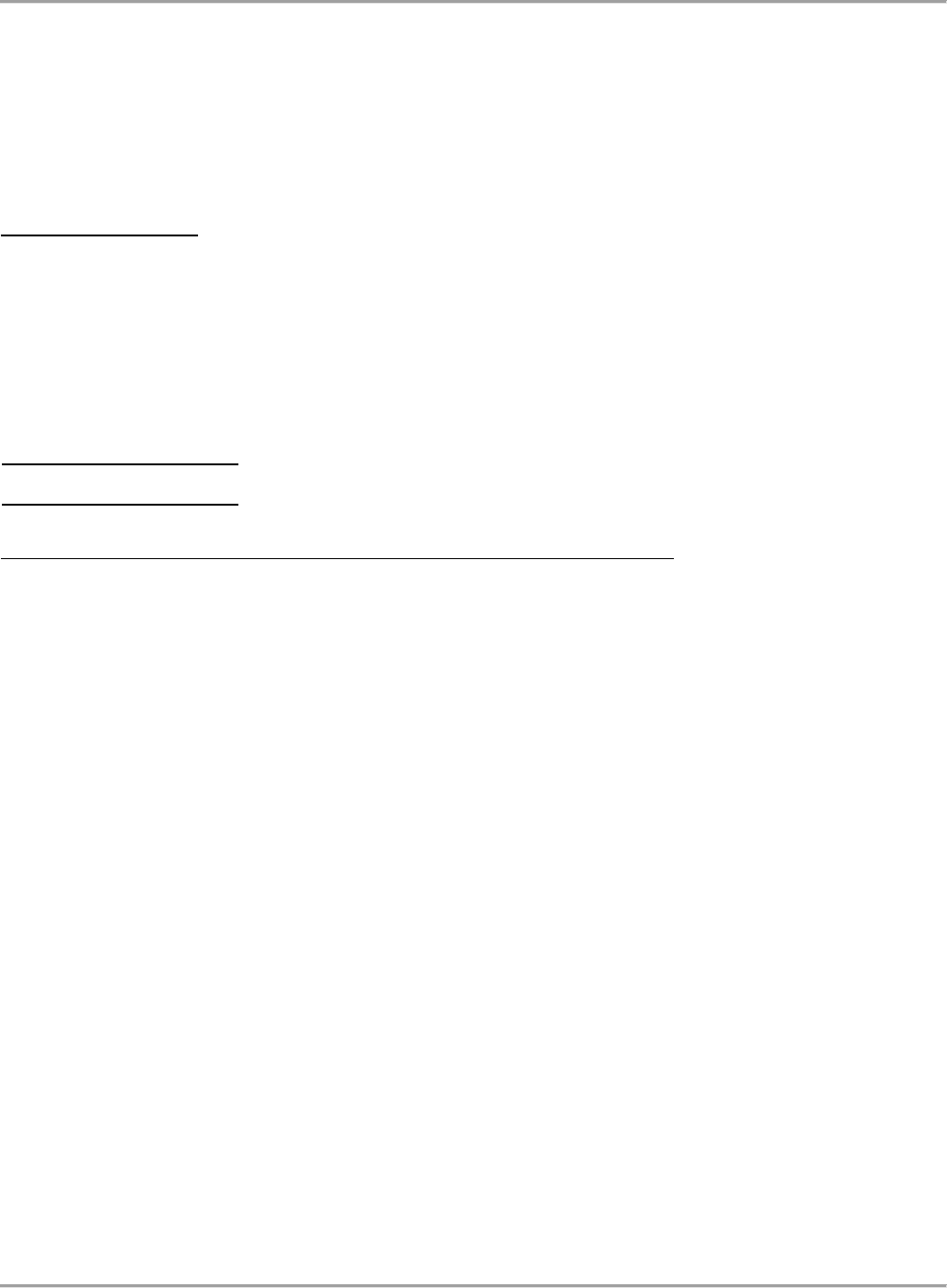
Sample Jury Verdict Forms
Page 389
FORM 3: SPECIAL VERDICT FORM (A)
DISTRICT COURT
CLARK COUNTY, NEVADA
Plaintiff[s],
CASE NO. _______
DEPT. NO.______
v.
Defendant[s].
SPECIAL VERDICT FORM
1. Has___________ established a claim of
libel against___________ as to the __________e-mail sent
by _____________
to______________ and _____________ (
Exhibit “____,” No. ____)?
ANSWER :
YES ______
NO ______
If “YES,” what amount of money do you find from a preponderance of the
evidence should be
awarded to _______________ and against ______________?
$_______________ (Answer in Dollars and Cents)
2.
Has ______________
established a claim of libel against ___________
as
to the _______ letter sent
by ____________ to ____________
and ____________
(Exhibit “____,” No. ____)?
ANSWER :
YES _______
NO______
If “YES,” what amount of money do you find from a preponderance of the
evidence should be
awarded to ________ and against _____________?
$_______________ (Answer in Dollars and Cents)

Sample Jury Verdict Forms
Page 390
3. Add the Dollars and Cents from numbers 1-[2], above.
TOTAL AMOUNT AWARDED in Dollars and Cents $ ___________________.
DATED this _____day of _____, 20_____.
FOREPERSON

Sample Jury Verdict Forms
Page 391
FORM 4: SPECIAL VERDICT FORM
(B)
DISTRICT COURT
CLARK COUNTY, NEVADA
Plaintiff[s], C
ASE NO.______
DEPT. NO. _______
vs.
Defendant[s].
SPECIAL VERDICT
1.
Do you find from a preponderance of the evidence that the
Defendant[s] was [were] negligent
and that such negligence was a proximate
cause of the accident?
ANSWER :
YES _______
NO _______
If you have answered “NO,” to Question No.1 above, you need not complete the
remaining
portion of this Verdict Form. Otherwise, proceed to Question No.2.
2.
Do you find from a preponderance of the evidence that Plaintiff[s] was [were]
negligent and that
such negligence was a proximate cause of the injuries
complained of by the Plaintiff[s]?
ANSWER :
YES ______
NO ______
If you have answered “NO” to Question No. 2 above, you need not complete the
remaining
portion of this Verdict Form.

Sample Jury Verdict Forms
Page 392
3.
Using one hundred percent (100%) as the total combined negligence which acted as a proximate
cause of the injuries complained of by
Plaintiff[s], what percentage of the total combined
negligence do you find
from the evidence is attributable to:
Defendant[s] ______
%.
_________________________ _______%
TOTALING: 1
00 %.
DATED this ______day of ______, 20_____.
FOREPERSON

Sample Jury Verdict Forms
Page 393
FORM 5: SPECIAL VERDICT FORM (C)
DISTRICT COURT
CLARK COUNTY, NEVADA
Plaintiff[s],
CASE NO. ______
vs.
DEPT. NO. ______
Defendant[s].
SPECIAL VERDICT
We, the Jury, duly impaneled in the above-entitled action, having
found for the Plaintiff[s] and against
the Defendant[s], further find:
1.
The percentage of negligence on the part of Defendant[s] to
be ______
%.
2.
The percentage of negligence on the part of Plaintiff[s] to
be _______
%.
Total must be 100%.
DATED this ______day of_____, 20_____.
FOREPERSON

Sample Jury Verdict Forms
Page 394
FORM 6: VERDICT FOR PLAINTIFF — EXPENSES
DISTRICT COURT
CLARK COUNTY, NEVADA
Plaintiff[s],
CASE NO. _____
vs.
DEPT. NO. _____
Defendant[s].
VERDICT FOR PLAINTIFF
We, the jury in the above-entitled action, find for the Plaintiff[s] and
against the Defendant[s] and
without reduction for Plaintiff’s [Plaintiffs’] contributory
negligence assess the total amount of the
Plaintiff’s [Plaintiffs’] damages as follows:
Past Medical Expenses $ ______
Future Medical Expenses $______
Past Loss of Wages $ ______
Future Loss of Wages $ ______
Past Pain and Suffering $ ______
Future Pain and Suffering $ ______
Total Damages $ ______
DATED this _____day of______, 20____.
______________________
FOREPERSON
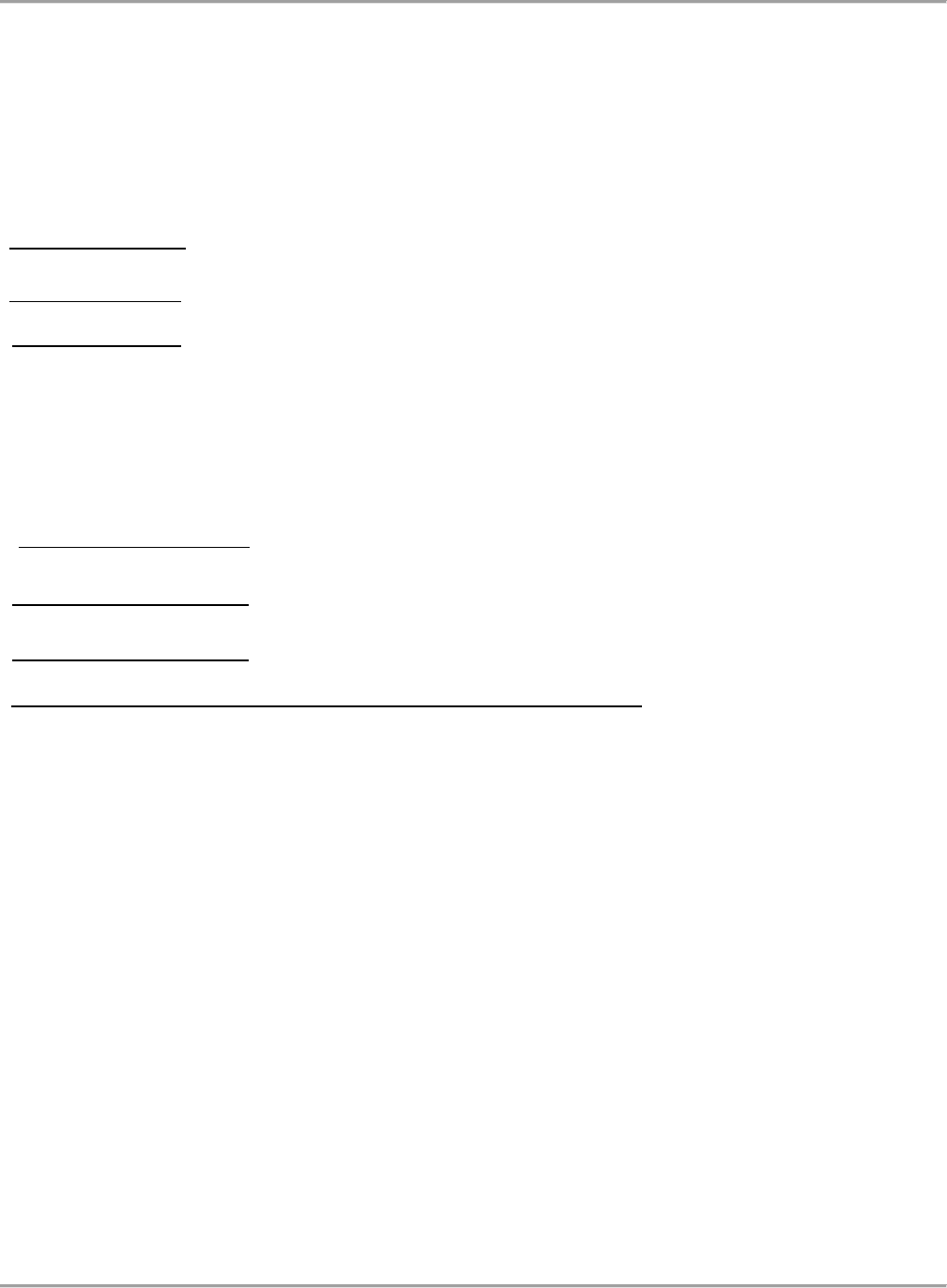
Sample Jury Verdict Forms
Page 395
FORM 7: SPECIAL VERDICT — FRAUD
DISTRICT COURT
CLARK COUNTY, NEVADA
Plaintiff[s], Consolidated Cases
CASE NO. _____
_____
_____
vs.
DEPT. NO. _____
(CASE NO.________)
Defendant[s].
SPECIAL VERDICT
Claims against ______________(Defendant1)
1.
Did _____________
prove by clear and convincing evidence that ______________(Defendant 1)
perpetrated a fraud by ___________________ (select one: intentional misrepresentation/false
promise/concealment/nondisclosure)?
ANSWER :
YES _______
NO _______
If you answered “NO” to Question 1, please proceed to Question 4.
2. If you answered “YES” to Question 1, what damages, if any, apart from punitive damages, did
_________ prove to a reasonable certainty as a proximate result of _____________(Defendant 1)’s
conduct?
$ ____________ (Answer in Dollars and Cents)

Sample Jury Verdict Forms
Page 396
3.
If you answered “YES” to Question 1, do you find that _________________(Defendant 1)
engaged in oppressive, fraudulent, or malicious conduct as to __________________?
ANSWER: YES ______ NO _______
Claims against ______________(Defendant 2)
4.
Did ____________
prove by clear and convincing evidence that ______________ (Defendant 2)
perpetrated a fraud by ___________________ (select one: intentional misrepresentation/false
promise/concealment/nondisclosure) ?
ANSWER :
YES _______
NO _______
If you answered “NO,” to Question 4, please skip to the end of the form and have the Jury
Foreperson sign where indicated.
5.
If you answered “YES,” to Question 4, what damages, if any, apart from punitive damages, did
____________ prove to a reasonable certainty as a proximate result of __________(Defendant 2)’s
conduct ?
$ ______________ (Answer in Dollars and Cents)
6.
If you answered “YES” to Question 5, do you find that ___________________(Defendant 2) engaged
in oppressive, fraudulent, or malicious conduct as to _____________________
?
ANSWER :
YES _______
NO _______
DATED this_____day of_____, 20_____.
__________________________________
FOREPERSON

Sample Jury Verdict Forms
Page 397
FORM 8: SPECIAL VERDICT — COMPARATIVE NEGLIGENCE PERCENTAGES
DISTRICT COURT
CLARK COUNTY, NEVADA
Plaintiff[s],
vs.
DEPT. NO._____
CASE NO. _____
Defendant[s].
SPECIAL VERDICT
We the jury in the above-entitled case, find the following verdict on the
questions submitted to us:
1. Was [Were] the Defendant[s], __________________, negligent?
ANSWER :
YES______
NO______
If you have answered Question No. 1 “YES,” then answer the next question. If
you answered Question
No. 1 “NO,” you will leave the answers to the
remaining questions blank and sign and return this
verdict without answering any of
the following questions.
2. Was the negligence of the Defendant[s] a proximate cause
of the injury to the Plaintiff[s]?
ANSWER :
YES______
NO ______
If you have answered Question No. 2 “YES,” then answer the next question. If
you have answered
Question No. 2 “NO,” you will leave the answers to the remaining questions blank and sign and
return this verdict without answering any of
the following questions.

Sample Jury Verdict Forms
Page 398
3.
Was [Were] the Plaintiff[s] negligent?
ANSWER :
YES______
NO______
4. Was the negligence of Plaintiff[s] a proximate cause of
their own injuries?
ANSWER :
YES_____
NO_____
5. If you have answered Question No. 3 OR Question No. 4
“NO,” do not answer this question and
proceed to Question No. 6. However, if you have answered both
Question No. 3 AND Question
No. 4 “YES,” then answer the following: “Taking a
combined negligence which caused the injuries
as 100%, what
percentage of negligence do you attribute to”:
Plaintiff[s]__________________
Percentage: ______
%.
Defendant[s]________________
Percentage: ______
%.
6. What sum of money will fairly and reasonably fully
compensate Plaintiff[s],______________ , for:
(a) The reasonable medical expenses Plaintiff[s] has [have] necessarily incurred as
a result of the
accident.
ANSWER:______
.
(b) The medical expenses which you believe the Plaintiff[s] is [are] reasonably
certain to incur in the
future as a result of the accident.
ANSWER:______
.
(c) Plaintiff's [Plaintiffs’] loss of earnings from the date of the accident to the present.
ANSWER:______
.
(d) The physical and mental pain, suffering, anguish and disability
endured by the Plaintiff[s] from the
date of the accident to the present.
ANSWER:______.
(e) The physical and mental pain, suffering, anguish and disability
which you believe Plaintiff[s] is
reasonably certain to experience in the
future as a result of the accident.
ANSWER:______
.

Sample Jury Verdict Forms
Page 399
DATED this_____day of_____, 20____.
FOREPERSON

Table of Authorities
Page cd
TABLE OF AUTHORITIES
Cases
A.C. Shaw Construction v. Washoe County
, 105 Nev. 913, 915, 784 P.2d 9, 10 (1989).................................................................. 248
Ace Truck & Equip. Rentals, Inc. v. Kahn
, 103 Nev. 503, 746 P.2d 132 (1987) ....................................................................... 100, 193
Acosta v. Glenfed Development Corp.
, 128 Cal.App.4th 1278, 28 Cal.Rptr.3d 92 (2005) .............................................................. 342
Addington v. Texas
, 441 U.S. 418, 432-33 (1979) ................................................................................................................................... 40
Aetna Casualty & Sur. Co. v. Aztec Plumbing Corp
., 106 Nev. 474, 476, 796 P.2d 227 (1990) ..................................................... 364
Ainsworth v. Combined Ins. Co. of Am.
, 104 Nev. 587, 593, 763 P.2d 673, 676 (1988) ................................................................. 174
Ainsworth v. Combined Ins. Co. of Am
., 105 Nev. 237, 251, 774 P.2d 1003, 1014 (1989) ............................................................. 179
Ainsworth v. Combined Ins. Co. of America
, 104 Nev. 587, 763 P.2d 673 (1988) ......................................................... 169, 186, 194
Albert H. Wohlers & Co. v. Bartgis
, 114 Nev. 1249, 1262, 969 P.2d 949, 958 (1999) ...................................................................... 310
Albert H. Wohlers & Co. v. Bartgis
, 114 Nev. 1249, 1267, 969 P.2d 949, 961 (1998) ...................................................................... 169
Albert H. Wohlers & Co. v. Bartgis
, 114 Nev. 1249, 969 P.2d 949 (1998) ........................................................................ 186, 246, 247
Albert H. Wohlers & Co. v. Bartgis
, 114 Nev. 1249, 969 P.2d 949 (1999) ......................................................................................... 193
Albert H. Wohlers & Co. v. Bartgis
, 114 Nev. 1249, 969 P.2d 949, 956 (1998) .............................................. 171, 172, 173, 175, 177
Albert H. Wohlers & Co. v. Bartgis,
114 Nev. 1249, 969 P.2d 949, 961 (1998) ................................................................................ 188
Albert H. Wohlers & Co. v. Bartgis
, 114 Nev. 1249, at 1260 n.4, 969 P.2d 949, 957 n.4 (1998) ....................................................... 40
Allan v. Levy, 109 Nev.
46, 846 P.2d 274 (1993) ................................................................................................................................... 141
Allegiant Air, LLC v. AAMG Mktg. Grp., LLC
, No. 64182, 2015 WL 6709144 (Nev. Oct. 29, 2015) ........................................... 212
Allen v. Anderson
, 93 Nev. 204, 562 P.2d 487 (1977) .......................................................................................................................... 197
Allied Fidelity Insurance Co. v. Pico,
99 Nev. 15, 17-18, 656 P.2d 849, 851 (1983) ......................................................................... 116
Allied Fidelity Insurance Co. v. Pico
, 99 Nev. 15, 656 P.2d 849 (1983) ............................................................................................. 113
Allison v. Merck and Co
., 110 Nev. 762, 767, 878 P.2d 948, 952 (1994) ............................................................................................ 105
Allison v. Merck and Co., Inc.,
110 Nev. 762, 766-69, 878 P. 2d 948, 951 -53 (1994) ..................................................................... 107
Allison v. Merck and Co., Inc.,
110 Nev. 762, 774-79, 878 P. 2d 948, 956-59 (1994) ...................................................................... 108

Table of Authorities
Page cdi
Allstate Ins. Co. v. Miller
, 125 Nev. 300, 305, 212 P.3d 318, 322 (2009) ............................................................................................ 178
Allstate Ins. Co. v. Miller
, 125 Nev. 300, 310, 212 P.3d 318, 325 (2009) ............................................................................................ 169
Allstate Ins. Co. v. Miller
, 125 Nev. 300, 311, 212 P.3d 318, 325 (2009) ............................................................................................ 301
Allum v. Valley Bank of Nevada
, 114 Nev. 1313, 1319-1320, 970 P.2d 1062, 1066 (1998) ............................................................. 311
Allum v. Valley Bank of Nevada,
114 Nev. 1313, 1319-20, 970 P.2d 1062, 1065-66 (1998) ........................................................... 313
Allum v. Valley Bank of Nevada,
114 Nev. 1313, 970 P.2d 1062 (1998
)
............................................................................................ 311
Alsenz v. Clark Co. School Dist
., 109 Nev. 1062, 1064–65, 864 P.2d 285, 286–87 (1993) ................................................................ 86
Am. Excess Ins. Co. v. MGM
, 102 Nev. 601, 604, 729 P.2d 1352, 1354 (1986)................................................................................. 220
Am. First Fed. Credit Union v. Soro
, 131 Nev. Adv. Op. 73, 359 P.3d 105 (2015) .......................................................................... 324
American Bank Stationery v. Farmer
, 106 Nev. 698, 701, 799 P.2d 1100, 1101-02 (1990) ............................................................. 322
American Excess Ins. Co. v. MGM Grand Hotels
, 102 Nev. 601, 605, 729 P.2d 1352, 1354 (1986) ..................... 172, 173, 175, 177
American Excess Ins. Co. v. MGM Grand Hotels, Inc.
, 102 Nev. 601, 604, 729 P.2d 1352 ............................................................ 171
American Sodium Co. v. Shelley,
51 Nev. 344, 276 P. 11 (1929) ........................................................................................................ 284
Amoroso Constr. v. Lazovich and Lazovich
, 107 Nev. 294, 810 P.2d 775 (1991) ............................................................................ 248
Anderson v. Sanchez,
132 Nev. Adv. Op. 34, 373 P.3d 860 (2016) ........................................................................................... 202, 225
Anderson v. Sanchez,
132 Nev. Adv. Op. 34, 373 P.3d 860, 863 (2016
)
............................................................................................ 238
A
ndrews v. Kingsbury Gen. Imp. Dist.,
84 Nev. 88, 436 P.2d 813 (1968) ......................................................................................... 374
Anvui, LLC v. G.L. Dragon, LLC
, 123 Nev. 212, 215-16, 163 P.3d 405, 407 (2007)......................................................................... 219
Anvui, LLC v. G.L. Dragon, LLC
, 123 Nev. 212, 216, 163 P.3d 405, 407 (2007) .............................................................................. 324
Anvui, LLC v. G.L. Dragon, LLC.
, 123 Nev. 213, 215-16, 163 P.3d 405, 407 (2007)........................................................................ 317
Anvui, LLC v. G.L. Dragon, LLC.
, 123 Nev. 213, 216, 163 P.3d 405, 407 (2007) ............................................................................. 316
Arbach v. Gruba
, 89 S.D. 322, 334, 232 N.W.2d 842, 849 (1975) ......................................................................................................... 33
Atherton Condo. v. Blume Development Co
., 115 Wash. 2d 506, 799 P.2d 250 (1990) ................................................................. 362
Atkinson v. MGM Grand Hotel, Inc.,
120 Nev. 639, 641, 98 P.3d 678, 679 (2004) ........................................................................... 73
Awada v. Shuffle Master, Inc.,
123 Nev. 613, 624, 173 P.3d 707, 714 (2007) .................................................................................... 239
Balsamo v. Sheriff, Clark County
, 93 Nev. 315, 316, 565 P.2d 650 (1977) ............................................................................... 153, 156

Table of Authorities
Page cdii
Banks ex rel. Banks v. Sunrise Hosp.,
120 Nev. 822, 832, 102 P.3d 52, 59 (2004) .............................................................................. 78
Banks ex rel. Banks v. Sunrise Hosp
., 120 Nev. 822, 839, 102 P.3d 52, 64 (2004) .............................................................................. 81
Banks ex rel. Banks v. Sunrise Hosp.
, 120 Nev. 822, 842, 102 P.3d 52, 65 (2004) .............................................................................. 66
Banta v. Savage
, 12 Nev. 151 (1877) ........................................................................................................................................................ 164
Barmettler v. Reno Air, Inc.
, 114 Nev. 441, 446-47, 956 P.2d 1382, 1386 (1998) ............................................................................. 153
Barmettler v. Reno Air, Inc.
, 114 Nev. 441, 446-7, 956 P.2d 1382, 1386 (1998) ...................................................................... 153, 154
Barmettler v. Reno Air, Inc.
, 114 Nev. 441, 446-7, 956 P.2d, 1382, 1386 (1998) .............................................................................. 160
Barmettler v. Reno Air, Inc.,
114 Nev. 441, 449, 956 P.2d 1382 (1998) ............................................................................................. 336
Barmettler v. Reno Air, Inc.,
114 Nev. 441, 956 P.2d 1382 (1998) ..................................................................................................... 226
Barnes v. Delta Lines Inc.,
99 Nev. 688, 669 P2d 709 (1983) ................................................................................................................. 74
Bass-Davis v. Davis,
122 Nev. 442, 134 P.3d 103 (2006) ...................................................................................................................... 280
Bass-Davis v. Davis
, 122 Nev. 442, 445, 134 P.3d 103, 105 (2006) ....................................................................................................... 42
Bass-Davis v. Davis
, 122 Nev. 442, 448, 134 P.3d 103, 106-07 (2006) ................................................................................................. 43
Bates v. Chronister
, 100 Nev. 675, 680, 691 P.2d 865, 869 (1984) ...................................................................................................... 238
Beales v. Hillhaven, Inc.
, 108 Nev. 96, 102 825 P.2d 212, 216 (1992)................................................................................................. 322
Bedore v. Familian,
122 Nev. 5, 125 P.3d 1168 (2006) ................................................................................................................ 284, 295
Bell v. Leven
, 120 Nev. 388, 391-92, 90 P.3d 1286, 1288-89 (2004) .................................................................................................... 240
Bellevue Farm Owners Ass'n v. Stevens,
394 P.3d 1018, 1024–25 (Wash. Ct. App. 2017) ............................................................. 100
Benchmark Ins. Co. v. Sparks
, 127 Nev. 407, 412, 254 P.3d 617, 621 (2011) .................................................................................... 230
Bendix Corp. v. Adams
, 610 P.2d 24 (Alaska 1980) ............................................................................................................................. 262
Bergstrom v. Estate of DeVoe
, 109 Nev. 575, 577, 854 P.2d 860, 861 (1993) .................................................................................... 238
Bergstrom v. Estate of DeVoe
, 109 Nev. 575, 577-78, 854 P.2d 860, 861-62 (1993) ........................................................................ 238
Bernard v. Rockhill Development Co.,
103 Nev. 132, 135, 734 P.2d 1238, 1241 (1987) ................................................................. 244
Betsinger v. D.R. Horton, Inc.,
126 Nev. 162, 165, 232 P.3d 433, 435 (2010) ................................................................................... 188
Betsinger v. D.R. Horton, Inc.,
126 Nev. 162, 167, 232 P.3d 433, 436 (2010) ................................................................................... 251
Betsinger v. D.R. Horton, Inc.
, 126 Nev. 232 P.3d 433, 435 (2010) ...................................................................................................... 38

Table of Authorities
Page cdiii
Betsinger v. D.R. Horton, Inc.
, 126 Nev. Adv. Op. 17, 232 P.3d 433 (2010) ..................................................................................... 193
Bielar v. Washoe Health Sys., Inc
, 129
Nev. 459, 306 P.3d 360 (2013) .............................................................................................. 217
Big-D Const. Corp. v. Take it for Granite Too
, 917 F. Supp. 2d 1096, 1118 (D.Nev. 2013) ........................................................... 188
Bigelow v. Bullard,
111 Nev. 1178, 1185, 901 P.2d 630,634 (1995) .................................................................................................... 311
Bill Stremmel Motors, Inc. d.b.a. v. First National Bank of Nevada
, 94 Nev. 131, 134, 575 P.2d 938 (1978) .............................. 153
Bill Stremmel Motors, Inc. v. IDS Leasing Corp.
, 89 Nev. 414, 417, 514 P.2d 654, 656-57 (1973) ................................................ 226
Bishop v. Stewart
, 13 Nev. 25, 38-39 (1878) .......................................................................................................................................... 243
Blanchard v. Blanchard
, 108 Nev. 908, 911, 839 P.2d 1320, 1322 (1992) ......................................................................... 154, 157, 162
BMW of North America, Inc. v. Gore
, 517 U.S. 559 (1996) ................................................................................................................ 193
Bongiovi v. Sullivan,
122 Nev. 556, 138 P.3d 433 (2006) .................................................................................................... 103, 193, 274
Bongiovi v. Sullivan
, 122 Nev. 556, 579–80, 138 P.3d 433, 450 (2006) .............................................................................................. 274
Botts v. Rushton,
63 Nev. 426, 172 P.2d 147 (1946) ............................................................................................................................... 75
Branda v. Sanford
, 97 Nev. 643, 646, 637 P.2d 1223, 1225 (1981) ...................................................................................................... 274
Breuer–Harrison, Inc. v. Combe,
799 P.2d 716 (Utah Ct.App.1990) ................................................................................................ 238
Briggs v. Spaulding
, 141 U.S. 132, 11 S. Ct. 924 (1891) ........................................................................................................................ 292
Brock v. Premier Trust, Inc. (In re Frei Irrevocable Trust)
, __ Nev. __, 390 P.3d 646, 653 (2017) ............................................... 283
Broussard v. Hill
, 100 Nev. 325, 682 P.2d 1376 (1984) ........................................................................................................................ 299
Bruttomesso v. Las Vegas Met. Police
, 95 Nev. 151, 154, 591 P.2d 254, 256 (1979) .......................................................................... 33
Buck by Buck v. Greyhound Lines, Inc.,
105 Nev. 756, 761, 783 P.2d 437, 440 (1989) ................................................................... 144
Bulbman Inc. v. Nevada Bell
, 108 Nev. 105, 111 825 P.2d 588, 591 (1992) ....................................................................................... 154
Bulbman Inc. v. Nevada Bell
, 108 Nev. 105, 111, 825 P.2d 588, 592 (1992) ...................................................................................... 164
Bunting v. Central Pac. R.R. Co.,
14 Nev. 351, 361 (1879) .................................................................................................................... 75
Burch v. Second Judicial Dist. Court of State ex rel. County of Washoe,
118 Nev. 438, 442, 49 P.3d 647, 649, (2002) ............. 230
Burch v. Second Judicial Dist. Court of State ex rel. County of Washoe
, 118 Nev. 438, 442-44, 49 P.3d 647, 650-51 (2002) ... 229
Busch v. Nervik,
38 Wash.App. 541, 687 P.2d 872 (1984) ................................................................................................................... 238
Butler v. Poulin
, 500 A.2d 257, 260 n.5 (Me.1985) ............................................................................................................................... 161

Table of Authorities
Page cdiv
Buzz Stew, LLC v. City of North Las Vegas
, 124 Nev. 224, 181 P.3d 670 (2008) ............................................................................. 236
Cacoperdo v. Demosthenes
, 37 F.3d 504, 509 (9th Cir.1994) ............................................................................................................... 52
Cagno v. Gaughan
, 2004 WL 3697504 (D. Nev. 2004) ......................................................................................................................... 101
Caldwell v. Consolidated Realty & Mgmt. Co.,
99 Nev. 635, 639, 668 P.2d 284, 287 (1983) .......................................................... 218
Caldwell v. Consolidated Realty and Management Co
., 99 Nev. 635, 638, 668 P.2d 284, 286 (1983) ........................................... 317
Calloway v. City of Reno
, 116 Nev. 250, 256, 993 P.2d 1259, 1263 (2000) ........................................................................................ 201
Canepa v. Durham
, 62 Nev. 417, 423-28153 P.2d 899, 901-03 (1944) ............................................................................................... 244
Canfield v. Gill
, 101 Nev. 170, 172, 697 P.2d 476, 477 (1985) ............................................................................................................. 204
Canfora v. Coast Hotels and Casinos, Inc.,
121 Nev. 771, 776, 121 P.3d 599, 603 (2005) ..................................................... 218, 323
Canfora v. Coast Hotels and Casinos, Inc
., 121 Nev. 771, 779, 121 P.3d 599, 604-05 (2005) ......................................................... 210
Canterino v. The Mirage Casino-Hotel
, 117 Nev. 19, 16 P.3d 415 (2001) .......................................................................................... 82
Cashman Equip. Co. v. W. Edna Assocs., Ltd.,
132 Nev. Adv. Op. 69, 380 P.3d 844, 847 (2016) ................................................. 233
Cassim v. Allstate Ins. Co
., 33 Cal.4th 780 (2004) .................................................................................................................................. 26
Cen. Tel. Co. v. Fixtures Mfg. Corp.
, 103 Nev. 298, 738 P.2d 510 (1987) ......................................................................................... 112
Cent. Tel. Co. v. Fixtures Mfg. Corp
., 103 Nev. 298, 300, 738 P.2d 510, 512 (1987) ....................................................................... 112
Central Bit Supply v. Waldrop Drilling
, 102 Nev. 139, 141, 717 P.2d 35, 37 (1986) ........................................................................ 113
Central Bit Supply, Inc. v. Waldrop Drilling & Pump Inc
., 102 Nev. 139, 141, 717 P.2d 35, 37 (1986) .............................. 115, 118
Century Sur. Co. v. Casino West, Inc
., 329 P.3d 614, 616 (Nev. May 29, 2014) ............................................................................... 168
Certified Fire Prot. Inc. v. Precision Constr.,
128 Nev. 371, 283 P.3d 250, 255 (2012) .......................................................... 202, 207
Certified Fire Prot. Inc. v. Precision Constr
., 128 Nev. 371, 283 P.3d 250, 256 (2012) ................................................................... 212
Certified Fire Prot. Inc. v. Precision Constr
., 128 Nev. 371, 379-80, 283 P.3d 250, 256 (2012) ..................................................... 211
Certified Fire Prot. Inc. v. Precision Constr.,
128 Nev., 371, 381, 283 P.3d 250, 257 (2012) .......................................................... 212
Charleston Hill Nat. Mines Inc. v. Clough
, 79 Nev. 182, 189, 380 P.2d 458, 461 (1963) ................................................................ 231
Cheqer, Inc. v. Painters & Decorators Joint Comm., Inc.,
98 Nev. 609, 655 P.2d 996 (1982) ........................................................ 242
Cheyenne Const., Inc. v. Hozz,
102 Nev. 308, 312-13, 720 P.2d 1224, 1227 (1986) ........................................................................ 249
Chicago Title Agency of Las Vegas, Inc. v. Schwartz
, 109 Nev. 415, 851 P.2d 419 (1993) ............................................................. 299

Table of Authorities
Page cdv
Chiquita Mining Co. v. Fairbanks
,
Morse & Co
., 60 Nev. 142, 104 P.2d 191, 195 (1940) ............................................. 113, 119, 120
Chowdry v. NLVH, Inc.,
109 Nev. 478, 851 P.2d 459 (1993) .............................................................................................................. 274
Chung v. Atwell
, 103 Nev. 482, 484, 745 P.2d 370, 371 (1987) ........................................................................................................... 213
Circus Circus Hotels v. Witherspoon,
99 Nev. 56, 657 P. 2d 101 (1983) .......................................................................................... 263
City of Bridgewater v. Morris, Inc.
, 594 N.W.2d 712, 716 (1999) ........................................................................................................ 33
City of Elko v. Zillich
, 100 Nev. 366, 683 P.2d 5 (1984) ...................................................................................................... 374, 378, 379
City of Las Vegas v. Bustos
, 119 Nev. 360, 75 P.3d 351 (2003) .......................................................................................... 374, 376, 377
City of Las Vegas v. Cliff Shadows Prof'l Plaza, LLC,
129 Nev. 1, 7, 293 P.3d 860, 866 (2013) ...................................................... 217
City of N. Las Vegas v. Robinson
, 122 Nev. 527, 134 P.3d 705 (2006) ..................................................................................... 374, 376
Cladianos v. Friedhoff
, 69 Nev. 41, 45-46, 240 P.2d 208, 210 (1952) ................................................................................................. 232
Clark County Sch. Dist. v. Mueller
, 76 Nev. 11, 348 P.2d 164 (1960) ................................................................................................ 379
Clark County Sports Enterprises, Inc. v. City of Las Vegas
, 96 Nev. 167, 172, 606 P.2d 171, 175 (1980) .................................... 215
Clark Sanitation, Inc. v. Sun Valley Disposal Co.
, 87 Nev. 338, 487 P.2d 337 (1971) ..................................................................... 164
Clark v. Columbia/HCA Information Services, Inc.
, 117 Nev. 468, 480, 25 P.3d 215, 224 (2001) ................................................ 228
Clark v. Lubritz
, 113 Nev. 1089, 944 P.2d 861 (1997) ......................................................................................................... 193, 296, 304
Cobb v. Osman
, 83 Nev. 415, 422, 433 P.2d 259, 263 (1967) ..................................................................................................... 253, 315
Cobb v. Osman
, 83 Nev. 419, 433 P.2d 259, 263 (1967) ...................................................................................................................... 318
Cohen v. Mirage Resorts, Inc.,
119 Nev. 1, 62 P.3d 720 (2003) ................................................................................................. 297, 304
Cohen v. Wedbush, Noble, Cooke, Inc.
, 841 F.2d 282, 287 (9th Cir. 1988) ............................................................................. 153, 158
Colle v. State
, 85 Nev. 289, 294, 454 P.2d 21, 24 (1969) ......................................................................................................................... 49
Collins v. Burns,
103 Nev. 394, 397, 741 P.2d 819, 821 (1987) ........................................................................................................... 162
Collins v. Union Federal Savings & Loan
, 99 Nev. 284, 303, 662 P.2d 610, 622 (1983) .................................................................. 102
Colorado Environments, Inc. v. Valley Grading Corp
., 105 Nev. 464, 470-72, 779 P.2d 80, 84 (1989)........................................ 249
Conner v. Southern Nevada Paving, Inc
., 103 Nev. 353, 355-56, 741 P.2d 800, 801 (1987) ........................................................... 249
Connor v. Southern Nevada Paving, Inc.
, 103 Nev. 353, 355-56, 741 P.2d 800, 801 (1987)........................................................... 253
Consolidated Generator-Nevada v. Cummins Engine
, 114 Nev. 1304, 1311, 971 P.2d 1251, 1256 (1998) ......................... 246, 247

Table of Authorities
Page cdvi
Consolidated Generator-Nevada, Inc. v. Cummins Engine Co., Inc
., 114 Nev. 1304, 1311, 971 P.2d 1251, 1255 (1998) ......... 259
Consolidated Generator-Nevada, Inc. v. Cummins Engine Co., Inc
., 114 Nev. 1304, 971 P.2d 1257 (1998) .............................. 102
Cook v. Cook,
112 Nev. 179, 912 P. 2d 264 (1996); .............................................................................................................................. 294
Corp. v. Eisenman Chemical Co.,
101 Nev. 664, 709 P.2d 164 (1985) ............................................................................................... 242
Countrywide Home Loans, Inc. v. Thitchener
, 124 Nev. Adv. Op. No. 64, 192 P.3d 243 (2008) ................................. 193, 195, 196
County of Clark v. Alper
, 100 Nev. 382, 685 P.2d 943 (1984) ............................................................................................ 373, 376, 377
County of Clark v. Bonanza No. 1
, 96 Nev. 643, 650-51, 615 P.2d 939, 943-44 (1980) ................................................................... 208
County of Clark v. Sun State Properties, Ltd
., 119 Nev. 329, 72 P.3d 954 (2003) ............................................................................ 374
County of Clark, ex rel. University Medical Center v. Upchurch,
114 Nev. 749, 759, 961 P.2d 754, 760 (1998) .......................... 65
Covil v. Robert & Co. Assocs
., 112 Ga.App. 163, 144 S.E.2d 450 (1965) ........................................................................................... 362
Covington Bros. v. Valley Plastering, Inc.
, 93 Nev. 355, 360, 566 P.2d 814, 817 (1977) ................................................................. 245
Covington Bros. v. Valley Plastering, Inc.
, 93 Nev. 355, 360-63, 566 P.2d 814, 817-19 (1977) ...................................................... 250
Crowley v. Lafayette Life Ins. Co.,
106 Idaho 818, 683 P.2d 854 (1984) ............................................................................................ 238
Cucinotta v. Deloitte & Touche, LLP
,
129 Nev. 322, 302 P.3d 1099, 1101 (2013) ........................................................................... 263
Culverson v. State
, 106 Nev. 484, 488, 797 P.2d 238, 240 (1990) .......................................................................................................... 96
D.R. Horton, Inc. v. Green
, 120 Nev. 549, 553-54, 96 P.3d 1159, 1162-63 (2004) ........................................................................... 229
D’Angelo v. Gardner (Western States)
, 107 Nev. 704, 718, 819, P.2d 206, 215-16 (1991) .............................................................. 311
D’Angelo v. Gardner
, 107 Nev. 704, 711-712, 819 P.2d 206, 211-12 (1991) ..................................................................................... 322
D’Angelo v. Gardner
, 107 Nev. 704, 716-718, 819 P.2d 206, 215 (1991) ........................................................................................... 309
D’Angelo v. Gardner
, 107 Nev. 704, 724, 819 P.2d 206, 220 (1991) ................................................................................................... 321
Dalton Properties, Inc. v. Jones
, 100 Nev. 422, 424, 683 P.2d 30, 31 (1984) ..................................................................................... 249
Daly v. Del E. Webb Corp.
, 96 Nev. 359, 361, 609 P.2d 319, 320 (1980) ........................................................................................... 215
Daniel, Mann, Johnson & Mendenhall v. Hilton Hotels Corp
., 98 Nev. 113, 115-16, 642 P.2d 1086, 1087-88 (1982) .............. 249
Dass v. Epplen
, 162 Colo. 60, 424 P.2d 779, 780 (1967) ....................................................................................................................... 212
Davenport v. Comstock Hills-Reno
, 118 Nev. 389, 393. 46 P.3d 62 (2002) ...................................................................................... 363
Davis v. Beling
128 Nev. Adv. Op. 28, 278 P.2d 501 (2012) ................................................................................................................ 302

Table of Authorities
Page cdvii
Davis v. Belling
, 128 Nev. 301, 316-322, 278 P.3d 501,
512-15 (2012)
.............................................................................................. 249
Davis v. State
, 130 Nev. Adv. Op. 16, 321 P.3d 867, 871 (2014) ........................................................................................................... 96
DeBoer v. Sr. Bridges of Sparks Fam. Hosp.,
128 Nev. 406, 412, 282 P.3d 727, 732 (2012)............................................... 62, 64, 105
DeBoer v. Sr. Bridges of Sparks Fam. Hosp
., 128 Nev. 406,412, 282 P.3d 727, 732 (2012)............................................................... 63
Deiss v. S. Pac. Co
., 56 Nev. 151, 177, 53 P.2d 332, 336 (1936) ............................................................................................................. 38
Desert Palace Inc., v. Costa
, 539 U.S. 90 at 100 (2003)........................................................................................................................... 41
DeVoto v. Pacific Fid. Life Ins. Co
., 618 F.2d 1340, 1347 (9th Cir.1980) .......................................................................................... 258
Dickenson v. Nev. Dep't of Wildlife,
110 Nev. 934, 877 P.2d 1059, 1061 (1994) .................................................................... 217, 219
Dickenson v. State, Dept. of Wildlife
, 110 Nev. 934, 937, 877 P.2d 1059, 1061 (1994) .......................................................... 218, 219
Dillard Dep’t. Stores, Inc. v. Beckwith
, 115 Nev. 372, 989 P.2d 882 (1999) ...................................................................................... 193
Dillard Dept. Stores, Inc. v. Beckwith
, 115 Nev. 372, 377, 989 P.2d 882, 885 (1999) ...................................................................... 312
Dillard Dept. Stores, Inc. v. Beckwith
, 115 Nev. 372, 379, 989 P.2d 882, 886-87 (1999) ................................................................. 318
Dillard Dept. Stores, Inc. v. Beckwith
, 115 Nev. 372, 379-80, 989 P.2d 882, 886-87 (1999) ........................................................... 315
Dixon v. R,H, Thatcher
, 103 Nev., 414, 417, 742 P.2d 1029,1031 (1987) .......................................................................................... 278
Doe By & Through G.S. v. Johnson
, 52 F.3d 1448, 1459 (7th Cir. 1995) ............................................................................................. 33
Doe v. Glanzer v. Glanzer,
230 F.3d 1258, 1264-1265 (9
th
Cir. 2000) .................................................................................................. 50
Dolge v. Masek
, 70 Nev. 314, 318, 268 P.2d 919, 921 (1954) ............................................................................................................... 203
Doud v. Las Vegas Hilton Corp.,
109 Nev. 1096, 1100, 864 P.2d 796, 798 (1993) ............................................................................. 62
Dow Chemical Co. v. Mahlum
, 114 Nev. 1468, 970 P.2d 98 (1998) ............................................................................................64, 341
Drexler v. Tyrrell
, 15 Nev. 114, 123-24 (1880) ...................................................................................................................................... 228
Driscoll v. Erreguible
, 87 Nev. 97, 101, 482 P.2d 291, 294 (1971) ........................................................................................................ 63
Drummond v. Mid-West Growers
, 91 Nev. 698, 542 P.2d 198 (1975) .......................................................................................... 64, 66
Drummond v. Mid-West Growers,
91 Nev. 698, 706-7, 542 P.2d 198,204 (1975) ............................................................................ 75
Dutt v. Kremp
, 111 Nev. 567, 571-72, 894 P.2d 354, 357 (1995) ........................................................................................................ 101
Dynalectric Co. of Nev., Inc. v. Clark & Sullivan, Inc
., 127 Nev. 480, 484-486, 255 P.3d 286, 288-290 (2011) ....................... 249
Dynamic Transit v. Trans Pac. Ventures
, 128 Nev. 755, 291 P.3d 114, 118 (2012) ......................................................................... 249

Table of Authorities
Page cdviii
Easton Bus. Opp. v. Town Executive Suites
, 126 Nev 119, 124–25, 230 P.3d 827, 830–31 (2010) ................................................ 216
Easton Bus. Opp. v. Town Executive Suites,
126 Nev. 119, 131, 230 P.3d 827, 835 (2010) ............................................................ 217
Easton Bus. Opportunities, Inc. v. Town Exec. Suites
, 126 Nev. 119, 230 P.3d 827 (2010) ............................................................ 214
Eaton v. J. H. Inc.
, 94 Nev. 446, 450-51, 581 P.2d 14, 16-17 (1978) ................................................................................................... 250
Edwards Industries, Inc. v. DTE/BTE, Inc
., 112 Nev. 1025, 1034, 923 P.2d 569, 574-75 (1996) ................................................... 249
Egan v. Mut. of Omaha Ins. Co.
, 620 P.2d 141 (Cal. 1979) ................................................................................................................. 196
Eikelberger v. Rogers
, 92 Nev. 282, 549 P.2d 748 (1976) ..................................................................................................................... 160
Eikelberger v. State ex rel. Dept. of Hwys
., 83 Nev. 306, 429 P.2d 555 (1967) .................................................................................. 378
Eikelberger v. Tolotti
, 96 Nev. 525, 611 P.2d 1086 (1980) ................................................................................................................... 102
Elley v. Stephens,
104 Nev. 413, 417-18, 760 P.2d 768, 771-72 (1988)............................................................................................... 105
Ellis v. Nelson
, 68 Nev. 410, 419, 233 P., 2d 1072, 1076 (1951) .......................................................................................................... 278
Ellison v. California State Auto. Ass'n,
106 Nev. 601, 603, 797 P.2d 975, 977 (1990) ............................................. 184, 218, 220, 221
Epperson v. Roloff
, 102 Nev. 206, 212, 719, P.2d 799, 803 (1986) ............................................................................................. 153, 157
Epperson v. Roloff
, 102 Nev. 206, 213 719 P.2d 799 (1986) ................................................................................................................ 337
Escamilla v. Marshburn Bros.,
48 Cal. App. 3d 472 (Cal. Ct. App. 1975) ........................................................................................... 24
Estate of LoMastro ex rel. LoMastro v. Am. Family Ins. Group
, 124 Nev. 1060, 195 P.3d 339, 351–52 (2008) .......................... 188
Evans v. Dean Witter Reynolds, Inc.
, 116 Nev. 598, 5 P.3 1043 (2000) ............................................................................................. 193
E
versole v. Sunrise Villas VIII Homeowners Ass’n,
112 Nev. 1255, 1260, 925 P.2d 505, 509 (1996) .................................. 218, 219
Ewish v. State
, 110 Nev. 221, 229 n. 4, 871 P.2d 306, 312 (1994) ........................................................................................................ 101
Executive Mgmt. Ltd. v. Ticor Title Ins. Co.,
114 Nev. 823, 842, 963 P.2d 465, 478 (1998);
Higgins v. Higgins
, 103 Nev. 443,
744 P.2d 530, 531 (1987) ..................................................................................................................................................................... 264
Executive Mgmt. Ltd. v. Ticor Title Ins. Co.,
114 Nev. 823, 963 P.2d 465 (1998) ............................................................................ 285
Falline v. GNLV Corp
., 107 Nev. 1004, 823 P.2d 888, 891 (1991) ...................................................................................................... 170
Falline v. Golden Nugget Hotel & Casino
, 107 Nev. 1004, 823 P.2d 888, 891 (1991)............................................. 172, 173, 175, 177
Farago Adver., Inc. v. Hollinger Intern., Inc.
, 157 F.Supp.2d 252, 258-259 (S.D.N.Y. 2001) ......................................................... 205
Farmers Home Mut. Ins. Co. v. Fiscus
, 102 Nev. 371, 374, 725 P.2d 234, 236 (1986) ..................................................................... 310
Farmers Home Mut. Ins. v. Fiscus
, 102 Nev. 371, 725 P.2d 234, 235-36 (1981) .............................................................................. 169

Table of Authorities
Page cdix
Farmers Ins. Exch. v. Neal
, 119 Nev. 62, 64, 64 P.3d 472, 473 (2003) ............................................................................... 166, 167, 184
Farmers Ins. Exch. v. Neal,
119 Nev. 62, 64, 64 P.3d 472, 473 (2003) ................................................................................................ 184
Farmers Ins. Exchange v. Young
, 108 Nev. 328, 330, 832 P.2d 376 (1992) ....................................................................................... 185
Farmers Ins. Exchange v. Young
, 108 Nev. 328, 330-34 832 P.2d 376, 377-79 (1992) .................................................................... 220
Fed. Ins. Co. v. Coast Converters
, 130 Nev. Adv. Op. 95, 339 P.3d 1281, 1284 (2014) ................................................................... 184
Federal Ins. Co. v. Coast Converters, Inc
., 339 P.3d 1281, 1283 (Nev. 2014) .......................................................................... 166, 167
Fergason v. LVMPD
, 131 Nev. Adv. Op. 94, 364 P.3d 592, 596 (2015) ............................................................................................. 161
FGA, Inc. v. Giglio
, 128 Nev. Adv. Op. 26, 278 P.3d 490, 496 (2012) ................................................................................................ 129
Fink v. Oshins
, 118 Nev. 428, 49 P.3d 640 (2002) ................................................................................................................................. 263
Finnell v. Bromberg
, 79 Nev. 211, 381 P.2d 221 (1963) .............................................................................................................. 204, 245
Fire Ins. Exch. v. Haugen
, 105 F.3d 664 (9th Cir. 1996) ...................................................................................................................... 185
First Nat. Bank of Julesburg v. Banking Bd.
, 663 P.2d 261 (Colo.App.1983) ................................................................................... 238
Flores v. State
, 114 Nev. 910, 913, 965 P.2d 901, 903 (1998) ................................................................................................................. 32
Foley v. Morse & Mowbray,
109 Nev. 116, 848 P. 2d. 519 (1993) ...................................................................................................... 289
Ford Motor Co. v. Trejo
, 133 Nev. Adv. Op. 68, 402 P.3d 649, 650 (Nev. 2017) ............................................................................. 110
Ford Motor Co. v. Trejo
, 133 Nev. Adv. Op. 68, 402 P.3d 649, 659 (Nev. 2017) ............................................................................. 110
Forrest Currell Lumber Company v. Thomas
, 81 N.M. 161, 464 P.2d 891 (1970) .......................................................................... 228
Foster v. Costco Wholesale Corp.,
128 Nev. 773, 777, 291 P.3d 150, 153 (2012) ............................................................................... 62
Foster v. Costco Wholesale Corp.,
128 Nev. Adv. Op. 71, 291 P.3d 150 (2012) ...................................................................... 125, 127
Fourth St. Place v. Travelers Indem. Co.
, 127 Nev. 957, 963, 270 P.3d 1235, 1239 (2011) ............................................................. 220
Frances v. Plaza Pacific Equities, Inc.,
109 Nev. 91, 847 P.2d 722 (1993) ............................................................................................ 88
Franchise Tax Bd. of Cal. v. Hyatt
, 130 Nev. Adv. Op. 71, 335 P.3d 125, 152 (2014) ........................................................................ 42
Frantz v. Johnson
, 116 Nev. 455, 465 n. 4, 999 P.2d 351, 358 n. 4 (2000) ................................................................................ 246, 247
Frantz v. Johnson
, 116 Nev. 455, 469, 999 P.2d 351, 360 (2000) ........................................................................................................ 251
Frantz v. Johnson,
116 Nev. 455, 999 P.2d 351 (2000) ......................................................................................................................... 280
Frazier v. Drake
, 131 Nev. Adv. Op. 64, 357 P.3d 365, 369 (Nev. App. 2015) .................................................................................... 75

Table of Authorities
Page cdx
Frazier v. Drake
, 357 P.3d 365 (Nev. App. 2015) .................................................................................................................................... 55
Freeman v. Davidson
, 105 Nev. 13, 16, 768 P.2d 885, 887 (1989) ........................................................................................................ 89
Friendly Irishman v. Ronnow
, 74 Nev. 316, 319, 330 P.2d 497, 499 (1958) ...................................................................................... 241
Fuller v. United Elec. Co
., 70 Nev. 448, 452-54, 273 P.2d 136, 137-38 (1954) .................................................................................. 249
Galardi v. Naples Polaris, L.L.C.,
129 Nev. ––––, ––––, 301 P.3d 364, 366 (2013) .......................................................................... 184
Galardi v. Naples Polaris
, LLC, 129 Nev., 306, 310, 301 P.3d 364, 366 (2013) ................................................................................. 217
Galardi v. Naples Polaris, LLC.
129 Nev. 306, 309-310, 301 P.3d 364, 366-67 (2013) ..................................................................... 219
Galloway v. McDonalds Restaurants of Nevada, Inc
., 102 Nev. 534, 537, 728 P.2d 826, 828 (1986) ............................................ 127
GEM Developers, et al. v. Hallcraft Homes of San Diego, Inc.
, 213 Cal.App. 3d 419, 431, 261 Cal. Rptr. 626, 633 (1989) ....... 355
Gen. Motors v. Jackson,
111 Nev. 1026, 1031, 900 P.2d 345, 349 (1995) .......................................................................................... 224
Gen.
Motors v. Jackson,
111 Nev. 1026, 1032, 900 P.2d 345, 349 (1995) .......................................................................................... 238
Gen. Motors v. Jackson,
111 Nev. 1026, 900 P.2d 345 (1995) ............................................................................................................. 225
Geo. B. Smith Chemical v. Simon
, 92 Nev. 580, 582, 555 P.2d 216, 216 (1976) ............................................................................... 215
Gershenhorn v. Stutz
, 72 Nev. 293, 303, 304 P.2d 395, 400 (1956) .................................................................................................... 232
Gibbs v. Giles
, 96 Nev. 243, 246, 607 P.2d 118, 120 (1980) ................................................................................................................. 210
Ginnis v. Mapes Hotel Corp
., 86 Nev. 408, 413, 470 P.2d 135, 138 (1970) ...................................................................... 105, 106, 110
Gist v. French
, 136 Cal.App.2d 247, 288 P.2d 1003 (1955) ................................................................................................................... 26
Goette v. Press Bar and Café. Inc., 413 N.W.2d 854, 856 (Minn. Ct. App. 1987) ............................................................................ 362
Golden Nugget, Inc. v. Ham,
95 Nev. 45, 589 P.2d 173 (1979) .................................................................................................. 286, 289
Golden Road Motor Inn, Inc. v. Islam
, 132 Nev. Adv. Op. 49, 376 P.3d 151, 155 (2016) ............................................................... 201
Goldstein v. Enoch
, 248 Ca. App. 2d 891, 57 Cal.Rptr. 19 (1967) ...................................................................................................... 227
Goldston v. AMI Investments, Inc.
, 98 Nev. 567, 569, 655 P.2d 521, 523 (1982) ................................................................... 243, 244
Goldston v. AMI Investments, Inc.
, 98 Nev. 567, 569-71, 655 P.2d 521, 523 (1982) ....................................................................... 232
Goldston v. AMI Investments, Inc.
, 98 Nev. 567, 570, 655 P.2d 521, 523 (1982) ............................................................................ 245
Gonski v. Second Judicial Dist. Court of Nevada,
126 Nev. 551, 558-559, 245 P.3d 1164
,
1669-1670 (2010) ............................. 229
Goodrich & Pennington Mortgage Fund, Inc. v. J.R. Woolard, Inc
., 120 Nev. 777, 784, 101 P.3d 792, 797 (2004) ..................... 64

Table of Authorities
Page cdxi
Gordon v. Hurtado,
96 Nev. 375, 609 P.2d 327 (1980) .................................................................................................................... 73, 74
Graber v. Comstock Bank
, 111 Nev. 1421, 1428-29, 905 P.2d 1112, 1116 (1995) ............................................................................ 238
Graham v. Kim
, 111 Nev. 1039, 1041, 899 P.2d 1122, 1124 (1995) .................................................................................................... 234
Gramanz v. T-Shirts and Souvenirs, Inc.
, 111 Nev. 478, 484-85, 894 P.2d 342, 346-47 (1955) ..................................................... 251
Grand Hotel Gift Shop v. Granite State Ins. Co,
108 Nev. 811, 839 P.2d 599 (1992) ...................................................................... 277
Great American Ins. Co. v. General Builders
,
Inc.,
113 Nev. 346, 353 n. 6, 934 P.2d 257, 262 n.6 (1997) ................................... 238
Great American Ins. v. General Builders
, 113 Nev. 346, 355, 934 P.2d 257, 263 (1997) ................................................................. 248
Grey v. State
, 178 P.3d 154 (Nev. 2008).................................................................................................................................................... 97
Griffin v. Old Republic Ins. Co.
, 122 Nev. 479, 482, 133 P.3d 251, 253 (2006) ................................................................................ 220
Grisham v. Grisham
, 128 Nev. 679, 686, 289 P.3d 230, 235 (2012) .................................................................................................... 213
Grisham v. Grisham,
128 Nev. 679, 687-88, 289 P.3d 230, 236 (2012) .............................................................................................. 203
Gruber v. Baker
, 20 Nev. 453, 477, 23 P. 858, 865 (1890) ..............................................................................................................40, 161
Guaranty Nat’l Ins. Co. v. Potter
, 112 Nev. 199, 206, 912 P.2d 267, 272 (1996) ............................................................................... 170
Guaranty Nat’l Ins. Co. v. Potter
, 112 Nev. 199, 912 P.2d 267 (1996) ............................................................................................... 170
Guaranty Nat’l. Ins. Co. v. Potter
, 112 Nev. 199, 912 P.2d 267, 272 (1996) .................................... 169, 171, 172, 173, 175, 177, 183
Guaranty National Ins. Co. v. Potter
, 112 Nev. 199, 207, 912 P.2d 267, 273 (1996
)
........................................................................ 310
Guaranty Nat'l Ins. Co. v. Potter
, 112 Nev. 199, 912 P.2d 267 (1996) ...................................................................................... 193, 194
Gulf Oil Corp. v. Clark County
, 94 Nev. 116, 118, 575 P.2d 1332, 1333 (1978) ............................................................................... 205
Gunlock v. New Frontier Hotel Corp.,
78 Nev. 182, 185, 370 P.2d 682, 684 (1962) ........................................................................ 125
Gutierrez v. Sutton Vending Service, Inc.,
80 Nev. 562, 565-66, 397 P.2d 3, 4-5 (1964)................................................................... 84
Hallinan v. Prindle
, 17 Cal.App.2d 656, 661-662, 62 P.2d 1075 (1936) ............................................................................................. 139
Hallmark v. Eldridge
, 189 P.3d 646 (Nev. 2008) ..................................................................................................................................... 55
Hamilton v. Kneeland
, 1 Nev. 40, 53-54 (1865) .................................................................................................................................... 243
Hamm v. Arrowcreek Homeowners’ Ass’n
, 124 Nev. 290, 299 & n.35, 183 P.3d 805, 902 & n.35 (2008) ................................... 277
Hanna v. Huer, Johns, Neel, Rivers and Webb
, 233 Kan. 206, 662 P.2d 243 (Kan. 1983) .............................................................. 361
Hanneman v. Downer
, 110 Nev. 167, 172-73, 871 P.2d 279, 283 (1994) .......................................................................................... 249

Table of Authorities
Page cdxii
Hanneman v. Downer
, 110 Nev. 167, 173-74, 871 P.2d 279, 283-84 (1994) ..................................................................................... 253
Hansen v. Edwards
, 83 Nev. 189, 191–92, 426 P.2d 792, 793 (1967) ................................................................................................. 201
Hansen v. Harrah’s
, 100 Nev. 60, 64, 675 P.2d 394, 396-97 (1984) .................................................................................................... 311
Harkins v. State
, 122 Nev. 974, 143 P.3d 706 (2006) .............................................................................................................................. 96
Haromy v. Sawyer
, 98 Nev. 544, 546-47, 654 P.2d 1022, 1023 (1982) ............................................................................................... 254
Hart v. Kline,
61 Nev. 96, 100, 116 P.2d 672, 674 (1941) ..................................................................................................................... 149
Hart v. Prudential Prop. & Cas. Ins. Co.
, 848 F. Supp. 900 (1994) ..................................................................................................... 190
Hartford Fire Ins. Co. v. Trustees of the Constr. Indus. & Laborers Health & Welfare Trust
, 125 Nev. 149, 208 P.3d 884 (2009)
.............................................................................................................................................................................................. 210
Haspray v. Pasarelli
, 79 Nev. 203, 208, 380 P.2d 919, 921 (1963) ....................................................................................................... 222
Havas v. Alger
, 85 Nev. 627, 631-32, 461 P.2d 857, 859-60 (1969) .................................................................................................... 226
Havas v. Alger
, 85 Nev. 627, 632, 461 P.2d 857, 860 (1969) ................................................................................................................ 227
Havas v. Love
, 89 Nev. 458, 459, 514 P.2d 1187, 1188 (1973) .................................................................................................... 115, 120
Havas v. Love
, 89 Nev. 458, 514 P.2d 1187 (1973) ................................................................................................................................ 113
Hawkins v. Randolph,
149 Ark. 124, 231 S.W. 556 (1921) .................................................................................................................. 223
HD Supply Facilities Maint., Ltd. v. Bymoen
, 125 Nev. 200, 205, 210 P.3d 183, 186 (2009) .......................................................... 216
Helms Const. and Development Co. v. State, ex rel. Dept. of Highways
, 97 Nev. 500, 502, 634 P.2d 1224, 1225 (1981) .......... 233
Hentzel v. Singer Co.
, 138 Cal.App.3d 290, 188 Cal.Rptr. 159 (1982) ............................................................................................... 311
Herup v. First Boston Fin., LLC,
123 Nev. 228, 233, 162 P.3d 870, 873 (2007) ............................................................... 267, 268, 271
Herup v. First Boston Fin., LLC,
123 Nev. 228, 237, 162 P.3d 870, 876 (2007) ................................................................................ 272
Heward v. Sutton
, 75 Nev. 452, 455, 345 P.2d 772, 774 (1959) ........................................................................................................... 223
Higgs v. State
, 222 P.3d 648 (Nev. 2010) .................................................................................................................................................. 55
Hillyer v.
The
Overman Silver Mining Co.
, 6 Nev. 51, 56-57 (1870) ................................................................................................. 207
Hilton Hotels Corp. v. Butch Lewis Productions, Inc.
, 107 Nev. 226, 232-34, 808 P.2d 919, 922-24 (1991) ...................... 246, 247
Hilton Hotels Corp. v. Butch Lewis Productions, Inc.,
107 Nev. 226, 234, 808 P.2d 919, 923 (1991) .......................................... 308
Hilton Hotels Corp. v. Butch Lewis Productions, Inc.
, 109 Nev. 1043, 1046-1047, 862 P.2d 1207, 1209 (1993) ........................ 310
Hilton
Hotels Corp. v. Butch Lewis Productions, Inc.,
109 Nev. 1043, 862 P.2d 1207 (1993) .............................................. 256, 356

Table of Authorities
Page cdxiii
Hilton Hotels v. Butch Lewis Productions
, 107 Nev. 226, 234, 808 P.2d 919, 923 (1991) .............................................................. 170
Hilton Hotels v. Butch Lewis Productions
, 109 Nev. 1043, 1048, 862 P.2d 1207, 1210 (1993) ...................................................... 102
Holcomb Condominium Homeowners Association v. Stewart Venture, LLC
, 300 P.3d 124, 129-130, 129 Nev. Adv. Rep. 18
(2010) ..................................................................................................................................................................................... 367, 368
Holcomb v. Georgia Pac., LLC
, 128 Nev.614, 627, 289 P.3d 188, 196 (2012) ..................................................................................... 65
Holland Realty Inv. Co. v. State Dept. of Commerce, Real Estate Division
, 84 Nev. 91, 436 P.2d 422 (1968) ............................ 302
Holland v. Crummer Corp
., 78 Nev. 1, 7, 368 P.2d 63, 66 (1962) ...................................................................................................... 238
Holt v. Dep't of Food & Agric.,
171 Cal. App. 3d 427, 435, 218 Cal. Rptr. 1, 6 (Ct. App. 1985) ...................................................... 71
Home Furniture, Inc. v. Brunzell Constr. Co
., 84 Nev. 309, 440 P.2d 398 (1968) .................................................................. 359, 361
Home Savers, Inc. v. United Security Co.,
103 Nev. 357, 358–59, 741 P.2d 1355, 1356–57 (1987) ............................................... 238
Horgan v. Felton
, 123 Nev. 577, 585, 170 P.3d 982, 987 (2007) .......................................................................................................... 266
Hornwood v. Smith’s Food King No. 1
, 107 Nev. 80, 84, 807 P.2d 208, 211 (1991) ........................................................................ 249
Hotel Riviera, Inc. v. Torres
, 97 Nev. 399, 401, 632 P.2d 1155, 1157 (1981)..................................................................................... 207
Howard v. State,
102 Nev. 572, 729 P.2d 1341 (1986) ............................................................................................................................ 25
Hudson v. Horseshoe Club Operating Co
., 112 Nev. 446, 457, 916 P.2d 786, 792-93 (1996) ........................................................ 241
Hunter Min. Lab. v. Management Assistance,
104 Nev. 568, 571, 763 P. 2d 350, 353 (1988) ........................................................ 278
In re Air Crash Disaster
, 720 F.Supp. 1467 (D. Colo. 1989) .................................................................................................................. 21
In re Amerco Derivative Litig
., 127 Nev. 196, 226–27, 252 P.3d 681, 702–03 (2011)...................................................................... 259
In re Discipline of Drakulich
, 111 Nev. 1556, 1566, 908 P.2d 709, 715 (1995) ...........................................................................40, 161
In re Harrison Living Trust
, 121 Nev. 217, 223, 112 P.3d 1058, 1061-62 (2005) ............................................................................. 242
In re Stratosphere Corp. Sec. Litig.,
1 F.Supp. 2d 1096, 1123 (D. Nev. 1998) ................................................................................... 163
Industrial America, Inc. v. Fulton Indus., Inc.,
Del. Supr., 285 A. 2d 412, 415-16 (1971) .............................................................. 206
Ins. Co. of the W. v. Gibson Tile Co.,
122 Nev. 455, 461–62, 134 P.3d 698, 702 (2006) ................................................................. 248
Insurance Co. of the West v. Gibson Tile Co
., 122 Nev. 455, 458, 134 P.3d 698, 700 (2006) ......................................................... 215
Insurance Co. of the West v. Gibson Tile
, 122 Nev. 455, 462, 134 P.3d 698, 702 (2006) ................................................................ 169
Insurance Corp. of America v. Rubin
, 107 Nev. 610, 616, 818 P.2d 389, 392 (1991) ...................................................................... 185
J.A. Jones Const. Co. v. Lehrer McGovern Bovis, Inc.
, 120 Nev. 277, 286, 89 P.3d 1009, 1015-16 (2004) .......................... 246, 247

Table of Authorities
Page cdxiv
J.A. Jones Const. Co. v. Lehrer McGovern Bovis, Inc.
, 120 Nev. 277, 290-91, 89 P.3d 1009, 1018 (2004) ................................... 226
J.A. Jones Const. Co. v. Lehrer McGovern Bovis, Inc.
, 120 Nev. 277, 292, 89 P.3d 1009, 1019 (2004) ......................................... 237
J.A. Jones Const. Co. v. Lehrer McGovern Bovis, Inc.
, 120 Nev. 277, 294-95, 89 P.3d 1009, 1020-21 (2004) ............................. 215
J
.
A. Jones Constr. Co. v. Lehrer McGovern Bovis, Inc
., 120 Nev. 277, 289, 89 P.3d 1009. 1018 (2004) ....................................... 249
J.A. Jones Constr. Co. v. Lehrer McGovern Bovis, Inc
., 120 Nev. 277, 295, 89 P.3d 1009, 1020 (2004) ....................................... 244
Jackson v. State Farm Fire & Cas. Co
., 108 Nev. 504, 509, 835 P.2d 786, 789 (1992) ...................................................................... 184
James Hardie Gypsum (Nevada) Inc. v. Inquipco
, 112 Nev. 1397, 1402, 929 P.2d 903, 906 (1996) ............................................. 207
James Hardie Gypsum (Nevada) Inc. v. Inquipco
, 112 Nev. 1397, 1404-05, 929 P.2d 903, 908 (1996) ........................................ 253
James Hardie Gypsum (Nevada) Inc. v. Inquipco,
112 Nev. 1397, 929 P.2d 903, (1996) ............................................................... 206
Jensen v. Jensen
, 104 Nev. 95, 98, 753 P.2d 342, 344 (1988)................................................................................................................ 215
Jensen v. Sheriff, White Pine County
, 89 Nev. 123, 508 P.2d 4 (1973) ................................................................................................ 98
JJ Industries, LLC v. Bennett,
119 Nev. 269, 274, 71 P.3d 1264, 1267 (2003) .......................................................................... 256, 257
JJ Industries, LLC v. Bennett
, 119 Nev. 269, 275, 71 P.3d 1264, 1268 (2003) ................................................................................... 258
Johnson v. Egtedar,
112 Nev. 428, 435, 915 P.2d 271, 276 (1996) .................................................................................................. 64, 65
Johnson v. Egtedar,
112 Nev. 428, 436, 915 P.2d 271, 276 (1996) ........................................................................................................ 64
Johnson v. Egtedar
, 112 Nev. 428, 915 P.2d 271 (1996) ....................................................................................................................... 148
Johnson v. Utile
, 86 Nev. 593, 599, 472 P.2d 335, 338 (1970) ............................................................................................................. 249
Jones v. SunTrust Mortg., Inc.,
128 Nev. 188, 191, 274 P.3d 762, 764 (2012) ................................................................................... 208
Jordan v. State
ex rel. Dept. of Motor Vehicles and Public Safety
, 121 Nev. 44, 69, 110 P.3d 30, 48 (2005) .................................. 97
Joseph F. Sanson Inv. Co. v. 268 Ltd.
, 106 Nev. 429, 435, 795 P.2d 493, 496-97 (1990).................................................................. 254
Joseph F. Sanson Inv. Co. v. Cleland
, 97 Nev. 141, 142, 625 P.2d 566, 567 (1981) .......................................................................... 215
Joynt v. California Hotel & Casino
, 108 Nev. 539, 544, 835 P.2d 799, 802 (1992) ............................................................................. 68
K Mart Corp. v. Ponsock
, 103 Nev. 39, 48, 732 P.2d 1369-70 (1987) ................................................................................................ 309
K Mart Corp. v. Ponsock
, 103 Nev. 39, 48-49, 732 P.2d 1364, 1370-71 (1987) ................................................................................ 309
K Mart Corp. v. Ponsock
, 103 Nev. 39, 732 P.2d 1364 (1987) ........................................................................................... 246, 247, 321
Kahle v. Kostiner
, 85 Nev. 355, 358, 455 P.2d 42, 44 (1969) ............................................................................................................... 245

Table of Authorities
Page cdxv
Kahn v. Dodds (In re AMERCO Derivative Litig.)
, 127 Nev. 196, 223, 252 P.3d 681, 700 (2011) ................................................ 295
Kahn v. Dodds (In re AMERCO Derivative Litig.)
, 127 Nev. 196, 228, 252 P.3d 681, 703 (2011) ................................................ 287
Kaldi v. Farmers Ins. Exch
., 117 Nev. 273, 283, 21 P.3e 16, 22 (2001) ............................................................................................... 215
Kaldi v. Farmers Ins. Exchange,
117 Nev. 273, 279-80, 21 P.3d 16, 20-21 (2001) ............................................................................ 218
Kassow v. State
, No. 66510, 2015 WL 7283035, (Nev. Nov. 13, 2015) ................................................................................................. 29
Kastinger v. United States
(1972) 406 U.S. 441, 444 [92 S. ct. 1653, 32 L.Ed.2d 212] ........................................................................ 50
Keddie v. Beneficial Ins., Inc.
, 94 Nev. 418, 421, 580 P.2d 955, 956 (1978) ....................................................................................... 202
Keddie v. Beneficial Insurance, Inc.,
94 Nev. 418, 421-22, 580 P.2d 955, 957 (1978) ...................................................................... 206
Keithley v. Civil Service Bd
, 11 Cal. App. 3d 443, 89 Cal. Rptr. 809 (1992) ...................................................................................... 227
Khan v. Bakhsh
, 129 Nev. Adv. Op.57, 306 P.3d 411, 414 (2013) ...................................................................................................... 254
Kirkpatrick v. Dist. Ct.
, 119 Nev. 66, 64 P.3d 1056, (2003) ................................................................................................................. 224
Klasch v. Walgreen Co.,
127 Nev. 832, 837, 264 P.3d 1155, 1159 (2011) ........................................................................................... 62
K-Mart v. Washington
, 109 Nev. 1180, 866 P.2d 274 (1993) .............................................................................................................. 103
Konig v. N.-C.-O. Ry
., 36 Nev. 181; 135 P. 141 (1913) .................................................................................................................... 64, 66
Konig v. Nevada-California-Oregon Ry
., 36 Nev.181, 135 P. 141, 163 (1913) ................................................................................... 63
Kraus Inc. v. Little,
117 Nev. 929, 937-38, 34 P.3d 566, 571-72 (2001) ............................................................................................ 107
Kraus v. Clark County
, 2006 WL 3252619 (D. Nev. 2006) .................................................................................................................... 99
Krause Inc. v. Little
, 117 Nev. 929, 938, 34 P.3d 566, 572 (2001) ......................................................................................................... 84
LaMantia v. Redisi,
118 Nev. 27, 31, 38 P.3d 877, 880 (2002) ............................................................................................................. 100
Land Baron Invs. v. Bonnie Springs Family LP,
131 Nev., Adv. Op. 69, 356 P.3d 511, 519 (2015) ............................................... 100
Las Vegas Hacienda, Inc. v. Gibson
, 77 Nev. 25, 27-28, 359 P.2d 85, 86 (1961) .............................................................................. 205
Las Vegas Metro. Police Dep’t v. Coregis Ins. Co
., 127 Nev. 548, 558, 256 P.3d 958, 964 (2011).................................................. 230
Las Vegas Metro. Police Dep't v. Coregis Ins. Co
., 127 Nev. 548, 558, 256 P.3d 958, 965 (2011) .................................................. 182
Las Vegas-Tonopah-Reno Stage Line v. Gray Line Tours of Southern Nevada
, 106 Nev. 283, 287, 792 P.2d 386 (1990) ..............
..................................................................................................................................................................................... 356, 357
Las Vegas-Tonopah-Reno Stage Line, Inc. v. Gray Line Tours of Southern Nevada, 106 Nev
. 283 n.1, 792 P.2d 386 n.1 (1990) .
.............................................................................................................................................................................................. 261

Table of Authorities
Page cdxvi
Las Vegas-Tonopah-Reno Stage Line, Inc. v. Gray Line Tours of
Southern Nevada,
106 Nev. 283, 287-88,792 P.2d 386, 388
(1990) .............................................................................................................................................................................................. 260
Lear v. Bishop
, 86 Nev. 709, 476 P.2d 18 (1970) ................................................................................................................................... 210
Leavitt v. Leisure Sports Incorporation
, 103 Nev. 81, 88, 734 P.2d 1221, 1225 (1987) .................................................................... 259
Leavitt v. Leisure Sports, Incorporation,
103 Nev. 81, 734 P.2d 1221 (1987) .......................................................................... 284, 303
Leavitt v. Leisure Sports, Incorporation,
103 Nev. 81, 88, 734 P.2d 1221, 1226 (1987) ................................................................... 262
Lefkowitz v. Cunningham
, 431 U.S. 801, 805 (1977), 97 S.Ct. 2132, 53 L.Ed.2d 1 (1977) ................................................................ 50
Lehrer McGovern Bovis, Inc. v. Bullock Insulation, Inc.,
124 Nev. 1102, 1115, 197 P.3d 1032, 1041 (2008) ...................................
.................................................................................................................................................... 224, 228, 229, 231, 232, 239
LeMon v. Landers,
81 Nev. 329, 402 P.2d 648 (1965) .......................................................................................................................... 279
Lemon v. Landers,
81 Nev. 329, 402 P.2d. 648 (1965);
Lind v. Webber,
36 Nev. 623, 134 P. 461 (1913) ..................................... 290
Leonard v. Watsonville Community Hospital
47 Cal.2d 509, 519, 305 P.2d 36 (1956) ..................................................................... 71
Lerner Shops of Nev., Inc. v. Marin,
83 Nev. 75, 78, 423 P.2d 398, 400 (1967) .................................................................................. 98
Lester v. Buchanen
, 112 Nev. 1426, 1428, 929 P.2d 910, 912 (1996) .................................................................................................. 101
Lewis v. Sea Ray Boats, Inc.,
119 Nev. 100, 106; 65 P.3d 245, 249 (Nev. 2003) .................................................................................. 25
Lewis v. Sea Ray Boats, Inc.,
119 Nev. 100, 108, 65 P.3d 245, 250 (2003) .......................................................................................... 109
Liapis v. District Court
, 128 Nev. 414, 421-22, 282 P.3d 738 (2012) .................................................................................................. 282
Lincoln Welding Works, Inc. v. Ramirez
, 98 Nev. 342, 345, 647 P.2d 381, 383 (1982) .................................................................. 222
Lind v. Webber,
36 Nev. 623, 134 P. 461 (1913) ................................................................................................. 283, 294, 296, 299, 300
Lipshie v. Tracy Inv. Co.,
93 Nev. 370, 379, 566 P.2d 819, 825-26 (1977) ......................................................................................... 210
Lloyd v. Murphy
, 25 Cal.2d 48, 153 P.2d 47, 50 (1944) ....................................................................................................................... 234
Loma Linda University v. Eckenweiler
, 86 Nev. 381, 384, 469 P.2d 54, 56 (1970) ........................................................................... 203
Long v. Towne
, 98 Nev. 11, 13, 639 P.2d 528, 30 (1982) ...................................................................................................................... 285
Long v. Towne
, 98 Nev. 11, 13, 639 P.2d 528, 529-30 (1982) .............................................................................................................. 227
Lorenz v. Beltio, Ltd.
, 114 Nev. 795, 805, 963 P.2d 488, 495 (1998) ................................................................................................... 219
Lowe v. State Dept. of Commerce, Real Estate Division
., 89 Nev. 488, 515 P.2d 388 ( 1973) ........................................................ 302
Lubbe v. Barba
, 91 Nev. 596, 598-99, 540 P.2d 115, 117 (1975) ......................................................................................................... 226

Table of Authorities
Page cdxvii
Lubbe v. Barba
, 91 Nev. 596, 599, 540 P.2d 115, 117 (1975) ...................................................................................................... 155, 162
Lubin v. Kunin
, 117 Nev. 107, 17 P.3d 422 (2001) ............................................................................................................................... 273
Lublin v. Weber
, 108 Nev. 452, 454, 833 P.2d 1139, 1140 (1992) .............................................................................................. 315, 318
Lublin v. Weber,
108 Nev. 452, 833 P.2d 1139 (1992)................................................................................................................. 329, 330
M&R Inv. Co. v. State ex rel. Dept. of Transp.,
103 Nev. 445, 744 P.2d 531 (1987) ............................................................... 378, 380
M.C. Multi-Family Dev., L.L.C. v. Crestdale Associates, Ltd.
, 124 Nev. 901, 914, 193 P.3d 536, 545 (2008) .............................. 215
M.C. Multi-Family Dev., L.L.C. v. Crestdale Assocs
.,
LTD
, 124 Nev. 901, 913, 193 P.3d 536, 545 (2008)................................... 215
M.C. Multi-Family Development, LLC v.
124 Nev. 901, 913-914, 193 P.3d 536, 544-545 (2008) ................................................. 219
Maduike v. Agency Rent-A-Car
, 953 P.2d 24, 26 (Nev. 1998) .............................................................................................................. 99
Magill v. Lewis
, 74 Nev. 381, 386, 333 P.2d 717, 719 (1959) ............................................................................................................... 228
Mahaffey v. Investor’s Nat. Sec. Co.
, 103 Nev. 615, 617-19, 747 P.2d 890, 892-93 (1987) .............................................................. 231
Mahan v. Hafen
, 76 Nev. 220, 351 P.2d 617 (1960) .......................................................................................................................... 64, 66
Mahban v. MGM Grand Hotels, Inc.,
100 Nev. 593, 596, 691 P.2d 421, 423-24 (1984) ................................................................. 241
Mainor v. Nault
, 101 P.3d 308 (Nev. 2004) ............................................................................................................................................. 55
Mainor v. Nault,
120 Nev. 750, 101 P.2d 308 (2004) ............................................................................................................................ 305
Margrave v. Dermody Properties, Inc.
, 110 Nev. 824, 827, 878 P.2d 291, 293 (1994) ............................................................ 218, 219
Mark Properties, Inc. v. Nat'l Title Co
., 117 Nev. 941, 945, 34 P.3d 587, 590–91 (2001) ................................................................ 299
Martin v. Sears, Roebuck & Co.
, 111 Nev. 923, 925-26, 899 P.2d 551, 553 (1995)........................................................................... 312
Martin v. Sears, Roebuck & Co.
, 111 Nev. 923, 926-27, 899 P.2d 551, 553-54 (1995) ..................................................................... 321
Martin v. Sears, Roebuck and Co.,
111 Nev. 923, 928-29; 899 P.2d 551, 555 (1995) ....................................................................... 309
Martinez v. Johnson
, 61 Nev. 125, 119 P.2d 880 (1941) ...................................................................................................................... 228
Martinez v. Johnson
, 61 Nev. 125, 130-31, 119 P.2d 880, 882 (1941) ................................................................................................ 228
Mason v. Fakhimi
, 109 Nev. 1153, 1156-57, 865 P.2d 333, 335-36 (1993) ........................................................................................ 254
Matthews v. Collman
, 110 Nev. 940, 947, 878 P.2d 971, 976 (1994) .................................................................................................. 235
May v. Anderson
, 121 Nev. 668, 672, 119 P.3d 1254, 1257 (2005) .................................................................................... 202, 203, 213
Mayfield v. Koroghli
, 124 Nev. 343, 349, 184 P.3d 362, 366 (2008) .......................................................................................... 240, 244

Table of Authorities
Page cdxviii
McCarran Intn’l Airport v. Sisolak
, 122 Nev. 645, 137 P.3d 1110 (2006) ........................................................................ 373, 376, 377
McCausland v. A. J. Ralston
, 12 Nev. 195, 212 (1877) ......................................................................................................................... 228
McCone v. Eccles
, 42 Nev. 451, 457, 181 P. 134, 136 (1919) ............................................................................................................... 205
McCorquodale v. Holiday Inc.
, 90 Nev. 67, 69, 518 P.2d 1097, 1098 (1974) .................................................................................... 243
McCourt v. J.C. Penney Co.,
103 Nev. 101, 102, 104, 734 P.2d 696, 697, 698 (1987) ...................................................................... 110
McDaniel v. Sierra Health and Life Ins. Co.
, 118 Nev. 596, 598-99, 53 P.3d 904, 906 (2002) ........................................................ 220
McKenna v. Ingersoll,
76 Nev. 169, 172, 350 P.2d 725, 727 (1960) ...................................................................................................... 83
McKnight Family, L.L.P. v. Adept Mgmt.
, 129 Nev. 610, 310 P.3d 555 (2013) ............................................................................... 264
Mclellan v. State
, 124 Nev. 263, 182 P.3d 106 (2008) ............................................................................................................................. 44
Meagher v. Garvin,
80 Nev. 211, 391 P.2d 507 (1964) ........................................................................................................................... 75
Merrill v. DeMott
, 113 Nev. 1390, 1396-99, 951 P.2d 1040, 1044-45 (1997) .................................................................................... 214
Meyer v. State
, 119 Nev. 554, 80 P.3d 447 (2003) ................................................................................................................................... 28
Micheletti v. Fugitt
, 61 Nev. 478, 489, 134 P.2d 99, 103-04 (1943) .................................................................................................... 203
Midwest Supply, Inc. v. Waters
, 89 Nev. 210, 510 P.2d 876, 878 (1973) ........................................................................................... 157
Miller v. Lewis
, 80 Nev. 402, 403, 395 P.2d 386, 387 (1964) ................................................................................................................ 161
Miller v. Thompson
, 40 Nev. 35, 47, 160 P. 755, 779 (1916) ............................................................................................................... 228
Mishler v. State of Nev. Bd of Medical Examiners
, 109 Nev. 287, 293, 849 P.2d 291, 294 (1993) ................................................. 137
Mitchell v. Gonzales
, 54 Cal.3d 1041, 1 Cal.Rptr.2d 913, 819 P.2d 872, 878 (1991) .......................................................................... 64
Mizushima v. Sunset Ranch, Inc.,
103 Nev. 259, 262, 737 P.2d 1158, 1159 (1987) ............................................................................ 77
Moen v. Las Vegas Intern. Hotel, Inc.
, 90 Nev. 176, 521 P.2d 370 (1974)........................................................................................... 98
Mohasco Industries Inc. v. Anderson Halverson Corp.,
90 Nev. 114, 119, 520 P.2d 234, 236 (1974) ................................. 115, 118
Mohasco Industries Inc. v. Anderson Halverson Corp
., 90 Nev. 114, 520 P.2d 234 (1974) ........................................................... 113
Mohr Park Manor, Inc. v. Mohr
, 83 Nev. 107, 424 P.2d 101 (1967) .................................................................................................. 204
Monroe Partnership By and Through Factor v. Sun Financial Co
., 935 F.2d 274 (9th Cir. 1991) ................................................ 299
Morgana v. Smith,
110 Nev. 1025, 879 P.2d 735 (1994) ...................................................................................................................... 305
Morrill v. Tehama Consolidated Mill & Mining Co.
, 10 Nev. 125, 134 (1875) ................................................................................ 207

Table of Authorities
Page cdxix
Morris DeLee Family Trust v. Cost Reduction Engineering, Inc.
, 101 Nev. 484, 486, 705 P.2d 161, 163 (1985) ........................ 235
Morris v. Bank of America Nevada
, 110 Nev. 1274, 1278-79, 886 P.2d 454, 457 (1994) ....................................................... 246, 247
Morris v. Bank of America Nevada
, 110 Nev. 1274, 886 P.2d 454, 457 (1994) ................................................................................ 169
Morrison v. Rayen Investments, Inc.
, 97 Nev. 58, 624 P.2d 11 (1981) ..................................................................................... 205, 206
Mort Wallin of Lake Tahoe, Inc. v. Commercial Cabinet Co. Inc.
, 105 Nev. 855, 857, 784 P.2d 954, 955 (1989) ...................... 251
Mort Wallin of Lake Tahoe, Inc. v. Commercial Cabinet Co., Inc
., 105 Nev. 855, 856-57, 784 P.2d 954, 955 (1989) ............... 252
Mover v. United States
, 593 F.Supp. 145, 146–47 (D.Nev.1984) .......................................................................................................... 86
Nat’l Union Fire Ins. Co. of State of Pa,. v. Reno’s Executive Air
, Inc., 100 Nev. 360, 364-66, 682 P.2d 1380, 1382-84, (1984) ....
.............................................................................................................................................................................................. 221
National Union Fire Ins. Co. of State of Pa., Inc. v. Reno’s Executive Air, Inc.
, 100 Nev. 360, 365, 682 P.2d 1380 (1984) ....... 185
National Union Fire Ins. Co. v. Caesars Palace Hotel and Casino
, 106 Nev. 330, 332-34, 792 P.2d 1129, 1130-31 (1990) ....... 221
National Union Fire Ins. v. Reno's Exec. Air
, 100 Nev. 360, 365, 682 P.2d 1380, 1383 (1984) ...................................................... 220
Nationwide Life Insurance Company v. Richards
, 541 F.3d 903, 911-912 (9
th
Cir. 2008) ................................................................ 50
NC-DSH, Inc. v. Garner
, 125 Nev. 647, 281 P.3de 853 (2009) ........................................................................................................... 214
Nebaco, Inc. v. Riverview Realty Co., Inc
., 87 Nev. 55, 57, 482 P.2d 305, 307 (1971) ............................................................ 233, 234
Nelson v. Heer
, 123 Nev. 217, 226, 163 P.3d 420, 427 (2007) .................................................................................................... 246, 247
Nevada Contract Services, Inc. v. Squirrel Companies Inc.
119 Nev. 157, 68 P.3d 896, 899 (2003) ............................................. 114
Nevada Contract Services, Inc. v. Squirrel Companies Inc.,
119 Nev. 157, 161, 68 P.3d 896, 899 (2003) ........................... 113, 114
Nevada Industrial Dev. v. Benedetti
, 103 Nev. 360, 363 n. 2, 741 P.2d 802, 804 n. 2 (1987) .......................................................... 212
Nevada Nat. Bank v. Gold Star Meat Co. Inc
., 89 Nev. 427, 514, P.2d 651 (1973) ........................................................................... 306
Nevada National Bank v. Gold Star Meat Co.,
89 Nev. 427, 429, 514 P.2d 651, 653 (1973) ........................................................... 278
Nevada Power Co. v. 3 Kids, LLC
, 129 Nev. Adv. Op. 47, 302 P.3d 1155 (2013) .................................................................... 374, 383
Nevada Power Co. v. Monsanto Co.,
891 F. Supp. 1406, 1415 (D. Nev. 1995) ................................................................................. 341
Nevada Power Co. v. Monsanto Co.
, 891 F.Supp. 1406, 1417 (1995) ....................................................................... 153, 157, 158, 159
Nevada State Bank v. Jamison Family Partnership
, 106 Nev. 792, 801 P.2d 1377 (1990) ............................................................... 287
NGA #2 Ltd. Liability Co. v. Rains
, 113 Nev. 1151, 1158-1163, 946 P.2d 163, 167-170 (1997) ..................................................... 232
NGA #2 Ltd. Liability Co. v. Rains
, 113 Nev. 1151, 1159, 946 P.2d 163, 168 (1977) ....................................................................... 244

Table of Authorities
Page cdxx
NGA #2 Ltd. Liability Co. v. Rains
, 113 Nev. 1151, 1159-60, 946 P.2d 163, 168-69 (1997) ............................................................ 243
Nichter v. Edmiston
, 81 Nev. 606, 610, 407 P.2d 721, 724 (1965) ...................................................................................................... 139
Nittinger v. Holman
, 119 Nev. 192, 69 P.3d 688 (2003) ...................................................................................................................... 195
Nivens v. TA Operating Corp.,
127 Nev. 1163, 373 P.3d 946 (2011) ................................................................................................. 125
Northern Nevada Mobile Home Brokers v. Penrod,
96 Nev. 394, 398, 610 P.2d 724, 727 (1980) ................................................ 159
Northern Nevada Mobile Home Brokers v. Penrod
, 96 Nev. 394, 610 P.2d 724, 727 (1980) ......................................................... 157
Novack v. Hoppin,
77 Nev. 33; 359 P.2d 390 (1961) .............................................................................................................................. 66
Obstetrics and Gynecologists William G. Wixted, M.D., Patrick M. Flanagan, M.D., William F. Robinson, M.D. Ltd. v.
Pepper
, 101 Nev. 105, 107-08, 693 P.2d 1259, 1260-61 (1985) ...................................................................................................... 230
Oehler v. Humana Inc
., 105 Nev. 348, 775 P.2d 1271 (1989) ..................................................................................................... 137, 145
Olivero v. Lowe,
116 Nev. 395, 398–99, 995 P.2d 1023, 1025–26 (2000) ............................................................................................ 99
Olivero v. Lowe
, 116 Nev. 395, 995 P.2d 1023 (2000) ....................................................................................................................99, 153
Olson v. Iacometti
, 91 Nev. 241, 533 P.2d 1360 (1975) ........................................................................................................................ 210
Orcutt v. Miller
, 95 Nev. 408, 411, 595 P.2d 1191, 1193 (1979) .......................................................................................................... 132
Orcutt v. Miller
, 95 Nev. 408, 413, 595 P.2d 1191, 1194 (1979) .......................................................................................................... 137
Orcutt v. Miller
, 95 Nev. 408, 595 P.2d 1191 (1979).................................................................................................................... 131, 135
Orcutt v. Miller
, 95 Nev. 408, 595 P.2d 1191, 1194 (1979) .................................................................................................................. 136
Osborn v. Irwin Memorial Blood Bank
, 5 Cal. App.4
th
234, 277, 7 Cal. Rptr. 2d 1011 (1992) ......................................................... 71
Otak Nev., LLC v. District Court
, 129 Nev.799, 312 P.3d 491 (2013) ................................................................................................ 210
Otak Nevada, L.L.C. v. Eight Jud. Dist. Ct.
, 129 Nev. Adv. Op. 86, 312 P.3d 491, 499 (2013) ....................................................... 332
Outboard Motor Corp. v. Schupbach
, 93 Nev. 158, 561 P.2d 450 (1977) ......................................................................................... 108
Pacific Maxon, Inc. v. Wilson,
96 Nev. 867, 619 P.2d 816 (1980) ...................................................................................................... 163
Pack v. LaTourette
, 128 Nev. Op. 25, 277 P.3d 1246, 1248–49 (2012) ............................................................................................... 333
Parks v. Atkinson
, 505 P.2d 279, 283, 19 Ariz.App. 111 (Ariz. App. 1973) ...................................................................................... 361
Parsons Drilling, Inc. v. Polar Resources Co.,
98 Nev. 374, 376, 649 P.2d 1360, 1362 (1982) ........................................................ 218
Pathland Dev. Corp. v. William Peccole 1982 Trust
, 110 Nev. 678, 877 P.2d 1036 (1994) ............................................................ 335
Patraw v. Groth,
127 Nev. 1165, 373 P.3d 949 (2011) .......................................................................................................................... 322

Table of Authorities
Page cdxxi
Paul v. Imperial Palace, Inc.,
111 Nev. 1544, 1547, 908 P.2d 226, 228 (1995) .................................................................................... 81
Paul v. Imperial Palace, Inc.
, 111 Nev. 1544, 1548, 908 P.2d 226, 229 (1995) .................................................................................... 84
Peardon v. Peardon
, 65 Nev. 717, 761-69, 201 P.2d 309, 331-35 (1948) ........................................................................................... 227
Pemberton v. Farmers Ins. Exch
., 109 Nev. 789, 793, 858 P.2d 380, 382 (1993) .............................................................................. 170
Perez v. Las Vegas Medical Center
, 107 Nev. 1, 805 P.2d 589 (1991) ................................................................................................ 131
Perez v. Las Vegas Medical Ctr.
, 107 Nev. 1, 6, 805 P.2d 589, 592 (1991) ......................................................................................... 133
Perry v. Jordan,
111 Nev. 943, 900 P.2d 335 (1995) ..................................................................................................................... 282, 283
Perry v. Jordan
, 111 Nev. 943, 947, 900 P.2d 335, 338 (1995) ............................................................................................................. 248
Perry v. Jordan
, 111 Nev. 943, 948, 900 P.2d 335, 338 (1995) ............................................................................................ 169, 246, 251
Peterson v. Wiesner,
62 Nev. 184, 203, 146 P.2d 789, 797 (1944) ...................................................................................................... 100
Phillip Morris USA v. Williams
, 549 U.S. 346 (2007) .......................................................................................................................... 193
Pierce Lathing Co. v. ISEC, Inc.
, 114 Nev. 291, 297-99, 956 P.2d 93, 96-97 (1998) ......................................................................... 235
Pink v. Busch,
100 Nev. 684, 688, 691 P.2d 456, 459 (1984)................................................................................................................ 208
Pioneer Chlor Alkali Co., Inc. v. Nat'l Union Fire Ins. Co. of Pittsburgh, Pennsylvania
, 863 F. Supp. 1237, 1243 (D.Nev. 1994)
.............................................................................................................................................................................................. 190
Piroozi v. Eighth Jud. Dist. Ct.,
131 Nev. Adv. Op. 100, 363 P.3d 1168, 1172 (2015) ............................................................ 150, 151
Posas v. Horton
, 126 Nev. 112, 228 P.3d 457 (2010) .............................................................................................................................. 75
Powell v. Liberty Mut. Fire Ins. Co.
, 127 Nev. 14, 252 P.3d 668, 672 (2011) .................................................................................... 220
Powell v. Liberty Mut. Fire Ins. Co
., 127 Nev. 156, 161, 252 P.3d 668, 672 (Nev. 2011) ................................................................. 184
Powers v. United Service Auto. Ass’n,
115 Nev. 38, 979 P.2d 1286 (1999) ....................................................................................... 301
Powers v. United Services Auto. Ass’n
, 114 Nev. 690, 962 P.2d 596 (1998) .................................................................... 169, 187, 194
Powers v. United Services. Auto. Ass’n.,
114 Nev. 690, 962 P.2d. 596 (1988) .................................................................................. 283
Powers v. United Servs. Auto. Ass'n
, 114 Nev. 690, 701, 962 P.2d 596, 603 (1998) ......................................................................... 174
Powers v. United Servs. Auto. Ass'n,
114 Nev. 690, 703, 962 P.2d 596, 604 (1998) ......................................................................... 171
Prabhu v Levine
, 112 Nev. 1538, 1546, 930 P.2d 103, 109 n.2 (1996) ............................................................................................ 55, 58
Prabhu v. Levine
, 112 Nev. 1538, 1543, 930 P.2d 103, 107 (1996) ...................................................................................................... 132
Prabhu v. Levine
, 112 Nev. 1538, 1544, 930 P.2d 103, 107 (1996) ...................................................................................................... 133

Table of Authorities
Page cdxxii
Prabhu v. Levine
, 112 Nev. 1538, 1546, 930 P.2d 103, (1996) ............................................................................................................... 55
Prabhu v. Levine
, 112 Nev. 1538, 930 P.2d 103 (1996) .......................................................................................................................... 56
Prell Hotel Corp. v. Antonacci
, 86 Nev. 390, 393, 469 P.2d 399, 401 (1970) ...................................................................................... 94
Quilliian v. Mathews
, 86 Nev. 200, 467 P.2d 111 (1970)........................................................................................................................ 72
Quintero v. McDonald
, 116 Nev. 1181, 14 P.3d 522 (2000) .................................................................................................................. 90
Quirrion v. Sherman
, 109 Nev. 62, 65, 846 P.2d 1051, 1053 (1993) ................................................................................................... 218
R & S Investments v. Howard
, 95 Nev. 279, 282-83, 593 P.2d 53, 55 (1979) .................................................................................... 232
Radaker v. Scott
, 109 Nev. 653, 658, 855 P.2d 1037, 1040 (1993) ......................................................................................................... 33
Ramona Manor Convalescent Hosp. v. Care Enterprises
, 177 Cal. App. 3d 1120, 1131, 225 Cal. Rptr. 120, 124 (Ct. App. 1986)
.............................................................................................................................................................................................. 256
Rd. & Highway Builders v. N. Nev. Rebar
, 128 Nev. 384, 284 P.3d 377, 381 (2012) ....................................................................... 250
Rd. & Highway Builders v. N. Nev. Rebar,
128 Nev. 384, 284 P.3d 377, 382 (2012) ....................................................................... 246
Rd. & Highway Builders v. N. Nev. Rebar, Inc.,
128 Nev. 384, 389, 284 P.3d 377, 382 (2012) ...................................................... 226
Reid v. Royal Ins. Co.
, 80 Nev. 137, 141, 390 P.2d 45 (1964) .............................................................................................................. 333
Renfrow v. Redwood Fire & Cas. Ins. Co.,
288 F.R.D. 514, 523 (D. Nev. 2013) ...................................................................... 174, 190
Reno Club, Inc. v. Young Inv. Co.,
64 Nev. 312, 324-25, 182 P.2d 1011, 1017 (1947) .................................................................... 218
Reno Realty & Investment Co. v. Hornstein
, 72 Nev. 219, 301 P.2d 1051 (1956) ............................................................................ 232
Renown Health v. Vanderford,
126 Nev. 221, 226, 235 P.3d 614, 617 (2010) .................................................................................. 145
Reyburn Lawn & Landscape Designers, Inc. v. Plaster Development Co., Inc
. 127 Nev. 331, 339, 255 P.3d 268, 274 (2011) .. 334
Richardson v. State Farm Fire & Cas. Co.
, No 2:14-cv-566 JCM, 2014 U.S. Dist. LEXIS 87761, (D. Nev. June 27, 2014) ......... 301
Ringle v. Bruton
120 Nev. 82, 90-91, 86 P.3d 1032, 1037 (2004) ........................................................................................................ 325
Ringle v. Bruton,
120 Nev. 82, 86 P.3d 1032 (2004) .................................................................................................................... 203, 217
Ringle v. Bruton
,
120 Nev. 82, 90 n.10, P.3d 1032, 1037 n.10 (2004)................................................................................................. 319
Ringle v. Bruton,
120 Nev. 82, 90-91, 86 P.3d 1032, 1037 (2004) ....................................................................................................... 324
Ringle v. Bruton
, 120 Nev. 82, 93, 86 P.3d 1032, 1039 (2004) ............................................................................................................. 219
Ringle v. Bruton
,
120 Nev. at 90- 91, 86 P.3d at 1037 (2004) .............................................................................................................. 319
Rivera v. Phillip Morris, Inc.,
125 Nev. 185, 209 P. 3d 271 (2009) ..................................................................................................... 105

Table of Authorities
Page cdxxiii
Rivero v. Rivero,
125 Nev. 410, 429, 216 P.3d 213, 226 (2009) ........................................................................................................... 228
Road & Highway Builders, LLC v. Northern Nev. Rebar, Inc.
, 128 Nev. 384, 391-392, 284 P.3d 377, 381-382 (2012) ............. 249
Roberts v. Libby
, 2016 Nev. App. LEXIS 255 (June 20, 2016) ............................................................................................................... 55
Rocky Mt. Produce v. Johnson,
78 Nev. 44, 369 P.2d 198 (1962) ......................................................................................................... 75
Rogers v. Mo. Pac. R.R.
, 352 U.S. 500, 508 n.17 (1957) .......................................................................................................................... 41
Rosas v. State,
122 Nev. 1258, 147 P.3d 1101 (2006) .............................................................................................................................. 49
Roth v. Scott
, 112 Nev. 1078, 1083, 921 P.2d 1262, 1265 (1996) ......................................................................................................... 207
Rowbottom v. State
, 105 Nev. 472, 779 P.2d 934 (1989) ........................................................................................................................ 28
Rowland v. Lepire
, 99 Nev. 308, 313, 662 P.2d 1332 (1983) ................................................................................................................ 340
Runion v. State
, 116 Nev. 1041, 1050, 13 P.3d 52, 58 (2000) ................................................................................................................. 96
Sandy Valley Associates v. Sky Ranch Estates Owners Ass’n
, 117 Nev. 948, 955, 35 P.3d 964, 969 (2001) ................................. 207
Scaffidi v. United Nissan
, 425 F.Supp.2d 1159 (2005) ......................................................................................................................... 222
Schagun v. Scott Mfg. Co.,
162 F. 209, 219 (8th Cir.1908) .................................................................................................................. 214
Schmidt v. Horton
, 52 Nev. 479, 290 P. 1023 (1930) ............................................................................................................................ 224
Schumacher v. State Farm Fire & Cas. Co.,
467 F.Supp.2d 1090, 1095 (D.Nev. 2006) ........................................................... 174, 190
Scialabba v. Brandise Constr. Co.,
112 Nev. 965, 968, 921 P.2d 928, 930 (1996) ............................................................................... 62
Seaman v. McKesson Corp
., 109 Nev. 8, 10, 846 P.2d 280, 282 (1993) ............................................................................................... 38
Seigworth v. State,
91 Nev.536, 539 P.2d 464 (1975) ............................................................................................................................ 280
Sellman Auto, Incorporated v. McCowen,
89 Nev. 353, 356, 513 P.2d 1228, 1230 (1973) .................................................... 116, 117
Sheehan & Sheehan v. Nelson Malley and Co.
, 121 Nev. 481, 492, 117 P.3d 219, 226 (2005)........................................................ 253
Shelton v. Shelton
, 119 Nev. 492, 497, 78 P.3d 507, 510 (2003) ................................................................................. 218, 219, 316, 324
Shoen v. Amerco, Inc.
, 111 Nev. 735, 743, 896 P.2d 469, 474 (1995) ................................................................................................. 325
Shoen v. Amerco, Inc.
, 111 Nev. 735, 747, 896 P.2d 469, 476 (1995) ................................................................................................... 99
Shoen v. SAC Holding Corp.,
122 Nev. 621, 137 P. 2d. 1171 (2006) ................................................................................................. 290
Shoen v. SAC Holding Corp.,
122 Nev. 621, 137 P.3d 1171 (2006) .................................................................................. 288, 291, 295
Shoshone
Coca Cola Co. v. Dolinski
, 82 Nev. 439, 443, 420 P.2d 855, 858 (1966) .......................................................................... 105

Table of Authorities
Page cdxxiv
Shuette v. Beazer Homes Holdings Corp.
, 121 Nev. 837, 859, 124 P.3d 530, 545 (2005) ................................................................ 253
Shuette v. Beazer Homes Holdings Corp.
, 121 Nev. 837, 859–60, 124 P.3d 530, 546 (2005) ......................................................... 329
Shuff v. Irwindale Trucking Co.
, 62 Cal.App 3d 180, 187, 132 Cal.Rptr.897 (1976) ......................................................................... 71
Sierra Creek Ranch, Inc. v. J.I. Case,
97 Nev. 457, 459, 634 P.2d 458, 460 (1981) ............................................................................ 117
Sierra Diesel Injection Serv., Inc. v. Burroughs Corp., Inc.,
890 F.2d 108, 113 (9th Cir. 1989) ..................................................... 117
Sierzega v. Country Preferred Ins. Co.,
650 F. App'x 388, 389 (9th Cir. 2016) ................................................................................. 169
Silkwood v. Kerr-McGee Corp
., 485 F.Supp. 566 (W.D.Okla.1979) .................................................................................................... 23
Silver Dollar Club v. Cosgriff Neon
, 80 Nev. 108, 110, 389 P.2d 923, 924 (1964) ............................................................................ 215
Silver Dollar Club v. Cosgriff Neon
, 80 Nev. 108, 110-11, 389 P.2d 923, 924 (1964) ...................................................................... 215
Simmons Self-Storage Partners, LLC, et al. v. Rib Roof, Inc.,
__ Nev. __, 331 P.3d 850, 856 (2014) ............................................ 278
Skender v. Brunsonbuilt Constr. and Dev. Co
.,
LLC
122 Nev. 1430, 148 P.3d 710 (2006) ............................................................. 331
Smith v. Cladianos
, 104 Nev. 67, 68, 752 P.2d 233, 234 (1988)........................................................................................................... 321
Smith v. Cotter
, 107 Nev. 267, 810 P.2d 1204 (1991) ........................................................................................................................... 141
Smith v. Emery
, 109 Nev. 737, 742, 856 P.2d 1386, 1390 (1993) .......................................................................................................... 48
Smith v. Gray,
50 Nev. 56, 250 P. 369 (1926)......................................................................................................................................... 297
Smith v. Recrion Corp.,
91 Nev. 666, 668, 541 P.2d 663, 664 (1975) ................................................................................................. 320
Smith v. Recrion Corp.
, 91 Nev. 666, 668, 541 P.2d 663, 664-65 (1975) ........................................................................................... 211
Smith's Food and Drug Centers v. Bellegarde
, 114 Nev. 602, 958 P.2d 1208 (1998) ....................................................................... 195
So v. Shin
212 Cal.App.4th 652, 151 Cal.Rptr.3d 257 (2013) .......................................................................................................... 93, 94
Soderberg v. Crockett
, 17 Nev. 409, 415-16, 30 P. 826, 827 (1883) .................................................................................................... 243
Soper v. Means
, 111 Nev. 1290, 1294, 903 P.2d 222, 224 (1995) ........................................................................................................ 240
Sorenson v. Pavlikowski,
94 Nev. 440, 581 P.2d 851 (1978) ................................................................................................................ 305
Southern Pac. Co
., 56 Nev. 169 (1936) ..................................................................................................................................................... 38
Southern Pacific Co. v. Watkins,
53 Nev. 471, 435 P.2d 498 (1967) .................................................................................................... 74
Southwest Gas Corp. v. Ahmad
, 99 Nev. 594, 595, 668 P.2d 261, 261-62 (1983) ............................................................................. 322
Southwest Gas Corp. v. Ahmad
, 99 Nev. 594, 668 P.2d 261 (1983) ................................................................................................... 321

Table of Authorities
Page cdxxv
Sportsco Enterprises v. Morris,
112 Nev. 625, 632, 917 P.2d 934, 938 (1996) ......................................................................... 270, 271
Sportsco Enters. v. Morris,
112 Nev. 625, 632, 917 P.2d 934,938 (1996) ........................................................................................... 269
Sprague v. Lucky Stores, Inc.,
109 Nev. 247, 250, 849 P.2d 320, 322-323 (1993) ............................................................................. 128
St. Mary v. Damon
, 129 Nev. 647, 658 , 309 P.3d 1027, 1035 (2013) ................................................................................................. 228
Stackiewicz v. Nissan Motor Corp. in U.S.A.,
100 Nev. 443, 454–55, 686 P.2d 925, 932 (1984) ..................................................... 81
Stackiewicz v. Nissan Motor Corp. in U.S.A.
, 100 Nev. 443, 686 P.2d 925 (1984)............................................................................. 82
Stackiewicz v. Nissan Motor Corp
., 100 Nev. 443, 450-51, 686 P.2 925, 929 (1984) ....................................................................... 114
Stackiewicz v. Nissan Motor Corp., in U.S.A.,
100 Nev. 443, 447-52, 686 P. 2d 925, 927-30 (1984) ............................................ 107
Stalk v. Mushkin
, 125 Nev. 21, 28, 199 P.3d 838, 843 (2009) .............................................................................................................. 283
Star v. Rabello
, 97 Nev. 124, 625 P.2d 90 (1981) ..................................................................................................................................... 99
State Dept. of Hwys. v. Pinson
, 66 Nev. 227, 207 P.2d 1105 (1949) ................................................................................................... 374
State ex rel. Dept. of Hwys. v. Haapanen
, 84 Nev. 722, 448 P.2d 703 (1968) ................................................................................... 381
State ex rel. Dept. of Hwys. v. Campbell
, 80 Nev. 23, 288 P.2d 733 (1964) ....................................................................................... 378
State ex rel. Dept. of Hwys. v. Olsen
, 76 Nev. 176, 351 P.2d 186 (1960) ............................................................................................ 380
State ex rel. Dept. of Hwys. v. Pinson
, 66 Nev. 227, 207 P.2d 1105 (1949) ...................................................................... 377, 380, 381
State ex rel
.
Milchem, Inc. v. District Court
, 84 Nev. 541, 445 P.2d 148 (1968) ............................................................................... 374
State Farm Mut. Auto Ins. Co. v. Cramer
, 109 Nev. 704, 709-10, 857 P.2d 751, 755 (1993) .......................................................... 220
State Farm Mut. Auto. Ins. Co. v. Campbell
, 538 U.S. 408 (2003) ..................................................................................................... 193
State Farm Mut. Auto. Ins. Co. v. Cramer
, 109 Nev. 704, 707, 857 P.2d 751, 753 (1993) ............................................................... 221
State Univ. & Comm. College System v. Sutton
, 120 Nev. 972, 983, 103 P.3d 8, 15 (2004) ............................................................ 184
State v. Ward,
19 Nev. 297, 10 P. 133, 138 (1886) ................................................................................................................................... 30
State v. Watts
, 52 Nev. 453, 290 P.732 (1930) .......................................................................................................................................... 55
State, Dept. of Transp. v. Cowan
, 120 Nev. 851, 103 P.3d 1 (2004) ................................................................................................... 382
State, University & Community College System v. Sutton,
120 Nev. 972, 990, 103 P.3d 8, 20 (2004) ............................................ 84
State, University and Community College System v. Sutton
, 120 Nev. 972, 989 103 P.3d 8, 19 (2004) ....................................... 310
Sterling v. Goodman,
102 Nev. 218, 719 P.2d 1262 (1986).................................................................................................................. 217

Table of Authorities
Page cdxxvi
Stevens v. Duxbury
, 97 Nev. 517, 519, 634 P.2d 1212, 1213 (1981) ................................................................................................... 135
Stevens v. Duxbury,
97 Nev. 517, 519, 634 P.2d 1212, 1213-14 (1981) .............................................................................................. 137
Stone Forest Industries, Inc.U.S
., 973 F.2d 1548, 1550-51 (Fed.Cir.1992) ........................................................................................ 244
Sullivan v. Dairyland Ins. Co.
, 98 Nev. 364, 366, 649 P.2d 1357, 1358 (1982) .................................................................................. 221
Summa Corp. v. Greenspun
, 96 Nev. 247, 254, 607 P.2d 569 (1980) ................................................................................................. 340
Summa Corp. v. Greenspun,
98 Nev. 528, 532, 655 P.2d 513, 515 (1982) ........................................................................................ 265
Summa Corp. v. Richardson,
93 Nev. 228, 564 P.2d 181 (1977) ........................................................................................................ 232
Summa Corp. v. Richardson,
93 Nev. 228, 596 P. 2d 208 (1979) ....................................................................................................... 217
Sutherland v. Gross
, 105 Nev. 192, 196, 772 P.2d 1287, 1290 (1989) ................................................................................................. 256
Taccino v. State ex rel. Dept. of Hwys.
, 89 Nev. 150, 508 P.2d 1212 (1973) ...................................................................................... 371
Tallman v. First Nat. Bank
, 66 Nev. 248, 259, 208 P.2d 302, 307 (1949) ........................................................................................... 226
Tarrant v. Monson
, 96 Nev. 844, 845, 619 P.2d 1210, 1211 (1980) ........................................................................................... 225, 238
Tavares v. State
, 117 Nev. 725, 733, 30 P.3d 1128, 1133 (2001) ............................................................................................................ 44
Taylor v. Silva
, 96 Nev. 738, 615 P.2d 970 (1980) ................................................................................................................................... 64
Thomas v. Bokelman
, 86 Nev. 10, 462 P.2d 1020 (1970) ................................................................................................................. 64, 66
Thomas v. Intermedics Orthopedics, Inc.,
47 Cal.App.4th 957, 967 (1996) ..................................................................................... 139
Thompson v. City of N. Las Vegas,
108 Nev. 435, 439, 833 P.2d 1132, 1134 (1992) ....................................................................... 241
Titus v. Bethlehem Steel Corp.
, 91 Cal.App.3d 372, 378, 154 Cal.Rptr. 122 (1979) ........................................................................... 71
Topaz Mut. Co. v. Marsh
, 108 Nev. 845, 850, 839 P.2d 606, 609 (1992) ............................................................................................. 40
Tore, Ltd. v. Rothschild Management Corp
., 106 Nev. 360, 363-64, 793 P.2d 1316, 1318-19 (1990) ........................................... 236
Torres v. Nev. Direct Ins. Co.,
131 Nev. Adv. Op. 54, 353 P.3d 1203, 1210 (2015) ......................................................................... 209
Torres v. Nev. Direct Ins. Co
., 131 Nev. Adv. Op. 54, 353 P.3d 1203, 1211 (2015) ......................................................................... 208
Torres v. Nevada Direct Ins. Co.
, 131 Nev. Adv. Op. 54, 353 P.3d 1203 (2015) .............................................................................. 210
Tower Homes v. Heaton
, 132 Nev. Adv. Op. 62, 377 P.3d 118, 123 (2016) ...................................................................................... 216
Traffic Control Services, Inc. v. United Rentals Northwest, Inc
., 120 Nev. 168, 174, 87 P.3d 1054, 1058 (2004) ....................... 216
Traffic Control Services, Inc. v. United Rentals Northwest, Inc.,
120 Nev. 168, 175-76, 87 P.3d 1054, 1059 (2004) ................. 218

Table of Authorities
Page cdxxvii
Tropicana Hotel Corp. v. Speer
, 101 Nev. 40, 43-44, 692 P.2d 499, 501-02 (1985) ......................................................................... 203
Turner v. Mandalay Sports Entm’t, LL, 124 Nev. 213, 180 P.3d 1172 (2008)
..................................................................................... 77
Turner v. Mandalay Sports Entm’t, LLC,
124 Nev. 213, 220, 180 P.3d 1172, 1177 (2008) ............................................................... 77
Turner v. Mandalay Sports Entm’t, LLC,
124 Nev. 213, 221, 180 P.3d 1172, 1177 (2008) ............................................................... 76
Twardowski v. Westward Ho Motels, Inc
., 86 Nev. 784, 787, 476 P.2d 946, 947-948 (1970) ......................................................... 124
Unionamerica Mortg. & Equity Tr. v. McDonald,
97 Nev. 210, 212, 626 P.2d 1272, 1273 (1981) ................................................ 212
United Fire Ins. Co. v. McClelland
, 105 Nev. 504, 508-09, 780 P.2d 193, 195-96 (1989) ............................................................... 236
United Fire Ins. Co. v. McClelland
, 105 Nev. 504, 780 P.2d 193 (1989) ............................................................................................ 194
United National Ins. Co. v. Frontier Ins. Co
., 120 Nev. 678, 684, 99 P.3d 1153, 1157 (2004) ........................................................ 184
United Natl Ins. Co. v. Frontier Ins. Co.
, 120 Nev. 678, 686-87, 99 P.3d 1153, 1158 (2004) .......................................................... 176
United States v. Marsh
, 144 F.3d 1229 (9th Cir.1998)........................................................................................................................... 44
United States v. McLennan
, 563 F.2d 943, 2 Fed. R. Evid. Serv. 750 (9th Cir. 1977) ......................................................................... 44
United States v. Nguyen
, 267 F. App'x 699, 704 (9th Cir. 2008) ........................................................................................................... 51
United States v. Shirley
, 884 F.2d 1130, 1133 (9
th
Cir. 1989) ................................................................................................................. 51
United States v. Tomoya Kawakita,
96 F. Supp. 824 (S.D. Cal.1950) ................................................................................................... 21
University
& Cmty. Coll. Sys. v. Sutton
, 120 Nev. 972, 989, 103 P.3d 8, 19 (2004) ................................................................. 246, 247
Vacation Vill., Inc. v. Hitachi America, Ltd.,
110 Nev. 481, 485, 874 P.2d 744, 747 (1994) ........................................................... 121
Vacation Vill., Inc. v. Hitachi America, Ltd
., 110 Nev. 481, 874 P.2d 744 (1994) ................................................................... 113, 115
Van Cleave v. Kietz-Mill Minit Mart
, 97 Nev. 414, 633 P.2d 1220 (1981) .................................................................................... 64, 66
Vancheri v. GNLV Corp.
, 105 Nev. 417, 420-41, 777 P.2d 366, 368-69 (1989) ................................................................................ 321
Vancheri v. GNLV Corp.,
105 Nev. 417, 421, 777 P.2d 366, 369 (1989) .................................................................................. 208, 209
Vega v. Eastern Courtyard Associates,
117 Nev. 436, 24 P.3d 219 (Nev.2001) .................................................................................. 73
Vincent v. Santa Cruz
, 98 Nev. 338, 341, 647 P.2d 379, 381 (1982) ................................................................................................... 228
Virginia & T.R. Co. v. Lyon County Com’rs
, 6 Nev. 68, 72-73 (1870) .............................................................................................. 243
Virginia & Truckee R. R. Co. v. Henry
, 8 Nev. 165 (1873) .................................................................................................................. 371
W.M. Barnett Bank v. Chiatovich
, 48 Nev. 319, 335, 343, 232 P. 206, 214 (1925) ........................................................................... 224

Table of Authorities
Page cdxxviii
Walden v. Backus,
81 Nev. 634, 637, 408 P.2d 712, 714 (1966) .......................................................................................................... 208
Ward v. Ford Motor Co.,
99 Nev. 47, 657 P.2d 95 (1983) .................................................................................................................. 107
Warrington v. Empey
, 95 Nev. 136, 138, 590 P.2d 1162, 1163 (1979) ...................................................................................... 207, 211
Wells, Inc., v. Shoemake
, 64 Nev. 57, 177 P.2d 451 (1947).............................................................................................................. 86, 89
Werner v. Shoshone Coca-Cola Bottling Co.
, 91 Nev. 286, 287, 535 P.2d 161 (1975) .................................................................... 330
Western Industries, Inc. v. General Ins. Co
., 91 Nev. 222, 533 P.2d 473 (1975) .............................................................................. 281
White v. Ford Motor Co.
, 312 F.3d 998 (9th Cir. 2002)....................................................................................................................... 193
White v. Ultramar, Inc.
, 981 P.2d 944 (Cal. 1999) ....................................................................................................................... 195, 196
Wichinsky v. Mosa
, 109 Nev. 84, 847 P.2d 727 (1993)......................................................................................................................... 259
Wichinsky v. Mosa
, 109 Nev. 84, 88, 847 P.2d 727 (1993) .................................................................................................................. 357
Wickliffe v. Sunrise Hosp., Inc
., 101 Nev. 542, 706 P.2d 1383 (1985) ...................................................................................... 135, 137
Widett v. Bond Estate, Inc.
, 79 Nev. 284, 286, 382 P.2d 212, 213 (1963) .......................................................................................... 203
Williams v. Waldman
, 108 Nev. 466, 471-74, 836 P.2d 614, 618-19 (1992) ..................................................................................... 227
Williams v. Waldman
, 108 Nev. 466, 473, 836 P.2d 614, 619 (1992) ................................................................................................. 219
Williams v. Waldman,
108 Nev. 466, 836 P.2d 614 (1992) .................................................................................................................. 223
Wiltsie v. Baby Grand Corp.
, 105 Nev. 291, 293, 774 P.2d 432, 433-34 (1989) ................................................................................ 313
Wood v. Germann
, 130 Nev. Adv. Rep. 58, 331 P.3d 859 (2014) ....................................................................................................... 210
Wood v. Safeway, Inc.,
121 Nev. 724, 741, 121 P.3d 1026, 1037 (2005) .............................................................................................. 67
Woodman v. Kera LLC,
486 Mich. 228, 257-258, 785 N.W.2d 1 (2010) ........................................................................................... 224
Woods v. Label Inv. Corp.
, 107 Nev. 419, 425, 812 P.2d 1293, 1297 (1991) ....................................................................................... 48
Woosley v. State Farm Ins. Co
., 117 Nev. 182, 187, 18 P.3d 317, 320 (2001) ...................................................................................... 78
Woosley v. State Farm Ins. Co.,
117 Nev. 182, 190, 18 P.3d 317, 322 (2001) ...................................................................................... 76
Woosley v. State Farm Ins. Co., 117 Nev. 182, 192-93, 18 P.3d 317, 323-24 (2001) .......................................................................... 79
WPH Architecture, Inc. v. Vegas VP, LP,
360 P.3d 1145 (Nev. 2015) ............................................................................................... 217
Wrenn v. State
, 89 Nev. 71, 506 P.2d 418 (1973) .................................................................................................................................... 57
Wyeth v. Rowatt
, 126 Nev. 446, 464, 244 P.3d 765, 778 (2010) ...................................................................................................... 64, 65

Table of Authorities
Page cdxxix
Wyeth v. Rowatt
, 126 Nev. Adv. Op. 44, 244 P.3d 765 (2010) ............................................................................................................ 193
Yamaha Motor Co. v. Arnoult,
114 Nev. 233, 16, 955 P.2d 661 (1998) ............................................................................................... 22
Yamaha Motor Co. v. Arnoult
, 114 Nev. 233, 955 P.2d 661 (1998) ................................................................................................... 111
Yamaha Motor Co. v. Arnoult,
114 Nev. 233, 955 P.2d 661, 665 (1998) ........................................................................................... 108
Yamaha Motor Co., U.S.A. v. Arnoult,
114 Nev. 233, 238-39, 955 P. 2d 661, 664-65 (1998)......................................................... 105
Yamaha Motor Co., U.S.A. v. Arnoult
, 114 Nev. 233, 250, 955 P.2d 661, 672 (1998) ....................................................................... 81
Young Machine Co. v. Long
, 100 Nev. 692, 692 P.2d 24 (1984) ......................................................................................................... 112
Young v. Nevada Title Co.,
103 Nev. 436,744 P.2d 902 (1987) ........................................................................................................... 280
Zaika v. Del E. Webb Corp.,
508 F. Supp. 1005, 1012 (D. Nev. 1981) ............................................................................................... 121
Zhang v. Eighth Judicial Dist. Court of State ex rel. County of Clark
, 120 Nev. 1037, 1041-42, 103 P.3d 20, 23-24 (2004) ...... 236
Zoby v. American Fidelity Company
, 242 F. 2d 76 (4th Cir. 1957) ................................................................................................... 262
Zurich Am. Ins. Co. v. Coeur Rochester, Inc.
, 720 F.2d 1223, 1236 (D.Nev. 2010) ......................................................................... 188
Zurich American Ins. Co. v. Coeur Rochester, Inc.,
720 F.Supp.2d 1223 (D.Nev. 2010) ............................................................... 190
Statutes
NRS 104.1201(10) ...................................................................................................................................................................................... 117
NRS 104.2202 ............................................................................................................................................................................................. 117
NRS 104.2313 ............................................................................................................................................................................................. 116
NRS 104.2314 ............................................................................................................................................................................................. 115
NRS 104.2315 ............................................................................................................................................................................................. 118
NRS 104.2318 ............................................................................................................................................................................................. 121
NRS 104.2602 ............................................................................................................................................................................................. 120
NRS 11.2055 .............................................................................................................................................................................................. 354
NRS 11.2055(2) .......................................................................................................................................................................................... 354
NRS 112.180 .............................................................................................................................................................................................. 267
NRS 112.180(2) .......................................................................................................................................................................................... 268
NRS 116.017 .............................................................................................................................................................................................. 344

Table of Authorities
Page cdxxx
NRS 116.059 .............................................................................................................................................................................................. 344
NRS 116.4113 ............................................................................................................................................................................................. 365
NRS 116.4114 ............................................................................................................................................................................................. 366
NRS 116.4115 ............................................................................................................................................................................................. 367
NRS 116.4116 ............................................................................................................................................................................................. 368
NRS 16.090(5) .............................................................................................................................................................................................. 36
NRS 16.100 ........................................................................................................................................................................................27, 378
NRS 16.130 ................................................................................................................................................................................................ 34
NRS 16.140 ................................................................................................................................................................................................ 35
NRS 16.170 ................................................................................................................................................................................................ 34
NRS 17.225 .............................................................................................................................................................................................. 332
NRS 175.121 ................................................................................................................................................................................................ 27
NRS 175.401 ................................................................................................................................................................................................ 31
NRS 18.005 ................................................................................................................................................................................................ 55
NRS 200.200 ................................................................................................................................................................................................ 96
NRS 200.460 ................................................................................................................................................................................................ 98
NRS 200.471 ................................................................................................................................................................................................ 93
NRS 200.481 ................................................................................................................................................................................................ 94
NRS 205.380 ..................................................................................................................................................................................... 153, 156
NRS 37. 115 .............................................................................................................................................................................................. 370
NRS 37.009(6) ............................................................................................................................................................................................ 374
NRS 37.0095 .............................................................................................................................................................................................. 370
NRS 37.010 ..................................................................................................................................................................................... 371, 372
NRS 37.040 .............................................................................................................................................................................................. 371
NRS 37.040(2) ............................................................................................................................................................................................ 371
NRS 37.060 .............................................................................................................................................................................................. 370

Table of Authorities
Page cdxxxi
NRS 37.100 .............................................................................................................................................................................................. 370
NRS 37.110 ..................................................................................................................................................................................... 370, 373
NRS 37.110(1)-(2) ..................................................................................................................................................................................... 374
NRS 37.110(2) ............................................................................................................................................................................................ 380
NRS 37.110(4) ............................................................................................................................................................................................ 381
NRS 37.111 .............................................................................................................................................................................................. 382
NRS 37.112 ..................................................................................................................................................................................... 377, 379
NRS 37.120 .............................................................................................................................................................................................. 370
NRS 37.120(1); ........................................................................................................................................................................................... 374
NRS 37.120(3) ............................................................................................................................................................................................ 381
NRS 37.230 .............................................................................................................................................................................................. 372
NRS 40.605 .............................................................................................................................................................................................. 344
NRS 40.610 (as amended February 24, 2015) ........................................................................................................................................ 350
NRS 40.615 .............................................................................................................................................................................................. 343
NRS 40.620 .............................................................................................................................................................................................. 345
NRS 40.623 .............................................................................................................................................................................................. 346
NRS 40.630 .............................................................................................................................................................................................. 347
NRS 40.632 .............................................................................................................................................................................................. 348
NRS 40.634 .............................................................................................................................................................................................. 349
NRS 40.640 .............................................................................................................................................................................................. 351
NRS 40.655 .............................................................................................................................................................................................. 331
NRS 40.655 as amended February 24, 2015 ........................................................................................................................................... 331
NRS 40.688 .............................................................................................................................................................................................. 352
NRS 40.6887(3)(b) ..................................................................................................................................................................................... 353
NRS 41.085 .......................................................................................................................................................................................... 86, 88
NRS 41.085(4) .............................................................................................................................................................................................. 86

Table of Authorities
Page cdxxxii
NRS 41.085(5) .............................................................................................................................................................................................. 87
NRS 41.141 ........................................................................................................................................................................... 68, 69, 91, 150
NRS 41.505 .............................................................................................................................................................................................. 149
NRS 41A.015 ................................................................................................................................................................................................ 62
NRS 41A.015 (2015) ......................................................................................................................................................................... 131, 136
NRS 41A.017 (2015) .................................................................................................................................................................................. 131
NRS 41A.071 .............................................................................................................................................................................................. 148
NRS 41A.100 ................................................................................................................................................................................................ 78
NRS 41A.100 (2015) ......................................................................................................................................................................... 134, 148
NRS 41A.110 .............................................................................................................................................................................................. 141
NRS 41A.120 (1999) .................................................................................................................................................................................. 142
NRS 41A100, as amended 2015 ............................................................................................................................................................... 148
NRS 42.001 ..................................................................................................................................................................................... 193, 194
NRS 42.005(1) ............................................................................................................................................................................................ 193
NRS 42.005(3) ............................................................................................................................................................................................ 194
NRS 42.005(5) ............................................................................................................................................................................................ 194
NRS 42.007 .............................................................................................................................................................................................. 196
NRS 42.007(1) ................................................................................................................................................................................... 195, 196
NRS 42.007(2) ............................................................................................................................................................................................ 196
NRS 42.010 .............................................................................................................................................................................................. 197
NRS 433.484 (2015) ................................................................................................................................................................................... 143
NRS 449.710(6) .......................................................................................................................................................................................... 140
NRS 47.250(3) .............................................................................................................................................................................................. 43
NRS 484C.110 ............................................................................................................................................................................................ 197
NRS 484C.130 ............................................................................................................................................................................................ 197
NRS 484C.430 ............................................................................................................................................................................................ 197

Table of Authorities
Page cdxxxiii
NRS 50.095(1) .............................................................................................................................................................................................. 49
NRS 50.155(2)(c) ......................................................................................................................................................................................... 56
NRS 50.275 ................................................................................................................................................................................................ 55
NRS 50.285 ................................................................................................................................................................................................ 56
NRS 50.305 ................................................................................................................................................................................................ 56
NRS 51.255 ................................................................................................................................................................................................ 56
NRS 52.275 ................................................................................................................................................................................................ 51
NRS 598.030 ................................................................................................................................................................................................ 97
NRS 623 .............................................................................................................................................................................................. 346
NRS 623A .............................................................................................................................................................................................. 346
NRS 624.020 .............................................................................................................................................................................................. 345
NRS 625 .............................................................................................................................................................................................. 346
NRS 645,253 .............................................................................................................................................................................................. 302
NRS 645,254 .............................................................................................................................................................................................. 302
NRS 645.252 .............................................................................................................................................................................................. 302
NRS 686A.020 ............................................................................................................................................................................................ 188
NRS 686A .310 .............................................................................................................................................................................. 174, 190
NRS 686A.310(1)(i) ................................................................................................................................................................................... 190
NRS 78.138 .............................................................................................................................................................................................. 291
NRS 78.138(7) ............................................................................................................................................................................................ 295
NRS 87.090 .............................................................................................................................................................................................. 335
NRS 87.110 .............................................................................................................................................................................................. 335
Other Authorities
“Proof of Slander or Disparagement of Title to Real Property,” 55 Am.Jur.3d 509 §§50-52 ......................................................... 340
9
TH CIR. CIVIL JURY INSTR.
§
4.4 (2006) ................................................................................................................................................. 277
BAJI (Ninth Edition) 3.10 .......................................................................................................................................................................... 63

Table of Authorities
Page cdxxxiv
BAJI (Ninth Edition) 3.35 (modified) ...................................................................................................................................................... 72
BAJI (Ninth Edition) 3.77 .......................................................................................................................................................................... 66
BAJI (Ninth Edition) 3.79 .......................................................................................................................................................................... 67
BAJI (Ninth Edition) 4.30 .......................................................................................................................................................................... 77
BAJI 1.00.5 ................................................................................................................................................................................................ 28
BAJI 10.56 .............................................................................................................................................................................................. 320
BAJI 10.57 .............................................................................................................................................................................................. 319
BAJI 10.75 .............................................................................................................................................................................................. 323
BAJI 11.70 .............................................................................................................................................................................................. 371
BAJI 11.77 .............................................................................................................................................................................................. 377
BAJI 11.80 .............................................................................................................................................................................................. 378
BAJI 11.81 .............................................................................................................................................................................................. 379
BAJI 11.85 .............................................................................................................................................................................................. 380
BAJI 12.56 .............................................................................................................................................................................................. 339
BAJI 2.00 ................................................................................................................................................................................................ 41
BAJI 2.05 ................................................................................................................................................................................................ 44
BAJI 4.40 ................................................................................................................................................................................................ 75
BAJI 6.04 (1977 Revision) ........................................................................................................................................................................ 138
BAJI 6.12 .............................................................................................................................................................................................. 143
BAJI 6.14 .............................................................................................................................................................................................. 144
BAJI 6.37 .............................................................................................................................................................................................. 360
BAJI 7.82 .............................................................................................................................................................................................. 357
BAJI 7.89 .............................................................................................................................................................................................. 358
CACI (2013) .............................................................................................................................................................................................. 139
CACI (2017) §3932...................................................................................................................................................................................... 89
CACI (2017) 3927 ........................................................................................................................................................................................ 83

Table of Authorities
Page cdxxxv
CACI (2017) 3928 ........................................................................................................................................................................................ 83
CACI 1000 .............................................................................................................................................................................................. 123
CACI 112 ................................................................................................................................................................................................ 32
CACI 1300 ................................................................................................................................................................................................ 94
CACI 1301 ................................................................................................................................................................................................ 93
CACI 2.07 ................................................................................................................................................................................................ 45
CACI 208 ................................................................................................................................................................................................ 46
CACI 209 ................................................................................................................................................................................................ 47
CACI 210 ................................................................................................................................................................................................ 48
CACI 216 ................................................................................................................................................................................................ 50
CACI 2300 .............................................................................................................................................................................................. 166
CACI 2303 .............................................................................................................................................................................................. 168
CACI 2331 .............................................................................................................................................................................................. 172
CACI 2332 .............................................................................................................................................................................................. 173
CACI 2334 (modified) .............................................................................................................................................................................. 177
CACI 2336 .............................................................................................................................................................................................. 175
CACI 300 (2017 edition) .......................................................................................................................................................................... 200
CACI 3905A ................................................................................................................................................................................................ 82
CACI 4.30 ................................................................................................................................................................................................ 65
CACI 402 ................................................................................................................................................................................................ 72
CACI 405 .......................................................................................................................................................................................... 68, 69
CACI 411 ................................................................................................................................................................................................ 70
CACI 413 ................................................................................................................................................................................................ 71
CACI 419 & 420 .......................................................................................................................................................................................... 74
CACI 432 ................................................................................................................................................................................................ 67
CACI 5005 ................................................................................................................................................................................................ 33

Table of Authorities
Page cdxxxvi
CACI 508 (2013) ........................................................................................................................................................................................ 138
CACI 600 .............................................................................................................................................................................................. 360
CACI No. 3500 ........................................................................................................................................................................................... 371
CACI No. 3515 ........................................................................................................................................................................................... 378
CACI Series 1300 ......................................................................................................................................................................................... 93
CACI Series 1700 ....................................................................................................................................................................................... 103
CACI Series 200 at 201 ............................................................................................................................................................................... 40
California Civil Jury Instructions (CACI) (2017) 1231........................................................................................................................ 115
California Civil Jury Instructions (CACI) (2017) 1242........................................................................................................................ 117
Ian H. Fisher, Bradley P. Nelson, eds.
Business Torts Litigation
, 4th ed. 2005); 18A AM. JUR. 2d
Corporations
§§ 613, 644
(2008) .............................................................................................................................................................................................. 297
J.F. Rydstrom, Annotation,
Liability of Corporate Directors for Negligence in Permitting Mismanagement or Defalcations by
Officers or Employees,
25 A.M., 3-D 941 § 23 (1969) ..................................................................................................................... 293
Judicial Council of California Civil Jury Instructions
,
CACI 360 ...................................................................................................... 330
M
ODEL JURY INSTRUCTIONS: BUSINESS TORTS LITIGATION § 7.2 ......................................................................................................... 284
M
ODEL JURY INSTRUCTIONS: BUSINESS TORTS LITIGATION § 7.3.12 .................................................................................................... 295
M
ODEL JURY INSTRUCTIONS: BUSINESS TORTS LITIGATION § 7.3.12.b ................................................................................................. 288
M
ODEL JURY INSTRUCTIONS: BUSINESS TORTS LITIGATION § 7.3.5 ...................................................................................................... 300
M
ODEL JURY INSTRUCTIONS: BUSINESS TORTS LITIGATION § 7.3.8 ...................................................................................................... 298
M
ODEL JURY INSTRUCTIONS: BUSINESS TORTS LITIGATION § 7.4.1 ...................................................................................................... 291
M
ODEL JURY INSTRUCTIONS: BUSINESS TORTS LITIGATION § 7.4.5 ...................................................................................................... 292
M
ODEL JURY INSTRUCTIONS: BUSINESS TORTS LITIGATION § 7.4.6 ...................................................................................................... 293
M
ODEL JURY INSTRUCTIONS: BUSINESS TORTS LITIGATION § 7.5.1 ...................................................................................................... 303
Nev. Const. art. 1, § 22 .............................................................................................................................................................................. 384
Nev. Const. art. I, § 3 ................................................................................................................................................................................... 34
NEV. J.I. 1.02 ................................................................................................................................................................................................ 24
Nevada Jury Instruction 4.2 ..................................................................................................................................................................... 105

Table of Authorities
Page cdxxxvii
NEVADA PATTERN JURY INSTRUCTIONS, CIVIL (Lexis-Nexis), Nev. J.I. 2.12 ....................................................................................... 57
Ninth Circuit Model Jury Instruction 4.16 .............................................................................................................................................. 51
Restat 3d of Torts: Liability for Physical and Emotional Harm, § 7 ..................................................................................................... 63
R
ESTATEMENT (SECOND) CONTRACTS § 30 (1981) ................................................................................................................................ 206
R
ESTATEMENT (SECOND) OF CONTRACTS § 203 (2007) ........................................................................................................................ 201
R
ESTATEMENT (SECOND) OF CONTRACTS § 90 (1) (1973) .................................................................................................................... 208
R
ESTATEMENT (SECOND) OF CONTRACTS § 90(1) (1973) ..................................................................................................................... 209
R
ESTATEMENT (SECOND) OF CONTRACTS §317(2)(a) ........................................................................................................................... 216
R
ESTATEMENT (SECOND) OF TORTS ' 35 (1965) ....................................................................................................................................... 97
R
ESTATEMENT (SECOND) OF TORTS § 402A ............................................................................................................................................ 112
R
ESTATEMENT (SECOND) OF TORTS § 431 ................................................................................................................................................ 65
R
ESTATEMENT (SECOND) OF TORTS § 682 (1977) ................................................................................................................................... 100
R
ESTATEMENT (SECOND) OF TORTS § 766 cmt. I .................................................................................................................................... 257
R
ESTATEMENT (SECOND) OF TORTS § 766B(d) ....................................................................................................................................... 356
R
ESTATEMENT (SECOND) OF TORTS § 766B, cmt. (d) (1979) ................................................................................................................ 260
R
ESTATEMENT (SECOND) OF TORTS § 847 cmt. a (1979) ...................................................................................................................... 283
R
ESTATEMENT (SECOND) OF TORTS § 909 ............................................................................................................................................... 195
R
ESTATEMENT (SECOND) OF TORTS §§ 766B, 767 ................................................................................................................................. 261
R
ESTATEMENT (SECOND) OF TORTS §§209-218 ..................................................................................................................................... 215
RESTATEMENT (SECOND) OF TORTS §299A ............................................................................................................................................. 136
R
ESTATEMENT (SECOND) OF TORTS §633(1)(b) (1977) ........................................................................................................................ 265
R
ESTATEMENT (SECOND) OF TORTS, § 533 .............................................................................................................................................. 337
R
ESTATEMENT (SECOND) OF TORTS, § 592A (1977) .............................................................................................................................. 263
R
ESTATEMENT (SECOND) OF TORTS, 46(2) ................................................................................................................................................ 99
R
ESTATEMENT (SECOND) OF TORTS, SECTION 295A ............................................................................................................................... 71
R
ESTATEMENT (THIRD) OF AGENCY § 2.01 (2006) ................................................................................................................................ 278

Table of Authorities
Page cdxxxviii
RESTATEMENT (THIRD) OF TORTS: PHYS. & EMOT. HARM § 51 cmt. a (2012) .................................................................................... 125
R
ESTATEMENT OF CONTRACTS, § 454 (1932) ......................................................................................................................................... 233
R
ESTATEMENT OF THE LAW OF CONTRACTS, S 40(1) ............................................................................................................................ 205
Rules
NRCP 36(b) ................................................................................................................................................................................................ 48
